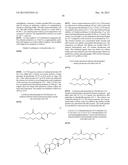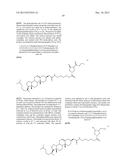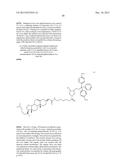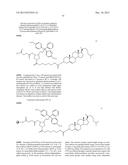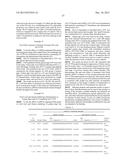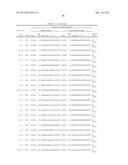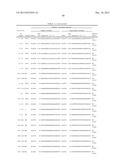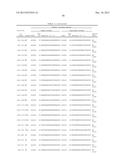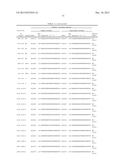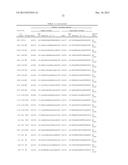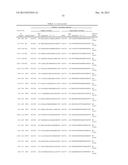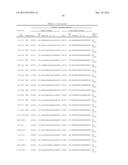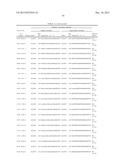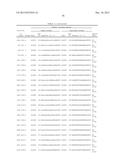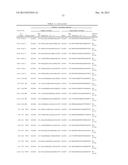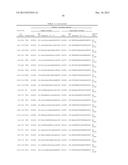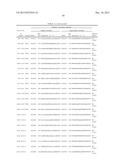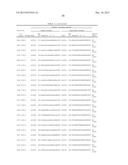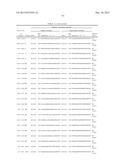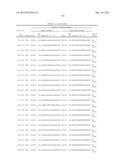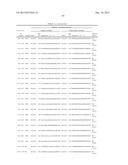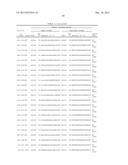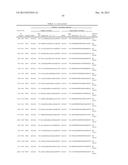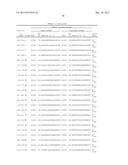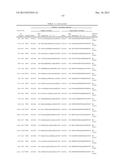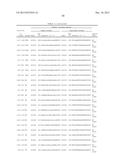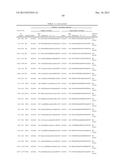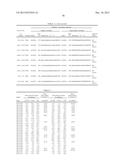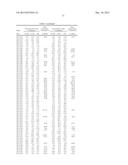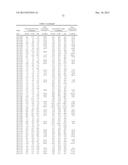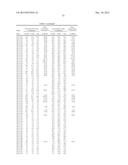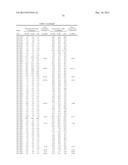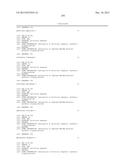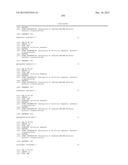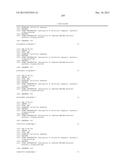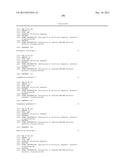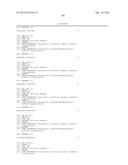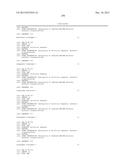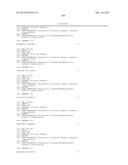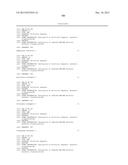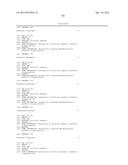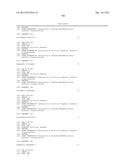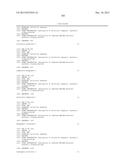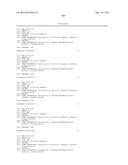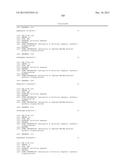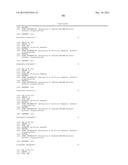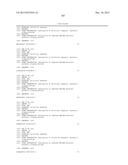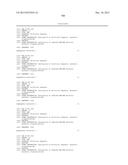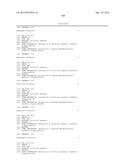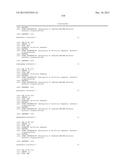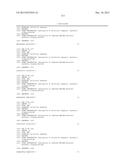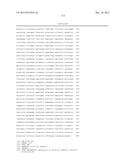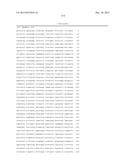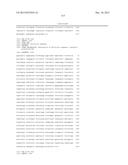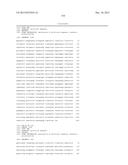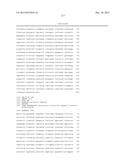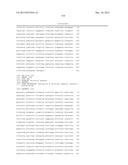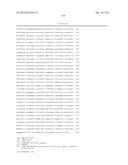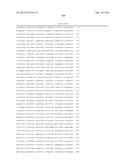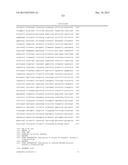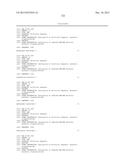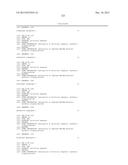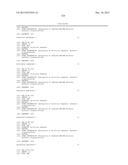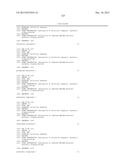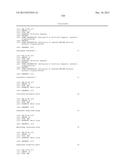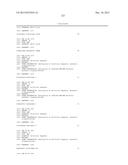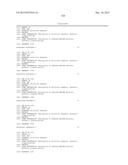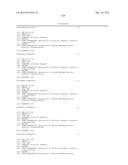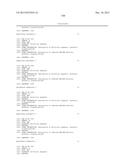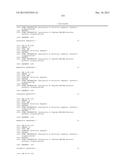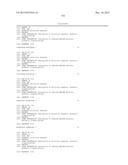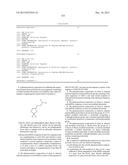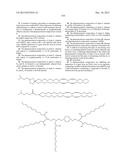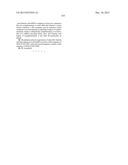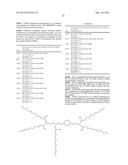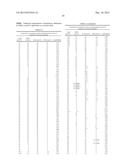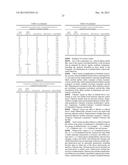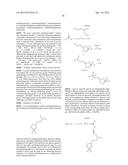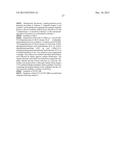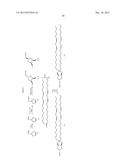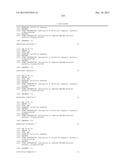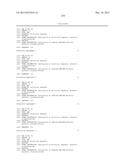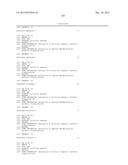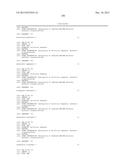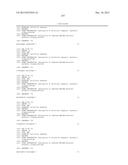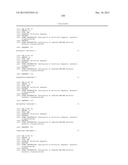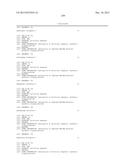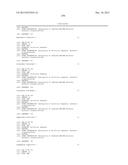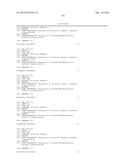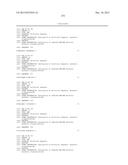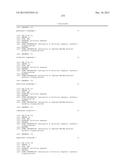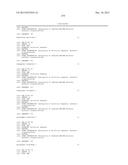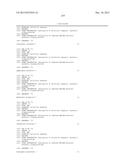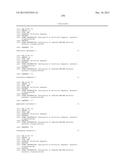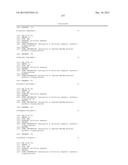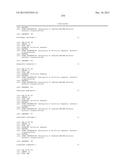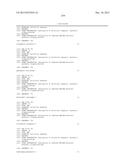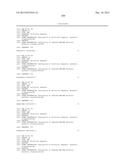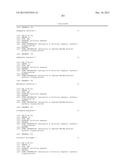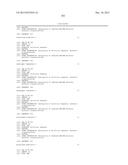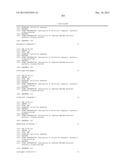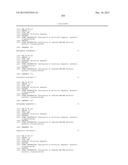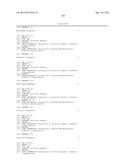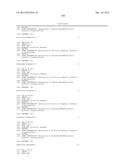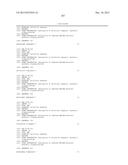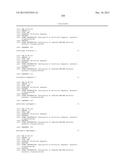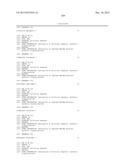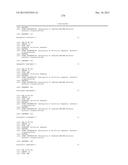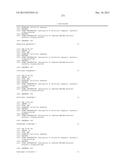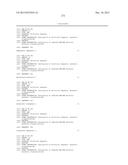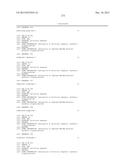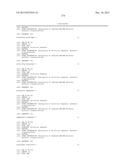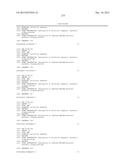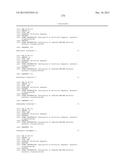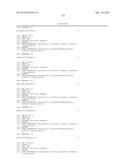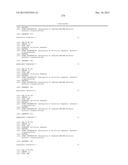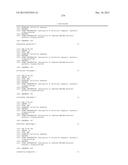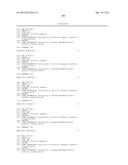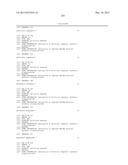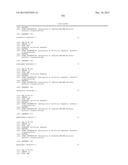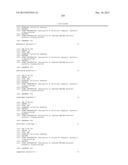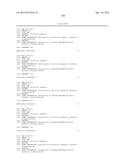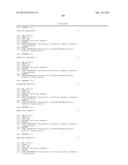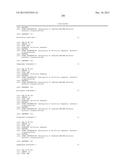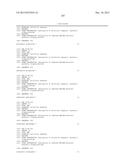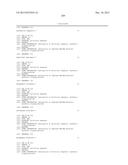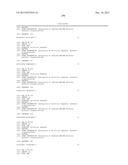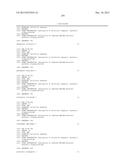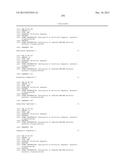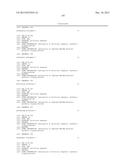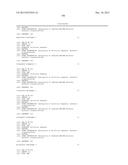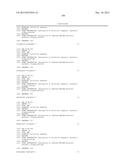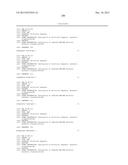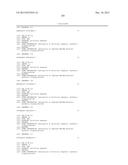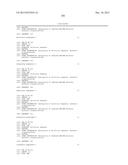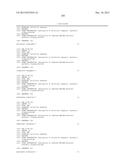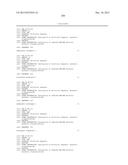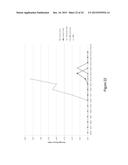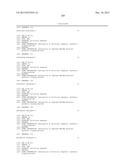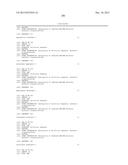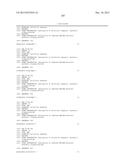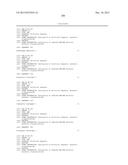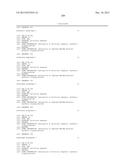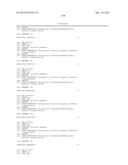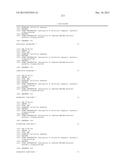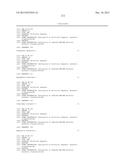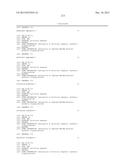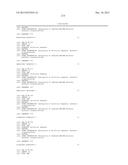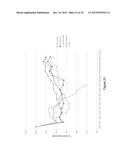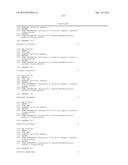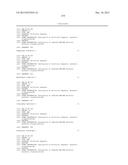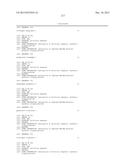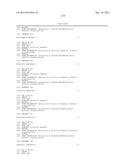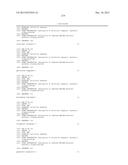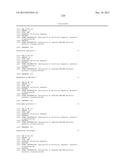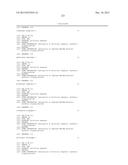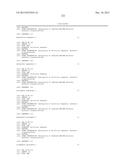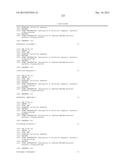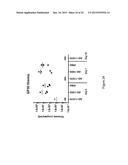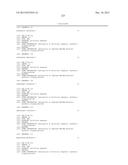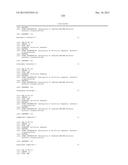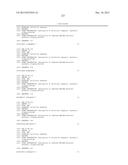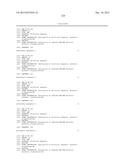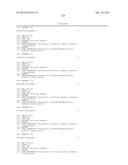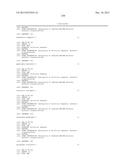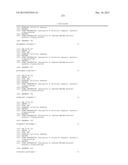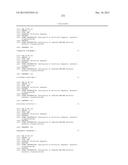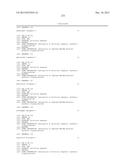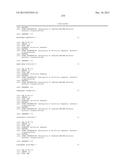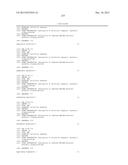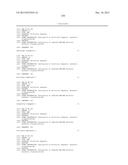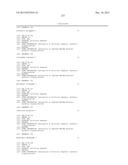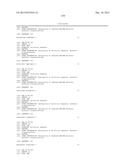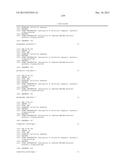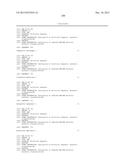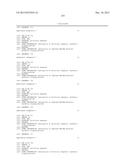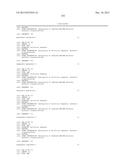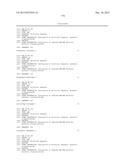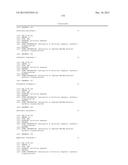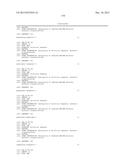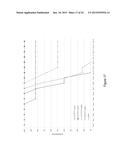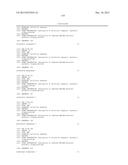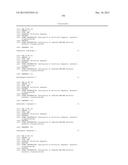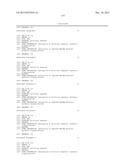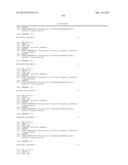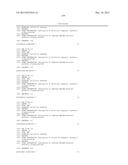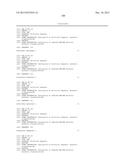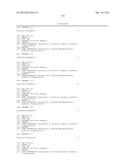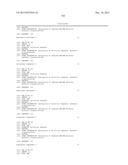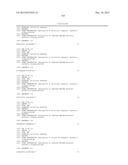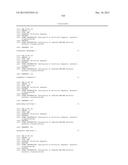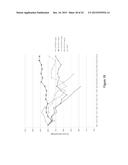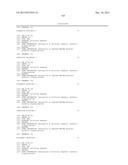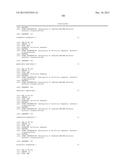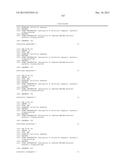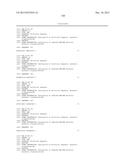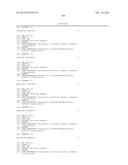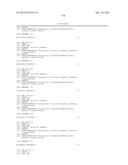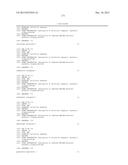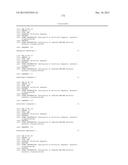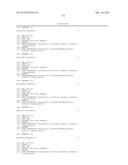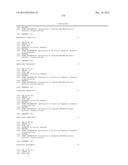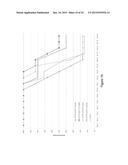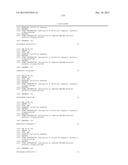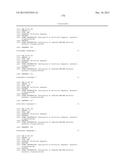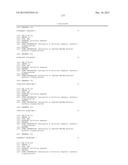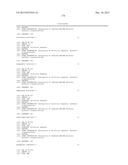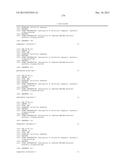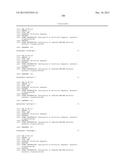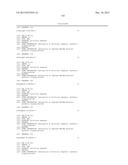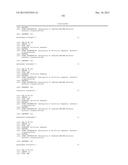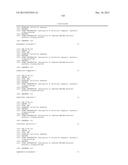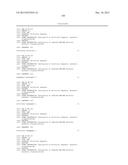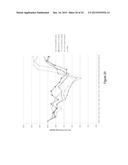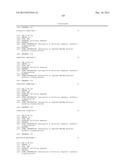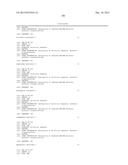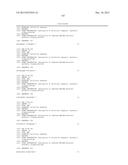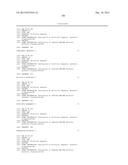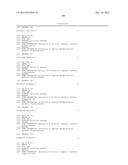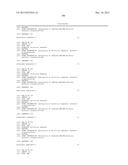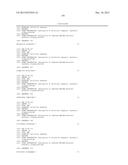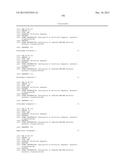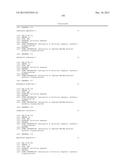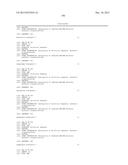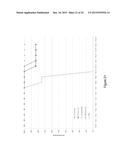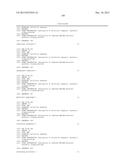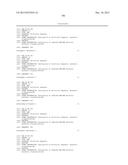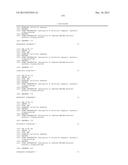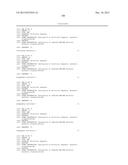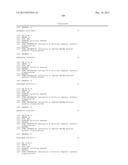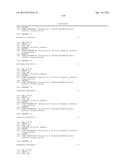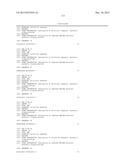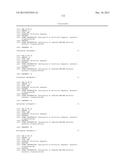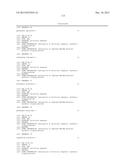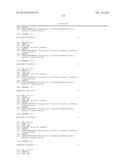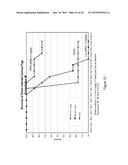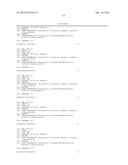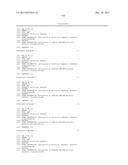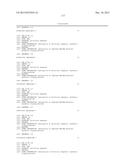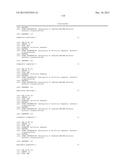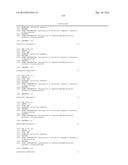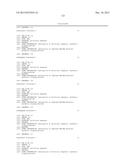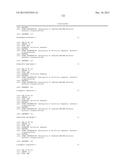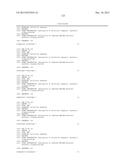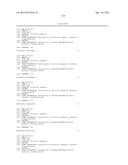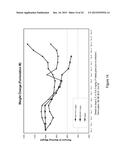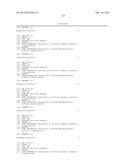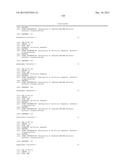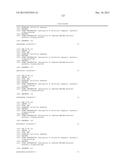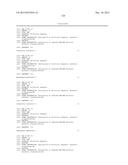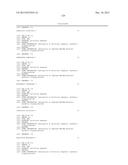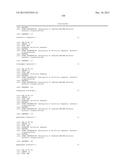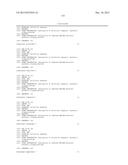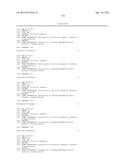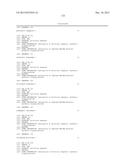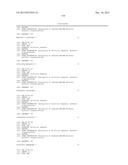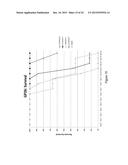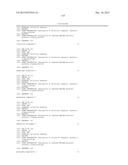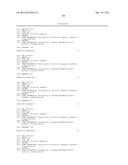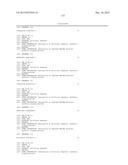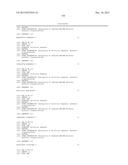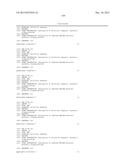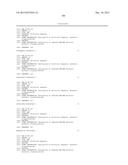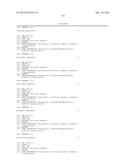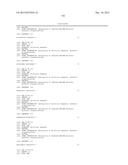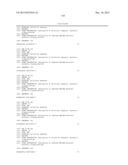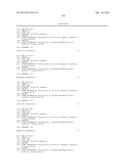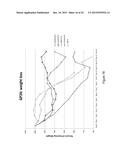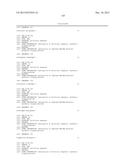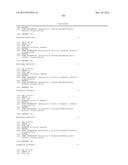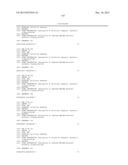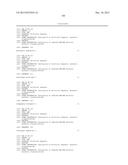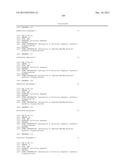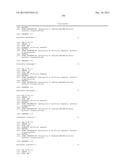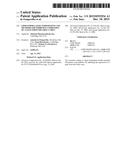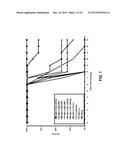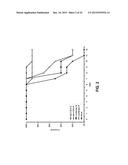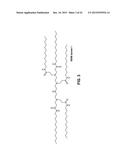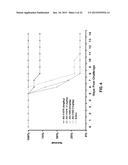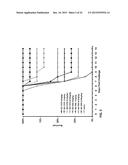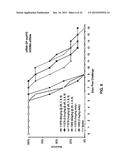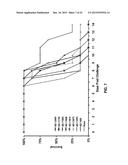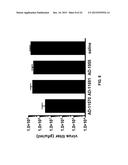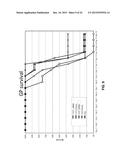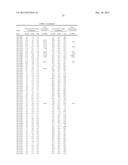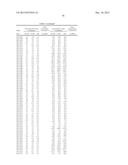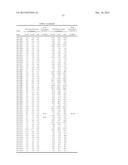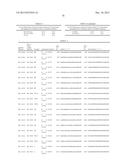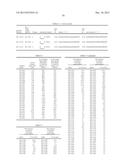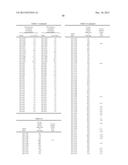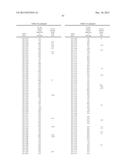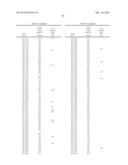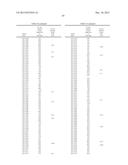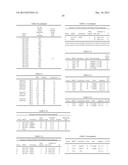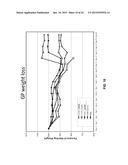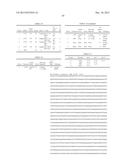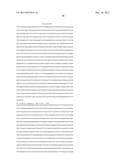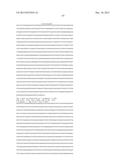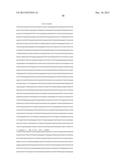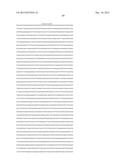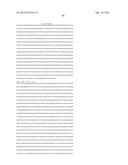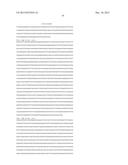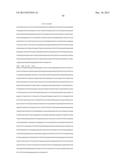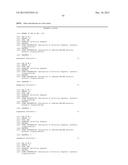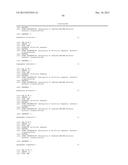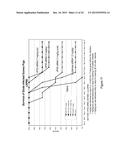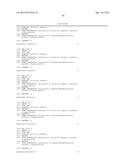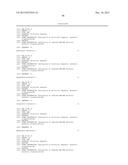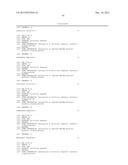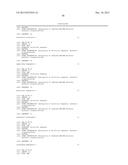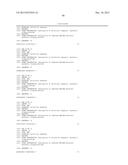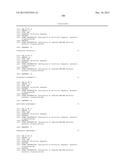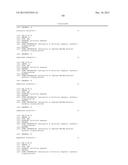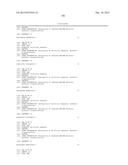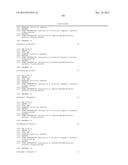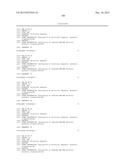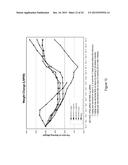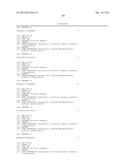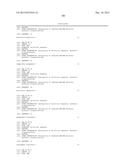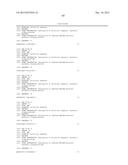Patent application title: Lipid Formulated Compositions and Methods for Inhibiting Expression of a Gene from the Ebola Virus
Inventors:
Antonin De Fougerolles (Brookline, MA, US)
Anna Borodovsky (Cambridge, MA, US)
Anna Borodovsky (Cambridge, MA, US)
Tatiana Novobrantseva (Wellesley, MA, US)
Tatiana Novobrantseva (Wellesley, MA, US)
IPC8 Class: AC12N15113FI
USPC Class:
514 44 A
Class name: Nitrogen containing hetero ring polynucleotide (e.g., rna, dna, etc.) antisense or rna interference
Publication date: 2015-12-10
Patent application number: 20150353934
Abstract:
The invention relates to lipid formulated double-stranded ribonucleic
acid (dsRNA) for inhibiting the expression of a gene from the Ebola
virus.Claims:
1. A pharmaceutical composition for inhibiting the expression of a gene
from an Ebola virus in an organism, comprising a double-stranded
ribonucleic acid (dsRNA) and a lipid formulation comprising the cationic
lipid of formula A: ##STR00017## where R1 and R2 are
independently alkyl, alkenyl or alkynyl, and wherein each of R1 and
R2 can be optionally substituted, and wherein R3 and R4
are independently lower alkyl or together form an optionally substituted
heterocyclic ring; and wherein said dsRNA comprises at least two
sequences that are complementary to each other and wherein a sense strand
comprises a first sequence and an antisense strand comprises a second
sequence comprising a region of complementarity which is substantially
complementary to at least a part of a mRNA encoding Ebola, and wherein
said region of complementarity is less than 30 nucleotides in length.
2. The pharmaceutical composition of claim 1, wherein said first sequence of said dsRNA consists of the sequence of SEQ ID NO:1027, and said second sequence consists of the sequence of SEQ ID NO:1028.
3. The pharmaceutical composition of claim 1, wherein said first sequence is selected from the group consisting of the sense sequences of Table 2 and said second sequence is selected from the group consisting of the antisense sequences of Table 2.
4. The pharmaceutical composition of claim 1, wherein said dsRNA comprises at least one modified nucleotide.
5. The pharmaceutical composition of claim 3, wherein said dsRNA comprises at least one modified nucleotide.
6. The pharmaceutical composition of claim 4, wherein said modified nucleotide is chosen from the group of: a 2'-O-methyl modified nucleotide, a nucleotide comprising a 5'-phosphorothioate group, and a terminal nucleotide linked to a cholesteryl derivative or dodecanoic acid bisdecylamide group.
7. The pharmaceutical composition of claim 4, wherein said modified nucleotide is chosen from the group of: a 2'-deoxy-2'-fluoro modified nucleotide, a 2'-deoxy-modified nucleotide, a locked nucleotide, an abasic nucleotide, 2'-amino-modified nucleotide, 2'-alkyl-modified nucleotide, morpholino nucleotide, a phosphoramidate, and a non-natural base comprising nucleotide.
8.-9. (canceled)
10. A method for inhibiting the expression of a gene from an Ebola virus in a cell, the method comprising: (a) introducing into the cell the pharmaceutical composition of claim 1; and (b) maintaining the cell produced in step (a) for a time sufficient to obtain degradation of the mRNA transcript of a gene from the Ebola virus, thereby inhibiting expression of a gene from the Ebola virus in the cell.
11. A method of treating, preventing or managing pathological processes mediated by Ebola expression comprising administering to a subject in need of such treatment, prevention or management a therapeutically or prophylactically effective amount of the pharmaceutical composition of claim 1.
12. The pharmaceutical composition of claim 1, wherein the dsRNA targets the VP35 of Ebola.
13. The pharmaceutical composition of claim 1, wherein said dsRNA, upon contact with a cell infected with Ebola virus, inhibits expression of a gene from the virus by at least 40% compared to a control.
14. The pharmaceutical composition of claim 1, wherein said region of complementarity is 15-30 nucleotides in length.
15. The pharmaceutical composition of claim 1, wherein said region of complementarity is 19-24 nucleotides in length.
16. The pharmaceutical composition of claim 1, wherein R1 and R2 of formula A are independently selected from oleoyl, pamitoyl, steroyl, or linoleyl.
17. The pharmaceutical composition of claim 1, wherein R1 and R2 of formula A are both linoleyl.
18. The pharmaceutical composition of claim 1, wherein R3 and R4 of formula A are methyl.
19. The pharmaceutical composition of claim 1, wherein the cationic lipid of formula A is 2,2-Dilinoleyl-4-dimethylaminoethyl-[1,3]-dioxolane.
20. The pharmaceutical composition of claim 1, further comprising a neutral lipid, a sterol, a PEG, or a PEG-modified lipid.
21. The pharmaceutical composition of claim 20, wherein said pharmaceutical composition comprises LNP09.
22. The pharmaceutical composition of claim 20, wherein said pharmaceutical composition comprises Formulation M.
23. A method of increasing life-span of, decreasing viral titre in, or sustaining platelet count in a subject infected with an Ebola virus, comprising administering to the subject the pharmaceutical composition of claim 1 in an amount sufficient to increase the life-span of, decreasing viral titre in, or sustaining platelet count in the subject.
24.-42. (canceled)
43. A pharmaceutical composition for inhibiting the expression of a gene from an Ebola virus in an organism, comprising a double-stranded ribonucleic acid (dsRNA) and a lipid formulation comprising a compound of formula X, selected from the group consisting of: ##STR00018## ; and wherein said dsRNA comprises at least two sequences that are complementary to each other and wherein a sense strand comprises a first sequence and an antisense strand comprises a second sequence comprising a region of complementarity which is substantially complementary to at least a part of a mRNA encoding Ebola virus, and wherein said region of complementarity is less than 30 nucleotides in length.
44. The pharmaceutical composition of claim 43, wherein said first sequence of said dsRNA consists of the sequence of SEQ ID NO:1027, and said second sequence consists of the sequence of SEQ ID NO:1028.
45.-72. (canceled)
Description:
RELATED APPLICATIONS
[0001] This application claims the benefit of U.S. provisional application 61/234,236, filed Aug. 14, 2009, U.S. provisional application 61/242,732, filed Sep. 15, 2009, and U.S. provisional application 61/259,106, filed Nov. 6, 2009, each of which is hereby incorporated by reference for all purposes.
REFERENCE TO A SEQUENCE LISTING
[0003] This application includes a Sequence Listing submitted electronically as a text file named 17150PCT_sequencelisting.txt, created on Month, ______, 2010, with a size of ______ bytes. The sequence listing is incorporated by reference.
FIELD OF THE INVENTION
[0004] This invention relates to lipid formulated double-stranded ribonucleic acid (dsRNA), and its use in mediating RNA interference to inhibit the expression of one of the genes of the Ebola virus and the use of the dsRNA to treat pathological processes mediated by Ebola infection, such as systemic hemorrhage and multi-organ failure.
BACKGROUND OF THE INVENTION
[0005] Ebola Virus
[0006] Minus-strand (-) RNA viruses are major causes of human suffering that cause epidemics of serious human illness. In humans the diseases caused by these viruses include influenza (Orthomyxoviridae), mumps, measles, upper and lower respiratory tract disease (Paramyxoviridae), rabies (Rhabdoviridae), hemorrhagic fever (Filoviridae, Bunyaviridae and Arenaviridae), encephalitis (Bunyaviridae) and neurological illness (Bomaviridae). Virtually the entire human population is thought to be infected by many of these viruses.
[0007] The Ebola virus comes from the Filoviridae family, similar to the Marburg virus. It is named after the Ebola River in Zaire, Africa, near where the first outbreak was noted by Dr. Ngoy Mushola in 1976 after a significant outbreaks in both Yambuku, Zaire (now the Democratic Republic of the Congo), and Nzara, in western Sudan. Of 602 identified cases, there were 397 deaths.
[0008] The two strains identified in 1976 were named Ebola-Zaire (EBO-Z) and Ebola-Sudan (EBO-S). The outbreak in Sudan showed a lower fatality rate--50%--compared to the 90% mortality rate of the Zaire strain. In 1990, a second, similar virus was identified in Reston, Va. amongst monkeys imported from the Philippines, and was named Ebola-Reston.
[0009] Further outbreaks have occurred in Zaire/Congo (1995 and 2003), Gabon (1994, 1995 and 1996), and in Uganda (2000). A new subtype was identified from a single human case in the Cote d'Ivoire in 1994, EBO-CI.
[0010] Of around 1500 identified human Ebola infections, two-thirds of the patients have died. The animal (or other) reservoir which sustains the virus between outbreaks has not been identified.
[0011] Among humans, the Ebola virus is transmitted by direct contact with infected body fluids such as blood.
[0012] The incubation period of Ebola hemorrhagic fever varies from two days to four weeks. Symptoms are variable too, but the onset is usually sudden and characterised by high fever, prostration, myalgia, arthralgia, abdominal pains and headache. These symptoms progress to vomiting, diarrhea, oropharyngeal lesions, conjunctivitis, organ damage (notably the kidney and liver) by co-localized necrosis, proteinuria, and bleeding both internal and external, commonly through the gastrointestinal tract. Death or recovery to convalescence occurs within six to ten days of onset of symptomology.
[0013] The development of a successful therapeutic for Ebola virus is a long-sought and seemingly difficult endeavor. Although they cause only a few hundred deaths worldwide each year, filoviruses are considered a significant world health threat and have many of the characteristics commonly associated with biological weapons since they can be grown in large quantities, can be fairly stable, are highly infectious as an aerosol, and are exceptionally deadly. Filoviruses are relatively simple viruses of 19 Kb genomes and consist of seven genes which encode nucleoprotein (NP), glycoprotein (GP), four smaller viral proteins (VP24, VP30, VP35 and VP40), and the RNA-dependent RNA polymerase (L protein) all in a single strand of negative-sensed RNA. Administration of type I interferons, therapeutic vaccines, immune globulins, ribavirin, and other nucleoside analogues have been somewhat successful in rodent Ebola virus models, but not in nonhuman primate infection models.
[0014] In view of the severity of the diseases caused by (-) RNA viruses, in particular members of the Filoviridae family of viruses, and the lack of effective prevention or therapies, it is therefore an object of the present invention to provide therapeutic compounds and methods for treating a host infected with a (-) RNA virus.
[0015] siRNA
[0016] Double-stranded RNA molecules (dsRNA) have been shown to block gene expression in a highly conserved regulatory mechanism known as RNA interference (RNAi). WO 99/32619 (Fire et al.) discloses the use of a dsRNA of at least 25 nucleotides in length to inhibit the expression of genes in C. elegans. dsRNA has also been shown to degrade target RNA in other organisms, including plants (see, e.g., WO 99/53050, Waterhouse et al.; and WO 99/61631, Heifetz et al.), Drosophila (see, e.g., Yang, D., et al., Curr. Biol. (2000) 10:1191-1200), and mammals (see WO 00/44895, Limmer; and DE 101 00 586.5, Kreutzer et al.). This natural mechanism has now become the focus for the development of a new class of pharmaceutical agents for treating disorders that are caused by the aberrant or unwanted regulation of a gene.
[0017] Recent reports have indicated that in vitro, RNAi may show some promising in reducing Ebola replication and providing protection in guinea pigs (Geisbert, et al., The Journal of Infectious Diseases, 193 (2006), 1650-1657). However, the RNAi agents examined were not designed against all known Ebola strains and were not selected for stability and other properties needed for in vivo therapeutic RNAi agents. Accordingly, despite significant advances in the field of RNAi, there remains a need for an agent that can selectively and efficiently silence a gene in the Ebola virus using the cell's own RNAi machinery that has both high biological activity and in vivo stability, and that can effectively inhibit replication of the Ebola virus for use in treating pathological processes mediated by Ebola infection.
SUMMARY OF THE INVENTION
[0018] The invention provides a pharmaceutical composition including a double-stranded ribonucleic acid (dsRNA) and a lipid formulation, as well as methods for inhibiting the expression of the Ebola virus in a cell, mammal, or organism using such pharmaceutical composition. The invention also provides compositions and methods for treating pathological conditions and diseases caused by Ebola viral infection, such as systemic hemorrhage and multi-organ failure. The pharmaceutical composition featured in the invention includes an RNA strand (the antisense strand) having a region which is less than 30 nucleotides in length, generally 15-30 or 19-24 nucleotides in length, and is substantially complementary to at least part of an mRNA transcript of a gene from the Ebola virus.
[0019] In one embodiment, the invention provides a pharmaceutical composition including dsRNA molecules for inhibiting the expression of a gene of the Ebola virus and viral replication. The dsRNA comprises at least two sequences that are complementary to each other. The dsRNA comprises a sense strand comprising a first sequence and an antisense strand comprising a second sequence. The antisense strand comprises a nucleotide sequence which is substantially complementary to at least part of an mRNA encoded by a gene from the Ebola virus, and the region of complementarity is less than 30 nucleotides in length, generally 15-30 or 19-24 nucleotides in length. The pharmaceutical composition, upon contact with a cell infected with the Ebola virus, inhibits the expression of a gene from the Ebola virus by at least 40% compared to a control.
[0020] For example, the pharmaceutical compositions of the invention can include a first sequence of the dsRNA that is selected from the group consisting of the sense sequences of Table 2 and the second sequence selected from the group consisting of the antisense sequences of Table 2. The dsRNA molecules featured in the invention can include naturally occurring nucleotides or can include at least one modified nucleotide, such as a 2'-O-methyl modified nucleotide, a nucleotide comprising a 5'-phosphorothioate group, and a terminal nucleotide linked to a cholesteryl derivative. Alternatively, the modified nucleotide may be chosen from the group of: a 2'-deoxy-2'-fluoro modified nucleotide, a 2'-deoxy-modified nucleotide, a locked nucleotide, an abasic nucleotide, 2'-amino-modified nucleotide, 2'-alkyl-modified nucleotide, morpholino nucleotide, a phosphoramidate, and a non-natural base comprising nucleotide. Generally, such modified sequence will be based on a first sequence of said dsRNA selected from the group consisting of the sense sequences of Table 2 and a second sequence selected from the group consisting of the antisense sequences of Table 2. In other embodiments, the first sequence of the dsRNA consists of the sequence of SEQ ID NO:1027, and the second sequence consists of the sequence of SEQ ID NO:1028.
[0021] In another embodiment, the invention provides a pharmaceutical composition for inhibiting the replication of the Ebola virus in an organism, generally a human subject. The composition includes one or more of the dsRNA of the invention and a lipid formulation. In a related embodiment, the lipid formulation includes a cationic lipid of formula A:
##STR00001##
where R1 and R2 are independently alkyl, alkenyl or alkynyl, each can be optionally substituted, and R3 and R4 are independently lower alkyl or R3 and R4 can be taken together to form an optionally substituted heterocyclic ring. In an embodiment, R1 and R2 of formula A are independently selected from olcoyl, pamitoyl, steroyl, or linolcyl. In another embodiment, R1 and R2 of formula A are both linolcyl. In another embodiment, R3 and R4 of formula A are methyl. In an embodiment, the cationic lipid of formula A is 2,2-Dilinolcyl-4-dimethylaminoethyl-[1,3]-dioxolane In an embodiment, the pharmaceutical composition can include a neutral lipid, a sterol, a PEG, or a PEG-modified lipid.
[0022] In another embodiment, the invention provides a method for inhibiting the expression of a gene in the Ebola virus in a cell, including the following steps:
[0023] (a) introducing into the cell a pharmaceutical composition including a double-stranded ribonucleic acid (dsRNA) and a lipid formulation, wherein the dsRNA includes at least two sequences that are complementary to each other. The dsRNA includes a sense strand having a first sequence and an antisense strand having a second sequence. The antisense strand includes a region of complementarity which is substantially complementary to at least a part of an mRNA encoded by the Ebola virus, and wherein the region of complementarity is less than 30 nucleotides in length, generally 15-30 or 19-24 nucleotides in length, and optionally, wherein the dsRNA, upon contact with a cell infected with the Ebola virus, inhibits expression of a gene from the Ebola virus by at least 40% compared to a control, such as in an assay described herein (e.g., a fluorescence-based assay); and
[0024] (b) maintaining the cell produced in step (a) for a time sufficient to obtain degradation of the mRNA transcript of a Ebola gene, thereby inhibiting expression of a gene from the Ebola virus in the cell.
[0025] In another embodiment, the invention provides methods for treating, preventing or managing pathological processes mediated by Ebola infection, such as systemic hemorrhage and multi-organ failure, comprising administering to a patient in need of such treatment, prevention or management a therapeutically or prophylactically effective amount of one or more of the pharmaceutical compositions of the invention. In certain related embodiments, the pharmaceutical composition is administered to said subject prior to infection with Ebola virus. In other embodiments, the pharmaceutical composition is administered to said subject after infection with Ebola virus. In yet other embodiments, the pharmaceutical composition is administered in a dose of about 1 to 5 mgs/kg, or about 2 to 3 mgs/kg (mgs/kg refers to mgs of siRNA per kg of subject weight). In still other embodiments, the pharmaceutical composition is administered to said subject by parenteral administration, e.g., intraperitoneally. In still other embodiments, the pharmaceutical composition is administered on a daily or semi-daily (e.g., bi-daily) basis for 7 to 10 days. In still other embodiments, the administration of said pharmaceutical composition reduces weight loss in said subject relative to the weight loss that would be observed after administration of a control composition or another treatment that did not include said pharmaceutical composition.
[0026] In one aspect, the invention provides for a method of increasing the life-span of a subject (e.g., a mammal, such as a human or nonhuman primate) infected with an Ebola virus. The method includes administering a pharmaceutical composition including a dsRNA and a lipid formulation to the subject, where the dsRNA includes an antisense RNA strand having a region which is less than 30 nucleotides in length, generally 15-30 or 19-24 nucleotides in length, and is substantially complementary to at least part of an mRNA transcript of a gene from the Ebola virus. The pharmaceutical composition is administered in an amount sufficient to increase the lifespan of the subject. In one embodiment, the pharmaceutical composition includes an antisense RNA strand having a region that is substantially complementary to at least part of an mRNA transcript of a gene selected from the VP30, VP35, NP, L, VP24, VP40 and GP genes. In one embodiment, the pharmaceutical composition includes an antisense RNA strand having a region that is substantially complementary to at least part of an mRNA transcript of the VP35 gene. In some embodiments, the subject does not experience a decrease in one or both of lymphocyte or platelet count after administration of the dsRNA. In other embodiments, the lymphocyte count of the subject is sustained. In other embodiments, the subject does not experience an increase in cytokine levels (e.g., IFN-alpha or TNF-alpha levels).
[0027] In another aspect, the invention features a method of decreasing viral titre in a subject (e.g., a mammal, such as a human or nonhuman primate) infected with an Ebola virus. The method includes administering a pharmaceutical composition including a dsRNA and a lipid formulation to the subject, where the dsRNA includes an antisense RNA strand having a region which is less than 30 nucleotides in length, generally 15-30 or 19-24 nucleotides in length, and is substantially complementary to at least part of an mRNA transcript of a gene from the Ebola virus. In one embodiment, the dsRNA includes an antisense RNA strand having a region that is substantially complementary to at least part of an mRNA transcript of the VP35 gene. In another embodiment, the subject does not experience a decrease in one or both of lymphocyte or platelet count after administration of the dsRNA. In other embodiments, the lymphocyte count of the subject is sustained. In other embodiments, the subject does not experience an increase in cytokine levels (e.g., IFN-alpha or TNF-alpha levels).
[0028] In another aspect, the invention features a method of sustaining lymphocyte or platelet count in a mammal (e.g., a human or nonhuman primate) infected with an Ebola virus. The method includes administering a pharmaceutical composition including a dsRNA and a lipid formulation to the subject, where the dsRNA includes an antisense RNA strand having a region which is less than 30 nucleotides in length, generally 15-30 or 19-24 nucleotides in length, and is substantially complementary to at least part of an mRNA transcript of a gene from the Ebola virus. In one embodiment, the dsRNA includes an antisense RNA strand having a region that is substantially complementary to at least part of an mRNA transcript of the VP35 gene. In other embodiments, the subject does not experience an increase in cytokine levels (e.g., IFN-alpha or TNF-alpha levels).
BRIEF DESCRIPTION OF THE FIGURES
[0029] FIG. 1 is a graph showing that siRNAs formulated with lipidoid LNP01 protected mice from a lethal Ebola virus challenge.
[0030] FIG. 2 is a graph showing that a single injection of a liposomally formulated siRNA delivered by ip or iv protected mice from a lethal Ebola challenge. VP35 siRNA was AD-11570
[0031] FIG. 3 is the structure of NP98 lipid.
[0032] FIG. 4 is a graph showing that siRNAs formulated with DODMA protected mice from a lethal Ebola virus challenge.
[0033] FIG. 5 is a graph showing that siRNAs formulated with DODMA were effective down to 0.04 mg/kg to protect mice injected with Ebola.
[0034] FIG. 6 is a graph showing that siRNAs formulated with DODMA were effective to protect guinea pigs from a lethal Ebola virus challenge.
[0035] FIG. 7 is a graph showing the efficacy of siRNAs against different Ebola genes formulated with DODMA in a guinea pig model of Ebola.
[0036] FIG. 8 is a graph presenting the observed decrease in viral titers in the serum of mice following administration of LNP01-formulated VP35 siRNA.
[0037] FIG. 9 shows the survival of guinea pigs treated with DODMA or LNP09 formulated siRNA or saline control.
[0038] FIG. 10 shows the weight loss of guinea pigs treated with DODMA or LNP09 formulated siRNA or saline control as measured against a percentage of the guinea pig's starting weight.
[0039] FIG. 11 shows the survival of guinea pigs treated with LNP09 formulated siRNA versus controls, administered according to the indicated dosage regimens.
[0040] FIG. 12 shows the weight loss of guinea pigs treated with LNP09 formulated siRNA versus controls, administered according to the indicated dosage regimens.
[0041] FIG. 13 shows the survival of guinea pgis treated with Formulation M formulated siRNA versus controls, administered according to the indicated dosage regimen.
[0042] FIG. 14 shows the weight loss of guinea pigs treated with Formulation M formulated siRNA versus controls, administered according to the indicated dosage regimen.
[0043] FIG. 15 shows the survival of guinea pigs treated with different lipid formulations of siRNA via different administration routes, administered according to the indicated dosage regimen.
[0044] FIG. 16 shows the weight loss of guinea pigs treated with different lipid formulations of siRNA via different administration routes, administered according to the indicated dosage regimen. The P/Q treated group includes 3 animals treated with AD-1955 E/F formulation on day 0 and AD-11570 P/Q formulation on days 1, 2, and 4.
[0045] FIG. 17 shows the survival of guinea pigs treated with different dosages of siRNA, administered according to the indicated dosage regimen.
[0046] FIG. 18 shows the weight change of guinea pigs treated with different dosages of siRNA, administered according to the indicated dosage regimen.
[0047] FIG. 19 shows the survival of guinea pigs treated with different formulations of siRNA, administered according to the indicated dosage regimen.
[0048] FIG. 20 shows the weight change of guinea pigs treated with different formulations of siRNA, administered according to the indicated dosage regimen.
[0049] FIG. 21 shows the survival of guinea pigs treated with siRNA post-Ebola challenge, administered according to the indicated dosage regimen.
[0050] FIG. 22 shows the disease index of guinea pigs treated with siRNA post-Ebola challenge, administered according to the indicated dosage regimen. 0=Healthy; no clinical signs of disease, animal active and responsive. 1=Slightly ruffled fur, reduced mobility. 2=Severely reduced mobility, hunched posture, ruffled fur, reduced responsiveness. 3=Moribund; Unresponsive, non-mobile, labored breathing. 4=Dead.
[0051] FIG. 23 shows the weight change of guinea pigs treated with siRNA post-Ebola challenge, administered according to the indicated dosage regimen.
[0052] FIG. 24 shows the viremia in guinea pigs treated with siRNA or control, administered according to the indicated dose regimen. Serum titer of Ebola virus was quantified by RT-qPCR. Treatment with AD-11570 specific siRNA in a lipid D formulation results in a dramatic suppression of Ebola virus titer.
DETAILED DESCRIPTION OF THE INVENTION
[0053] The invention provides double-stranded ribonucleic acid (dsRNA), as well as compositions and methods for inhibiting the expression of a gene from the Ebola virus in a cell or mammal using the dsRNA. The invention also provides compositions and methods for treating pathological conditions and diseases in a mammal caused by Ebola infection using dsRNA. dsRNA directs the sequence-specific degradation of mRNA through a process known as RNA interference (RNAi).
[0054] The dsRNA of the invention comprises an RNA strand (the antisense strand) having a region which is less than 30 nucleotides in length, generally 19-24 nucleotides in length, and is substantially complementary to at least part of an mRNA transcript of a gene from the Ebola virus. The use of these dsRNAs enables the targeted degradation of mRNAs of genes that are implicated in replication and or maintenance of Ebola infection and the occurance of systemic hemorrhage and multi-organ failure in a subject infected with the Ebola virus. Using cell-based and animal assays, the present inventors have demonstrated that very low dosages of these dsRNA can specifically and efficiently mediate RNAi, resulting in significant inhibition of expression of a gene from the Ebola virus. Thus, the methods and compositions of the invention comprising these dsRNAs are useful for treating pathological processes mediated by Ebolaviral infection by targeting a gene involved in Ebola relication and/or maintainance in a cell.
[0055] The following detailed description discloses how to make and use the dsRNA and compositions containing dsRNA to inhibit the expression of a gene from the Ebola virus, as well as compositions and methods for treating diseases and disorders caused by the infection with the Ebola virus, such as systemic hemorrhage and multi-organ failure. The pharmaceutical compositions of the invention comprise a dsRNA having an antisense strand comprising a region of complementarity which is less than 30 nucleotides in length, generally 19-24 nucleotides in length, and is substantially complementary to at least part of an RNA transcript of a gene from the Ebola virus, together with a pharmaceutically acceptable carrier.
[0056] Accordingly, certain aspects of the invention provide pharmaceutical compositions comprising the dsRNA of the invention together with a pharmaceutically acceptable carrier, methods of using the compositions to inhibit expression of a gene in a gene from the Ebola virus, and methods of using the pharmaceutical compositions to treat diseases caused by infection with the Ebola virus.
I. DEFINITIONS
[0057] For convenience, the meaning of certain terms and phrases used in the specification, examples, and appended claims, are provided below. If there is an apparent discrepancy between the usage of a term in other parts of this specification and its definition provided in this section, the definition in this section shall prevail.
[0058] "G," "C," "A" and "U" each generally stand for a nucleotide that contains guanine, cytosine, adenine, and uracil as a base, respectively. "T" and "dT" are used interchangeably herein and refer to a deoxyribonucleotide wherein the nucleobase is thymine, e.g., deoxyribothymine. However, it will be understood that the term "ribonucleotide" or "nucleotide" or "deoxyribonucleotide" can also refer to a modified nucleotide, as further detailed below, or a surrogate replacement moiety. The skilled person is well aware that guanine, cytosine, adenine, and uracil may be replaced by other moieties without substantially altering the base pairing properties of an oligonucleotide comprising a nucleotide bearing such replacement moiety. For example, without limitation, a nucleotide comprising inosine as its base may base pair with nucleotides containing adenine, cytosine, or uracil. Hence, nucleotides containing uracil, guanine, or adenine may be replaced in the nucleotide sequences of the invention by a nucleotide containing, for example, inosine. Sequences comprising such replacement moieties are embodiments of the invention.
[0059] As used herein, "Ebola viruses", are members of the family Filoviridae, are associated with outbreaks of highly lethal hemorrhagic fever in humans and nonhuman primates. Human pathogens include Ebola Zaire, Ebola Sudan, and Ebola Ivory Coast. Ebola Reston is a monkey pathogen and is not considered a significant human pathogen. The natural reservoir of the virus is unknown and there are currently no available vaccines or effective therapeutic treatments for filovirus infections. The genome of Ebola virus consists of a single strand of negative sense RNA that is approximately 19 kb in length. This RNA contains seven sequentially arranged genes that produce 8 mRNAs upon infection. Ebola virions, like virions of other filoviruses, contain seven proteins: a surface glycoprotein (GP), a nucleoprotein (NP), four virion structural proteins (VP40, VP35, VP30, and VP24), and an RNA-dependent RNA polymerase (L) (Feldmann et al. (1992) Virus Res. 24, 1-19; Sanchez et al., (1993) Virus Res. 29, 215-240; reviewed in Peters et al. (1996) In Fields Virology, Third ed. pp. 1161-1176. Fields, B. N., Knipe, D. M., Howley, P. M., et al. eds. Lippincott-Raven Publishers, Philadelphia). The glycoprotein of Ebola virus is unusual in that it is encoded in two open reading frames. Transcriptional editing is needed to express the transmembrane form that is incorporated into the virion (Sanchez et al. (1996) Proc. Natl. Acad. Sci. USA 93, 3602-3607; Volchkov et al, (1995) Virology 214, 421-430).
[0060] As used herein, "target sequence" refers to a contiguous portion of the nucleotide sequence of an mRNA molecule formed during the transcription of a gene from the Ebola virus, including mRNA that is a product of RNA processing of a primary transcription product.
[0061] As used herein, the term "strand comprising a sequence" refers to an oligonucleotide comprising a chain of nucleotides that is described by the sequence referred to using the standard nucleotide nomenclature.
[0062] As used herein, and unless otherwise indicated, the term "complementary," when used to describe a first nucleotide sequence in relation to a second nucleotide sequence, refers to the ability of an oligonucleotide or polynucleotide comprising the first nucleotide sequence to hybridize and form a duplex structure under certain conditions with an oligonucleotide or polynucleotide comprising the second nucleotide sequence, as will be understood by the skilled person. Such conditions can, for example, be stringent conditions, where stringent conditions may include: 400 mM NaCl, 40 mM PIPES pH 6.4, 1 mM EDTA, 50° C. or 70° C. for 12-16 hours followed by washing. Other conditions, such as physiologically relevant conditions as may be encountered inside an organism, can apply. The skilled person will be able to determine the set of conditions most appropriate for a test of complementarity of two sequences in accordance with the ultimate application of the hybridized nucleotides.
[0063] This includes base-pairing of the oligonucleotide or polynucleotide comprising the first nucleotide sequence to the oligonucleotide or polynucleotide comprising the second nucleotide sequence over the entire length of the first and second nucleotide sequence. Such sequences can be referred to as "fully complementary" with respect to each other herein. However, where a first sequence is referred to as "substantially complementary" with respect to a second sequence herein, the two sequences can be fully complementary, or they may form one or more, but generally not more than 4, 3 or 2 mismatched base pairs upon hybridization, while retaining the ability to hybridize under the conditions most relevant to their ultimate application. However, where two oligonucleotides are designed to form, upon hybridization, one or more single stranded overhangs, such overhangs shall not be regarded as mismatches with regard to the determination of complementarity. For example, a dsRNA comprising one oligonucleotide 21 nucleotides in length and another oligonucleotide 23 nucleotides in length, wherein the longer oligonucleotide comprises a sequence of 21 nucleotides that is fully complementary to the shorter oligonucleotide, may yet be referred to as "fully complementary" for the purposes of the invention.
[0064] "Complementary" sequences, as used herein, may also include, or be formed entirely from, non-Watson-Crick base pairs and/or base pairs formed from non-natural and modified nucleotides, in as far as the above requirements with respect to their ability to hybridize are fulfilled. Such non-Watson-Crick base pairs includes, but not limited to, G:U Wobble or Hoogstein base pairing.
[0065] The terms "complementary", "fully complementary" and "substantially complementary" herein may be used with respect to the base matching between the sense strand and the antisense strand of a dsRNA, or between the antisense strand of a dsRNA and a target sequence, as will be understood from the context of their use.
[0066] As used herein, a polynucleotide which is "substantially complementary to at least part of" a messenger RNA (mRNA) refers to a polynucleotide which is substantially complementary to a contiguous portion of the mRNA of interest (e.g., encoding Ebola) including a 5' UTR, an open reading frame (ORF), or a 3' UTR. For example, a polynucleotide is complementary to at least a part of a Ebola mRNA if the sequence is substantially complementary to a non-interrupted portion of a mRNA encoding Ebola.
[0067] The term "double-stranded RNA" or "dsRNA," as used herein, refers to a complex of ribonucleic acid molecules, having a duplex structure comprising two anti-parallel and substantially complementary, as defined above, nucleic acid strands. In general, the majority of nucleotides of each strand are ribonucleotides, but as described in detail herein, each or both strands can also include at least one non-ribonucleotide, e.g., a deoxyribonucleotide and/or a modified nucleotide. In addition, as used in this specification, "dsRNA" may include chemical modifications to ribonucleotides, including substantial modifications at multiple nucleotides and including all types of modifications disclosed herein or known in the art. Any such modifications, as used in an siRNA type molecule, are encompassed by "dsRNA" for the purposes of this specification and claims.
[0068] The two strands forming the duplex structure may be different portions of one larger RNA molecule, or they may be separate RNA molecules. Where the two strands are part of one larger molecule, and therefore are connected by an uninterrupted chain of nucleotides between the 3'-end of one strand and the 5'end of the respective other strand forming the duplex structure, the connecting RNA chain is referred to as a "hairpin loop". Where the two strands are connected covalently by means other than an uninterrupted chain of nucleotides between the 3'-end of one strand and the 5'end of the respective other strand forming the duplex structure, the connecting structure is referred to as a "linker". The RNA strands may have the same or a different number of nucleotides. The maximum number of base pairs is the number of nucleotides in the shortest strand of the dsRNA minus any overhangs that are present in the duplex. In addition to the duplex structure, a dsRNA may comprise one or more nucleotide overhangs. dsRNAs as used herein are also referred to as "siRNAs" (short interfering RNAs).
[0069] As used herein, a "nucleotide overhang" refers to the unpaired nucleotide or nucleotides that protrude from the duplex structure of a dsRNA when a 3'-end of one strand of the dsRNA extends beyond the 5'-end of the other strand, or vice versa. "Blunt" or "blunt end" means that there are no unpaired nucleotides at that end of the dsRNA, i.e., no nucleotide overhang. A "blunt ended" dsRNA is a dsRNA that is double-stranded over its entire length, i.e., no nucleotide overhang at either end of the molecule.
[0070] The term "antisense strand" refers to the strand of a dsRNA which includes a region that is substantially complementary to a target sequence. As used herein, the term "region of complementarity" refers to the region on the antisense strand that is substantially complementary to a sequence, for example a target sequence, as defined herein. Where the region of complementarity is not fully complementary to the target sequence, the mismatches are most tolerated in the terminal regions and, if present, are generally in a terminal region or regions, e.g., within 6, 5, 4, 3, or 2 nucleotides of the 5' and/or 3' terminus.
[0071] The term "sense strand," as used herein, refers to the strand of a dsRNA that includes a region that is substantially complementary to a region of the antisense strand.
[0072] "Introducing into a cell", when referring to a dsRNA, means facilitating uptake or absorption into the cell, as is understood by those skilled in the art. Absorption or uptake of dsRNA can occur through unaided diffusive or active cellular processes, or by auxiliary agents or devices. The meaning of this term is not limited to cells in vitro; a dsRNA may also be "introduced into a cell", wherein the cell is part of a living organism. In such instance, introduction into the cell will include the delivery to the organism. For example, for in vivo delivery, dsRNA can be injected into a tissue site or administered systemically. In vitro introduction into a cell includes methods known in the art such as electroporation and lipofection.
[0073] The terms "silence," "inhibit the expression of," "down-regulate the expression of," "suppress the expression of" and the like, in as far as they refer to a gene from the Ebola virus, herein refer to the at least partial suppression of the expression of a gene from the Ebola virus, as manifested by a reduction of the amount of mRNA from the Ebola virus which may be isolated from a first cell or group of cells in which a gene from the Ebola virus is transcribed and which has or have been treated such that the expression of a gene from the Ebola virus is inhibited, as compared to a second cell or group of cells substantially identical to the first cell or group of cells but which has or have not been so treated (control cells). The degree of inhibition is usually expressed in terms of
( mRNA in control cells ) - ( mRNA in treated cells ) ( mRNA in control cells ) 100 % ##EQU00001##
[0074] Alternatively, the degree of inhibition may be given in terms of a reduction of a parameter that is functionally linked to Ebola genome transcription, e.g. the amount of protein encoded by a gene from the Ebola virus, or the number of cells displaying a certain phenotype, e.g infection with the Ebola virus. In principle, Ebola genome silencing may be determined in any cell expressing the target, either constitutively or by genomic engineering, and by any appropriate assay. However, when a reference is needed in order to determine whether a given dsRNA inhibits the expression of a gene from the Ebola virus by a certain degree and therefore is encompassed by the instant invention, the assay provided in the Examples below shall serve as such reference.
[0075] For example, in certain instances, expression of a gene from the Ebola virus is suppressed by at least about 5%, 10%, 15%, 20%, 25%, 30%, 35%, 40%, 45%, or 50% by administration of the double-stranded oligonucleotide of the invention. In some embodiment, a gene from the Ebola virus is suppressed by at least about 60%, 70%, or 80% by administration of the double-stranded oligonucleotide of the invention. In some embodiments, a gene from the Ebola virus is suppressed by at least about 85%, 90%, or 95% by administration of the double-stranded oligonucleotide of the invention.
[0076] As used herein in the context of Ebola expression, the terms "treat", "treatment", and the like, refer to relief from or alleviation of pathological processes mediated by Ebola infection. In the context of the present invention insofar as it relates to any of the other conditions recited herein below (other than pathological processes mediated by Ebola expression), the terms "treat", "treatment", and the like mean to relieve or alleviate at least one symptom associated with such condition, or to slow or reverse the progression of such condition, or to reduce the amount of virus present in the infected subject.
[0077] As used herein, the phrases "therapeutically effective amount" and "prophylactically effective amount" refer to an amount that provides a therapeutic benefit in the treatment, prevention, or management of pathological processes mediated by Ebola infection or an overt symptom of pathological processes mediated by Ebola expression or the amount virus present in the patient. The specific amount that is therapeutically effective can be readily determined by ordinary medical practitioner, and may vary depending on factors known in the art, such as, e.g. the type of pathological processes mediated by Ebola infection, the patient's history and age, the stage of pathological processes mediated by Ebola infection, and the administration of other anti-pathological processes mediated by Ebola infection.
[0078] As used herein, a "pharmaceutical composition" comprises a pharmacologically effective amount of a dsRNA and a pharmaceutically acceptable carrier. As used herein, "pharmacologically effective amount," "therapeutically effective amount" or simply "effective amount" refers to that amount of an RNA effective to produce the intended pharmacological, therapeutic or preventive result. For example, if a given clinical treatment is considered effective when there is at least a 25% reduction in a measurable parameter associated with a disease or disorder, a therapeutically effective amount of a drug for the treatment of that disease or disorder is the amount necessary to effect at least a 25% reduction in that parameter. Further, the pharmaceutical composition can be designed to enhance targeting cells involved in Ebola infection such as dendritic cells, macrophages, hepatocytes, and other parenchymal cells.
[0079] The term "pharmaceutically acceptable carrier" refers to a carrier for administration of a therapeutic agent. Such carriers include, but are not limited to, saline, buffered saline, dextrose, water, glycerol, ethanol, and combinations thereof. The term specifically excludes cell culture medium. For drugs administered orally, pharmaceutically acceptable carriers include, but are not limited to pharmaceutically acceptable excipients such as inert diluents, disintegrating agents, binding agents, lubricating agents, sweetening agents, flavoring agents, coloring agents and preservatives. Suitable inert diluents include sodium and calcium carbonate, sodium and calcium phosphate, and lactose, while corn starch and alginic acid are suitable disintegrating agents. Binding agents may include starch and gelatin, while the lubricating agent, if present, will generally be magnesium stearate, stearic acid or talc. If desired, the tablets may be coated with a material such as glyceryl monostearate or glyceryl distearate, to delay absorption in the gastrointestinal tract.
[0080] As used herein, a "transformed cell" is a cell into which a vector has been introduced from which a dsRNA molecule may be expressed.
II. DOUBLE-STRANDED RIBONUCLEIC ACID (DSRNA)
[0081] As described in more detail herein, the invention provides double-stranded ribonucleic acid (dsRNA) molecules for inhibiting the expression of a gene from the Ebola virus in a cell or mammal, wherein the dsRNA comprises an antisense strand comprising a region of complementarity which is complementary to at least a part of an mRNA formed in the expression of a gene from the Ebola virus, and wherein the region of complementarity is less than 30 nucleotides in length, generally 19-24 nucleotides in length, and wherein said dsRNA, upon contact with a cell expressing the gene from the Ebola virus, inhibits the expression of the Ebola virus gene by at least 40%. The dsRNA of the invention can further include one or more single-stranded nucleotide overhangs.
[0082] The dsRNA can be synthesized by standard methods known in the art as further discussed below, e.g., by use of an automated DNA synthesizer, such as are commercially available from, for example, Biosearch, Applied Biosystems, Inc. The dsRNA comprises two RNA strands that are sufficiently complementary to hybridize to form a duplex structure. One strand of the dsRNA (the antisense strand) comprises a region of complementarity that is substantially complementary, and generally fully complementary, to a target sequence, derived from the sequence of an mRNA formed during the expression of a gene from the Ebola virus, the other strand (the sense strand) comprises a region which is complementary to the antisense strand, such that the two strands hybridize and form a duplex structure when combined under suitable conditions. Generally, the duplex structure is between 15 and 30, or between 25 and 30, or between 18 and 25, or between 19 and 24, or between 19 and 21, or 19, 20, or 21 base pairs in length. In one embodiment the duplex is 19 base pairs in length. In another embodiment the duplex is 21 base pairs in length. When two different siRNAs are used in combination, the duplex lengths can be identical or can differ.
[0083] Each strand of the dsRNA of invention is generally between 15 and 30, or between 18 and 25, or 18, 19, 20, 21, 22, 23, 24, or 25 nucleotides in length. In other embodiments, each is strand is 25-30 nucleotides in length. Each strand of the duplex can be the same length or of different lengths. When two different siRNAs are used in combination, the lengths of each strand of each siRNA can be identical or can differ.
[0084] The dsRNA of the invention can include one or more single-stranded overhang(s) of one or more nucleotides. In one embodiment, at least one end of the dsRNA has a single-stranded nucleotide overhang of 1 to 4, generally 1 or 2 nucleotides. In another embodiment, the antisense strand of the dsRNA has 1-10 nucleotides overhangs each at the 3' end and the 5' end over the sense strand. In further embodiments, the sense strand of the dsRNA has 1-10 nucleotides overhangs each at the 3' end and the 5' end over the antisense strand.
[0085] A dsRNAs having at least one nucleotide overhang can have unexpectedly superior inhibitory properties than the blunt-ended counterpart. In some embodiments the presence of only one nucleotide overhang strengthens the interference activity of the dsRNA, without affecting its overall stability. A dsRNA having only one overhang has proven particularly stable and effective in vivo, as well as in a variety of cells, cell culture mediums, blood, and serum. Generally, the single-stranded overhang is located at the 3'-terminal end of the antisense strand or, alternatively, at the 3'-terminal end of the sense strand. The dsRNA can also have a blunt end, generally located at the 5'-end of the antisense strand. Such dsRNAs can have improved stability and inhibitory activity, thus allowing administration at low dosages, i.e., less than 5 mg/kg body weight of the recipient per day. Generally, the antisense strand of the dsRNA has a nucleotide overhang at the 3'-end, and the 5'-end is blunt. In another embodiment, one or more of the nucleotides in the overhang is replaced with a nucleoside thiophosphate.
[0086] In one embodiment, a gene from the Ebola virus is the from human Ebola genome. In specific embodiments, the sense strand of the dsRNA is one of the sense sequences of Table 2 or Table 5 and the antisense strand is one of the antisense sequences of Table 2 or Table 5. Alternative antisense agents that target elsewhere in the target sequences provided in Table 2 or Table 5 can readily be determined using the target sequence and the flanking Ebola sequence.
[0087] The skilled person is well aware that dsRNAs comprising a duplex structure of between 20 and 23, but specifically 21, base pairs have been hailed as particularly effective in inducing RNA interference (Elbashir et al., EMBO 2001, 20:6877-6888). However, others have found that shorter or longer dsRNAs can be effective as well. In the embodiments described above, by virtue of the nature of the oligonucleotide sequences provided in Table 2 or Table 5, the dsRNAs of the invention can comprise at least one strand of a length of described therein. It can be reasonably expected that shorter dsRNAs comprising one of the sequences of Table 2 or Table 5 minus only a few nucleotides on one or both ends may be similarly effective as compared to the dsRNAs described above. Hence, dsRNAs comprising a partial sequence of at least 15, 16, 17, 18, 19, 20, 21, or 22 or more contiguous nucleotides from one of the sequences of Table 2 or Table 5, and differing in their ability to inhibit the expression of a gene from the Ebola virus in an assay as described herein below by not more than 5, 10, 15, 20, 25, or 30% inhibition from a dsRNA comprising the full sequence, are contemplated by the invention. Further dsRNAs that cleave within the target sequence provided in Table 2 or Table 5 can readily be made using the Ebola virus sequence and the target sequence provided.
[0088] In addition, the dsRNA agents provided in Table 2 or Table 5 identify a site in the Ebola virus mRNA that is susceptible to RNAi based cleavage. As such the present invention further includes dsRNA agents that target within the sequence targeted by one of the agents of the present invention. As used herein a second dsRNA agent is said to target within the sequence of a first or Table 5agent if the second or Table 5agent cleaves the message anywhere within the mRNA that is complementary to the antisense strand of the first or Table 5agent. Such a second agent will generally consist of at least 15 contiguous nucleotides from one of the sequences provided in Table 2 or Table 5 coupled to additional nucleotide sequences taken from the region contiguous to the selected sequence in a gene from the Ebola virus. For example, the last 15 nucleotides of SEQ ID NO:1 combined with the next 6 nucleotides from the target Ebola genome produces a single strand agent of 21 nucleotides that is based on one of the sequences provided in Table 2.
[0089] The dsRNA of the invention can contain one or more mismatches to the target sequence. In one embodiment, the dsRNA of the invention contains no more than 3 mismatches. If the antisense strand of the dsRNA contains mismatches to a target sequence, it is preferable that the area of mismatch not be located in the center of the region of complementarity. If the antisense strand of the dsRNA contains mismatches to the target sequence, it is preferable that the mismatch be restricted to 5 nucleotides from either end, for example 5, 4, 3, 2, or 1 nucleotide from either the 5' or 3' end of the region of complementarity. For example, for a 23 nucleotide dsRNA strand which is complementary to a region of a gene from the Ebola virus, the dsRNA generally does not contain any mismatch within the central 13 nucleotides. The methods described within the invention can be used to determine whether a dsRNA containing a mismatch to a target sequence is effective in inhibiting the expression of a gene from the Ebola virus. Consideration of the efficacy of dsRNAs with mismatches in inhibiting expression of a gene from the Ebola virus is important, especially if the particular region of complementarity in a gene from the Ebola virus is known to have polymorphic sequence variation within the population.
[0090] Modifications
[0091] In yet another embodiment, the dsRNA is chemically modified to enhance stability. The nucleic acids of the invention may be synthesized and/or modified by methods well established in the art, such as those described in "Current protocols in nucleic acid chemistry", Beaucage, S. L. et al. (Edrs.), John Wiley & Sons, Inc., New York, N.Y., USA, which is hereby incorporated herein by reference. Specific examples of dsRNA compounds useful in this invention include dsRNAs containing modified backbones or no natural internucleoside linkages. As defined in this specification, dsRNAs having modified backbones include those that retain a phosphorus atom in the backbone and those that do not have a phosphorus atom in the backbone. For the purposes of this specification, and as sometimes referenced in the art, modified dsRNAs that do not have a phosphorus atom in their internucleoside backbone can also be considered to be oligonucleosides.
[0092] Preferred modified dsRNA backbones include, for example, phosphorothioates, chiral phosphorothioates, phosphorodithioates, phosphotriesters, aminoalkylphosphotriesters, methyl and other alkyl phosphonates including 3'-alkylene phosphonates and chiral phosphonates, phosphinates, phosphoramidates including 3'-amino phosphoramidate and aminoalkylphosphoramidates, thionophosphoramidates, thionoalkylphosphonates, thionoalkylphosphotriesters, and boranophosphates having normal 3'-5' linkages, 2'-5' linked analogs of these, and those) having inverted polarity wherein the adjacent pairs of nucleoside units are linked 3'-5' to 5'-3' or 2'-5' to 5'-2'. Various salts, mixed salts and free acid forms are also included.
[0093] Representative U.S. patents that teach the preparation of the above phosphorus-containing linkages include, but are not limited to, U.S. Pat. Nos. 3,687,808; 4,469,863; 4,476,301; 5,023,243; 5,177,195; 5,188,897; 5,264,423; 5,276,019; 5,278,302; 5,286,717; 5,321,131; 5,399,676; 5,405,939; 5,453,496; 5,455,233; 5,466,677; 5,476,925; 5,519,126; 5,536,821; 5,541,316; 5,550,111; 5,563,253; 5,571,799; 5,587,361; and 5,625,050, each of which is herein incorporated by reference
[0094] Preferred modified dsRNA backbones that do not include a phosphorus atom therein have backbones that are formed by short chain alkyl or cycloalkyl internucleoside linkages, mixed heteroatoms and alkyl or cycloalkyl internucleoside linkages, or ore or more short chain heteroatomic or heterocyclic internucleoside linkages. These include those having morpholino linkages (formed in part from the sugar portion of a nucleoside); siloxane backbones; sulfide, sulfoxide and sulfone backbones; formacetyl and thioformacetyl backbones; methylene formacetyl and thioformacetyl backbones; alkene containing backbones; sulfamate backbones; methyleneimino and methylenehydrazino backbones; sulfonate and sulfonamide backbones; amide backbones; and others having mixed N, O, S and CH2 component parts.
[0095] Representative U.S. patents that teach the preparation of the above oligonucleosides include, but are not limited to, U.S. Pat. Nos. 5,034,506; 5,166,315; 5,185,444; 5,214,134; 5,216,141; 5,235,033; 5,64,562; 5,264,564; 5,405,938; 5,434,257; 5,466,677; 5,470,967; 5,489,677; 5,541,307; 5,561,225; 5,596,086; 5,602,240; 5,608,046; 5,610,289; 5,618,704; 5,623,070; 5,663,312; 5,633,360; 5,677,437; and, 5,677,439, each of which is herein incorporated by reference.
[0096] In other certain dsRNA mimetics, both the sugar and the internucleoside linkage, i.e., the backbone, of the nucleotide units are replaced with novel groups. The base units are maintained for hybridization with an appropriate nucleic acid target compound. One such oligomeric compound, an dsRNA mimetic that has been shown to have excellent hybridization properties, is referred to as a peptide nucleic acid (PNA). In PNA compounds, the sugar backbone of an dsRNA is replaced with an amide containing backbone, in particular an aminoethylglycine backbone. The nucleobases are retained and are bound directly or indirectly to aza nitrogen atoms of the amide portion of the backbone. Representative U.S. patents that teach the preparation of PNA compounds include, but are not limited to, U.S. Pat. Nos. 5,539,082; 5,714,331; and 5,719,262, each of which is herein incorporated by reference. Further teaching of PNA compounds can be found in Nielsen et al., Science, 1991, 254, 1497-1500.
[0097] Other embodiments of the invention are dsRNAs with phosphorothioate backbones and oligonucleosides with heteroatom backbones, and in particular --CH2--NH--CH2--, --CH2--N(CH3)--O--CH2-- [known as a methylene (methylimino) or MMI backbone], --CH2--O--N(CH3)--CH2--, --CH2--N(CH3)--N(CH3)--CH2-- and --N(CH3)--CH2--CH2-- [wherein the native phosphodiester backbone is represented as --O--P--O--CH2--] of the above-referenced U.S. Pat. No. 5,489,677, and the amide backbones of the above-referenced U.S. Pat. No. 5,602,240. Also preferred are dsRNAs having morpholino backbone structures of the above-referenced U.S. Pat. No. 5,034,506.
[0098] Modified dsRNAs may also contain one or more substituted sugar moieties. Preferred dsRNAs comprise one of the following at the 2' position: OH; F; O-, S-, or N-alkyl; O-, S-, or N-alkenyl; O-, S- or N-alkynyl; or O-alkyl-O-alkyl, wherein the alkyl, alkenyl and alkynyl may be substituted or unsubstituted C1 to C10 alkyl or C2 to C10 alkenyl and alkynyl. Particularly preferred are O[(CH2)nO]mCH3, O(CH2)nOCH3, O(CH2)nNH2, O(CH2)nCH3, O(CH2)nONH2, and O(CH2)nON[(CH2)nCH3)]2, where n and m are from 1 to about 10. Other preferred dsRNAs comprise one of the following at the 2' position: C1 to C10 lower alkyl, substituted lower alkyl, alkaryl, aralkyl, O-alkaryl or O-aralkyl, SH, SCH3, OCN, Cl, Br, CN, CF3, OCF3, SOCH3, SO2CH3, ONO2, NO2, N3, NH2, heterocycloalkyl, heterocycloalkaryl, aminoalkylamino, polyalkylamino, substituted silyl, an RNA cleaving group, a reporter group, an intercalator, a group for improving the pharmacokinetic properties of an dsRNA, or a group for improving the pharmacodynamic properties of an dsRNA, and other substituents having similar properties. A preferred modification includes 2'-methoxyethoxy (2'-O--CH2CH2OCH3, also known as 2'-O-(2-methoxyethyl) or 2'-MOE) (Martin et al., Helv. Chim. Acta, 1995, 78, 486-504) i.e., an alkoxy-alkoxy group. A further preferred modification includes 2'-dimethylaminooxyethoxy, i.e., a O(CH2)2ON(CH3)2 group, also known as 2'-DMAOE, as described in examples herein below, and 2'-dimethylaminoethoxyethoxy (also known in the art as 2'-O-dimethylaminoethoxyethyl or 2'-DMAEOE), i.e., 2'-O--CH2--O--CH2--N(CH2)2, also described in examples herein below.
[0099] Other preferred modifications include 2'-methoxy (2'-OCH3), 2'-aminopropoxy (2'-OCH2CH2CH2NH2) and 2'-fluoro (2'-F). Similar modifications may also be made at other positions on the dsRNA, particularly the 3' position of the sugar on the 3' terminal nucleotide or in 2'-5' linked dsRNAs and the 5' position of 5' terminal nucleotide. DsRNAs may also have sugar mimetics such as cyclobutyl moieties in place of the pentofuranosyl sugar. Representative U.S. patents that teach the preparation of such modified sugar structures include, but are not limited to, U.S. Pat. Nos. 4,981,957; 5,118,800; 5,319,080; 5,359,044; 5,393,878; 5,446,137; 5,466,786; 5,514,785; 5,519,134; 5,567,811; 5,576,427; 5,591,722; 5,597,909; 5,610,300; 5,627,053; 5,639,873; 5,646,265; 5,658,873; 5,670,633; and 5,700,920, certain of which are commonly owned with the instant application, and each of which is herein incorporated by reference in its entirety.
[0100] dsRNAs may also include nucleobase (often referred to in the art simply as "base") modifications or substitutions. As used herein, "unmodified" or "natural" nucleobases include the purine bases adenine (A) and guanine (G), and the pyrimidine bases thymine (T), cytosine (C) and uracil (U). Modified nucleobases include other synthetic and natural nucleobases such as 5-methylcytosine (5-me-C), 5-hydroxymethyl cytosine, xanthine, hypoxanthine, 2-aminoadenine, 6-methyl and other alkyl derivatives of adenine and guanine, 2-propyl and other alkyl derivatives of adenine and guanine, 2-thiouracil, 2-thiothymine and 2-thiocytosine, 5-halouracil and cytosine, 5-propynyl uracil and cytosine, 6-azo uracil, cytosine and thymine, 5-uracil (pseudouracil), 4-thiouracil, 8-halo, 8-amino, 8-thiol, 8-thioalkyl, 8-hydroxyl anal other 8-substituted adenines and guanines, 5-halo, particularly 5-bromo, 5-trifluoromethyl and other 5-substituted uracils and cytosines, 7-methylguanine and 7-methyladenine, 8-azaguanine and 8-azaadenine, 7-deazaguanine and 7-daazaadenine and 3-deazaguanine and 3-deazaadenine. Further nucleobases include those disclosed in U.S. Pat. No. 3,687,808, those disclosed in The Concise Encyclopedia Of Polymer Science And Engineering, pages 858-859, Kroschwitz, J. L, ed. John Wiley & Sons, 1990, these disclosed by Englisch et al., Angewandte Chemie, International Edition, 1991, 30, 613, and those disclosed by Sanghvi, Y S., Chapter 15, DsRNA Research and Applications, pages 289-302, Crooke, S. T. and Lebleu, B., Ed., CRC Press, 1993. Certain of these nucleobases are particularly useful for increasing the binding affinity of the oligomeric compounds of the invention. These include 5-substituted pyrimidines, 6-azapyrimidines and N-2, N-6 and 0-6 substituted purines, including 2-aminopropyladenine, 5-propynyluracil and 5-propynylcytosine. 5-methyl cytosine substitutions have been shown to increase nucleic acid duplex stability by 0.6-1.2° C. (Sanghvi, Y. S., Crooke, S. T. and Lebleu, B., Eds., DsRNA Research and Applications, CRC Press, Boca Raton, 1993, pp. 276-278) and are presently preferred base substitutions, even more particularly when combined with 2'-O-methoxyethyl sugar modifications.
[0101] Other nucleotide substitutions, such as "Universal" bases can be incorporated into siRNA duplexes to increase the number of target sequences (or in this case, number of different Ebola strains) any particular siRNA might have complementarity to and activity against. Universal bases are non-canonical synthetic molecules that mimic structures of traditional nucleotides (the genetic building blocks of DNA and RNA). However, instead of selectively pairing according to Watson/Crick rules (A with T or U, C with G), universal bases `stack` equally well with all natural bases. Incorporating universal bases into siRNAs may enable the siRNA to tolerate a mutation at that specific site in its target mRNA. Thus, by decreasing the need for absolute complementarity between siRNA and its mRNA target, universal-base containing siRNAs may be an approach to (1) prevent drug resistance caused by site-specific viral mutations and (2) create siRNAs able to be broadly reactive across viral species with similar, but not absolutely conserved, targets. Among the modifications that can be used as universal basacs are: 3-Nitropyrrole, 5-Nitroindole, Imidazole-4-Carboxamide, 2,4-difluorotoluyl, and Inosine.
[0102] Representative U.S. patents that teach the preparation of certain of the above noted modified nucleobases as well as other modified nucleobases include, but are not limited to, the above noted U.S. Pat. No. 3,687,808, as well as U.S. Pat. Nos. 4,845,205; 5,130,30; 5,134,066; 5,175,273; 5,367,066; 5,432,272; 5,457,187; 5,459,255; 5,484,908; 5,502,177; 5,525,711; 5,552,540; 5,587,469; 5,594,121, 5,596,091; 5,614,617; and 5,681,941, each of which is herein incorporated by reference, and U.S. Pat. No. 5,750,692, also herein incorporated by reference.
[0103] Conjugates
[0104] Another modification of the dsRNAs of the invention involves chemically linking to the dsRNA one or more moieties or conjugates which enhance the activity, cellular distribution or cellular uptake of the dsRNA. Such moieties include but are not limited to lipid moieties such as a cholesterol moiety (Letsinger et al., Proc. Natl. Acid. Sci. USA, 199, 86, 6553-6556), cholic acid (Manoharan et al., Biorg. Med. Chem. Let., 1994 4 1053-1060), a thioether, e.g., beryl-S-tritylthiol (Manoharan et al., Ann. N.Y. Acad. Sci., 1992, 660, 306-309; Manoharan et al., Biorg. Med. Chem. Let., 1993, 3, 2765-2770), a thiocholesterol (Oberhauser et al., Nucl. Acids Res., 1992, 20, 533-538), an aliphatic chain, e.g., dodecandiol or undecyl residues (Saison-Behmoaras et al., EMBO J, 1991, 10, 1111-1118; Kabanov et al., FEBS Lett., 1990, 259, 327-330; Svinarchuk et al., Biochimic, 1993, 75, 49-54), a phospholipid, e.g., di-hexadecyl-rac-glycerol or triethyl-ammonium 1,2-di-O-hexadecyl-rac-glycero-3-Hphosphonate (Manoharan et al., Tetrahedron Lett., 1995, 36, 3651-3654; Shea et al., Nucl. Acids Res., 1990, 18, 3777-3783), a polyamine or a polyethylene glycol chain (Manoharan et al., Nucleosides & Nucleotides, 1995, 14, 969-973), or adamantane acetic acid (Manoharan et al., Tetrahedron Lett., 1995, 36, 3651-3654), a palmityl moiety (Mishra et al., Biochim. Biophys. Acta, 1995, 1264, 229-237), or an octadecylamine or hexylamino-carbonyloxycholesterol moiety (Crooke et al., J. Pharmacol. Exp. Ther., 1996, 277, 923-937). Preferred conjugates will assist in targeting cells infected by Ebola virus such as dendritic cells and macrophages which are involved in early stages of infection and hepatocytes and other parenchymal cells which are involved in later phases of the infection. Such conjugates include, but are not limited to, mannose and folate conjugates.
[0105] Representative U.S. patents that teach the preparation of such dsRNA conjugates include, but are not limited to, U.S. Pat. Nos. 4,828,979; 4,948,882; 5,218,105; 5,525,465; 5,541,313; 5,545,730; 5,552,538; 5,578,717, 5,580,731; 5,591,584; 5,109,124; 5,118,802; 5,138,045; 5,414,077; 5,486,603; 5,512,439; 5,578,718; 5,608,046; 4,587,044; 4,605,735; 4,667,025; 4,762,779; 4,789,737; 4,824,941; 4,835,263; 4,876,335; 4,904,582; 4,958,013; 5,082,830; 5,112,963; 5,214,136; 5,082,830; 5,112,963; 5,214,136; 5,245,022; 5,254,469; 5,258,506; 5,262,536; 5,272,250; 5,292,873; 5,317,098; 5,371,241, 5,391,723; 5,416,203, 5,451,463; 5,510,475; 5,512,667; 5,514,785; 5,565,552; 5,567,810; 5,574,142; 5,585,481; 5,587,371; 5,595,726; 5,597,696; 5,599,923; 5,599,928 and 5,688,941, each of which is herein incorporated by reference.
[0106] It is not necessary for all positions in a given compound to be uniformly modified, and in fact more than one of the aforementioned modifications may be incorporated in a single compound or even at a single nucleoside within an dsRNA. The present invention also includes dsRNA compounds which are chimeric compounds. "Chimeric" dsRNA compounds or "chimeras," in the context of this invention, are dsRNA compounds, particularly dsRNAs, which contain two or more chemically distinct regions, each made up of at least one monomer unit, i.e., a nucleotide in the case of an dsRNA compound. These dsRNAs typically contain at least one region wherein the dsRNA is modified so as to confer upon the dsRNA increased resistance to nuclease degradation, increased cellular uptake, and/or increased binding affinity for the target nucleic acid. An additional region of the dsRNA may serve as a substrate for enzymes capable of cleaving RNA:DNA or RNA:RNA hybrids. By way of example, RNase H is a cellular endonuclease which cleaves the RNA strand of an RNA:DNA duplex. Activation of RNase H, therefore, results in cleavage of the RNA target, thereby greatly enhancing the efficiency of dsRNA inhibition of gene expression. Consequently, comparable results can often be obtained with shorter dsRNAs when chimeric dsRNAs are used, compared to phosphorothioate deoxydsRNAs hybridizing to the same target region. Cleavage of the RNA target can be routinely detected by gel electrophoresis and, if necessary, associated nucleic acid hybridization techniques known in the art.
[0107] In certain instances, the dsRNA may be modified by a non-ligand group. A number of non-ligand molecules have been conjugated to dsRNAs in order to enhance the activity, cellular distribution or cellular uptake of the dsRNA, and procedures for performing such conjugations are available in the scientific literature. Such non-ligand moieties have included lipid moieties, such as cholesterol (Letsinger et al., Proc. Natl. Acad. Sci. USA, 1989, 86:6553), cholic acid (Manoharan et al., Bioorg. Med. Chem. Lett., 1994, 4:1053), a thioether, e.g., hexyl-S-tritylthiol (Manoharan et al., Ann N.Y. Acad. Sci., 1992, 660:306; Manoharan et al., Bioorg. Med. Chem. Let., 1993, 3:2765), a thiocholesterol (Oberhauser et al., Nucl. Acids Res., 1992, 20:533), an aliphatic chain, e.g., dodecandiol or undecyl residues (Saison-Behmoaras et al., EMBO J., 1991, 10:111; Kabanov et al., FEBS Lett., 1990, 259:327; Svinarchuk et al., Biochimie, 1993, 75:49), a phospholipid, e.g., di-hexadecyl-rac-glycerol or triethylammonium 1,2-di-O-hexadecyl-rac-glycero-3-H-phosphonate (Manoharan et al., Tetrahedron Lett., 1995, 36:3651; Shea et al., Nucl. Acids Res., 1990, 18:3777), a polyamine or a polyethylene glycol chain (Manoharan et al., Nucleosides & Nucleotides, 1995, 14:969), or adamantane acetic acid (Manoharan et al., Tetrahedron Lett., 1995, 36:3651), a palmityl moiety (Mishra et al., Biochim. Biophys. Acta, 1995, 1264:229), or an octadecylamine or hexylamino-carbonyl-oxycholesterol moiety (Crooke et al., J. Pharmacol. Exp. Ther., 1996, 277:923). Representative United States patents that teach the preparation of such dsRNA conjugates have been listed above. Typical conjugation protocols involve the synthesis of dsRNAs bearing an aminolinker at one or more positions of the sequence. The amino group is then reacted with the molecule being conjugated using appropriate coupling or activating reagents. The conjugation reaction may be performed either with the dsRNA still bound to the solid support or following cleavage of the dsRNA in solution phase. Purification of the dsRNA conjugate by HPLC typically affords the pure conjugate.
[0108] Synthesis
[0109] Teachings regarding the synthesis of particular modified oligonucleotides may be found in the following U.S. patents: U.S. Pat. Nos. 5,138,045 and 5,218,105, drawn to polyamine conjugated oligonucleotides; U.S. Pat. No. 5,212,295, drawn to monomers for the preparation of oligonucleotides having chiral phosphorus linkages; U.S. Pat. Nos. 5,378,825 and 5,541,307, drawn to oligonucleotides having modified backbones; U.S. Pat. No. 5,386,023, drawn to backbone-modified oligonucleotides and the preparation thereof through reductive coupling; U.S. Pat. No. 5,457,191, drawn to modified nucleobases based on the 3-deazapurine ring system and methods of synthesis thereof; U.S. Pat. No. 5,459,255, drawn to modified nucleobases based on N-2 substituted purines; U.S. Pat. No. 5,521,302, drawn to processes for preparing oligonucleotides having chiral phosphorus linkages; U.S. Pat. No. 5,539,082, drawn to peptide nucleic acids; U.S. Pat. No. 5,554,746, drawn to oligonucleotides having β-lactam backbones; U.S. Pat. No. 5,571,902, drawn to methods and materials for the synthesis of oligonucleotides; U.S. Pat. No. 5,578,718, drawn to nucleosides having alkylthio groups, wherein such groups may be used as linkers to other moieties attached at any of a variety of positions of the nucleoside; U.S. Pat. Nos. 5,587,361 and 5,599,797, drawn to oligonucleotides having phosphorothioate linkages of high chiral purity; U.S. Pat. No. 5,506,351, drawn to processes for the preparation of 2'-O-alkyl guanosine and related compounds, including 2,6-diaminopurine compounds; U.S. Pat. No. 5,587,469, drawn to oligonucleotides having N-2 substituted purines; U.S. Pat. No. 5,587,470, drawn to oligonucleotides having 3-deazapurines; U.S. Pat. No. 5,223,168, and U.S. Pat. No. 5,608,046, both drawn to conjugated 4'-desmethyl nucleoside analogs; U.S. Pat. Nos. 5,602,240, and 5,610,289, drawn to backbone-modified oligonucleotide analogs; U.S. Pat. Nos. 6,262,241, and 5,459,255, drawn to, inter alia, methods of synthesizing 2'-fluoro-oligonucleotides.
[0110] In the ligand-conjugated dsRNA and ligand-molecule bearing sequence-specific linked nucleosides of the invention, the oligonucleotides and oligonucleosides may be assembled on a suitable DNA synthesizer utilizing standard nucleotide or nucleoside precursors, or nucleotide or nucleoside conjugate precursors that already bear the linking moiety, ligand-nucleotide or nucleoside-conjugate precursors that already bear the ligand molecule, or non-nucleoside ligand-bearing building blocks.
[0111] When using nucleotide-conjugate precursors that already bear a linking moiety, the synthesis of the sequence-specific linked nucleosides is typically completed, and the ligand molecule is then reacted with the linking moiety to form the ligand-conjugated oligonucleotide. Oligonucleotide conjugates bearing a variety of molecules such as steroids, vitamins, lipids and reporter molecules, has previously been described (see Manoharan et al., PCT Application WO 93/07883). In one embodiment, the oligonucleotides or linked nucleosides featured in the invention are synthesized by an automated synthesizer using phosphoramidites derived from ligand-nucleoside conjugates in addition to the standard phosphoramidites and non-standard phosphoramidites that are commercially available and routinely used in oligonucleotide synthesis.
[0112] The incorporation of a 2'-O-methyl, 2'-O-ethyl, 2'-O-propyl, 2'-O-allyl, 2'-O-aminoalkyl or 2'-deoxy-2'-fluoro group in nucleosides of an oligonucleotide confers enhanced hybridization properties to the oligonucleotide. Further, oligonucleotides containing phosphorothioate backbones have enhanced nuclease stability. Thus, functionalized, linked nucleosides of the invention can be augmented to include either or both a phosphorothioate backbone or a 2'-O-methyl, 2'-O-ethyl, 2'-O-propyl, 2'-O-aminoalkyl, 2'-O-allyl or 2'-deoxy-2'-fluoro group. A summary listing of some of the oligonucleotide modifications known in the art is found at, for example, PCT Publication WO 200370918.
[0113] In some embodiments, functionalized nucleoside sequences of the invention possessing an amino group at the 5'-terminus are prepared using a DNA synthesizer, and then reacted with an active ester derivative of a selected ligand. Active ester derivatives are well known to those skilled in the art. Representative active esters include N-hydrosuccinimide esters, tetrafluorophenolic esters, pentafluorophenolic esters and pentachlorophenolic esters. The reaction of the amino group and the active ester produces an oligonucleotide in which the selected ligand is attached to the 5'-position through a linking group. The amino group at the 5'-terminus can be prepared utilizing a 5'-Amino-Modifier C6 reagent. In one embodiment, ligand molecules may be conjugated to oligonucleotides at the 5'-position by the use of a ligand-nucleoside phosphoramidite wherein the ligand is linked to the 5'-hydroxy group directly or indirectly via a linker. Such ligand-nucleoside phosphoramidites are typically used at the end of an automated synthesis procedure to provide a ligand-conjugated oligonucleotide bearing the ligand at the 5'-terminus.
[0114] Examples of modified internucleoside linkages or backbones include, for example, phosphorothioates, chiral phosphorothioates, phosphorodithioates, phosphotriesters, aminoalkylphosphotriesters, methyl and other alkyl phosphonates including 3'-alkylene phosphonates and chiral phosphonates, phosphinates, phosphoramidates including 3'-amino phosphoramidate and aminoalkylphosphoramidates, thionophosphoramidates, thionoalkylphosphonates, thionoalkylphosphotriesters, and boranophosphates having normal 3'-5' linkages, 2'-5' linked analogs of these, and those having inverted polarity wherein the adjacent pairs of nucleoside units are linked 3'-5' to 5'-3' or 2'-5' to 5'-2'. Various salts, mixed salts and free-acid forms are also included.
[0115] Representative United States Patents relating to the preparation of the above phosphorus-atom-containing linkages include, but are not limited to, U.S. Pat. Nos. 3,687,808; 4,469,863; 4,476,301; 5,023,243; 5,177,196; 5,188,897; 5,264,423; 5,276,019; 5,278,302; 5,286,717; 5,321,131; 5,399,676; 5,405,939; 5,453,496; 5,455,233; 5,466,677; 5,476,925; 5,519,126; 5,536,821; 5,541,306; 5,550,111; 5,563,253; 5,571,799; 5,587,361; 5,625,050; and 5,697,248, each of which is herein incorporated by reference.
[0116] Examples of modified internucleoside linkages or backbones that do not include a phosphorus atom therein (i.e., oligonucleosides) have backbones that are formed by short chain alkyl or cycloalkyl intersugar linkages, mixed heteroatom and alkyl or cycloalkyl intersugar linkages, or one or more short chain heteroatomic or heterocyclic intersugar linkages. These include those having morpholino linkages (formed in part from the sugar portion of a nucleoside); siloxane backbones; sulfide, sulfoxide and sulfone backbones; formacetyl and thioformacetyl backbones; methylene formacetyl and thioformacetyl backbones; alkene containing backbones; sulfamate backbones; methyleneimino and methylenehydrazino backbones; sulfonate and sulfonamide backbones; amide backbones; and others having mixed N, O, S and CH2 component parts.
[0117] Representative United States patents relating to the preparation of the above oligonucleosides include, but are not limited to, U.S. Pat. Nos. 5,034,506; 5,166,315; 5,185,444; 5,214,134; 5,216,141; 5,235,033; 5,264,562; 5,264,564; 5,405,938; 5,434,257; 5,466,677; 5,470,967; 5,489,677; 5,541,307; 5,561,225; 5,596,086; 5,602,240; 5,610,289; 5,602,240; 5,608,046; 5,610,289; 5,618,704; 5,623,070; 5,663,312; 5,633,360; 5,677,437; and 5,677,439, each of which is herein incorporated by reference.
[0118] In certain instances, the oligonucleotide may be modified by a non-ligand group. A number of non-ligand molecules have been conjugated to oligonucleotides in order to enhance the activity, cellular distribution or cellular uptake of the oligonucleotide, and procedures for performing such conjugations are available in the scientific literature. Such non-ligand moieties have included lipid moieties, such as cholesterol (Letsinger et al., Proc. Natl. Acad. Sci. USA, 1989, 86:6553), cholic acid (Manoharan et al., Bioorg. Med. Chem. Lett., 1994, 4:1053), a thioether, e.g., hexyl-S-tritylthiol (Manoharan et al., Ann. N.Y. Acad. Sci., 1992, 660:306; Manoharan et al., Bioorg. Med. Chem. Let., 1993, 3:2765), a thiocholesterol (Oberhauser et al., Nucl. Acids Res., 1992, 20:533), an aliphatic chain, e.g., dodecandiol or undecyl residues (Saison-Behmoaras et al., EMBO J., 1991, 10:111; Kabanov et al., FEBS Lett., 1990, 259:327; Svinarchuk et al., Biochimie, 1993, 75:49), a phospholipid, e.g., di-hexadecyl-rac-glycerol or triethylammonium 1,2-di-O-hexadecyl-rac-glycero-3-H-phosphonate (Manoharan et al., Tetrahedron Lett., 1995, 36:3651; Shea et al., Nucl. Acids Res., 1990, 18:3777), a polyamine or a polyethylene glycol chain (Manoharan et al., Nucleosides & Nucleotides, 1995, 14:969), or adamantane acetic acid (Manoharan et al., Tetrahedron Lett., 1995, 36:3651), a palmityl moiety (Mishra et al., Biochim. Biophys. Acta, 1995, 1264:229), or an octadecylamine or hexylamino-carbonyl-oxycholesterol moiety (Crooke et al., J. Pharmacol. Exp. Ther., 1996, 277:923). Representative United States patents that teach the preparation of such oligonucleotide conjugates have been listed above. Typical conjugation protocols involve the synthesis of oligonucleotides bearing an aminolinker at one or more positions of the sequence. The amino group is then reacted with the molecule being conjugated using appropriate coupling or activating reagents. The conjugation reaction may be performed either with the oligonucleotide still bound to the solid support or following cleavage of the oligonucleotide in solution phase. Purification of the oligonucleotide conjugate by HPLC typically affords the pure conjugate. The use of a cholesterol conjugate is particularly preferred since such a moiety can increase targeting liver cells, a site of target expression.
[0119] Vector Encoded dsRNA
[0120] The dsRNA of the invention can also be expressed from recombinant viral vectors intracellularly in vivo. The recombinant viral vectors of the invention comprise sequences encoding the dsRNA of the invention and any suitable promoter for expressing the dsRNA sequences. Suitable promoters include, for example, the U6 or H1 RNA pol III promoter sequences and the cytomegalovirus promoter. Selection of other suitable promoters is within the skill in the art. The recombinant viral vectors of the invention can also comprise inducible or regulatable promoters for expression of the dsRNA in a particular tissue or in a particular intracellular environment. The use of recombinant viral vectors to deliver dsRNA of the invention to cells in vivo is discussed in more detail below.
[0121] dsRNA of the invention can be expressed from a recombinant viral vector either as two separate, complementary RNA molecules, or as a single RNA molecule with two complementary regions.
[0122] Any viral vector capable of accepting the coding sequences for the dsRNA molecule(s) to be expressed can be used, for example vectors derived from adenovirus (AV); adeno-associated virus (AAV); retroviruses (e.g, lentiviruses (LV), Rhabdoviruses, murine leukemia virus); herpes virus, and the like. The tropism of viral vectors can be modified by pseudotyping the vectors with envelope proteins or other surface antigens from other viruses, or by substituting different viral capsid proteins, as appropriate.
[0123] For example, lentiviral vectors of the invention can be pseudotyped with surface proteins from vesicular stomatitis virus (VSV), rabies, Ebola, Mokola, and the like. AAV vectors of the invention can be made to target different cells by engineering the vectors to express different capsid protein serotypes. For example, an AAV vector expressing a serotype 2 capsid on a serotype 2 genome is called AAV 2/2. This serotype 2 capsid gene in the AAV 2/2 vector can be replaced by a serotype 5 capsid gene to produce an AAV 2/5 vector. Techniques for constructing AAV vectors which express different capsid protein serotypes are within the skill in the art; see, e.g., Rabinowitz J E et al. (2002), J Virol 76:791-801, the entire disclosure of which is herein incorporated by reference.
[0124] Selection of recombinant viral vectors suitable for use in the invention, methods for inserting nucleic acid sequences for expressing the dsRNA into the vector, and methods of delivering the viral vector to the cells of interest are within the skill in the art. See, for example, Dornburg R (1995), Gene Therap. 2: 301-310; Eglitis M A (1988), Biotechniques 6: 608-614; Miller A D (1990), Hum Gene Therap. 1: 5-14; Anderson W F (1998), Nature 392: 25-30; and Rubinson D A et al., Nat. Genet. 33: 401-406, the entire disclosures of which are herein incorporated by reference.
[0125] Preferred viral vectors are those derived from AV and AAV. In a particularly preferred embodiment, the dsRNA of the invention is expressed as two separate, complementary single-stranded RNA molecules from a recombinant AAV vector comprising, for example, either the U6 or H1 RNA promoters, or the cytomegalovirus (CMV) promoter.
[0126] A suitable AV vector for expressing the dsRNA of the invention, a method for constructing the recombinant AV vector, and a method for delivering the vector into target cells, are described in Xia H et al. (2002), Nat. Biotech. 20: 1006-1010.
[0127] Suitable AAV vectors for expressing the dsRNA of the invention, methods for constructing the recombinant AV vector, and methods for delivering the vectors into target cells are described in Samulski R et al. (1987), J. Virol. 61: 3096-3101; Fisher K J et al. (1996), J. Virol, 70: 520-532; Samulski R et al. (1989), J. Virol. 63: 3822-3826; U.S. Pat. No. 5,252,479; U.S. Pat. No. 5,139,941; International Patent Application No. WO 94/13788; and International Patent Application No. WO 93/24641, the entire disclosures of which are herein incorporated by reference.
III. PHARMACEUTICAL COMPOSITIONS
[0128] In one embodiment, the invention provides pharmaceutical compositions containing a dsRNA, as described herein, and a pharmaceutically acceptable carrier and methods of administering the same. The pharmaceutical composition containing the dsRNA is useful for treating a disease or disorder associated with the expression or activity of a target gene, such as pathological processes mediated by target gene expression. Such pharmaceutical compositions are formulated based on the mode of delivery. In an embodiment, the invention provides pharmaceutical compositions having an agent, as described herein, and a pharmaceutically acceptable carrier and methods of administering the same. In an embodiment, the invention provides pharmaceutical compositions having a dsRNA and an agent, as described herein, and a pharmaceutically acceptable carrier and methods of administering the same.
[0129] Dosage
[0130] The pharmaceutical compositions featured herein are administered in dosages sufficient to inhibit expression of target genes. In general, a suitable dose of dsRNA will be in the range of 0.01 to 200.0 milligrams per kilogram body weight of the recipient per day, generally in the range of 1 to 50 mg per kilogram body weight per day. For example, the dsRNA can be administered at 0.01 mg/kg, 0.05 mg/kg, 0.5 mg/kg, 1 mg/kg, 1.5 mg/kg, 2.0 mg/kg, 3.0 mg/kg, 5.0 mg/kg, 10 mg/kg, 20 mg/kg, 30 mg/kg, 40 mg/kg, or 50 mg/kg per single dose.
[0131] In another embodiment, the dosage is between 0.01 and 0.2 mg/kg. For example, the dsRNA can be administered at a dose of 0.01 mg/kg, 0.02 mg/kg, 0.03 mg/kg, 0.04 mg/kg, 0.05 mg/kg, 0.06 mg/kg, 0.07 mg/kg 0.08 mg/kg 0.09 mg/kg, 0.10 mg/kg, 0.11 mg/kg, 0.12 mg/kg, 0.13 mg/kg, 0.14 mg/kg, 0.15 mg/kg, 0.16 mg/kg, 0.17 mg/kg, 0.18 mg/kg, 0.19 mg/kg, or 0.20 mg/kg.
[0132] In one embodiment, the dosage is between 0.2 mg/kg and 1.5 mg/kg. For example, the dsRNA can be administered at a dose of 0.2 mg/kg, 0.3 mg/kg, 0.4 mg/kg, 0.5 mg/kg, 0.6 mg/kg, 0.7 mg/kg, 0.8 mg/kg, 0.9 mg/kg, 1 mg/kg, 1.1 mg/kg, 1.2 mg/kg, 1.3 mg/kg, 1.4 mg/kg, or 1.5 mg/kg.
[0133] The dsRNA can be administered at a dose of 0.03, 0.1, 0.3, or 1.3, or 3.0 mg/kg.
[0134] The pharmaceutical composition can be administered once daily, or the dsRNA may be administered as two, three, or more sub-doses at appropriate intervals throughout the day. The effect of a single dose on target mRNA levels is long lasting, such that subsequent doses are administered at not more than 7 day intervals, or at not more than 1, 2, 3, or 4 week intervals.
[0135] In one embodiment the lipid formulated mRNA targeted dsRNA is administered at a first dose of about 3 mg/kg followed by administering at least one subsequent dose once a week, wherein the subsequent dose is lower than the first dose, e.g., the subsequent dose is about 1.0 mg/kg or about 0.3 mg/kg. The subsequent dose can be administered, e.g., once a week for four weeks. In some embodiments the dsRNA is administered using continuous infusion or delivery through a controlled release formulation. In that case, the dsRNA contained in each sub-dose must be correspondingly smaller in order to achieve the total daily dosage. The dosage unit can also be compounded for delivery over several days, e.g., using a conventional sustained release formulation which provides sustained release of the dsRNA over a several day period. Sustained release formulations are well known in the art and are particularly useful for delivery of agents at a particular site, such as could be used with the agents of the present invention. In this embodiment, the dosage unit contains a corresponding multiple of the daily dose.
[0136] The skilled artisan will appreciate that certain factors may influence the dosage and timing required to effectively treat a subject, including but not limited to the severity of the disease or disorder, previous treatments, the general health and/or age of the subject, and other diseases present. Moreover, treatment of a subject with a therapeutically effective amount of a composition can include a single treatment or a series of treatments. Estimates of effective dosages and in vivo half-lives for the individual dsRNAs encompassed by the invention can be made using conventional methodologies or on the basis of in vivo testing using an appropriate animal model, as described elsewhere herein.
[0137] Advances in mouse genetics have generated a number of mouse models for the study of various human diseases, such as pathological processes mediated by target gene expression. Such models are used for in vivo testing of dsRNA, as well as for determining a therapeutically effective dose. A suitable mouse model is, for example, a mouse containing a plasmid expressing a human target gene. Another suitable mouse model is a transgenic mouse carrying a transgene that expresses a human target gene.
[0138] Toxicity and therapeutic efficacy of such compounds can be determined by standard pharmaceutical procedures in cell cultures or experimental animals, e.g., for determining the LD50 (the dose lethal to 50% of the population) and the ED50 (the dose therapeutically effective in 50% of the population). The dose ratio between toxic and therapeutic effects is the therapeutic index and it can be expressed as the ratio LD50/ED50. Compounds that exhibit high therapeutic indices are preferred.
[0139] The data obtained from cell culture assays and animal studies can be used in formulating a range of dosage for use in humans. The dosage of compositions featured in the invention lies generally within a range of circulating concentrations that include the ED50 with little or no toxicity. The dosage may vary within this range depending upon the dosage form employed and the route of administration utilized. For any compound used in the methods featured in the invention, the therapeutically effective dose can be estimated initially from cell culture assays. A dose may be formulated in animal models to achieve a circulating plasma concentration range of the compound or, when appropriate, of the polypeptide product of a target sequence (e.g., achieving a decreased concentration of the polypeptide) that includes the IC50 (i.e., the concentration of the test compound which achieves a half-maximal inhibition of symptoms) as determined in cell culture. Such information can be used to more accurately to determine useful doses in humans. Levels in plasma may be measured, for example, by high performance liquid chromatography.
[0140] In addition to their administration, as discussed above, the dsRNAs featured in the invention can be administered in combination with other known agents effective in treatment of pathological processes mediated by target gene expression. In any event, the administering physician can adjust the amount and timing of dsRNA administration on the basis of results observed using standard measures of efficacy known in the art or described herein.
[0141] Administration
[0142] The pharmaceutical compositions of the present invention may be administered in a number of ways depending upon whether local or systemic treatment is desired and upon the area to be treated. Administration may be topical, pulmonary, e.g., by inhalation or insufflation of powders or aerosols, including by nebulizer; intratracheal, intranasal, epidermal and transdermal, and subdermal, oral or parenteral, e.g., subcutaneous.
[0143] For example, when treating a mammal with hyperlipidemia, the dsRNA molecules are administered systemically via parental means. Parenteral administration includes intravenous, intra-arterial, subcutaneous, intraperitoneal or intramuscular injection or infusion; or intracranial, e.g., intraparenchymal, intrathecal or intraventricular, administration. For example, dsRNAs, conjugated or unconjugated or formulated with or without liposomes, can be administered intravenously to a patient. For such, a dsRNA molecule can be formulated into compositions such as sterile and non-sterile aqueous solutions, non-aqueous solutions in common solvents such as alcohols, or solutions in liquid or solid oil bases. Such solutions also can contain buffers, diluents, and other suitable additives. For parenteral, intrathecal, or intraventricular administration, a dsRNA molecule can be formulated into compositions such as sterile aqueous solutions, which also can contain buffers, diluents, and other suitable additives (e.g., penetration enhancers, carrier compounds, and other pharmaceutically acceptable carriers). Formulations are described in more detail herein.
[0144] The dsRNA can be delivered in a manner to target a particular tissue, such as the liver (e.g., the hepatocytes of the liver).
[0145] Formulations
[0146] The pharmaceutical formulations of the present invention, which may conveniently be presented in unit dosage form, may be prepared according to conventional techniques well known in the pharmaceutical industry. Such techniques include the step of bringing into association the active ingredients with the pharmaceutical carrier(s) or excipient(s). In general, the formulations are prepared by uniformly and intimately bringing into association the active ingredients with liquid carriers or finely divided solid carriers or both, and then, if necessary, shaping the product.
[0147] The compositions of the present invention may be formulated into any of many possible dosage forms such as, but not limited to, tablets, capsules, gel capsules, liquid syrups, soft gels, suppositories, and enemas. The compositions of the present invention may also be formulated as suspensions in aqueous, non-aqueous or mixed media. Aqueous suspensions may further contain substances which increase the viscosity of the suspension including, for example, sodium carboxymethylcellulose, sorbitol and/or dextran. The suspension may also contain stabilizers.
[0148] Pharmaceutical compositions of the present invention include, but are not limited to, solutions, emulsions, and liposome-containing formulations. These compositions may be generated from a variety of components that include, but are not limited to, preformed liquids, self-emulsifying solids and self-emulsifying semisolids. In one aspect are formulations that target the liver when treating hepatic disorders such as hyperlipidemia.
[0149] In addition, dsRNA that target the target gene can be formulated into compositions containing the dsRNA admixed, encapsulated, conjugated, or otherwise associated with other molecules, molecular structures, or mixtures of nucleic acids. For example, a composition containing one or more dsRNA agents that target the target gene can contain other therapeutic agents, such as other cancer therapeutics or one or more dsRNA compounds that target other target genes.
[0150] Oral, Parenteral, Topical, and Biologic Formulations
[0151] Compositions and formulations for oral administration include powders or granules, microparticulates, nanoparticulates, suspensions or solutions in water or non-aqueous media, capsules, gel capsules, sachets, tablets or minitablets. Thickeners, flavoring agents, diluents, emulsifiers, dispersing aids or binders may be desirable. In some embodiments, oral formulations are those in which dsRNAs featured in the invention are administered in conjunction with one or more penetration enhancers surfactants and chelators. Suitable surfactants include fatty acids and/or esters or salts thereof, bile acids and/or salts thereof. Suitable bile acids/salts include chenodeoxycholic acid (CDCA) and ursodeoxychenodeoxycholic acid (UDCA), cholic acid, dehydrocholic acid, deoxycholic acid, glucholic acid, glycholic acid, glycodeoxycholic acid, taurocholic acid, taurodeoxycholic acid, sodium tauro-24,25-dihydro-fusidate and sodium glycodihydrofusidate. Suitable fatty acids include arachidonic acid, undecanoic acid, oleic acid, lauric acid, caprylic acid, capric acid, myristic acid, palmitic acid, stearic acid, linoleic acid, linolenic acid, dicaprate, tricaprate, monoolein, dilaurin, glyceryl 1-monocaprate, 1-dodecylazacycloheptan-2-one, an acylcarnitine, an acylcholine, or a monoglyceride, a diglyceride or a pharmaceutically acceptable salt thereof (e.g., sodium). In some embodiments, combinations of penetration enhancers are used, for example, fatty acids/salts in combination with bile acids/salts. One exemplary combination is the sodium salt of lauric acid, capric acid and UDCA. Further penetration enhancers include polyoxyethylene-9-lauryl ether, polyoxyethylene-20-cetyl ether. dsRNAs featured in the invention may be delivered orally, in granular form including sprayed dried particles, or complexed to form micro or nanoparticles. dsRNA complexing agents include poly-amino acids; polyimines; polyacrylates; polyalkylacrylates, polyoxethanes, polyalkylcyanoacrylates; cationized gelatins, albumins, starches, acrylates, polyethyleneglycols (PEG) and starches; polyalkylcyanoacrylates; DEAE-derivatized polyimines, pollulans, celluloses and starches. Suitable complexing agents include chitosan, N-trimethylchitosan, poly-L-lysine, polyhistidine, polyornithine, polyspermines, protamine, polyvinylpyridine, polythiodiethylaminomethylethylene P(TDAE), polyaminostyrene (e.g., p-amino), poly(methylcyanoacrylate), poly(ethylcyanoacrylate), poly(butylcyanoacrylate), poly(isobutylcyanoacrylate), poly(isohexylcynaoacrylate), DEAE-methacrylate, DEAE-hexylacrylate, DEAE-acrylamide, DEAE-albumin and DEAE-dextran, polymethylacrylate, polyhexylacrylate, poly(D,L-lactic acid), poly(DL-lactic-co-glycolic acid (PLGA), alginate, and polyethyleneglycol (PEG). Oral formulations for dsRNAs and their preparation are described in detail in U.S. Pat. No. 6,887,906, U.S. Patent Publication. No. 20030027780, and U.S. Pat. No. 6,747,014, each of which is incorporated herein by reference.
[0152] Compositions and formulations for parenteral, intraparenchymal (into the brain), intrathecal, intraventricular or intrahepatic administration may include sterile aqueous solutions which may also contain buffers, diluents and other suitable additives such as, but not limited to, penetration enhancers, carrier compounds and other pharmaceutically acceptable carriers or excipients.
[0153] Pharmaceutical compositions and formulations for topical administration may include transdermal patches, ointments, lotions, creams, gels, drops, suppositories, sprays, liquids and powders. Conventional pharmaceutical carriers, aqueous, powder or oily bases, thickeners and the like may be necessary or desirable. Suitable topical formulations include those in which the dsRNAs featured in the invention are in admixture with a topical delivery agent such as lipids, liposomes, fatty acids, fatty acid esters, steroids, chelating agents and surfactants. Suitable lipids and liposomes include neutral (e.g., dioleoylphosphatidyl DOPE ethanolamine, dimyristoylphosphatidyl choline DMPC, distearolyphosphatidyl choline) negative (e.g., dimyristoylphosphatidyl glycerol DMPG) and cationic (e.g., dioleoyltetramethylaminopropyl DOTAP and dioleoylphosphatidyl ethanolamine DOTMA). dsRNAs featured in the invention may be encapsulated within liposomes or may form complexes thereto. Alternatively, dsRNAs may be complexed to lipids. Suitable fatty acids and esters include but are not limited to arachidonic acid, oleic acid, eicosanoic acid, lauric acid, caprylic acid, capric acid, myristic acid, palmitic acid, stearic acid, linoleic acid, linolenic acid, dicaprate, tricaprate, monoolein, dilaurin, glyceryl 1-monocaprate, 1-dodecylazacycloheptan-2-one, an acylcarnitine, an acylcholine, or a C1-10 alkyl ester (e.g., isopropylmyristate IPM), monoglyceride, diglyceride or pharmaceutically acceptable salt thereof. Topical formulations are described in detail in U.S. Pat. No. 6,747,014, which is incorporated herein by reference. In addition, dsRNA molecules can be administered to a mammal as biologic or abiologic means as described in, for example, U.S. Pat. No. 6,271,359. Abiologic delivery can be accomplished by a variety of methods including, without limitation, (1) loading liposomes with a dsRNA acid molecule provided herein and (2) complexing a dsRNA molecule with lipids or liposomes to form nucleic acid-lipid or nucleic acid-liposome complexes. The liposome can be composed of cationic and neutral lipids commonly used to transfect cells in vitro. Cationic lipids can complex (e.g., charge-associate) with negatively charged nucleic acids to form liposomes. Examples of cationic liposomes include, without limitation, lipofectin, lipofectamine, lipofectace, and DOTAP. Procedures for forming liposomes are well known in the art. Liposome compositions can be formed, for example, from phosphatidylcholine, dimyristoyl phosphatidylcholine, dipalmitoyl phosphatidylcholine, dimyristoyl phosphatidylglycerol, or dioleoyl phosphatidylethanolamine. Numerous lipophilic agents are commercially available, including Lipofectin® (Invitrogen/Life Technologies, Carlsbad, Calif.) and Effectene® (Qiagen, Valencia, Calif.). In addition, systemic delivery methods can be optimized using commercially available cationic lipids such as DDAB or DOTAP, each of which can be mixed with a neutral lipid such as DOPE or cholesterol. In some cases, liposomes such as those described by Templeton et al. (Nature Biotechnology, 15: 647-652 (1997)) can be used. In other embodiments, polycations such as polyethyleneimine can be used to achieve delivery in vivo and ex vivo (Boletta et al., J. Am Soc. Nephrol. 7: 1728 (1996)). Additional information regarding the use of liposomes to deliver nucleic acids can be found in U.S. Pat. No. 6,271,359, PCT Publication WO 96/40964 and Morrissey, D. et al. 2005. Nat Biotechnol. 23(8):1002-7.
[0154] Biologic delivery can be accomplished by a variety of methods including, without limitation, the use of viral vectors. For example, viral vectors (e.g., adenovirus and herpes virus vectors) can be used to deliver dsRNA molecules to liver cells. Standard molecular biology techniques can be used to introduce one or more of the dsRNAs provided herein into one of the many different viral vectors previously developed to deliver nucleic acid to cells. These resulting viral vectors can be used to deliver the one or more dsRNAs to cells by, for example, infection.
[0155] Liposomal Formulations
[0156] There are many organized surfactant structures besides microemulsions that have been studied and used for the formulation of drugs. These include monolayers, micelles, bilayers and vesicles. Vesicles, such as liposomes, have attracted great interest because of their specificity and the duration of action they offer from the standpoint of drug delivery. As used in the present invention, the term "liposome" means a vesicle composed of amphiphilic lipids arranged in a spherical bilayer or bilayers.
[0157] Liposomes are unilamellar or multilamellar vesicles which have a membrane formed from a lipophilic material and an aqueous interior. The aqueous portion contains the composition to be delivered. Cationic liposomes possess the advantage of being able to fuse to the cell wall. Non-cationic liposomes, although not able to fuse as efficiently with the cell wall, are taken up by macrophages in vivo.
[0158] In order to cross intact mammalian skin, lipid vesicles must pass through a series of fine pores, each with a diameter less than 50 nm, under the influence of a suitable transdermal gradient. Therefore, it is desirable to use a liposome which is highly deformable and able to pass through such fine pores.
[0159] Further advantages of liposomes include: liposomes obtained from natural phospholipids are biocompatible and biodegradable; liposomes can incorporate a wide range of water and lipid soluble drugs; and liposomes can protect encapsulated drugs in their internal compartments from metabolism and degradation (Rosoff, in Pharmaceutical Dosage Forms, Lieberman, Rieger and Banker (Eds.), 1988, Marcel Dekker, Inc., New York, N.Y., volume 1, p. 245). Important considerations in the preparation of liposome formulations are the lipid surface charge, vesicle size and the aqueous volume of the liposomes.
[0160] Liposomes are useful for the transfer and delivery of active ingredients to the site of action. Because the liposomal membrane is structurally similar to biological membranes, when liposomes are applied to a tissue, the liposomes start to merge with the cellular membranes and as the merging of the liposome and cell progresses, the liposomal contents are emptied into the cell where the active agent may act.
[0161] Liposomal formulations have been the focus of extensive investigation as the mode of delivery for many drugs. There is growing evidence that for topical administration, liposomes present several advantages over other formulations. Such advantages include reduced side-effects related to high systemic absorption of the administered drug, increased accumulation of the administered drug at the desired target, and the ability to administer a wide variety of drugs, both hydrophilic and hydrophobic, into the skin.
[0162] Several reports have detailed the ability of liposomes to deliver agents including high-molecular weight DNA into the skin. Compounds including analgesics, antibodies, hormones and high-molecular weight DNAs have been administered to the skin. The majority of applications resulted in the targeting of the upper epidermis
[0163] Liposomes fall into two broad classes. Cationic liposomes are positively charged liposomes which interact with the negatively charged DNA molecules to form a stable complex. The positively charged DNA/liposome complex binds to the negatively charged cell surface and is internalized in an endosome. Due to the acidic pH within the endosome, the liposomes are ruptured, releasing their contents into the cell cytoplasm (Wang et al., Biochem. Biophys. Res. Commun., 1987, 147, 980-985).
[0164] Liposomes which are pH-sensitive or negatively-charged, entrap DNA rather than complex with it. Since both the DNA and the lipid are similarly charged, repulsion rather than complex formation occurs. Nevertheless, some DNA is entrapped within the aqueous interior of these liposomes. pH-sensitive liposomes have been used to deliver DNA encoding the thymidine kinase gene to cell monolayers in culture. Expression of the exogenous gene was detected in the target cells (Zhou et al., Journal of Controlled Release, 1992, 19, 269-274).
[0165] One major type of liposomal composition includes phospholipids other than naturally-derived phosphatidylcholine. Neutral liposome compositions, for example, can be formed from dimyristoyl phosphatidylcholine (DMPC) or dipalmitoyl phosphatidylcholine (DPPC). Anionic liposome compositions generally are formed from dimyristoyl phosphatidylglycerol, while anionic fusogenic liposomes are formed primarily from dioleoyl phosphatidylethanolamine (DOPE). Another type of liposomal composition is formed from phosphatidylcholine (PC) such as, for example, soybean PC, and egg PC. Another type is formed from mixtures of phospholipid and/or phosphatidylcholine and/or cholesterol.
[0166] Several studies have assessed the topical delivery of liposomal drug formulations to the skin. Application of liposomes containing interferon to guinea pig skin resulted in a reduction of skin herpes sores while delivery of interferon via other means (e.g., as a solution or as an emulsion) were ineffective (Weiner et al., Journal of Drug Targeting, 1992, 2, 405-410). Further, an additional study tested the efficacy of interferon administered as part of a liposomal formulation to the administration of interferon using an aqueous system, and concluded that the liposomal formulation was superior to aqueous administration (du Plessis et al., Antiviral Research, 1992, 18, 259-265).
[0167] Non-ionic liposomal systems have also been examined to determine their utility in the delivery of drugs to the skin, in particular systems comprising non-ionic surfactant and cholesterol. Non-ionic liposomal formulations comprising Novasome® I (glyceryl dilaurate/cholesterol/polyoxyethylene-10-stearyl ether) and Novasome® II (glyceryl distearate/cholesterol/polyoxyethylene-10-stearyl ether) were used to deliver cyclosporin-A into the dermis of mouse skin. Results indicated that such non-ionic liposomal systems were effective in facilitating the deposition of cyclosporin-A into different layers of the skin (Hu et al., S.T.P. Pharma. Sci., 1994, 4, 6, 466).
[0168] Liposomes also include "sterically stabilized" liposomes, a term which, as used herein, refers to liposomes comprising one or more specialized lipids that, when incorporated into liposomes, result in enhanced circulation lifetimes relative to liposomes lacking such specialized lipids. Examples of sterically stabilized liposomes are those in which part of the vesicle-forming lipid portion of the liposome (A) comprises one or more glycolipids, such as monosialoganglioside GM1, or (B) is derivatized with one or more hydrophilic polymers, such as a polyethylene glycol (PEG) moiety. While not wishing to be bound by any particular theory, it is thought in the art that, at least for sterically stabilized liposomes containing gangliosides, sphingomyelin, or PEG-derivatized lipids, the enhanced circulation half-life of these sterically stabilized liposomes derives from a reduced uptake into cells of the reticuloendothelial system (RES) (Allen et al., FEBS Letters, 1987, 223, 42; Wu et al., Cancer Research, 1993, 53, 3765).
[0169] Various liposomes comprising one or more glycolipids are known in the art. Papahadjopoulos et al. (Ann. N.Y. Acad. Sci., 1987, 507, 64) reported the ability of monosialoganglioside GM1, galactocerebroside sulfate and phosphatidylinositol to improve blood half-lives of liposomes. These findings were expounded upon by Gabizon et al. (Proc. Natl. Acad. Sci. U.S.A., 1988, 85, 6949). U.S. Pat. No. 4,837,028 and WO 88/04924, both to Allen et al., disclose liposomes comprising (1) sphingomyelin and (2) the ganglioside GM1 or a galactocerebroside sulfate ester. U.S. Pat. No. 5,543,152 (Webb et al.) discloses liposomes comprising sphingomyelin. Liposomes comprising 1,2-sn-dimyristoylphosphatidylcholine are disclosed in WO 97/13499 (Lim et al.).
[0170] Many liposomes comprising lipids derivatized with one or more hydrophilic polymers, and methods of preparation thereof, are known in the art. Sunamoto et al. (Bull. Chem. Soc. Jpn., 1980, 53, 2778) described liposomes comprising a nonionic detergent, 2C1215G, that contains a PEG moiety. Illum et al. (FEBS Lett., 1984, 167, 79) noted that hydrophilic coating of polystyrene particles with polymeric glycols results in significantly enhanced blood half-lives. Synthetic phospholipids modified by the attachment of carboxylic groups of polyalkylene glycols (e.g., PEG) are described by Sears (U.S. Pat. Nos. 4,426,330 and 4,534,899). Klibanov et al. (FEBS Lett., 1990, 268, 235) described experiments demonstrating that liposomes comprising phosphatidylethanolamine (PE) derivatized with PEG or PEG stearate have significant increases in blood circulation half-lives. Blume et al. (Biochimica et Biophysica Acta, 1990, 1029, 91) extended such observations to other PEG-derivatized phospholipids, e.g., DSPE-PEG, formed from the combination of distearoylphosphatidylethanolamine (DSPE) and PEG. Liposomes having covalently bound PEG moieties on their external surface are described in European Patent No. EP 0 445 131 B1 and WO 90/04384 to Fisher. Liposome compositions containing 1-20 mole percent of PE derivatized with PEG, and methods of use thereof, are described by Woodle et al. (U.S. Pat. Nos. 5,013,556 and 5,356,633) and Martin et al. (U.S. Pat. No. 5,213,804 and European Patent No. EP 0 496 813 B1). Liposomes comprising a number of other lipid-polymer conjugates are disclosed in WO 91/05545 and U.S. Pat. No. 5,225,212 (both to Martin et al.) and in WO 94/20073 (Zalipsky et al.) Liposomes comprising PEG-modified ceramide lipids are described in WO 96/10391 (Choi et al). U.S. Pat. No. 5,540,935 (Miyazaki et al.) and U.S. Pat. No. 5,556,948 (Tagawa et al.) describe PEG-containing liposomes that can be further derivatized with functional moieties on their surfaces.
[0171] A number of liposomes comprising nucleic acids are known in the art. WO 96/40062 to Thierry et al. discloses methods for encapsulating high molecular weight nucleic acids in liposomes. U.S. Pat. No. 5,264,221 to Tagawa et al. discloses protein-bonded liposomes and asserts that the contents of such liposomes may include a dsRNA. U.S. Pat. No. 5,665,710 to Rahman et al. describes certain methods of encapsulating oligodeoxynucleotides in liposomes. WO 97/04787 to Love et al. discloses liposomes comprising dsRNAs targeted to the raf gene.
[0172] Transfersomes are yet another type of liposomes and are highly deformable lipid aggregates which are attractive candidates for drug delivery vehicles. Transfersomes may be described as lipid droplets which are so highly deformable that they are easily able to penetrate through pores which are smaller than the droplet. Transfersomes are adaptable to the environment in which they are used, e.g., they are self-optimizing (adaptive to the shape of pores in the skin), self-repairing, frequently reach their targets without fragmenting, and often self-loading. To make transfersomes, it is possible to add surface edge-activators, usually surfactants, to a standard liposomal composition. Transfersomes have been used to deliver serum albumin to the skin. The transfersome-mediated delivery of serum albumin has been shown to be as effective as subcutaneous injection of a solution containing serum albumin.
[0173] Surfactants find wide application in formulations such as emulsions (including microemulsions) and liposomes. The most common way of classifying and ranking the properties of the many different types of surfactants, both natural and synthetic, is by the use of the hydrophile/lipophile balance (HLB). The nature of the hydrophilic group (also known as the "head") provides the most useful means for categorizing the different surfactants used in formulations (Rieger, in Pharmaceutical Dosage Forms, Marcel Dekker, Inc., New York, N.Y., 1988, p. 285).
[0174] If the surfactant molecule is not ionized, it is classified as a nonionic surfactant. Nonionic surfactants find wide application in pharmaceutical and cosmetic products and are usable over a wide range of pH values. In general their HLB values range from 2 to about 18 depending on their structure. Nonionic surfactants include nonionic esters such as ethylene glycol esters, propylene glycol esters, glyceryl esters, polyglyceryl esters, sorbitan esters, sucrose esters, and ethoxylated esters. Nonionic alkanolamides and ethers such as fatty alcohol ethoxylates, propoxylated alcohols, and ethoxylated/propoxylated block polymers are also included in this class. The polyoxyethylene surfactants are the most popular members of the nonionic surfactant class.
[0175] If the surfactant molecule carries a negative charge when it is dissolved or dispersed in water, the surfactant is classified as anionic. Anionic surfactants include carboxylates such as soaps, acyl lactylates, acyl amides of amino acids, esters of sulfuric acid such as alkyl sulfates and ethoxylated alkyl sulfates, sulfonates such as alkyl benzene sulfonates, acyl isethionates, acyl taurates and sulfosuccinates, and phosphates. The most important members of the anionic surfactant class are the alkyl sulfates and the soaps.
[0176] If the surfactant molecule carries a positive charge when it is dissolved or dispersed in water, the surfactant is classified as cationic. Cationic surfactants include quaternary ammonium salts and ethoxylated amines. The quaternary ammonium salts are the most used members of this class.
[0177] If the surfactant molecule has the ability to carry either a positive or negative charge, the surfactant is classified as amphoteric. Amphoteric surfactants include acrylic acid derivatives, substituted alkylamides, N-alkylbetaines and phosphatides.
[0178] The use of surfactants in drug products, formulations and in emulsions has been reviewed (Rieger, in Pharmaceutical Dosage Forms, Marcel Dekker, Inc., New York, N.Y., 1988, p. 285).
[0179] Nucleic Acid Lipid Particles
[0180] In one embodiment, a dsRNA featured in the invention (e.g., a dsRNA targeting a gene of interest or, e.g., an agent such as a dsRNA targeting an Ebola gene) is fully encapsulated in the lipid formulation, e.g., to form a nucleic acid-lipid particle. Nucleic acid-lipid particles typically contain a cationic lipid, a non-cationic lipid, a sterol, and a lipid that prevents aggregation of the particle (e.g., a PEG-lipid conjugate). Nucleic acid-lipid particles are extremely useful for systemic applications, as they exhibit extended circulation lifetimes following intravenous (i.v.) injection and accumulate at distal sites (e.g., sites physically separated from the administration site). In addition, the nucleic acids when present in the nucleic acid-lipid particles of the present invention are resistant in aqueous solution to degradation with a nuclease. Nucleic acid-lipid particles and their method of preparation are disclosed in, e.g., U.S. Pat. Nos. 5,976,567; 5,981,501; 6,534,484; 6,586,410; 6,815,432; and PCT Publication No. WO 96/40964.
[0181] Nucleic acid-lipid particles can further include one or more additional lipids and/or other components such as cholesterol. Other lipids may be included in the liposome compositions for a variety of purposes, such as to prevent lipid oxidation or to attach ligands onto the liposome surface. Any of a number of lipids may be present, including amphipathic, neutral, cationic, and anionic lipids. Such lipids can be used alone or in combination. Specific examples of additional lipid components that may be present are described herein.
[0182] Additional components that may be present in a nucleic acid-lipid particle include bilayer stabilizing components such as polyamide oligomers (see, e.g., U.S. Pat. No. 6,320,017), peptides, proteins, detergents, lipid-derivatives, such as PEG coupled to phosphatidylethanolamine and PEG conjugated to ceramides (see, U.S. Pat. No. 5,885,613).
[0183] A nucleic acid-lipid particle can include one or more of a second amino lipid or cationic lipid, a neutral lipid, a sterol, and a lipid selected to reduce aggregation of lipid particles during formation, which may result from steric stabilization of particles which prevents charge-induced aggregation during formation.
[0184] Nucleic acid-lipid particles include, e.g., a SPLP, pSPLP, and SNALP. The term"SNALP" refers to a stable nucleic acid-lipid particle, including SPLP. The term "SPLP" refers to a nucleic acid-lipid particle comprising plasmid DNA encapsulated within a lipid vesicle. SPLPs include "pSPLP," which include an encapsulated condensing agent-nucleic acid complex as set forth in PCT Publication No. WO 00/03683.
[0185] The particles of the present invention typically have a mean diameter of about 50 nm to about 150 nm, more typically about 60 nm to about 130 nm, more typically about 70 nm to about 110 nm, most typically about 70 nm to about 90 nm, and are substantially nontoxic
[0186] In one embodiment, the lipid to drug ratio (mass/mass ratio) (e.g., lipid to dsRNA ratio) will be in the range of from about 1:1 to about 50:1, from about 1:1 to about 25:1, from about 3:1 to about 15:1, from about 4:1 to about 10:1, from about 5:1 to about 9:1, or about 6:1 to about 9:1, or about 6:1, 7:1, 8:1, 9:1, 10:1, 11:1, 12:1, or 33:1.
[0187] Cationic Lipids
[0188] Cationic lipids can include ionizable cationic lipids and non-ionizable cationic lipids. A cationic lipid may be, for example, N,N-dioleyl-N,N-dimethylammonium chloride (DODAC), N,N-distearyl-N,N-dimethylammonium bromide (DDAB), N--(I-(2,3-dioleoyloxy)propyl)-N,N,N-trimethylammonium chloride (DOTAP), N--(I-(2,3-dioleyloxy)propyl)-N,N,N-trimethylammonium chloride (DOTMA), N,N-dimethyl-2,3-dioleyloxy)propylamine (DODMA), 1,2-DiLinoleyloxy-N,N-dimethylaminopropane (DLinDMA), 1,2-Dilinolenyloxy-N,N-dimethylaminopropane (DLenDMA), 1,2-Dilinoleylcarbamoyloxy-3-dimethylaminopropane (DLin-C-DAP), 1,2-Dilinoleyoxy-3-(dimethylamino)acetoxypropane (DLin-DAC), 1,2-Dilinoleyoxy-3-morpholinopropane (DLin-MA), 1,2-Dilinoleoyl-3-dimethylaminopropane (DLinDAP), 1,2-Dilinoleylthio-3-dimethylaminopropane (DLin-S-DMA), 1-Linoleoyl-2-linoleyloxy-3-dimethylaminopropane (DLin-2-DMAP), 1,2-Dilinoleyloxy-3-trimethylaminopropane chloride salt (DLin-TMA.Cl), 1,2-Dilinoleoyl-3-trimethylaminopropane chloride salt (DLin-TAP.Cl), 1,2-Dilinoleyloxy-3-(N-methylpiperazino)propane (DLin-MPZ), or 3-(N,N-Dilinoleylamino)-1,2-propanediol (DLinAP), 3-(N,N-Dioleylamino)-1,2-propanedio (DOAP), 1,2-Dilinoleyloxo-3-(2-N,N-dimethylamino)ethoxypropane (DLin-EG-DMA), 1,2-Dilinolenyloxy-N,N-dimethylaminopropane (DLinDMA), 2,2-Dilinoleyl-4-dimethylaminomethyl-[1,3]-dioxolane (DLin-K-DMA) or analogs thereof, (3aR,5s,6aS)-N,N-dimethyl-2,2-di((9Z,12Z)-octadeca-9,12-di enyl)tetrahydro-3aH-cyclopenta[d][1,3]dioxol-5-amine (ALNY-100), (6Z,9Z,28Z,31Z)-heptatriaconta-6,9,28,31-tetraen-19-yl 4-(dimethylamino)butanoate (MC3), or a mixture thereof.
[0189] Other cationic lipids, which carry a net positive charge at about physiological pH, in addition to those specifically described above, may also be included in lipid particles of the invention. Such cationic lipids include, but are not limited to, N,N-dioleyl-N,N-dimethylammonium chloride ("DODAC"); N-(2,3-dioleyloxyl)propyl-N,N--N-triethylammonium chloride ("DOTMA"); N,N-distearyl-N,N-dimethylammonium bromide ("DDAB"); N-(2,3-dioleoyloxy)propyl)-N,N,N-trimethylammonium chloride ("DOTAP"); 1,2-Dioleyloxy-3-trimethylaminopropane chloride salt ("DOTAP.Cl"); 3β-(N--(N',N'-dimethylaminoethane)-carbamoyl)cholesterol ("DC-Chol"), N-(1-(2,3-dioleyloxyl)propyl)-N-2-(sperminecarboxamido)ethyl)-N,N-dimethy- lammonium trifluoracetate ("DOSPA"), dioctadecylamidoglycyl carboxyspermine ("DOGS"), 1,2-dileoyl-sn-3-phosphoethanolamine ("DOPE"), 1,2-dioleoyl-3-dimethylammonium propane ("DODAP"), N, N-dimethyl-2,3-dioleyloxy)propylamine ("DODMA"), and N-(1,2-dimyristyloxyprop-3-yl)-N,N-dimethyl-N-hydroxyethyl ammonium bromide ("DMRIE"). Additionally, a number of commercial preparations of cationic lipids can be used, such as, e.g., LIPOFECTIN (including DOTMA and DOPE, available from GIBCO/BRL), and LIPOFECTAMINE (comprising DOSPA and DOPE, available from GIBCO/BRL). In particular embodiments, a cationic lipid is an amino lipid.
[0190] As used herein, the term "amino lipid" is meant to include those lipids having one or two fatty acid or fatty alkyl chains and an amino head group (including an alkylamino or dialkylamino group) that may be protonated to form a cationic lipid at physiological pH.
[0191] Other amino lipids would include those having alternative fatty acid groups and other dialkylamino groups, including those in which the alkyl substituents are different (e.g., N-ethyl-N-methylamino-, N-propyl-N-ethylamino- and the like). For those embodiments in which R11 and R12 are both long chain alkyl or acyl groups, they can be the same or different. In general, amino lipids having less saturated acyl chains are more easily sized, particularly when the complexes must be sized below about 0.3 microns, for purposes of filter sterilization. Amino lipids containing unsaturated fatty acids with carbon chain lengths in the range of C14 to C22 are preferred. Other scaffolds can also be used to separate the amino group and the fatty acid or fatty alkyl portion of the amino lipid. Suitable scaffolds are known to those of skill in the art.
[0192] In certain embodiments, amino or cationic lipids of the invention have at least one protonatable or deprotonatable group, such that the lipid is positively charged at a pH at or below physiological pH (e.g. pH 7.4), and neutral at a second pH, preferably at or above physiological pH. It will, of course, be understood that the addition or removal of protons as a function of pH is an equilibrium process, and that the reference to a charged or a neutral lipid refers to the nature of the predominant species and does not require that all of the lipid be present in the charged or neutral form. Lipids that have more than one protonatable or deprotonatable group, or which are zwiterrionic, are not excluded from use in the invention.
[0193] In certain embodiments, protonatable lipids according to the invention have a pKa of the protonatable group in the range of about 4 to about 11. Most preferred is pKa of about 4 to about 7, because these lipids will be cationic at a lower pH formulation stage, while particles will be largely (though not completely) surface neutralized at physiological pH around pH 7.4. One of the benefits of this pKa is that at least some nucleic acid associated with the outside surface of the particle will lose its electrostatic interaction at physiological pH and be removed by simple dialysis; thus greatly reducing the particle's susceptibility to clearance.
[0194] One example of a cationic lipid is 1,2-Dilinolenyloxy-N,N-dimethylaminopropane (DLinDMA). Synthesis and preparation of nucleic acid-lipid particles including DlinDMA is described in International application number PCT/CA2009/00496, filed Apr. 15, 2009.
[0195] In one embodiment, the cationic lipid XTC (2,2-Dilinoleyl-4-dimethylaminoethyl-[1,3]-dioxolane) is used to prepare nucleic acid-lipid particles. Synthesis of XTC is described, e.g., in PCT/US10/22614 filed on Jan. 29, 2010, which is hereby incorporated by reference.
[0196] In another embodiment, the cationic lipid MC3 ((6Z,9Z,28Z,31Z)-heptatriaconta-6,9,28,31-tetraen-19-yl 4-(dimethylamino)butanoate), (e.g., DLin-M-C3-DMA) is used to prepare nucleic acid-lipid particles. Synthesis of MC3 and MC3 comprising formulations are described, e.g., in U.S. Ser. No. 12/813,448, filed Jun. 10, 2010, which is hereby incorporated by reference.
[0197] In another embodiment, the cationic lipid ALNY-100 ((3 aR,5s,6aS)-N,N-dimethyl-2,2-di((9Z,12Z)-octadeca-9,12-dienyl)tetrahydro-3- aH-cyclopenta[d][1,3]dioxol-5-amine) is used to prepare nucleic acid-lipid particles. Synthesis of ALNY-100 is described in International patent application number PCT/US09/63933 filed on Nov. 10, 2009, which is herein incorporated by reference.
[0198] The cationic lipid may comprise from about 20 mol % to about 70 mol % or about 45-65 mol % or about 40 mol % of the total lipid present in the particle.
[0199] Non-Cationic Lipids
[0200] The nucleic acid-lipid particles of the invention can include a non-cationic lipid. The non-cationic lipid may be an anionic lipid or a neutral lipid. Examples include but not limited to, distearoylphosphatidylcholine (DSPC), dioleoylphosphatidylcholine (DOPC), dipalmitoylphosphatidylcholine (DPPC), dioleoylphosphatidylglycerol (DOPG), dipalmitoylphosphatidylglycerol (DPPG), dioleoyl-phosphatidylethanolamine (DOPE), palmitoyloleoylphosphatidylcholine (POPC), palmitoyloleoylphosphatidylethanolamine (POPE), dioleoyl-phosphatidylethanolamine 4-(N-maleimidomethyl)-cyclohexane-1-carboxylate (DOPE-mal), dipalmitoyl phosphatidyl ethanolamine (DPPE), dimyristoylphosphoethanolamine (DMPE), distearoyl-phosphatidyl-ethanolamine (DSPE), 16-O-monomethyl PE, 16-O-dimethyl PE, 18-1-trans PE, 1-stearoyl-2-olcoyl-phosphatidylethanolamine (SOPE), cholesterol, or a mixture thereof.
[0201] Anionic lipids suitable for use in lipid particles of the invention include, but are not limited to, phosphatidylglycerol, cardiolipin, diacylphosphatidylserine, diacylphosphatidic acid, N-dodecanoyl phosphatidylethanoloamine, N-succinyl phosphatidylethanolamine, N-glutaryl phosphatidylethanolamine, lysylphosphatidylglycerol, and other anionic modifying groups joined to neutral lipids.
[0202] Neutral lipids, when present in the lipid particle, can be any of a number of lipid species which exist either in an uncharged or neutral zwitterionic form at physiological pH. Such lipids include, for example diacylphosphatidylcholine, diacylphosphatidylethanolamine, ceramide, sphingomyelin, dihydrosphingomyelin, cephalin, and cerebrosides. The selection of neutral lipids for use in the particles described herein is generally guided by consideration of, e.g., liposome size and stability of the liposomes in the bloodstream. Preferably, the neutral lipid component is a lipid having two acyl groups, (i.e., diacylphosphatidylcholine and diacylphosphatidylethanolamine). Lipids having a variety of acyl chain groups of varying chain length and degree of saturation are available or may be isolated or synthesized by well-known techniques. In one group of embodiments, lipids containing saturated fatty acids with carbon chain lengths in the range of C14 to C22 are preferred. In another group of embodiments, lipids with mono- or di-unsaturated fatty acids with carbon chain lengths in the range of C14 to C22 are used. Additionally, lipids having mixtures of saturated and unsaturated fatty acid chains can be used. Preferably, the neutral lipids used in the invention are DOPE, DSPC, POPC, or any related phosphatidylcholine. The neutral lipids useful in the invention may also be composed of sphingomyelin, dihydrosphingomyeline, or phospholipids with other head groups, such as serine and inositol.
[0203] In one embodiment the non-cationic lipid is distearoylphosphatidylcholine (DSPC). In another embodiment the non-cationic lipid is dipalmitoylphosphatidylcholine (DPPC).
[0204] The non-cationic lipid may be from about 5 mol % to about 90 mol %, about 5 mol % to about 10 mol %, about 10 mol %, or about 58 mol % if cholesterol is included, of the total lipid present in the particle.
[0205] Conjugated Lipids
[0206] Conjugated lipids can be used in nucleic acid-lipid particle to prevent aggregation, including polyethylene glycol (PEG)-modified lipids, monosialoganglioside Gm1, and polyamide oligomers ("PAO") such as (described in U.S. Pat. No. 6,320,017). Other compounds with uncharged, hydrophilic, steric-barrier moieties, which prevent aggregation during formulation, like PEG, Gm1 or ATTA, can also be coupled to lipids for use as in the methods and compositions of the invention. ATTA-lipids are described, e.g., in U.S. Pat. No. 6,320,017, and PEG-lipid conjugates are described, e.g., in U.S. Pat. Nos. 5,820,873, 5,534,499 and 5,885,613. Typically, the concentration of the lipid component selected to reduce aggregation is about 1 to 15% (by mole percent of lipids).
[0207] Specific examples of PEG-modified lipids (or lipid-polyoxyethylene conjugates) that are useful in the invention can have a variety of "anchoring" lipid portions to secure the PEG portion to the surface of the lipid vesicle. Examples of suitable PEG-modified lipids include PEG-modified phosphatidylethanolamine and phosphatidic acid, PEG-ceramide conjugates (e.g., PEG-CerC14 or PEG-CerC20) which are described in co-pending U.S. Ser. No. 08/486,214, incorporated herein by reference, PEG-modified dialkylamines and PEG-modified 1,2-diacyloxypropan-3-amines. Particularly preferred are PEG-modified diacylglycerols and dialkylglycerols.
[0208] In embodiments where a sterically-large moiety such as PEG or ATTA are conjugated to a lipid anchor, the selection of the lipid anchor depends on what type of association the conjugate is to have with the lipid particle. It is well known that mePEG (mw2000)-diastearoylphosphatidylethanolamine (PEG-DSPE) will remain associated with a liposome until the particle is cleared from the circulation, possibly a matter of days. Other conjugates, such as PEG-CerC20 have similar staying capacity. PEG-CerC14, however, rapidly exchanges out of the formulation upon exposure to serum, with a T1/2 less than 60 mins. in some assays. As illustrated in US patent application Ser. No. 08/486,214, at least three characteristics influence the rate of exchange: length of acyl chain, saturation of acyl chain, and size of the steric-barrier head group. Compounds having suitable variations of these features may be useful for the invention. For some therapeutic applications, it may be preferable for the PEG-modified lipid to be rapidly lost from the nucleic acid-lipid particle in vivo and hence the PEG-modified lipid will possess relatively short lipid anchors. In other therapeutic applications, it may be preferable for the nucleic acid-lipid particle to exhibit a longer plasma circulation lifetime and hence the PEG-modified lipid will possess relatively longer lipid anchors. Exemplary lipid anchors include those having lengths of from about C14 to about C22, preferably from about C14 to about C16. In some embodiments, a PEG moiety, for example an mPEG-NH2, has a size of about 1000, 2000, 5000, 10,000, 15,000 or 20,000 daltons.
[0209] It should be noted that aggregation preventing compounds do not necessarily require lipid conjugation to function properly. Free PEG or free ATTA in solution may be sufficient to prevent aggregation. If the particles are stable after formulation, the PEG or ATTA can be dialyzed away before administration to a subject.
[0210] The conjugated lipid that inhibits aggregation of particles may be, for example, a polyethyleneglycol (PEG)-lipid including, without limitation, a PEG-diacylglycerol (DAG), a PEG-dialkyloxypropyl (DAA), a PEG-phospholipid, a PEG-ceramide (Cer), or a mixture thereof. The PEG-DAA conjugate may be, for example, a PEG-dilauryloxypropyl (Ci2), a PEG-dimyristyloxypropyl (Ci4), a PEG-dipalmityloxypropyl (Ci6), or a PEG-distearyloxypropyl (C18). Additional conjugated lipids include polyethylene glycol-didimyristoyl glycerol (C14-PEG or PEG-C14, where PEG has an average molecular weight of 2000 Da) (PEG-DMG); (R)-2,3-bis(octadecyloxy)propyl 1-(methoxy poly(ethylene glycol)2000)propylcarbamate) (PEG-DSG); PEG-carbamoyl-1,2-dimyristyloxypropylamine, in which PEG has an average molecular weight of 2000 Da (PEG-cDMA); N-Acetylgalactosamine-((R)-2,3-bis(octadecyloxy)propyl1-(methoxy poly(ethylene glycol)2000)propylcarbamate)) (GalNAc-PEG-DSG); and polyethylene glycol-dipalmitoylglycerol (PEG-DPG).
[0211] In one embodiment the conjugated lipid is PEG-DMG. In another embodiment the conjugated lipid is PEG-cDMA. In still another embodiment the conjugated lipid is PEG-DPG. Alternatively the conjugated lipid is GalNAc-PEG-DSG.
[0212] The conjugated lipid that prevents aggregation of particles may be from 0 mol % to about 20 mol % or about 0.5 to about 5.0 mol % or about 2 mol % of the total lipid present in the particle.
[0213] The sterol component of the lipid mixture, when present, can be any of those sterols conventionally used in the field of liposome, lipid vesicle or lipid particle preparation. A preferred sterol is cholesterol.
[0214] In some embodiments, the nucleic acid-lipid particle further includes a sterol, e.g., a cholesterol at, e.g., about 10 mol % to about 60 mol % or about 25 to about 40 mol % or about 48 mol % of the total lipid present in the particle.
[0215] Lipoproteins
[0216] In one embodiment, the formulations of the invention further comprise an apolipoprotein. As used herein, the term "apolipoprotein" or "lipoprotein" refers to apolipoproteins known to those of skill in the art and variants and fragments thereof and to apolipoprotein agonists, analogues or fragments thereof described below.
[0217] Suitable apolipoproteins include, but are not limited to, ApoA-I, ApoA-II, ApoA-IV, ApoA-V and ApoE, and active polymorphic forms, isoforms, variants and mutants as well as fragments or truncated forms thereof. In certain embodiments, the apolipoprotein is a thiol containing apolipoprotein. "Thiol containing apolipoprotein" refers to an apolipoprotein, variant, fragment or isoform that contains at least one cysteine residue. The most common thiol containing apolipoproteins are ApoA-I Milano (ApoA-IM) and ApoA-I Paris (ApoA-IP) which contain one cysteine residue (Jia et al., 2002, Biochem. Biophys. Res. Comm. 297: 206-13; Bielicki and Oda, 2002, Biochemistry 41: 2089-96). ApoA-II, ApoE2 and ApoE3 are also thiol containing apolipoproteins. Isolated ApoE and/or active fragments and polypeptide analogues thereof, including recombinantly produced forms thereof, are described in U.S. Pat. Nos. 5,672,685; 5,525,472; 5,473,039; 5,182,364; 5,177,189; 5,168,045; 5,116,739; the disclosures of which are herein incorporated by reference. ApoE3 is disclosed in Weisgraber, et al., "Human E apoprotein heterogeneity: cysteine-arginine interchanges in the amino acid sequence of the apo-E isoforms," J. Biol. Chem. (1981) 256: 9077-9083; and Rall, et al., "Structural basis for receptor binding heterogeneity of apolipoprotein E from type III hyperlipoproteinemic subjects," Proc. Nat. Acad. Sci. (1982) 79: 4696-4700. (See also GenBank accession number K00396.)
[0218] In certain embodiments, the apolipoprotein can be in its mature form, in its preproapolipoprotein form or in its proapolipoprotein form. Homo- and heterodimers (where feasible) of pro- and mature ApoA-I (Duverger et al., 1996, Arterioscler. Thromb. Vasc. Biol. 16(12):1424-29), ApoA-I Milano (Kion et al., 2000, Biophys. J. 79:(3)1679-87; Franceschini et al., 1985, J. Biol. Chem. 260: 1632-35), ApoA-I Paris (Daum et al., 1999, J. Mol. Med. 77:614-22), ApoA-II (Shelness et al., 1985, J. Biol. Chem. 260(14):8637-46; Shelness et al., 1984, J. Biol. Chem. 259(15):9929-35), ApoA-IV (Duverger et al., 1991, Euro. J. Biochem. 201(2):373-83), and ApoE (McLean et al., 1983, J. Biol. Chem. 258(14):8993-9000) can also be utilized within the scope of the invention.
[0219] In certain embodiments, the apolipoprotein can be a fragment, variant or isoform of the apolipoprotein. The term "fragment" refers to any apolipoprotein having an amino acid sequence shorter than that of a native apolipoprotein and which fragment retains the activity of native apolipoprotein, including lipid binding properties. By "variant" is meant substitutions or alterations in the amino acid sequences of the apolipoprotein, which substitutions or alterations, e.g., additions and deletions of amino acid residues, do not abolish the activity of native apolipoprotein, including lipid binding properties. Thus, a variant can comprise a protein or peptide having a substantially identical amino acid sequence to a native apolipoprotein provided herein in which one or more amino acid residues have been conservatively substituted with chemically similar amino acids. Examples of conservative substitutions include the substitution of at least one hydrophobic residue such as isoleucine, valine, leucine or methionine for another. Likewise, the present invention contemplates, for example, the substitution of at least one hydrophilic residue such as, for example, between arginine and lysine, between glutamine and asparagine, and between glycine and serine (see U.S. Pat. Nos. 6,004,925, 6,037,323 and 6,046,166). The term "isoform" refers to a protein having the same, greater or partial function and similar, identical or partial sequence, and may or may not be the product of the same gene and usually tissue specific (see Weisgraber 1990, J. Lipid Res. 31(8):1503-11; Hixson and Powers 1991, J. Lipid Res. 32(9):1529-35; Lackner et al., 1985, J. Biol. Chem. 260(2):703-6; Hoeg et al., 1986, J. Biol. Chem. 261(9):3911-4; Gordon et al., 1984, J. Biol. Chem. 259(1):468-74; Powell et al., 1987, Cell 50(6):831-40; Aviram et al., 1998, Arterioscler. Thromb. Vase. Biol. 18(10):1617-24; Aviram et al., 1998, J. Clin. Invest. 101(8):1581-90; Billecke et al., 2000, Drug Metab. Dispos. 28(11):1335-42; Draganov et al., 2000, J. Biol. Chem. 275(43):33435-42; Steinmetz and Utermann 1985, J. Biol. Chem. 260(4):2258-64; Widler et al., 1980, J. Biol. Chem. 255(21):10464-71; Dyer et al., 1995, J. Lipid Res. 36(1):80-8; Sacre et al., 2003, FEBS Lett. 540(1-3):181-7; Weers, et al., 2003, Biophys. Chem. 100(1-3):481-92; Gong et al., 2002, J. Biol. Chem. 277(33):29919-26; Ohta et al., 1984, J. Biol. Chem. 259(23):14888-93 and U.S. Pat. No. 6,372,886).
[0220] In certain embodiments, the methods and compositions of the present invention include the use of a chimeric construction of an apolipoprotein. For example, a chimeric construction of an apolipoprotein can be comprised of an apolipoprotein domain with high lipid binding capacity associated with an apolipoprotein domain containing ischemia reperfusion protective properties. A chimeric construction of an apolipoprotein can be a construction that includes separate regions within an apolipoprotein (i.e., homologous construction) or a chimeric construction can be a construction that includes separate regions between different apolipoproteins (i.e., heterologous constructions). Compositions comprising a chimeric construction can also include segments that are apolipoprotein variants or segments designed to have a specific character (e.g., lipid binding, receptor binding, enzymatic, enzyme activating, antioxidant or reduction-oxidation property) (see Weisgraber 1990, J. Lipid Res. 31(8):1503-11; Hixson and Powers 1991, J. Lipid Res. 32(9):1529-35; Lackner et al., 1985, J. Biol. Chem. 260(2):703-6; Hoeg et al., 1986, J. Biol. Chem. 261(9):3911-4; Gordon et al., 1984, J. Biol. Chem. 259(1):468-74; Powell et al., 1987, Cell 50(6):831-40; Aviram et al., 1998, Arterioscler. Thromb. Vasc. Biol. 18(10):1617-24; Aviram et al., 1998, J. Clin. Invest. 101(8):1581-90; Billecke et al., 2000, Drug Metab. Dispos. 28(11):1335-42; Draganov et al., 2000, J. Biol. Chem. 275(43):33435-42; Steinmetz and Utermann 1985, J. Biol. Chem. 260(4):2258-64; Widler et al., 1980, J. Biol. Chem. 255(21):10464-71; Dyer et al., 1995, J. Lipid Res. 36(1):80-8; Sorenson et al., 1999, Arterioscler. Thromb. Vasc. Biol. 19(9):2214-25; Palgunachari 1996, Arterioscler. Throb. Vasc. Biol. 16(2):328-38: Thurberg et al., J. Biol. Chem. 271(11):6062-70; Dyer 1991, J. Biol. Chem. 266(23):150009-15; Hill 1998, J. Biol. Chem. 273(47):30979-84).
[0221] Apolipoproteins utilized in the invention also include recombinant, synthetic, semi-synthetic or purified apolipoproteins. Methods for obtaining apolipoproteins or equivalents thereof, utilized by the invention are well-known in the art. For example, apolipoproteins can be separated from plasma or natural products by, for example, density gradient centrifugation or immunoaffinity chromatography, or produced synthetically, semi-synthetically or using recombinant DNA techniques known to those of the art (see, e.g., Mulugeta et al., 1998, J. Chromatogr. 798(1-2): 83-90; Chung et al., 1980, J. Lipid Res. 21(3):284-91; Cheung et al., 1987, J. Lipid Res. 28(8):913-29; Persson, et al., 1998, J. Chromatogr. 711:97-109; U.S. Pat. Nos. 5,059,528, 5,834,596, 5,876,968 and 5,721,114; and PCT Publications WO 86/04920 and WO 87/02062).
[0222] Apolipoproteins utilized in the invention further include apolipoprotein agonists such as peptides and peptide analogues that mimic the activity of ApoA-I, ApoA-I Milano (ApoA-IM), ApoA-I Paris (ApoA-IP), ApoA-II, ApoA-IV, and ApoE. For example, the apolipoprotein can be any of those described in U.S. Pat. Nos. 6,004,925, 6,037,323, 6,046,166, and 5,840,688, the contents of which are incorporated herein by reference in their entireties.
[0223] Apolipoprotein agonist peptides or peptide analogues can be synthesized or manufactured using any technique for peptide synthesis known in the art including, e.g., the techniques described in U.S. Pat. Nos. 6,004,925, 6,037,323 and 6,046,166. For example, the peptides may be prepared using the solid-phase synthetic technique initially described by Merrifield (1963, J. Am. Chem. Soc. 85:2149-2154). Other peptide synthesis techniques may be found in Bodanszky et al., Peptide Synthesis, John Wiley & Sons, 2d Ed., (1976) and other references readily available to those skilled in the art. A summary of polypeptide synthesis techniques can be found in Stuart and Young, Solid Phase Peptide. Synthesis, Pierce Chemical Company, Rockford, Ill., (1984). Peptides may also be synthesized by solution methods as described in The Proteins, Vol. II, 3d Ed., Neurath et al., Eds., p. 105-237, Academic Press, New York, N.Y. (1976). Appropriate protective groups for use in different peptide syntheses are described in the above-mentioned texts as well as in McOmie, Protective Groups in Organic Chemistry, Plenum Press, New York, N.Y. (1973). The peptides of the present invention might also be prepared by chemical or enzymatic cleavage from larger portions of, for example, apolipoprotein A-I.
[0224] In certain embodiments, the apolipoprotein can be a mixture of apolipoproteins. In one embodiment, the apolipoprotein can be a homogeneous mixture, that is, a single type of apolipoprotein. In another embodiment, the apolipoprotein can be a heterogeneous mixture of apolipoproteins, that is, a mixture of two or more different apolipoproteins. Embodiments of heterogenous mixtures of apolipoproteins can comprise, for example, a mixture of an apolipoprotein from an animal source and an apolipoprotein from a semi-synthetic source. In certain embodiments, a heterogenous mixture can comprise, for example, a mixture of ApoA-I and ApoA-I Milano. In certain embodiments, a heterogeneous mixture can comprise, for example, a mixture of ApoA-I Milano and ApoA-I Paris. Suitable mixtures for use in the methods and compositions of the invention will be apparent to one of skill in the art.
[0225] If the apolipoprotein is obtained from natural sources, it can be obtained from a plant or animal source. If the apolipoprotein is obtained from an animal source, the apolipoprotein can be from any species. In certain embodiments, the apolipoprotein can be obtained from an animal source. In certain embodiments, the apolipoprotein can be obtained from a human source. In preferred embodiments of the invention, the apolipoprotein is derived from the same species as the individual to which the apolipoprotein is administered.
[0226] Other Components
[0227] In numerous embodiments, amphipathic lipids are included in lipid particles of the invention. "Amphipathic lipids" refer to any suitable material, wherein the hydrophobic portion of the lipid material orients into a hydrophobic phase, while the hydrophilic portion orients toward the aqueous phase. Such compounds include, but are not limited to, phospholipids, aminolipids, and sphingolipids. Representative phospholipids include sphingomyelin, phosphatidylcholine, phosphatidylethanolamine, phosphatidylserine, phosphatidylinositol, phosphatidic acid, palmitoyloleoyl phosphatidylcholine, lysophosphatidylcholine, lysophosphatidylethanolamine, dipalmitoylphosphatidylcholine, dioleoylphosphatidylcholine, distearoylphosphatidylcholine, or dilinoleylphosphatidylcholine. Other phosphorus-lacking compounds, such as sphingolipids, glycosphingolipid families, diacylglycerols, and β-acyloxyacids, can also be used. Additionally, such amphipathic lipids can be readily mixed with other lipids, such as triglycerides and sterols.
[0228] Also suitable for inclusion in the lipid particles of the invention are programmable fusion lipids. Such lipid particles have little tendency to fuse with cell membranes and deliver their payload until a given signal event occurs. This allows the lipid particle to distribute more evenly after injection into an organism or disease site before it starts fusing with cells. The signal event can be, for example, a change in pH, temperature, ionic environment, or time. In the latter case, a fusion delaying or "cloaking" component, such as an ATTA-lipid conjugate or a PEG-lipid conjugate, can simply exchange out of the lipid particle membrane over time. Exemplary lipid anchors include those having lengths of from about C14 to about C22, preferably from about C14 to about C16. In some embodiments, a PEG moiety, for example an mPEG-NH2, has a size of about 1000, 2000, 5000, 10,000, 15,000 or 20,000 daltons.
[0229] A lipid particle conjugated to a nucleic acid agent can also include a targeting moiety, e.g., a targeting moiety that is specific to a cell type or tissue. Targeting of lipid particles using a variety of targeting moieties, such as ligands, cell surface receptors, glycoproteins, vitamins (e.g., riboflavin) and monoclonal antibodies, has been previously described (see, e.g., U.S. Pat. Nos. 4,957,773 and 4,603,044). The targeting moieties can include the entire protein or fragments thereof. Targeting mechanisms generally require that the targeting agents be positioned on the surface of the lipid particle in such a manner that the targeting moiety is available for interaction with the target, for example, a cell surface receptor. A variety of different targeting agents and methods are known and available in the art, including those described, e.g., in Sapra, P. and Allen, T M, Prog. Lipid Res. 42(5):439-62 (2003); and Abra, R M et al., J. Liposome Res. 12:1-3, (2002).
[0230] The use of lipid particles, i.e., liposomes, with a surface coating of hydrophilic polymer chains, such as polyethylene glycol (PEG) chains, for targeting has been proposed (Allen, et al., Biochimica et Biophysica Acta 1237: 99-108 (1995); DeFrees, et al., Journal of the American Chemistry Society 118: 6101-6104 (1996); Blume, et al., Biochimica et Biophysica Acta 1149: 180-184 (1993); Klibanov, et al., Journal of Liposome Research 2: 321-334 (1992); U.S. Pat. No. 5,013,556; Zalipsky, Bioconjugate Chemistry 4: 296-299 (1993); Zalipsky, FEBS Letters 353: 71-74 (1994); Zalipsky, in Stealth Liposomes Chapter 9 (Lasic and Martin, Eds) CRC Press, Boca Raton Fla. (1995). In one approach, a ligand, such as an antibody, for targeting the lipid particle is linked to the polar head group of lipids forming the lipid particle. In another approach, the targeting ligand is attached to the distal ends of the PEG chains forming the hydrophilic polymer coating (Klibanov, et al., Journal of Liposome Research 2: 321-334 (1992); Kirpotin et al., FEBS Letters 388: 115-118 (1996)).
[0231] Standard methods for coupling the target agents can be used. For example, phosphatidylethanolamine, which can be activated for attachment of target agents, or derivatized lipophilic compounds, such as lipid-derivatized bleomycin, can be used. Antibody-targeted liposomes can be constructed using, for instance, liposomes that incorporate protein A (see, Renneisen, et al., J. Bio. Chem., 265:16337-16342 (1990) and Leonetti, et al., Proc. Natl. Acad. Sci. (USA), 87:2448-2451 (1990). Other examples of antibody conjugation are disclosed in U.S. Pat. No. 6,027,726, the teachings of which are incorporated herein by reference. Examples of targeting moieties can also include other proteins, specific to cellular components, including antigens associated with neoplasms or tumors. Proteins used as targeting moieties can be attached to the liposomes via covalent bonds (see, Heath, Covalent Attachment of Proteins to Liposomes, 149 Methods in Enzymology 111-119 (Academic Press, Inc. 1987)). Other targeting methods include the biotin-avidin system.
[0232] Production of Nucleic Acid-Lipid Particles
[0233] In one embodiment, the nucleic acid-lipid particle formulations of the invention are produced via an extrusion method or an in-line mixing method.
[0234] The extrusion method (also refer to as preformed method or batch process) is a method where the empty liposomes (i.e. no nucleic acid) are prepared first, followed by the addition of nucleic acid to the empty liposome. Extrusion of liposome compositions through a small-pore polycarbonate membrane or an asymmetric ceramic membrane results in a relatively well-defined size distribution. Typically, the suspension is cycled through the membrane one or more times until the desired liposome complex size distribution is achieved. The liposomes may be extruded through successively smaller-pore membranes, to achieve a gradual reduction in liposome size. In some instances, the lipid-nucleic acid compositions which are formed can be used without any sizing. These methods are disclosed in the U.S. Pat. No. 5,008,050; U.S. Pat. No. 4,927,637; U.S. Pat. No. 4,737,323; Biochim Biophys Acta. 1979 Oct. 19; 557(1):9-23; Biochim Biophys Acta. 1980 Oct. 2; 601(3):559-7; Biochim Biophys Acta. 1986 Jun. 13; 858(1):161-8; and Biochim. Biophys. Acta 1985 812, 55-65, which are hereby incorporated by reference in their entirety.
[0235] The in-line mixing method is a method wherein both the lipids and the nucleic acid are added in parallel into a mixing chamber. The mixing chamber can be a simple T-connector or any other mixing chamber that is known to one skill in the art. These methods are disclosed in U.S. Pat. No. 6,534,018 and U.S. Pat. No. 6,855,277; US publication 2007/0042031 and Pharmaceuticals Research, Vol. 22, No. 3, March 2005, p. 362-372, which are hereby incorporated by reference in their entirety.
[0236] It is further understood that the formulations of the invention can be prepared by any methods known to one of ordinary skill in the art.
[0237] Characterization of Nucleic Acid-Lipid Particles
[0238] Formulations prepared by either the standard or extrusion-free method can be characterized in similar manners. For example, formulations are typically characterized by visual inspection. They should be whitish translucent solutions free from aggregates or sediment. Particle size and particle size distribution of lipid-nanoparticles can be measured by light scattering using, for example, a Malvern Zetasizer Nano ZS (Malvern, USA). Particles should be about 20-300 nm, such as 40-100 nm in size. The particle size distribution should be unimodal. The total siRNA concentration in the formulation, as well as the entrapped fraction, is estimated using a dye exclusion assay. A sample of the formulated siRNA can be incubated with an RNA-binding dye, such as Ribogreen (Molecular Probes) in the presence or absence of a formulation disrupting surfactant, e.g., 0.5% Triton-X100. The total siRNA in the formulation can be determined by the signal from the sample containing the surfactant, relative to a standard curve. The entrapped fraction is determined by subtracting the "free" siRNA content (as measured by the signal in the absence of surfactant) from the total siRNA content. Percent entrapped siRNA is typically >85%. In one embodiment, the formulations of the invention are entrapped by at least 75%, at least 80% or at least 90%.
[0239] For nucleic acid-lipid particle formulations, the particle size is at least 30 nm, at least 40 nm, at least 50 nm, at least 60 nm, at least 70 nm, at least 80 nm, at least 90 nm, at least 100 nm, at least 110 nm, and at least 120 nm. The suitable range is typically about at least 50 nm to about at least 110 nm, about at least 60 nm to about at least 100 nm, or about at least 80 nm to about at least 90 nm.
[0240] Formulations of Nucleic Acid-Lipid Particles
[0241] LNP01
[0242] One example of synthesis of a nucleic acid-lipid particle is as follows. Nucleic acid-lipid particles are synthesized using the lipidoid ND98.4HCl (MW 1487) (Formula 1), Cholesterol (Sigma-Aldrich), and PEG-Ceramide C16 (Avanti Polar Lipids). This nucleic acid-lipid particle is sometimes referred to as a LNP01 particles. Stock solutions of each in ethanol can be prepared as follows: ND98, 133 mg/ml; Cholesterol, 25 mg/ml, PEG-Ceramide C16, 100 mg/ml. The ND98, Cholesterol, and PEG-Ceramide C16 stock solutions can then be combined in a, e.g., 42:48:10 molar ratio. The combined lipid solution can be mixed with aqueous siRNA (e.g., in sodium acetate pH 5) such that the final ethanol concentration is about 35-45% and the final sodium acetate concentration is about 100-300 mM. Lipid-siRNA nanoparticles typically form spontaneously upon mixing. Depending on the desired particle size distribution, the resultant nanoparticle mixture can be extruded through a polycarbonate membrane (e.g., 100 nm cut-off) using, for example, a thermobarrel extruder, such as Lipex Extruder (Northern Lipids, Inc). In some cases, the extrusion step can be omitted. Ethanol removal and simultaneous buffer exchange can be accomplished by, for example, dialysis or tangential flow filtration. Buffer can be exchanged with, for example, phosphate buffered saline (PBS) at about pH 7, e.g., about pH 6.9, about pH 7.0, about pH 7.1, about pH 7.2, about pH 7.3, or about pH 7.4.
##STR00002##
[0243] LNP01 formulations are described, e.g., in International Application Publication No. WO 2008/042973, which is hereby incorporated by reference.
[0244] Additional exemplary nucleic acid-lipid particle formulations are described in the following table. It is to be understood that the name of the nucleic acid-lipid particle in the table is not meant to be limiting. For example, as used herein, the term SNALP refers to formulations that include the cationic lipid DLinDMA.
TABLE-US-00001 cationic lipid/non-cationic lipid/cholesterol/PEG-lipid conjugate mol % ratio Name Lipid:siRNA ratio SNALP DLinDMA/DPPC/Cholesterol/PEG-cDMA (57.1/7.1/34.4/1.4) lipid:siRNA ~7:1 LNP- XTC/DPPC/Cholesterol/PEG-cDMA S-X 57.1/7.1/34.4/1.4 lipid:siRNA ~7:1 LNP05 XTC/DSPC/Cholesterol/PEG-DMG 57.5/7.5/31.5/3.5 lipid:siRNA ~6:1 LNP06 XTC/DSPC/Cholesterol/PEG-DMG 57.5/7.5/31.5/3.5 lipid:siRNA ~11:1 LNP07 XTC/DSPC/Cholesterol/PEG-DMG 60/7.5/31/1.5, lipid:siRNA ~6:1 LNP08 XTC/DSPC/Cholesterol/PEG-DMG 60/7.5/31/1.5, lipid:siRNA ~11:1 LNP09 XTC/DSPC/Cholesterol/PEG-DMG 50/10/38.5/1.5 lipid:siRNA ~10:1 LNP10 ALNY-100/DSPC/Cholesterol/PEG-DMG 50/10/38.5/1.5 lipid:siRNA ~10:1 LNP11 MC3/DSPC/Cholesterol/PEG-DMG 50/10/38.5/1.5 lipid:siRNA ~10:1 LNP13 XTC/DSPC/Cholesterol/PEG-DMG 50/10/38.5/1.5 lipid:siRNA ~33:1 LNP14 MC3/DSPC/Cholesterol/PEG-DMG 40/15/40/5 lipid:siRNA ~11:1 LNP15 MC3/DSPC/Cholesterol/PEG-DSG/GalNAc-PEG-DSG 50/10/35/4.5/0.5 lipid:siRNA ~11:1 LNP16 MC3/DSPC/Cholesterol/PEG-DMG 50/10/38.5/1.5 lipid:siRNA ~7:1 LNP17 MC3/DSPC/Choleslerol/PEG-DSG 50/10/38.5/1.5 lipid:siRNA ~10:1 LNP18 MC3/DSPC/Cholesterol/PEG-DMG 50/10/38.5/1.5 lipid:siRNA ~12:1 LNP19 MC3/DSPC/Cholesterol/PEG-DMG 50/10/35/5 lipid:siRNA ~8:1 LNP20 MC3/DSPC/Cholesterol/PEG-DPG 50/10/38.5/1.5 lipid:siRNA ~10:1 LNP22 XTC/DSPC/Choleslerol/PEG-DSG 50/10/38.5/1.5 lipid:siRNA ~10:1
[0245] XTC comprising formulations are described, e.g., in PCT/US10/22614 filed on Jan. 29, 2010, which is hereby incorporated by reference.
[0246] MC3 comprising formulations are described, e.g., in U.S. Ser. No. 12/813,448, filed Jun. 10, 2010, and PCT/US10/38224, filed Jun. 10, 2010, which is hereby incorporated by reference.
[0247] ALNY-100 comprising formulations are described, e.g., International patent application number PCT/US09/63933, filed on Nov. 10, 2009, which is hereby incorporated by reference.
[0248] TechG1 (also known as C12-200) comprising formulations are described, e.g., International patent application number PCT/US10/33777, filed on May 15, 2010, which is hereby incorporated by reference. An embodiment of TechG1 is shown below.
##STR00003##
[0249] Additional representative formulations delineated in Tables A and B. Lipid refers to a cationic lipid.
TABLE-US-00002 TABLE A Composition of exemplary nucleic acid-lipid particle (mole %) prepared via extrusion methods. Lipid DSPC (mol %) (mol %) Chol (mol %) PEG (mol %) Lipid/siRNA 20 30 40 10 2.13 20 30 40 10 2.35 20 30 40 10 2.37 20 30 40 10 3.23 20 30 40 10 3.91 30 20 40 10 2.89 30 20 40 10 3.34 30 20 40 10 3.34 30 20 40 10 4.10 30 20 40 10 5.64 40 10 40 10 3.02 40 10 40 10 3.35 40 10 40 10 3.74 40 10 40 10 5.80 40 10 40 10 8.00 45 5 40 10 3.27 45 5 40 10 3.30 45 5 40 10 4.45 45 5 40 10 7.00 45 5 40 10 9.80 50 0 40 10 27.03 20 35 40 5 3.00 20 35 40 5 3.32 20 35 40 5 3.05 20 35 40 5 3.67 20 35 40 5 4.71 30 25 40 5 2.47 30 25 40 5 2.98 30 25 40 5 3.29 30 25 40 5 4.99 30 25 40 5 7.15 40 15 40 5 2.79 40 15 40 5 3.29 40 15 40 5 4.33 40 15 40 5 7.05 40 15 40 5 9.63 45 10 40 5 2.44 45 10 40 5 3.21 45 10 40 5 4.29 45 10 40 5 6.50 45 10 40 5 8.67 20 35 40 5 4.10 20 35 40 5 4.83 30 25 40 5 3.86 30 25 40 5 5.38 30 25 40 5 7.07 40 15 40 5 3.85 40 15 40 5 4.88 40 15 40 5 7.22 40 15 40 5 9.75 45 10 40 5 2.83 45 10 40 5 3.85 45 10 40 5 4.88 45 10 40 5 7.05 45 10 40 5 9.29 45 20 30 5 4.01 45 20 30 5 3.70 50 15 30 5 4.75 50 15 30 5 3.80 55 10 30 5 3.85 55 10 30 5 4.13 60 5 30 5 5.09 60 5 30 5 4.67 65 0 30 5 4.75 65 0 30 5 6.06 56.5 10 30 3.5 3.70 56.5 10 30 3.5 3.56 57.5 10 30 2.5 3.48 57.5 10 30 2.5 3.20 58.5 10 30 1.5 3.24 58.5 10 30 1.5 3.13 59.5 10 30 0.5 3.24 59.5 10 30 0.5 3.03 45 10 40 5 7.57 45 10 40 5 7.24 45 10 40 5 7.48 45 10 40 5 7.84 65 0 30 5 4.01 60 5 30 5 3.70 55 10 30 5 3.65 50 10 35 5 3.43 50 15 30 5 3.80 45 15 35 5 3.70 45 20 30 5 3.75 45 25 25 5 3.85 55 10 32.5 2.5 3.61 60 10 27.5 2.5 3.65 60 10 25 5 4.07 55 5 38.5 1.5 3.75 60 10 28.5 1.5 3.43 55 10 33.5 1.5 3.48 60 5 33.5 1.5 3.43 55 5 37.5 2.5 3.75 60 5 32.5 2.5 4.52 60 5 32.5 2.5 3.52 45 15 (DMPC) 35 5 3.20 45 15 (DPPC) 35 5 3.43 45 15 (DOPC) 35 5 4.52 45 15 (POPC) 35 5 3.85 55 5 37.5 2.5 3.96 55 10 32.5 2.5 3.56 60 5 32.5 2.5 3.80 60 10 27.5 2.5 3.75 60 5 30 5 4.19 60 5 33.5 1.5 3.48 60 5 33.5 1.5 6.64 60 5 30 5 3.90 60 5 30 5 4.65 60 5 30 5 5.88 60 5 30 5 7.51 60 5 30 5 9.51 60 5 30 5 11.06 62.5 2.5 50 5 6.63 45 15 35 5 3.31 45 15 35 5 6.80 60 5 25 10 6.48 60 5 32.5 2.5 3.43 60 5 30 5 3.90 60 5 30 5 7.61 45 15 35 5 3.13 45 15 35 5 6.42 60 5 25 10 6.48 60 5 32.5 2.5 3.03 60 5 30 5 3.43 60 5 30 5 6.72 60 5 30 5 4.13 70 5 20 5 5.48 80 5 10 5 5.94 90 5 0 5 9.50 60 5 30 5 C12PEG 3.85 60 5 30 5 3.70 60 5 30 5 C16PEG 3.80 60 5 30 5 4.19 60 5 29 5 4.07 60 5 30 5 3.56 60 5 30 5 3.39 60 5 30 5 3.96 60 5 30 5 4.01 60 5 30 5 4.07 60 5 30 5 4.25 60 5 30 5 3.80 60 5 30 5 3.31 60 5 30 5 4.83 60 5 30 5 4.67 60 5 30 5 3.96 57.5 7.5 33.5 1.5 3.39 57.5 7.5 32.5 2.5 3.39 57.5 7.5 31.5 3.5 3.52 57.5 7.5 30 5 4.19 60 5 30 5 3.96 60 5 30 5 3.96 60 5 30 5 3.56 60 5 33.5 1.5 3.52 60 5 25 10 5.18 60 5 (DPPC) 30 5 4.25 60 5 32.5 2.5 3.70 57.5 7.5 31.5 3.5 3.06 57.5 7.5 31.5 3.5 3.65 57.5 7.5 31.5 3.5 4.70 57.5 7.5 31.5 3.5 6.56
TABLE-US-00003 TABLE B Composition of exemplary nucleic acid-lipid particles prepared via in-line mixing Lipid DSPC (mol %) (mol %) Chol (mol %) PEG (mol %) Lipid A/siRNA 55 5 37.5 2.5 3.96 55 10 32.5 2.5 3.56 60 5 32.5 2.5 3.80 60 10 27.5 2.5 3.75 60 5 30 5 4.19 60 5 33.5 1.5 3.48 60 5 33.5 1.5 6.64 60 5 25 10 6.79 60 5 32.5 2.5 3.96 60 5 34 1 3.75 60 5 34.5 0.5 3.28 50 5 40 5 3.96 60 5 30 5 4.75 70 5 20 5 5.00 80 5 10 5 5.18 60 5 30 5 13.60 60 5 30 5 14.51 60 5 30 5 6.20 60 5 30 5 4.60 60 5 30 5 6.20 60 5 30 5 5.82 40 5 54 1 3.39 40 7.5 51.5 1 3.39 40 10 49 1 3.39 50 5 44 1 3.39 50 7.5 41.5 1 3.43 50 10 39 1 3.35 60 5 34 1 3.52 60 7.5 31.5 1 3.56 60 10 29 1 3.80 70 5 24 1 3.70 70 7.5 21.5 1 4.13 70 10 19 1 3.85 60 5 34 1 3.52 60 5 34 1 3.70 60 5 34 1 3.52 60 7.5 27.5 5 5.18 60 7.5 29 3.5 4.45 60 5 31.5 3.5 4.83 60 7.5 31 1.5 3.48 57.5 7.5 30 5 4.75 57.5 7.5 31.5 3.5 4.83 57.5 5 34 3.5 4.67 57.5 7.5 33.5 1.5 3.43 55 7.5 32.5 5 4.38 55 7.5 34 3.5 4.13 55 5 36.5 3.5 4.38 55 7.5 36 1.5 3.35
[0250] Synthesis of Cationic Lipids.
[0251] Any of the compounds, e.g., cationic lipids and the like, used in the nucleic acid-lipid particles of the invention may be prepared by known organic synthesis techniques, including the methods described in more detail in the Examples. All substituents are as defined below unless indicated otherwise.
[0252] "Alkyl" means a straight chain or branched, noncyclic or cyclic, saturated aliphatic hydrocarbon containing from 1 to 24 carbon atoms. Representative saturated straight chain alkyls include methyl, ethyl, n-propyl, n-butyl, n-pentyl, n-hexyl, and the like; while saturated branched alkyls include isopropyl, sec-butyl, isobutyl, tert-butyl, isopentyl, and the like. Representative saturated cyclic alkyls include cyclopropyl, cyclobutyl, cyclopentyl, cyclohexyl, and the like; while unsaturated cyclic alkyls include cyclopentenyl and cyclohexenyl, and the like.
[0253] "Alkenyl" means an alkyl, as defined above, containing at least one double bond between adjacent carbon atoms. Alkenyls include both cis and trans isomers. Representative straight chain and branched alkenyls include ethylenyl, propylenyl, 1-butenyl, 2-butenyl, isobutylenyl, 1-pentenyl, 2-pentenyl, 3-methyl-1-butenyl, 2-methyl-2-butenyl, 2,3-dimethyl-2-butenyl, and the like.
[0254] "Alkynyl" means any alkyl or alkenyl, as defined above, which additionally contains at least one triple bond between adjacent carbons. Representative straight chain and branched alkynyls include acetylenyl, propynyl, 1-butynyl, 2-butynyl, 1-pentynyl, 2-pentynyl, 3-methyl-1 butynyl, and the like.
[0255] "Acyl" means any alkyl, alkenyl, or alkynyl wherein the carbon at the point of attachment is substituted with an oxo group, as defined below. For example, --C(═O)alkyl, --C(═O)alkenyl, and --C(═O)alkynyl are acyl groups.
[0256] "Heterocycle" means a 5- to 7-membered monocyclic, or 7- to 10-membered bicyclic, heterocyclic ring which is either saturated, unsaturated, or aromatic, and which contains from 1 or 2 heteroatoms independently selected from nitrogen, oxygen and sulfur, and wherein the nitrogen and sulfur heteroatoms may be optionally oxidized, and the nitrogen heteroatom may be optionally quaternized, including bicyclic rings in which any of the above heterocycles are fused to a benzene ring. The heterocycle may be attached via any heteroatom or carbon atom. Heterocycles include heteroaryls as defined below. Heterocycles include morpholinyl, pyrrolidinonyl, pyrrolidinyl, piperidinyl, piperizynyl, hydantoinyl, valerolactamyl, oxiranyl, oxetanyl, tetrahydrofuranyl, tetrahydropyranyl, tetrahydropyridinyl, tetrahydroprimidinyl, tetrahydrothiophenyl, tetrahydrothiopyranyl, tetrahydropyrimidinyl, tetrahydrothiophenyl, tetrahydrothiopyranyl, and the like.
[0257] The terms "optionally substituted alkyl", "optionally substituted alkenyl", "optionally substituted alkynyl", "optionally substituted acyl", and "optionally substituted heterocycle" means that, when substituted, at least one hydrogen atom is replaced with a substituent. In the case of an oxo substituent (═O) two hydrogen atoms are replaced. In this regard, substituents include oxo, halogen, heterocycle, --CN, --ORx, --RxRy, --NRxC(═O)Ry, --NRxSO2Ry, --C(═O)Rx, --C(═O)ORx, --C(═O)NRxRy, --SOnRx and --SOnNRxRy, wherein n is 0, 1 or 2, Rx and Ry are the same or different and independently hydrogen, alkyl or heterocycle, and each of said alkyl and heterocycle substituents may be further substituted with one or more of oxo, halogen, --OH, --CN, alkyl, --ORx, heterocycle, --NRxRy, --NRxC(═O)Ry, --NRxSO2Ry, --C(═O)Rx, --C(═O)ORx, --C(═O)NRxRy, --SOnRx and --SOnNRxRy.
[0258] "Halogen" means fluoro, chloro, bromo and iodo.
[0259] In some embodiments, the methods of the invention may require the use of protecting groups. Protecting group methodology is well known to those skilled in the art (see, for example, PROTECTIVE GROUPS IN ORGANIC SYNTHESIS, Green, T. W. et al., Wiley-Interscience, New York City, 1999). Briefly, protecting groups within the context of this invention are any group that reduces or eliminates unwanted reactivity of a functional group. A protecting group can be added to a functional group to mask its reactivity during certain reactions and then removed to reveal the original functional group. In some embodiments an "alcohol protecting group" is used. An "alcohol protecting group" is any group which decreases or eliminates unwanted reactivity of an alcohol functional group. Protecting groups can be added and removed using techniques well known in the art.
[0260] Synthesis of Formula A
[0261] In one embodiments, nucleic acid-lipid particles of the invention are formulated using a cationic lipid of formula A:
##STR00004##
where R1 and R2 are independently alkyl, alkenyl or alkynyl, each can be optionally substituted, and R3 and R4 are independently lower alkyl or R3 and R4 can be taken together to form an optionally substituted heterocyclic ring. In some embodiments, the cationic lipid is XTC (2,2-Dilinoleyl-4-dimethylaminoethyl-[1,3]-dioxolane). In general, the lipid of formula A above may be made by the following Reaction Schemes 1 or 2, wherein all substituents are as defined above unless indicated otherwise.
##STR00005##
[0262] Lipid A, where R1 and R2 are independently alkyl, alkenyl or alkynyl, each can be optionally substituted, and R3 and R4 are independently lower alkyl or R3 and R4 can be taken together to form an optionally substituted heterocyclic ring, can be prepared according to Scheme 1. Ketone 1 and bromide 2 can be purchased or prepared according to methods known to those of ordinary skill in the art. Reaction of 1 and 2 yields ketal 3. Treatment of ketal 3 with amine 4 yields lipids of formula A. The lipids of formula A can be converted to the corresponding ammonium salt with an organic salt of formula 5, where X is anion counter ion selected from halogen, hydroxide, phosphate, sulfate, or the like.
##STR00006##
[0263] Alternatively, the ketone 1 starting material can be prepared according to Scheme 2. Grignard reagent 6 and cyanide 7 can be purchased or prepared according to methods known to those of ordinary skill in the art. Reaction of 6 and 7 yields ketone 1. Conversion of ketone 1 to the corresponding lipids of formula A is as described in Scheme 1.
[0264] Synthesis of MC3
[0265] Preparation of DLin-M-C3-DMA (i.e., (6Z,9Z,28Z,31Z)-heptatriaconta-6,9,28,31-tetraen-19-yl 4-(dimethylamino)butanoate) was as follows. A solution of (6Z,9Z,28Z,31Z)-heptatriaconta-6,9,28,31-tetraen-19-ol (0.53 g), 4-N,N-dimethylaminobutyric acid hydrochloride (0.51 g), 4-N,N-dimethylaminopyridine (0.61 g) and 1-ethyl-3-(3-dimethylaminopropyl)carbodiimide hydrochloride (0.53 g) in dichloromethane (5 mL) was stirred at room temperature overnight. The solution was washed with dilute hydrochloric acid followed by dilute aqueous sodium bicarbonate. The organic fractions were dried over anhydrous magnesium sulphate, filtered and the solvent removed on a rotovap. The residue was passed down a silica gel column (20 g) using a 1-5% methanol/dichloromethane elution gradient. Fractions containing the purified product were combined and the solvent removed, yielding a colorless oil (0.54 g).
[0266] Synthesis of ALNY-100
[0267] Synthesis of ketal 519 [ALNY-100] was performed using the following scheme 3:
##STR00007##
[0268] Synthesis of 515:
[0269] To a stirred suspension of LiAlH4 (3.74 g, 0.09852 mol) in 200 ml anhydrous THF in a two neck RBF (1 L), was added a solution of 514 (10 g, 0.04926 mol) in 70 mL of THF slowly at 0° C. under nitrogen atmosphere. After complete addition, reaction mixture was warmed to room temperature and then heated to reflux for 4 h. Progress of the reaction was monitored by TLC. After completion of reaction (by TLC) the mixture was cooled to 0° C. and quenched with careful addition of saturated Na2SO4 solution. Reaction mixture was stirred for 4 h at room temperature and filtered off. Residue was washed well with THF. The filtrate and washings were mixed and diluted with 400 mL dioxane and 26 mL conc. HCl and stirred for 20 minutes at room temperature. The volatilities were stripped off under vacuum to furnish the hydrochloride salt of 515 as a white solid. Yield: 7.12 g 1H-NMR (DMSO, 400 MHz): δ=9.34 (broad, 2H), 5.68 (s, 2H), 3.74 (m, 1H), 2.66-2.60 (m, 2H), 2.50-2.45 (m, 5H).
[0270] Synthesis of 516:
[0271] To a stirred solution of compound 515 in 100 mL dry DCM in a 250 mL two neck RBF, was added NEt3 (37.2 mL, 0.2669 mol) and cooled to 0° C. under nitrogen atmosphere. After a slow addition of N-(benzyloxy-carbonyloxy)-succinimide (20 g, 0.08007 mol) in 50 mL dry DCM, reaction mixture was allowed to warm to room temperature. After completion of the reaction (2-3 h by TLC) mixture was washed successively with 1N HCl solution (1×100 mL) and saturated NaHCO3 solution (1×50 mL). The organic layer was then dried over anhyd. Na2SO4 and the solvent was evaporated to give crude material which was purified by silica gel column chromatography to get 516 as sticky mass. Yield: 11 g (89%). 1H-NMR (CDCl3, 400 MHz): δ=7.36-7.27 (m, 5H), 5.69 (s, 2H), 5.12 (s, 2H), 4.96 (br., 1H) 2.74 (s, 3H), 2.60 (m, 2H), 2.30-2.25 (m, 2H). LC-MS [M+H]- 232.3 (96.94%).
[0272] Synthesis of 517A and 517B:
[0273] The cyclopentene 516 (5 g, 0.02164 mol) was dissolved in a solution of 220 mL acetone and water (10:1) in a single neck 500 mL RBF and to it was added N-methyl morpholine-N-oxide (7.6 g, 0.06492 mol) followed by 4.2 mL of 7.6% solution of OsO4 (0.275 g, 0.00108 mol) in tert-butanol at room temperature. After completion of the reaction (˜3 h), the mixture was quenched with addition of solid Na2SO3 and resulting mixture was stirred for 1.5 h at room temperature. Reaction mixture was diluted with DCM (300 mL) and washed with water (2×100 mL) followed by saturated NaHCO3 (1×50 mL) solution, water (1×30 mL) and finally with brine (1×50 mL). Organic phase was dried over an.Na2SO4 and solvent was removed in vacuum. Silica gel column chromatographic purification of the crude material was afforded a mixture of diastereomers, which were separated by prep HPLC. Yield: --6 g crude
[0274] 517A--Peak-1 (white solid), 5.13 g (96%). 1H-NMR (DMSO, 400 MHz): δ=7.39-7.31 (m, 5H), 5.04 (s, 2H), 4.78-4.73 (m, 1H), 4.48-4.47 (d, 2H), 3.94-3.93 (m, 2H), 2.71 (s, 3H), 1.72-1.67 (m, 4H). LC-MS--[M+H]- 266.3, [M+NH4+]- 283.5 present, HPLC-97.86%. Stereochemistry confirmed by X-ray.
[0275] Synthesis of 518:
[0276] Using a procedure analogous to that described for the synthesis of compound 505, compound 518 (1.2 g, 41%) was obtained as a colorless oil. 1H-NMR (CDCl3, 400 MHz): δ=7.35-7.33 (m, 4H), 7.30-7.27 (m, 1H), 5.37-5.27 (m, 8H), 5.12 (s, 2H), 4.75 (m, 1H), 4.58-4.57 (m, 2H), 2.78-2.74 (m, 7H), 2.06-2.00 (m, 8H), 1.96-1.91 (m, 2H), 1.62 (m, 4H), 1.48 (m, 2H), 1.37-1.25 (br m, 36H), 0.87 (m, 6H). HPLC-98.65%.
[0277] General Procedure for the Synthesis of Compound 519:
[0278] A solution of compound 518 (1 eq) in hexane (15 mL) was added in a drop-wise fashion to an ice-cold solution of LAH in THF (1 M, 2 eq). After complete addition, the mixture was heated at 40° C. over 0.5 h then cooled again on an ice bath. The mixture was carefully hydrolyzed with saturated aqueous Na2SO4 then filtered through celite and reduced to an oil. Column chromatography provided the pure 519 (1.3 g, 68%) which was obtained as a colorless oil. 13C NMR=130.2, 130.1 (×2), 127.9 (×3), 112.3, 79.3, 64.4, 44.7, 38.3, 35.4, 31.5, 29.9 (×2), 29.7, 29.6 (×2), 29.5 (×3), 29.3 (×2), 27.2 (×3), 25.6, 24.5, 23.3, 226, 14.1; Electrospray MS (+ve): Molecular weight for C44H80NO2 (M+H)+ Calc. 654.6, Found 654.6.
[0279] Therapeutic Agent-Lipid Particle Compositions and Formulations
[0280] The invention includes compositions comprising a lipid particle of the invention and an active agent, wherein the active agent is associated with the lipid particle. In particular embodiments, the active agent is a therapeutic agent. In particular embodiments, the active agent is encapsulated within an aqueous interior of the lipid particle. In other embodiments, the active agent is present within one or more lipid layers of the lipid particle. In other embodiments, the active agent is bound to the exterior or interior lipid surface of a lipid particle.
[0281] "Fully encapsulated" as used herein indicates that the nucleic acid in the particles is not significantly degraded after exposure to serum or a nuclease assay that would significantly degrade free DNA. In a fully encapsulated system, preferably less than 25% of particle nucleic acid is degraded in a treatment that would normally degrade 100% of free nucleic acid, more preferably less than 10% and most preferably less than 5% of the particle nucleic acid is degraded. Alternatively, full encapsulation may be determined by an Oligreen® assay. Oligreen® is an ultra-sensitive fluorescent nucleic acid stain for quantitating oligonucleotides and single-stranded DNA in solution (available from Invitrogen Corporation, Carlsbad, Calif.). Fully encapsulated also suggests that the particles are serum stable, that is, that they do not rapidly decompose into their component parts upon in vivo administration.
[0282] Active agents, as used herein, include any molecule or compound capable of exerting a desired effect on a cell, tissue, organ, or subject. Such effects may be biological, physiological, or cosmetic, for example. Active agents may be any type of molecule or compound, including e.g., nucleic acids, peptides and polypeptides, including, e.g., antibodies, such as, e.g., polyclonal antibodies, monoclonal antibodies, antibody fragments; humanized antibodies, recombinant antibodies, recombinant human antibodies, and Primatized® antibodies, cytokines, growth factors, apoptotic factors, differentiation-inducing factors, cell surface receptors and their ligands; hormones; and small molecules, including small organic molecules or compounds.
[0283] In one embodiment, the active agent is a therapeutic agent, or a salt or derivative thereof. Therapeutic agent derivatives may be therapeutically active themselves or they may be prodrugs, which become active upon further modification. Thus, in one embodiment, a therapeutic agent derivative retains some or all of the therapeutic activity as compared to the unmodified agent, while in another embodiment, a therapeutic agent derivative lacks therapeutic activity.
[0284] In various embodiments, therapeutic agents include any therapeutically effective agent or drug, such as anti-inflammatory compounds, anti-depressants, stimulants, analgesics, antibiotics, birth control medication, antipyretics, vasodilators, anti-angiogenics, cytovascular agents, signal transduction inhibitors, cardiovascular drugs, e.g., anti-arrhythmic agents, vasoconstrictors, hormones, and steroids. In certain embodiments, the therapeutic agent is an oncology drug, which may also be referred to as an anti-tumor drug, an anti-cancer drug, a tumor drug, an antineoplastic agent, or the like.
[0285] Additional Formulations
[0286] Emulsions
[0287] The compositions of the present invention may be prepared and formulated as emulsions. Emulsions are typically heterogeneous systems of one liquid dispersed in another in the form of droplets usually exceeding 0.1 μm in diameter (Idson, in Pharmaceutical Dosage Forms, Lieberman, Rieger and Banker (Eds.), 1988, Marcel Dekker, Inc., New York, N.Y., volume 1, p. 199; Rosoff, in Pharmaceutical Dosage Forms, Lieberman, Rieger and Banker (Eds.), 1988, Marcel Dekker, Inc., New York, N.Y., Volume 1, p. 245; Block in Pharmaceutical Dosage Forms, Lieberman, Rieger and Banker (Eds.), 1988, Marcel Dekker, Inc., New York, N.Y., volume 2, p. 335; Higuchi et al., in Remington's Pharmaceutical Sciences, Mack Publishing Co., Easton, Pa., 1985, p. 301). Emulsions are often biphasic systems comprising two immiscible liquid phases intimately mixed and dispersed with each other. In general, emulsions may be of either the water-in-oil (w/o) or the oil-in-water (o/w) variety. When an aqueous phase is finely divided into and dispersed as minute droplets into a bulk oily phase, the resulting composition is called a water-in-oil (w/o) emulsion. Alternatively, when an oily phase is finely divided into and dispersed as minute droplets into a bulk aqueous phase, the resulting composition is called an oil-in-water (o/w) emulsion. Emulsions may contain additional components in addition to the dispersed phases, and the active drug which may be present as a solution in either the aqueous phase, oily phase or itself as a separate phase. Pharmaceutical excipients such as emulsifiers, stabilizers, dyes, and anti-oxidants may also be present in emulsions as needed. Pharmaceutical emulsions may also be multiple emulsions that are comprised of more than two phases such as, for example, in the case of oil-in-water-in-oil (o/w/o) and water-in-oil-in-water (w/o/w) emulsions. Such complex formulations often provide certain advantages that simple binary emulsions do not. Multiple emulsions in which individual oil droplets of an o/w emulsion enclose small water droplets constitute a w/o/w emulsion. Likewise a system of oil droplets enclosed in globules of water stabilized in an oily continuous phase provides an o/w/o emulsion.
[0288] Emulsions are characterized by little or no thermodynamic stability. Often, the dispersed or discontinuous phase of the emulsion is well dispersed into the external or continuous phase and maintained in this form through the means of emulsifiers or the viscosity of the formulation. Either of the phases of the emulsion may be a semisolid or a solid, as is the case of emulsion-style ointment bases and creams. Other means of stabilizing emulsions entail the use of emulsifiers that may be incorporated into either phase of the emulsion. Emulsifiers may broadly be classified into four categories: synthetic surfactants, naturally occurring emulsifiers, absorption bases, and finely dispersed solids (Idson, in Pharmaceutical Dosage Forms, Lieberman, Rieger and Banker (Eds.), 1988, Marcel Dekker, Inc., New York, N.Y., volume 1, p. 199).
[0289] Synthetic surfactants, also known as surface active agents, have found wide applicability in the formulation of emulsions and have been reviewed in the literature (Rieger, in Pharmaceutical Dosage Forms, Lieberman, Rieger and Banker (Eds.), 1988, Marcel Dekker, Inc., New York, N.Y., volume 1, p. 285; Idson, in Pharmaceutical Dosage Forms, Lieberman, Rieger and Banker (Eds.), Marcel Dekker, Inc., New York, N.Y., 1988, volume 1, p. 199). Surfactants are typically amphiphilic and comprise a hydrophilic and a hydrophobic portion. The ratio of the hydrophilic to the hydrophobic nature of the surfactant has been termed the hydrophile/lipophile balance (HLB) and is a valuable tool in categorizing and selecting surfactants in the preparation of formulations. Surfactants may be classified into different classes based on the nature of the hydrophilic group: nonionic, anionic, cationic and amphoteric (Rieger, in Pharmaceutical Dosage Forms, Lieberman, Rieger and Banker (Eds.), 1988, Marcel Dekker, Inc., New York, N.Y., volume 1, p. 285).
[0290] Naturally occurring emulsifiers used in emulsion formulations include lanolin, beeswax, phosphatides, lecithin and acacia. Absorption bases possess hydrophilic properties such that they can soak up water to form w/o emulsions yet retain their semisolid consistencies, such as anhydrous lanolin and hydrophilic petrolatum. Finely divided solids have also been used as good emulsifiers especially in combination with surfactants and in viscous preparations. These include polar inorganic solids, such as heavy metal hydroxides, non-swelling clays such as bentonite, attapulgite, hectorite, kaolin, montmorillonite, colloidal aluminum silicate and colloidal magnesium aluminum silicate, pigments and nonpolar solids such as carbon or glyceryl tristearate.
[0291] A large variety of non-emulsifying materials are also included in emulsion formulations and contribute to the properties of emulsions. These include fats, oils, waxes, fatty acids, fatty alcohols, fatty esters, humectants, hydrophilic colloids, preservatives and antioxidants (Block, in Pharmaceutical Dosage Forms, Lieberman, Rieger and Banker (Eds.), 1988, Marcel Dekker, Inc., New York, N.Y., volume 1, p. 335; Idson, in Pharmaceutical Dosage Forms, Lieberman, Rieger and Banker (Eds.), 1988, Marcel Dekker, Inc., New York, N.Y., volume 1, p. 199).
[0292] Hydrophilic colloids or hydrocolloids include naturally occurring gums and synthetic polymers such as polysaccharides (for example, acacia, agar, alginic acid, carrageenan, guar gum, karaya gum, and tragacanth), cellulose derivatives (for example, carboxymethylcellulose and carboxypropylcellulose), and synthetic polymers (for example, carbomers, cellulose ethers, and carboxyvinyl polymers). These disperse or swell in water to form colloidal solutions that stabilize emulsions by forming strong interfacial films around the dispersed-phase droplets and by increasing the viscosity of the external phase.
[0293] Since emulsions often contain a number of ingredients such as carbohydrates, proteins, sterols and phosphatides that may readily support the growth of microbes, these formulations often incorporate preservatives. Commonly used preservatives included in emulsion formulations include methyl paraben, propyl paraben, quaternary ammonium salts, benzalkonium chloride, esters of p-hydroxybenzoic acid, and boric acid. Antioxidants are also commonly added to emulsion formulations to prevent deterioration of the formulation. Antioxidants used may be free radical scavengers such as tocopherols, alkyl gallates, butylated hydroxyanisole, butylated hydroxytoluene, or reducing agents such as ascorbic acid and sodium metabisulfite, and antioxidant synergists such as citric acid, tartaric acid, and lecithin.
[0294] The application of emulsion formulations via dermatological, oral and parenteral routes and methods for their manufacture have been reviewed in the literature (Idson, in Pharmaceutical Dosage Forms, Lieberman, Rieger and Banker (Eds.), 1988, Marcel Dekker, Inc., New York, N.Y., volume 1, p. 199). Emulsion formulations for oral delivery have been very widely used because of ease of formulation, as well as efficacy from an absorption and bioavailability standpoint (Rosoff, in Pharmaceutical Dosage Forms, Lieberman, Rieger and Banker (Eds.), 1988, Marcel Dekker, Inc., New York, N.Y., volume 1, p. 245; Idson, in Pharmaceutical Dosage Forms, Lieberman, Rieger and Banker (Eds.), 1988, Marcel Dekker, Inc., New York, N.Y., volume 1, p. 199). Mineral-oil base laxatives, oil-soluble vitamins and high fat nutritive preparations are among the materials that have commonly been administered orally as o/w emulsions.
[0295] In one embodiment of the present invention, the compositions of dsRNAs and nucleic acids are formulated as microemulsions. A microemulsion may be defined as a system of water, oil and amphiphile which is a single optically isotropic and thermodynamically stable liquid solution (Rosoff, in Pharmaceutical Dosage Forms, Lieberman, Rieger and Banker (Eds.), 1988, Marcel Dekker, Inc., New York, N.Y., volume 1, p. 245). Typically microemulsions are systems that are prepared by first dispersing an oil in an aqueous surfactant solution and then adding a sufficient amount of a fourth component, generally an intermediate chain-length alcohol to form a transparent system. Therefore, microemulsions have also been described as thermodynamically stable, isotropically clear dispersions of two immiscible liquids that are stabilized by interfacial films of surface-active molecules (Leung and Shah, in: Controlled Release of Drugs: Polymers and Aggregate Systems, Rosoff, M., Ed., 1989, VCH Publishers, New York, pages 185-215). Microemulsions commonly are prepared via a combination of three to five components that include oil, water, surfactant, cosurfactant and electrolyte. Whether the microemulsion is of the water-in-oil (w/o) or an oil-in-water (o/w) type is dependent on the properties of the oil and surfactant used and on the structure and geometric packing of the polar heads and hydrocarbon tails of the surfactant molecules (Schott, in Remington's Pharmaceutical Sciences, Mack Publishing Co., Easton, Pa., 1985, p. 271).
[0296] The phenomenological approach utilizing phase diagrams has been extensively studied and has yielded a comprehensive knowledge, to one skilled in the art, of how to formulate microemulsions (Rosoff, in Pharmaceutical Dosage Forms, Lieberman, Rieger and Banker (Eds.), 1988, Marcel Dekker, Inc., New York, N.Y., volume 1, p. 245; Block, in Pharmaceutical Dosage Forms, Lieberman, Rieger and Banker (Eds.), 1988, Marcel Dekker, Inc., New York, N.Y., volume 1, p. 335). Compared to conventional emulsions, microemulsions offer the advantage of solubilizing water-insoluble drugs in a formulation of thermodynamically stable droplets that are formed spontaneously.
[0297] Surfactants used in the preparation of microemulsions include, but are not limited to, ionic surfactants, non-ionic surfactants, Brij 96, polyoxyethylene oleyl ethers, polyglycerol fatty acid esters, tetraglycerol monolaurate (ML310), tetraglycerol monooleate (MO310), hexaglycerol monooleate (PO310), hexaglycerol pentaoleate (PO500), decaglycerol monocaprate (MCA750), decaglycerol monooleate (MO750), decaglycerol sequioleate (SO750), decaglycerol decaoleate (DAO750), alone or in combination with cosurfactants. The cosurfactant, usually a short-chain alcohol such as ethanol, 1-propanol, and 1-butanol, serves to increase the interfacial fluidity by penetrating into the surfactant film and consequently creating a disordered film because of the void space generated among surfactant molecules. Microemulsions may, however, be prepared without the use of cosurfactants and alcohol-free self-emulsifying microemulsion systems are known in the art. The aqueous phase may typically be, but is not limited to, water, an aqueous solution of the drug, glycerol, PEG300, PEG400, polyglycerols, propylene glycols, and derivatives of ethylene glycol. The oil phase may include, but is not limited to, materials such as Captex 300, Captex 355, Capmul MCM, fatty acid esters, medium chain (C8-C12) mono, di, and tri-glycerides, polyoxyethylated glyceryl fatty acid esters, fatty alcohols, polyglycolized glycerides, saturated polyglycolized C8-C10 glycerides, vegetable oils and silicone oil.
[0298] Microemulsions are particularly of interest from the standpoint of drug solubilization and the enhanced absorption of drugs. Lipid based microemulsions (both o/w and w/o) have been proposed to enhance the oral bioavailability of drugs, including peptides (Constantinides et al., Pharmaceutical Research, 1994, 11, 1385-1390; Ritschel, Meth. Find. Exp. Clin. Pharmacol., 1993, 13, 205). Microemulsions afford advantages of improved drug solubilization, protection of drug from enzymatic hydrolysis, possible enhancement of drug absorption due to surfactant-induced alterations in membrane fluidity and permeability, ease of preparation, ease of oral administration over solid dosage forms, improved clinical potency, and decreased toxicity (Constantinides et al., Pharmaceutical Research, 1994, 11, 1385; Ho et al., J. Pharm. Sci., 1996, 85, 138-143). Often microemulsions may form spontaneously when their components are brought together at ambient temperature. This may be particularly advantageous when formulating thermolabile drugs, peptides or dsRNAs. Microemulsions have also been effective in the transdermal delivery of active components in both cosmetic and pharmaceutical applications. It is expected that the microemulsion compositions and formulations of the present invention will facilitate the increased systemic absorption of dsRNAs and nucleic acids from the gastrointestinal tract, as well as improve the local cellular uptake of dsRNAs and nucleic acids.
[0299] Microemulsions of the present invention may also contain additional components and additives such as sorbitan monostearate (Grill 3), Labrasol, and penetration enhancers to improve the properties of the formulation and to enhance the absorption of the dsRNAs and nucleic acids of the present invention. Penetration enhancers used in the microemulsions of the present invention may be classified as belonging to one of five broad categories--surfactants, fatty acids, bile salts, chelating agents, and non-chelating non-surfactants (Lee et al., Critical Reviews in Therapeutic Drug Carrier Systems, 1991, p. 92). Each of these classes has been discussed above.
[0300] Penetration Enhancers
[0301] In one embodiment, the present invention employs various penetration enhancers to effect the efficient delivery of nucleic acids, particularly dsRNAs, to the skin of animals. Most drugs are present in solution in both ionized and nonionized forms. However, usually only lipid soluble or lipophilic drugs readily cross cell membranes. It has been discovered that even non-lipophilic drugs may cross cell membranes if the membrane to be crossed is treated with a penetration enhancer. In addition to aiding the diffusion of non-lipophilic drugs across cell membranes, penetration enhancers also enhance the permeability of lipophilic drugs.
[0302] Penetration enhancers may be classified as belonging to one of five broad categories, i.e., surfactants, fatty acids, bile salts, chelating agents, and non-chelating non-surfactants (Lee et al., Critical Reviews in Therapeutic Drug Carrier Systems, 1991, p. 92). Each of the above mentioned classes of penetration enhancers are described below in greater detail.
[0303] Surfactants: In connection with the present invention, surfactants (or "surface-active agents") are chemical entities which, when dissolved in an aqueous solution, reduce the surface tension of the solution or the interfacial tension between the aqueous solution and another liquid, with the result that absorption of dsRNAs through the mucosa is enhanced. In addition to bile salts and fatty acids, these penetration enhancers include, for example, sodium lauryl sulfate, polyoxyethylene-9-lauryl ether and polyoxyethylene-20-cetyl ether) (Lee et al., Critical Reviews in Therapeutic Drug Carrier Systems, 1991, p. 92); and perfluorochemical emulsions, such as FC-43. Takahashi et al., J. Pharm. Pharmacol., 1988, 40, 252).
[0304] Fatty acids: Various fatty acids and their derivatives which act as penetration enhancers include, for example, oleic acid, lauric acid, capric acid (n-decanoic acid), myristic acid, palmitic acid, stearic acid, linoleic acid, linolenic acid, dicaprate, tricaprate, monoolein (1-monooleoyl-rac-glycerol), dilaurin, caprylic acid, arachidonic acid, glycerol 1-monocaprate, 1-dodecylazacycloheptan-2-one, acylcarnitines, acylcholines, C1-10 alkyl esters thereof (e.g., methyl, isopropyl and t-butyl), and mono- and di-glycerides thereof (i.e., oleate, laurate, caprate, myristate, palmitate, stearate, linoleate, etc.) (Lee et al., Critical Reviews in Therapeutic Drug Carrier Systems, 1991, p. 92; Muranishi, Critical Reviews in Therapeutic Drug Carrier Systems, 1990, 7, 1-33; El Hariri et al., J. Pharm. Pharmacol., 1992, 44, 651-654).
[0305] Bile salts: The physiological role of bile includes the facilitation of dispersion and absorption of lipids and fat-soluble vitamins (Brunton, Chapter 38 in: Goodman & Gilman's The Pharmacological Basis of Therapeutics, 9th Ed., Hardman et al. Eds., McGraw-Hill, New York, 1996, pp. 934-935). Various natural bile salts, and their synthetic derivatives, act as penetration enhancers. Thus the term "bile salts" includes any of the naturally occurring components of bile as well as any of their synthetic derivatives. Suitable bile salts include, for example, cholic acid (or its pharmaceutically acceptable sodium salt, sodium cholate), dehydrocholic acid (sodium dehydrocholate), deoxycholic acid (sodium deoxycholate), glucholic acid (sodium glucholate), glycholic acid (sodium glycocholate), glycodeoxycholic acid (sodium glycodeoxycholate), taurocholic acid (sodium taurocholate), taurodeoxycholic acid (sodium taurodeoxycholate), chenodeoxycholic acid (sodium chenodeoxycholate), ursodeoxycholic acid (UDCA), sodium tauro-24,25-dihydro-fusidate (STDHF), sodium glycodihydrofusidate and polyoxyethylene-9-lauryl ether (POE) (Lee et al., Critical Reviews in Therapeutic Drug Carrier Systems, 1991, page 92; Swinyard, Chapter 39 In: Remington's Pharmaceutical Sciences, 18th Ed., Gennaro, ed., Mack Publishing Co., Easton, Pa., 1990, pages 782-783; Muranishi, Critical Reviews in Therapeutic Drug Carrier Systems, 1990, 7, 1-33; Yamamoto et al., J. Pharm. Exp. Ther., 1992, 263, 25; Yamashita et al., J. Pharm. Sci., 1990, 79, 579-583).
[0306] Chelating Agents: Chelating agents, as used in connection with the present invention, can be defined as compounds that remove metallic ions from solution by forming complexes therewith, with the result that absorption of dsRNAs through the mucosa is enhanced. With regards to their use as penetration enhancers in the present invention, chelating agents have the added advantage of also serving as DNase inhibitors, as most characterized DNA nucleases require a divalent metal ion for catalysis and are thus inhibited by chelating agents (Jarrett, J. Chromatogr., 1993, 618, 315-339). Suitable chelating agents include but are not limited to disodium ethylenediaminetetraacetate (EDTA), citric acid, salicylates (e.g., sodium salicylate, 5-methoxysalicylate and homovanilate), N-acyl derivatives of collagen, laureth-9 and N-amino acyl derivatives of beta-diketones (enamines) (Lee et al., Critical Reviews in Therapeutic Drug Carrier Systems, 1991, page 92; Muranishi, Critical Reviews in Therapeutic Drug Carrier Systems, 1990, 7, 1-33; Buur et al., J. Control Rel., 1990, 14, 43-51).
[0307] Non-chelating non-surfactants: As used herein, non-chelating non-surfactant penetration enhancing compounds can be defined as compounds that demonstrate insignificant activity as chelating agents or as surfactants but that nonetheless enhance absorption of dsRNAs through the alimentary mucosa (Muranishi, Critical Reviews in Therapeutic Drug Carrier Systems, 1990, 7, 1-33). This class of penetration enhancers include, for example, unsaturated cyclic ureas, 1-alkyl- and 1-alkenylazacyclo-alkanone derivatives (Lee et al., Critical Reviews in Therapeutic Drug Carrier Systems, 1991, page 92); and non-steroidal anti-inflammatory agents such as diclofenac sodium, indomethacin and phenylbutazone (Yamashita et al., J. Pharm. Pharmacol., 1987, 39, 621-626).
[0308] Agents that enhance uptake of dsRNAs at the cellular level may also be added to the pharmaceutical and other compositions of the present invention. For example, cationic lipids, such as lipofectin (Junichi et al, U.S. Pat. No. 5,705,188), cationic glycerol derivatives, and polycationic molecules, such as polylysine (Lollo et al., PCT Application WO 97/30731), are also known to enhance the cellular uptake of dsRNAs.
[0309] Other agents may be utilized to enhance the penetration of the administered nucleic acids, including glycols such as ethylene glycol and propylene glycol, pyrrols such as 2-pyrrol, azones, and terpenes such as limonene and menthone.
[0310] Carriers
[0311] The agent and dsRNAs targeting a gene of interest of the present invention can be formulated in a pharmaceutically acceptable carrier or diluent. A "pharmaceutically acceptable carrier" (also referred to herein as an "excipient") is a pharmaceutically acceptable solvent, suspending agent, or any other pharmacologically inert vehicle. Pharmaceutically acceptable carriers can be liquid or solid, and can be selected with the planned manner of administration in mind so as to provide for the desired bulk, consistency, and other pertinent transport and chemical properties. Typical pharmaceutically acceptable carriers include, by way of example and not limitation: water; saline solution; binding agents (e.g., polyvinylpyrrolidone or hydroxypropyl methylcellulose); fillers (e.g., lactose and other sugars, gelatin, or calcium sulfate); lubricants (e.g., starch, polyethylene glycol, or sodium acetate); disintegrates (e.g., starch or sodium starch glycolate); and wetting agents (e.g., sodium lauryl sulfate).
[0312] Certain compositions of the present invention also incorporate carrier compounds in the formulation. As used herein, "carrier compound" or "carrier" can refer to a nucleic acid, or analog thereof, which is inert (i.e., does not possess biological activity per se) but is recognized as a nucleic acid by in vivo processes that reduce the bioavailability of a nucleic acid having biological activity by, for example, degrading the biologically active nucleic acid or promoting its removal from circulation. The co-administration of a nucleic acid and a carrier compound, typically with an excess of the latter substance, can result in a substantial reduction of the amount of nucleic acid recovered in the liver, kidney or other extra-circulatory reservoirs, presumably due to competition between the carrier compound and the nucleic acid for a common receptor. For example, the recovery of a partially phosphorothioate dsRNA in hepatic tissue can be reduced when it is co-administered with polyinosinic acid, dextran sulfate, polycytidic acid or 4-acetamido-4'isothiocyano-stilbene-2,2'-disulfonic acid (Miyao et al., DsRNA Res. Dev., 1995, 5, 115-121; Takakura et al., DsRNA & Nucl. Acid Drug Dev., 1996, 6, 177-183.
[0313] Excipients
[0314] In contrast to a carrier compound, a "pharmaceutical carrier" or "excipient" is a pharmaceutically acceptable solvent, suspending agent or any other pharmacologically inert vehicle for delivering one or more nucleic acids to an animal. The excipient may be liquid or solid and is selected, with the planned manner of administration in mind, so as to provide for the desired bulk, consistency, etc., when combined with a nucleic acid and the other components of a given pharmaceutical composition. Typical pharmaceutical carriers include, but are not limited to, binding agents (e.g., pregelatinized maize starch, polyvinylpyrrolidone or hydroxypropyl methylcellulose, etc.); fillers (e.g., lactose and other sugars, microcrystalline cellulose, pectin, gelatin, calcium sulfate, ethyl cellulose, polyacrylates or calcium hydrogen phosphate, etc.); lubricants (e.g., magnesium stearate, talc, silica, colloidal silicon dioxide, stearic acid, metallic stearates, hydrogenated vegetable oils, corn starch, polyethylene glycols, sodium benzoate, sodium acetate, etc.); disintegrants (e.g., starch, sodium starch glycolate, etc.); and wetting agents (e.g., sodium lauryl sulphate, etc).
[0315] Pharmaceutically acceptable organic or inorganic excipients suitable for non-parenteral administration which do not deleteriously react with nucleic acids can also be used to formulate the compositions of the present invention. Suitable pharmaceutically acceptable carriers include, but are not limited to, water, salt solutions, alcohols, polyethylene glycols, gelatin, lactose, amylose, magnesium stearate, talc, silicic acid, viscous paraffin, hydroxymethylcellulose, polyvinylpyrrolidone and the like.
[0316] Formulations for topical administration of nucleic acids may include sterile and non-sterile aqueous solutions, non-aqueous solutions in common solvents such as alcohols, or solutions of the nucleic acids in liquid or solid oil bases. The solutions may also contain buffers, diluents and other suitable additives. Pharmaceutically acceptable organic or inorganic excipients suitable for non-parenteral administration which do not deleteriously react with nucleic acids can be used.
[0317] Suitable pharmaceutically acceptable excipients include, but are not limited to, water, salt solutions, alcohol, polyethylene glycols, gelatin, lactose, amylose, magnesium stearate, talc, silicic acid, viscous paraffin, hydroxymethylcellulose, polyvinylpyrrolidone and the like.
[0318] Other Components
[0319] The compositions of the present invention may additionally contain other adjunct components conventionally found in pharmaceutical compositions, at their art-established usage levels. Thus, for example, the compositions may contain additional, compatible, pharmaceutically-active materials such as, for example, antipruritics, astringents, local anesthetics or anti-inflammatory agents, or may contain additional materials useful in physically formulating various dosage forms of the compositions of the present invention, such as dyes, flavoring agents, preservatives, antioxidants, opacifiers, thickening agents and stabilizers. However, such materials, when added, should not unduly interfere with the biological activities of the components of the compositions of the present invention. The formulations can be sterilized and, if desired, mixed with auxiliary agents, e.g., lubricants, preservatives, stabilizers, wetting agents, emulsifiers, salts for influencing osmotic pressure, buffers, colorings, flavorings and/or aromatic substances and the like which do not deleteriously interact with the nucleic acid(s) of the formulation.
[0320] Aqueous suspensions may contain substances which increase the viscosity of the suspension including, for example, sodium carboxymethylcellulose, sorbitol and/or dextran. The suspension may also contain stabilizers.
[0321] Methods of Preparing Lipid Particles
[0322] The methods and compositions of the invention make use of certain cationic lipids, the synthesis, preparation and characterization of which is described below and in the accompanying Examples. In addition, the present invention provides methods of preparing lipid particles, including those associated with a therapeutic agent, e.g., a nucleic acid. In the methods described herein, a mixture of lipids is combined with a buffered aqueous solution of nucleic acid to produce an intermediate mixture containing nucleic acid encapsulated in lipid particles wherein the encapsulated nucleic acids are present in a nucleic acid/lipid ratio of about 3 wt % to about 25 wt %, preferably 5 to 15 wt %. The intermediate mixture may optionally be sized to obtain lipid-encapsulated nucleic acid particles wherein the lipid portions are unilamellar vesicles, preferably having a diameter of 30 to 150 nm, more preferably about 40 to 90 nm. The pH is then raised to neutralize at least a portion of the surface charges on the lipid-nucleic acid particles, thus providing an at least partially surface-neutralized lipid-encapsulated nucleic acid composition.
[0323] As described above, several of these cationic lipids are amino lipids that are charged at a pH below the pKa of the amino group and substantially neutral at a pH above the pKa. These cationic lipids are termed titratable cationic lipids and can be used in the formulations of the invention using a two-step process. First, lipid vesicles can be formed at the lower pH with titratable cationic lipids and other vesicle components in the presence of nucleic acids. In this manner, the vesicles will encapsulate and entrap the nucleic acids. Second, the surface charge of the newly formed vesicles can be neutralized by increasing the pH of the medium to a level above the pKa of the titratable cationic lipids present, i.e., to physiological pH or higher. Particularly advantageous aspects of this process include both the facile removal of any surface adsorbed nucleic acid and a resultant nucleic acid delivery vehicle which has a neutral surface. Liposomes or lipid particles having a neutral surface are expected to avoid rapid clearance from circulation and to avoid certain toxicities which are associated with cationic liposome preparations. Additional details concerning these uses of such titratable cationic lipids in the formulation of nucleic acid-lipid particles are provided in U.S. Pat. No. 6,287,591 and U.S. Pat. No. 6,858,225, incorporated herein by reference.
[0324] It is further noted that the vesicles formed in this manner provide formulations of uniform vesicle size with high content of nucleic acids. Additionally, the vesicles have a size range of from about 30 to about 150 nm, more preferably about 30 to about 90 nm.
[0325] Without intending to be bound by any particular theory, it is believed that the very high efficiency of nucleic acid encapsulation is a result of electrostatic interaction at low pH. At acidic pH (e.g. pH 4.0) the vesicle surface is charged and binds a portion of the nucleic acids through electrostatic interactions. When the external acidic buffer is exchanged for a more neutral buffer (e.g. pH 7.5) the surface of the lipid particle or liposome is neutralized, allowing any external nucleic acid to be removed. More detailed information on the formulation process is provided in various publications (e.g., U.S. Pat. No. 6,287,591 and U.S. Pat. No. 6,858,225).
[0326] In view of the above, the present invention provides methods of preparing lipid/nucleic acid formulations. In the methods described herein, a mixture of lipids is combined with a buffered aqueous solution of nucleic acid to produce an intermediate mixture containing nucleic acid encapsulated in lipid particles, e.g., wherein the encapsulated nucleic acids are present in a nucleic acid/lipid ratio of about 10 wt % to about 20 wt %. The intermediate mixture may optionally be sized to obtain lipid-encapsulated nucleic acid particles wherein the lipid portions are unilamellar vesicles, preferably having a diameter of 30 to 150 nm, more preferably about 40 to 90 nm. The pH is then raised to neutralize at least a portion of the surface charges on the lipid-nucleic acid particles, thus providing an at least partially surface-neutralized lipid-encapsulated nucleic acid composition.
[0327] In certain embodiments, the mixture of lipids includes at least two lipid components: a first amino lipid component of the present invention that is selected from among lipids which have a pKa such that the lipid is cationic at pH below the pKa and neutral at pH above the pKa, and a second lipid component that is selected from among lipids that prevent particle aggregation during lipid-nucleic acid particle formation. In particular embodiments, the amino lipid is a novel cationic lipid of the present invention.
[0328] In preparing the nucleic acid-lipid particles of the invention, the mixture of lipids is typically a solution of lipids in an organic solvent. This mixture of lipids can then be dried to form a thin film or lyophilized to form a powder before being hydrated with an aqueous buffer to form liposomes. Alternatively, in a preferred method, the lipid mixture can be solubilized in a water miscible alcohol, such as ethanol, and this ethanolic solution added to an aqueous buffer resulting in spontaneous liposome formation. In most embodiments, the alcohol is used in the form in which it is commercially available. For example, ethanol can be used as absolute ethanol (100%), or as 95% ethanol, the remainder being water. This method is described in more detail in U.S. Pat. No. 5,976,567).
[0329] In accordance with the invention, the lipid mixture is combined with a buffered aqueous solution that may contain the nucleic acids. The buffered aqueous solution of is typically a solution in which the buffer has a pH of less than the pKa of the protonatable lipid in the lipid mixture. Examples of suitable buffers include citrate, phosphate, acetate, and MES. A particularly preferred buffer is citrate buffer. Preferred buffers will be in the range of 1-1000 mM of the anion, depending on the chemistry of the nucleic acid being encapsulated, and optimization of buffer concentration may be significant to achieving high loading levels (see, e.g., U.S. Pat. No. 6,287,591 and U.S. Pat. No. 6,858,225). Alternatively, pure water acidified to pH 5-6 with chloride, sulfate or the like may be useful. In this case, it may be suitable to add 5% glucose, or another non-ionic solute which will balance the osmotic potential across the particle membrane when the particles are dialyzed to remove ethanol, increase the pH, or mixed with a pharmaceutically acceptable carrier such as normal saline. The amount of nucleic acid in buffer can vary, but will typically be from about 0.01 mg/mL to about 200 mg/mL, more preferably from about 0.5 mg/mL to about 50 mg/mL.
[0330] The mixture of lipids and the buffered aqueous solution of therapeutic nucleic acids is combined to provide an intermediate mixture. The intermediate mixture is typically a mixture of lipid particles having encapsulated nucleic acids. Additionally, the intermediate mixture may also contain some portion of nucleic acids which are attached to the surface of the lipid particles (liposomes or lipid vesicles) due to the ionic attraction of the negatively-charged nucleic acids and positively-charged lipids on the lipid particle surface (the amino lipids or other lipid making up the protonatable first lipid component are positively charged in a buffer having a pH of less than the pKa of the protonatable group on the lipid). In one group of preferred embodiments, the mixture of lipids is an alcohol solution of lipids and the volumes of each of the solutions is adjusted so that upon combination, the resulting alcohol content is from about 20% by volume to about 45% by volume. The method of combining the mixtures can include any of a variety of processes, often depending upon the scale of formulation produced. For example, when the total volume is about 10-20 mL or less, the solutions can be combined in a test tube and stirred together using a vortex mixer. Large-scale processes can be carried out in suitable production scale glassware.
[0331] Optionally, the lipid-encapsulated therapeutic agent (e.g., nucleic acid) complexes which are produced by combining the lipid mixture and the buffered aqueous solution of therapeutic agents (nucleic acids) can be sized to achieve a desired size range and relatively narrow distribution of lipid particle sizes. Preferably, the compositions provided herein will be sized to a mean diameter of from about 70 to about 200 nm, more preferably about 90 to about 130 nm. Several techniques are available for sizing liposomes to a desired size. One sizing method is described in U.S. Pat. No. 4,737,323, incorporated herein by reference. Sonicating a liposome suspension either by bath or probe sonication produces a progressive size reduction down to small unilamellar vesicles (SUVs) less than about 0.05 microns in size. Homogenization is another method which relies on shearing energy to fragment large liposomes into smaller ones. In a typical homogenization procedure, multilamellar vesicles are recirculated through a standard emulsion homogenizer until selected liposome sizes, typically between about 0.1 and 0.5 microns, are observed. In both methods, the particle size distribution can be monitored by conventional laser-beam particle size determination. For certain methods herein, extrusion is used to obtain a uniform vesicle size.
[0332] Extrusion of liposome compositions through a small-pore polycarbonate membrane or an asymmetric ceramic membrane results in a relatively well-defined size distribution. Typically, the suspension is cycled through the membrane one or more times until the desired liposome complex size distribution is achieved. The liposomes may be extruded through successively smaller-pore membranes, to achieve a gradual reduction in liposome size. In some instances, the lipid-nucleic acid compositions which are formed can be used without any sizing.
[0333] In particular embodiments, methods of the present invention further comprise a step of neutralizing at least some of the surface charges on the lipid portions of the lipid-nucleic acid compositions. By at least partially neutralizing the surface charges, unencapsulated nucleic acid is freed from the lipid particle surface and can be removed from the composition using conventional techniques. Preferably, unencapsulated and surface adsorbed nucleic acids are removed from the resulting compositions through exchange of buffer solutions. For example, replacement of a citrate buffer (pH about 4.0, used for forming the compositions) with a HEPES-buffered saline (HBS pH about 7.5) solution, results in the neutralization of liposome surface and nucleic acid release from the surface. The released nucleic acid can then be removed via chromatography using standard methods, and then switched into a buffer with a pH above the pKa of the lipid used.
[0334] Optionally the lipid vesicles (i.e., lipid particles) can be formed by hydration in an aqueous buffer and sized using any of the methods described above prior to addition of the nucleic acid. As described above, the aqueous buffer should be of a pH below the pKa of the amino lipid. A solution of the nucleic acids can then be added to these sized, preformed vesicles. To allow encapsulation of nucleic acids into such "pre-formed" vesicles the mixture should contain an alcohol, such as ethanol. In the case of ethanol, it should be present at a concentration of about 20% (w/w) to about 45% (w/w). In addition, it may be necessary to warm the mixture of pre-formed vesicles and nucleic acid in the aqueous buffer-ethanol mixture to a temperature of about 25° C. to about 50° C. depending on the composition of the lipid vesicles and the nature of the nucleic acid. It will be apparent to one of ordinary skill in the art that optimization of the encapsulation process to achieve a desired level of nucleic acid in the lipid vesicles will require manipulation of variable such as ethanol concentration and temperature. Examples of suitable conditions for nucleic acid encapsulation are provided in the Examples. Once the nucleic acids are encapsulated within the preformed vesicles, the external pH can be increased to at least partially neutralize the surface charge. Unencapsulated and surface adsorbed nucleic acids can then be removed as described above.
[0335] Methods of Use
[0336] The lipid particles of the invention may be used to deliver a therapeutic agent to a cell, in vitro or in vivo. In particular embodiments, the therapeutic agent is a nucleic acid, which is delivered to a cell using a nucleic acid-lipid particles of the invention. While the following description of various methods of using the lipid particles and related pharmaceutical compositions of the invention are exemplified by description related to nucleic acid-lipid particles, it is understood that these methods and compositions may be readily adapted for the delivery of any therapeutic agent for the treatment of any disease or disorder that would benefit from such treatment.
[0337] In certain embodiments, the invention provides methods for introducing a nucleic acid into a cell. Preferred nucleic acids for introduction into cells are siRNA, immune-stimulating oligonucleotides, plasmids, antisense and ribozymes. These methods may be carried out by contacting the particles or compositions of the invention with the cells for a period of time sufficient for intracellular delivery to occur.
[0338] The compositions of the invention can be adsorbed to almost any cell type. Once adsorbed, the nucleic acid-lipid particles can either be endocytosed by a portion of the cells, exchange lipids with cell membranes, or fuse with the cells. Transfer or incorporation of the nucleic acid portion of the complex can take place via any one of these pathways. Without intending to be limited with respect to the scope of the invention, it is believed that in the case of particles taken up into the cell by endocytosis the particles then interact with the endosomal membrane, resulting in destabilization of the endosomal membrane, possibly by the formation of non-bilayer phases, resulting in introduction of the encapsulated nucleic acid into the cell cytoplasm. Similarly in the case of direct fusion of the particles with the cell plasma membrane, when fusion takes place, the liposome membrane is integrated into the cell membrane and the contents of the liposome combine with the intracellular fluid. Contact between the cells and the lipid-nucleic acid compositions, when carried out in vitro, will take place in a biologically compatible medium. The concentration of compositions can vary widely depending on the particular application, but is generally between about 1 μmol and about 10 mmol. In certain embodiments, treatment of the cells with the lipid-nucleic acid compositions will generally be carried out at physiological temperatures (about 37° C.) for periods of time from about 1 to 24 hours, preferably from about 2 to 8 hours. For in vitro applications, the delivery of nucleic acids can be to any cell grown in culture, whether of plant or animal origin, vertebrate or invertebrate, and of any tissue or type. In preferred embodiments, the cells will be animal cells, more preferably mammalian cells, and most preferably human cells.
[0339] In one group of embodiments, a lipid-nucleic acid particle suspension is added to 60-80% confluent plated cells having a cell density of from about 103 to about 105 cells/mL, more preferably about 2×104 cells/mL. The concentration of the suspension added to the cells is preferably of from about 0.01 to 20 μg/mL, more preferably about 1 μg/mL.
[0340] Typical applications include using well known procedures to provide intracellular delivery of siRNA to knock down or silence specific cellular targets. Alternatively applications include delivery of DNA or mRNA sequences that code for therapeutically useful polypeptides. In this manner, therapy is provided for genetic diseases by supplying deficient or absent gene products (i.e., for Duchenne's dystrophy, see Kunkel, et al., Brit. Med. Bull. 45(3):630-643 (1989), and for cystic fibrosis, see Goodfellow, Nature 341:102-103 (1989)). Other uses for the compositions of the invention include introduction of antisense oligonucleotides in cells (see, Bennett, et al., Mol. Pharm. 41:1023-1033 (1992)).
[0341] Alternatively, the compositions of the invention can also be used for deliver of nucleic acids to cells in vivo, using methods which are known to those of skill in the art. With respect to application of the invention for delivery of DNA or mRNA sequences, Zhu, et al., Science 261:209-211 (1993), incorporated herein by reference, describes the intravenous delivery of cytomegalovirus (CMV)-chloramphenicol acetyltransferase (CAT) expression plasmid using DOTMA-DOPE complexes. Hyde, et al., Nature 362:250-256 (1993), incorporated herein by reference, describes the delivery of the cystic fibrosis transmembrane conductance regulator (CFTR) gene to epithelia of the airway and to alveoli in the lung of mice, using liposomes. Brigham, et al., Am. J. Med. Sci. 298:278-281 (1989), incorporated herein by reference, describes the in vivo transfection of lungs of mice with a functioning prokaryotic gene encoding the intracellular enzyme, chloramphenicol acetyltransferase (CAT). Thus, the compositions of the invention can be used in the treatment of infectious diseases.
[0342] For in vivo administration, the pharmaceutical compositions are preferably administered parenterally, i.e., intraarticularly, intravenously, intraperitoneally, subcutaneously, or intramuscularly. In particular embodiments, the pharmaceutical compositions are administered intravenously or intraperitoneally by a bolus injection. For one example, see Stadler, et al., U.S. Pat. No. 5,286,634, which is incorporated herein by reference. Intracellular nucleic acid delivery has also been discussed in Straubringer, et al., METHODS IN ENZYMOLOGY, Academic Press, New York. 101:512-527 (1983); Mannino, et al., Biotechniques 6:682-690 (1988); Nicolau, et al., Crit. Rev. Ther. Drug Carrier Syst. 6:239-271 (1989), and Behr, Acc. Chem. Res. 26:274-278 (1993). Still other methods of administering lipid-based therapeutics are described in, for example, Rahman et al., U.S. Pat. No. 3,993,754; Sears, U.S. Pat. No. 4,145,410; Papahadjopoulos et al., U.S. Pat. No. 4,235,871; Schneider, U.S. Pat. No. 4,224,179; Lenk et al., U.S. Pat. No. 4,522,803; and Fountain et al., U.S. Pat. No. 4,588,578.
[0343] In other methods, the pharmaceutical preparations may be contacted with the target tissue by direct application of the preparation to the tissue. The application may be made by topical, "open" or "closed" procedures. By "topical," it is meant the direct application of the pharmaceutical preparation to a tissue exposed to the environment, such as the skin, oropharynx, external auditory canal, and the like. "Open" procedures are those procedures which include incising the skin of a patient and directly visualizing the underlying tissue to which the pharmaceutical preparations are applied. This is generally accomplished by a surgical procedure, such as a thoracotomy to access the lungs, abdominal laparotomy to access abdominal viscera, or other direct surgical approach to the target tissue. "Closed" procedures are invasive procedures in which the internal target tissues are not directly visualized, but accessed via inserting instruments through small wounds in the skin. For example, the preparations may be administered to the peritoneum by needle lavage. Likewise, the pharmaceutical preparations may be administered to the meninges or spinal cord by infusion during a lumbar puncture followed by appropriate positioning of the patient as commonly practiced for spinal anesthesia or metrazamide imaging of the spinal cord. Alternatively, the preparations may be administered through endoscopic devices.
[0344] The lipid-nucleic acid compositions can also be administered in an aerosol inhaled into the lungs (see, Brigham, et al., Am. J. Sci. 298(4):278-281 (1989)) or by direct injection at the site of disease (Culver, Human Gene Therapy, MaryAnn Liebert, Inc., Publishers, New York. pp. 70-71 (1994)).
[0345] The methods of the invention may be practiced in a variety of hosts. Preferred hosts include mammalian species, such as humans, non-human primates, dogs, cats, cattle, horses, sheep, and the like.
[0346] Dosages for the lipid-therapeutic agent particles of the invention will depend on the ratio of therapeutic agent to lipid and the administrating physician's opinion based on age, weight, and condition of the patient.
[0347] In one embodiment, the invention provides a method of modulating the expression of a target polynucleotide or polypeptide. These methods generally comprise contacting a cell with a lipid particle of the invention that is associated with a nucleic acid capable of modulating the expression of a target polynucleotide or polypeptide. As used herein, the term "modulating" refers to altering the expression of a target polynucleotide or polypeptide. In different embodiments, modulating can mean increasing or enhancing, or it can mean decreasing or reducing. Methods of measuring the level of expression of a target polynucleotide or polypeptide are known and available in the arts and include, e.g., methods employing reverse transcription-polymerase chain reaction (RT-PCR) and immunohistochemical techniques. In particular embodiments, the level of expression of a target polynucleotide or polypeptide is increased or reduced by at least 10%, 20%, 30%, 40%, 50%, or greater than 50% as compared to an appropriate control value. For example, if increased expression of a polypeptide desired, the nucleic acid may be an expression vector that includes a polynucleotide that encodes the desired polypeptide. On the other hand, if reduced expression of a polynucleotide or polypeptide is desired, then the nucleic acid may be, e.g., an antisense oligonucleotide, siRNA, or microRNA that comprises a polynucleotide sequence that specifically hybridizes to a polynucleotide that encodes the target polypeptide, thereby disrupting expression of the target polynucleotide or polypeptide. Alternatively, the nucleic acid may be a plasmid that expresses such an antisense oligonucleotide, siRNA, or microRNA.
[0348] In one particular embodiment, the invention provides a method of modulating the expression of a polypeptide by a cell, comprising providing to a cell a lipid particle that consists of or consists essentially of a cationic lipid of formula A, a neutral lipid, a sterol, a PEG of PEG-modified lipid, e.g., in a molar ratio of about 35-65% of cationic lipid of formula A, 3-12% of the neutral lipid, 15-45% of the sterol, and 0.5-10% of the PEG or PEG-modified lipid, wherein the lipid particle is associated with a nucleic acid capable of modulating the expression of the polypeptide. In particular embodiments, the molar lipid ratio is approximately 60/7.5/31/1.5 or 57.5/7.5/31.5/3.5 (mol % LIPID A/DSPC/Chol/PEG-DMG). In another group of embodiments, the neutral lipid in these compositions is replaced with DPPC (dipalmitoylphosphatidylcholine), POPC, DOPE or SM.
[0349] In particular embodiments, the therapeutic agent is selected from an siRNA, a microRNA, an antisense oligonucleotide, and a plasmid capable of expressing an siRNA, a microRNA, or an antisense oligonucleotide, and wherein the siRNA, microRNA, or antisense RNA comprises a polynucleotide that specifically binds to a polynucleotide that encodes the polypeptide, or a complement thereof, such that the expression of the polypeptide is reduced.
[0350] In other embodiments, the nucleic acid is a plasmid that encodes the polypeptide or a functional variant or fragment thereof, such that expression of the polypeptide or the functional variant or fragment thereof is increased.
[0351] In related embodiments, the invention provides a method of treating a disease or disorder characterized by overexpression of a polypeptide in a subject, comprising providing to the subject a pharmaceutical composition of the invention, wherein the therapeutic agent is selected from an siRNA, a microRNA, an antisense oligonucleotide, and a plasmid capable of expressing an siRNA, a microRNA, or an antisense oligonucleotide, and wherein the siRNA, microRNA, or antisense RNA comprises a polynucleotide that specifically binds to a polynucleotide that encodes the polypeptide, or a complement thereof.
[0352] In one embodiment, the pharmaceutical composition comprises a lipid particle that consists of or consists essentially of Lipid A, DSPC, Chol and PEG-DMG, PEG-C-DOMG or PEG-DMA, e.g., in a molar ratio of about 35-65% of cationic lipid of formula A, 3-12% of the neutral lipid, 15-45% of the sterol, and 0.5-10% of the PEG or PEG-modified lipid PEG-DMG, PEG-C-DOMG or PEG-DMA, wherein the lipid particle is associated with the therapeutic nucleic acid. In particular embodiments, the molar lipid ratio is approximately 60/7.5/31/1.5 or 57.5/7.5/31.5/3.5 (mol % LIPID A/DSPC/Chol/PEG-DMG). In another group of embodiments, the neutral lipid in these compositions is replaced with DPPC, POPC, DOPE or SM.
[0353] In another related embodiment, the invention includes a method of treating a disease or disorder characterized by underexpression of a polypeptide in a subject, comprising providing to the subject a pharmaceutical composition of the invention, wherein the therapeutic agent is a plasmid that encodes the polypeptide or a functional variant or fragment thereof.
[0354] Unless otherwise defined, all technical and scientific terms used herein have the same meaning as commonly understood by one of ordinary skill in the art to which this invention belongs. Although methods and materials similar or equivalent to those described herein can be used in the practice or testing of the invention, suitable methods and materials are described below. All publications, patent applications, patents, and other references mentioned herein are incorporated by reference in their entirety. In case of conflict, the present specification, including definitions, will control. In addition, the materials, methods, and examples are illustrative only and not intended to be limiting.
[0355] Methods for Treating Diseases Caused by Infection with the Ebola Virus
[0356] The invention relates in particular to the use of a dsRNA or a pharmaceutical composition prepared therefrom for the treatment or prevention of pathological conditions associated with Ebola infection, e.g., systemic hemorrhage and multi-organ failure.
[0357] The invention furthermore relates to the use of an dsRNA or a pharmaceutical composition thereof for treating systemic hemorrhage and multi-organ failure in combination with other pharmaceuticals and/or other therapeutic methods, e.g., with known pharmaceuticals and/or known therapeutic methods, such as, for example, those which are currently employed for treating viral infection and systemic hemorrhage. Preference is given to a combination with interferon or other antiviral agents.
[0358] Methods for Inhibiting Expression of a Gene from the Ebola Virus
[0359] In yet another aspect, the invention provides a method for inhibiting the expression of a gene from the Ebola virus in a mammal. The method comprises administering a composition of the invention to the mammal such that expression of the target Ebola genome is silenced. Because of their high specificity, the dsRNAs of the invention specifically target RNAs (primary or processed) of the target Ebola gene. Compositions and methods for inhibiting the expression of these Ebola genes using dsRNAs can be performed as described elsewhere herein.
[0360] In one embodiment, the method comprises administering a composition comprising a dsRNA, wherein the dsRNA comprises a nucleotide sequence which is complementary to at least a part of an RNA transcript of a gene from the Ebola virus, to the mammal to be treated. When the organism to be treated is a mammal such as a human, the composition may be administered by any means known in the art including, but not limited to oral or parenteral routes, including intravenous, intraperitoneal, intramuscular, subcutaneous, transdermal, airway (aerosol), nasal, administration. In some embodiments, the compositions are administered by intravenous infusion or injection.
[0361] Unless otherwise defined, all technical and scientific terms used herein have the same meaning as commonly understood by one of ordinary skill in the art to which this invention belongs.
EXAMPLES
Example 1
dsRNA Synthesis
[0362] Source of Reagents
[0363] Where the source of a reagent is not specifically given herein, such reagent may be obtained from any supplier of reagents for molecular biology at a quality/purity standard for application in molecular biology.
[0364] siRNA Synthesis
[0365] Single-stranded RNAs were produced by solid phase synthesis on a scale of 1 μmole using an Expedite 8909 synthesizer (Applied Biosystems, Applera Deutschland GmbH, Darmstadt, Germany) and controlled pore glass (CPG, 500 Å, Proligo Biochemie GmbH, Hamburg, Germany) as solid support. RNA and RNA containing 2'-O-methyl nucleotides were generated by solid phase synthesis employing the corresponding phosphoramidites and 2'-O-methyl phosphoramidites, respectively (Proligo Biochemie GmbH, Hamburg, Germany). These building blocks were incorporated at selected sites within the sequence of the oligoribonucleotide chain using standard nucleoside phosphoramidite chemistry such as described in Current protocols in nucleic acid chemistry, Beaucage, S. L. et al. (Edrs.), John Wiley & Sons, Inc., New York, N.Y., USA. Phosphorothioate linkages were introduced by replacement of the iodine oxidizer solution with a solution of the Beaucage reagent (Chruachem Ltd, Glasgow, UK) in acetonitrile (1%). Further ancillary reagents were obtained from Mallinckrodt Baker (Griesheim, Germany).
[0366] Deprotection and purification of the crude oligoribonucleotides by anion exchange HPLC were carried out according to established procedures. Yields and concentrations were determined by UV absorption of a solution of the respective RNA at a wavelength of 260 nm using a spectral photometer (DU 640B, Beckman Coulter GmbH, Unterschleilβheim, Germany). Double stranded RNA was generated by mixing an equimolar solution of complementary strands in annealing buffer (20 mM sodium phosphate, pH 6.8; 100 mM sodium chloride), heated in a water bath at 85-90° C. for 3 minutes and cooled to room temperature over a period of 3-4 hours. The annealed RNA solution was stored at -20° C. until use.
[0367] For the synthesis of 3'-cholesterol-conjugated siRNAs (herein referred to as -Chol-3), an appropriately modified solid support was used for RNA synthesis. The modified solid support was prepared as follows:
Diethyl-2-azabutane-1,4-dicarboxylate AA
##STR00008##
[0369] A 4.7 M aqueous solution of sodium hydroxide (50 mL) was added into a stirred, ice-cooled solution of ethyl glycinate hydrochloride (32.19 g, 0.23 mole) in water (50 mL). Then, ethyl acrylate (23.1 g, 0.23 mole) was added and the mixture was stirred at room temperature until completion of the reaction was ascertained by TLC. After 19 h the solution was partitioned with dichloromethane (3×100 mL). The organic layer was dried with anhydrous sodium sulfate, filtered and evaporated. The residue was distilled to afford AA (28.8 g, 61%).
3-{Ethoxycarbonylmethyl-[6-(9H-fluoren-9-ylmethoxycarbonyl-amino)-hexanoyl- ]-amino}-propionic acid ethyl ester AB
##STR00009##
[0371] Fmoc-6-amino-hexanoic acid (9.12 g, 25.83 mmol) was dissolved in dichloromethane (50 mL) and cooled with ice. Diisopropylcarbodiimide (3.25 g, 3.99 mL, 25.83 mmol) was added to the solution at 0° C. It was then followed by the addition of Diethyl-azabutane-1,4-dicarboxylate (5 g, 24.6 mmol) and dimethylamino pyridine (0.305 g, 2.5 mmol). The solution was brought to room temperature and stirred further for 6 h. Completion of the reaction was ascertained by TLC. The reaction mixture was concentrated under vacuum and ethyl acetate was added to precipitate diisopropyl urea. The suspension was filtered. The filtrate was washed with 5% aqueous hydrochloric acid, 5% sodium bicarbonate and water. The combined organic layer was dried over sodium sulfate and concentrated to give the crude product which was purified by column chromatography (50% EtOAC/Hexanes) to yield 11.87 g (88%) of AB.
3-[(6-Amino-hexanoyl)-ethoxycarbonylmethyl-amino]-propionic acid ethyl ester AC
##STR00010##
[0373] 3-{Ethoxycarbonylmethyl-[6-(9H-fluoren-9-ylmethoxycarbonylamino)-he- xanoyl]-amino}-propionic acid ethyl ester AB (11.5 g, 21.3 mmol) was dissolved in 20% piperidine in dimethylformamide at 0° C. The solution was continued stirring for 1 h. The reaction mixture was concentrated under vacuum, water was added to the residue, and the product was extracted with ethyl acetate. The crude product was purified by conversion into its hydrochloride salt.
3-({6-[17-(1,5-Dimethyl-hexyl)-10,13-dimethyl-2,3,4,7,8,9,10,11,12,13,14,1- 5,16,17-tetradecahydro-1H-cyclopenta[a]phenanthren-3-yloxycarbonylamino]-h- exanoyl}ethoxycarbonylmethyl-amino)-propionic acid ethyl ester AD
##STR00011##
[0375] The hydrochloride salt of 3-[(6-Amino-hexanoyl)-ethoxycarbonylmethyl-amino]-propionic acid ethyl ester AC (4.7 g, 14.8 mmol) was taken up in dichloromethane. The suspension was cooled to 0° C. on ice. To the suspension diisopropylethylamine (3.87 g, 5.2 mL, 30 mmol) was added. To the resulting solution cholesteryl chloroformate (6.675 g, 14.8 mmol) was added. The reaction mixture was stirred overnight. The reaction mixture was diluted with dichloromethane and washed with 10% hydrochloric acid. The product was purified by flash chromatography (10.3 g, 92%).
1-{6-[17-(1,5-Dimethyl-hexyl)-10,13-dimethyl-2,3,4,7,8,9,10,11,12,13,14,15- ,16,17-tetradecahydro-1H-cyclopenta[a]phenanthren-3-yloxycarbonylamino]-he- xanoyl}-4-oxo-pyrrolidine-3-carboxylic acid ethyl ester AE
##STR00012##
[0377] Potassium t-butoxide (1.1 g, 9.8 mmol) was slurried in 30 mL of dry toluene. The mixture was cooled to 0° C. on ice and 5 g (6.6 mmol) of diester AD was added slowly with stirring within 20 mins. The temperature was kept below 5° C. during the addition. The stirring was continued for 30 mins at 0° C. and 1 mL of glacial acetic acid was added, immediately followed by 4 g of NaH2PO4.H2O in 40 mL of water The resultant mixture was extracted twice with 100 mL of dichloromethane each and the combined organic extracts were washed twice with 10 mL of phosphate buffer each, dried, and evaporated to dryness. The residue was dissolved in 60 mL of toluene, cooled to 0° C. and extracted with three 50 mL portions of cold pH 9.5 carbonate buffer. The aqueous extracts were adjusted to pH 3 with phosphoric acid, and extracted with five 40 mL portions of chloroform which were combined, dried and evaporated to dryness. The residue was purified by column chromatography using 25% ethylacetate/hexane to afford 1.9 g of b-ketoester (39%).
[6-(3-Hydroxy-4-hydroxymethyl-pyrrolidin-1-yl)-6-oxo-hexyl]-carbamic acid 17-(1,5-dimethyl-hexyl)-10,13-dimethyl-2,3,4,7,8,9,10,11,12,13,14,15,16,1- 7-tetradecahydro-1H-cyclopenta[a]phenanthren-3-yl ester AF
##STR00013##
[0379] Methanol (2 mL) was added dropwise over a period of 1 h to a refluxing mixture of b-ketoester AE (1.5 g, 2.2 mmol) and sodium borohydride (0.226 g, 6 mmol) in tetrahydrofuran (10 mL). Stirring was continued at reflux temperature for 1 h. After cooling to room temperature, 1 N HCl (12.5 mL) was added, the mixture was extracted with ethylacetate (3×40 mL). The combined ethylacetate layer was dried over anhydrous sodium sulfate and concentrated under vacuum to yield the product which was purified by column chromatography (10% MeOH/CHCl3) (89%).
(6-{3-[Bis-(4-methoxy-phenyl)-phenyl-methoxymethyl]-4-hydroxy-pyrrolidin-1- -yl}-6-oxo-hexyl)-carbamic acid 17-(1,5-dimethyl-hexyl)-10,13-dimethyl-2,3,4,7,8,9,10,11,12,14,15,16,17-t- etradecahydro-1H-cyclopenta[a]phenanthren-3-yl ester AG
##STR00014##
[0381] Diol AF (1.25 gm 1.994 mmol) was dried by evaporating with pyridine (2×5 mL) in vacuo. Anhydrous pyridine (10 mL) and 4,4'-dimethoxytritylchloride (0.724 g, 2.13 mmol) were added with stirring. The reaction was carried out at room temperature overnight. The reaction was quenched by the addition of methanol. The reaction mixture was concentrated under vacuum and to the residue dichloromethane (50 mL) was added. The organic layer was washed with 1M aqueous sodium bicarbonate. The organic layer was dried over anhydrous sodium sulfate, filtered and concentrated. The residual pyridine was removed by evaporating with toluene. The crude product was purified by column chromatography (2% MeOH/Chloroform, Rf=0.5 in 5% MeOH/CHCl3) (1.75 g, 95%).
Succinic acid mono-(4-[bis-(4-methoxy-phenyl)-phenyl-methoxymethyl]-1-{6-[17-(1,5-dimet- hyl-hexyl)-10,13-dimethyl 2,3,4,7,8,9,10,11,12,13,14,15,16,17-tetradecahydro-1H cyclopenta[a]phenanthren-3-yloxycarbonylamino]-hexanoyl}-pyrrolidin-3-yl) ester AH
##STR00015##
[0383] Compound AG (1.0 g, 1.05 mmol) was mixed with succinic anhydride (0.150 g, 1.5 mmol) and DMAP (0.073 g, 0.6 mmol) and dried in a vacuum at 40° C. overnight. The mixture was dissolved in anhydrous dichloroethane (3 mL), triethylamine (0.318 g, 0.440 mL, 3.15 mmol) was added and the solution was stirred at room temperature under argon atmosphere for 16 h. It was then diluted with dichloromethane (40 mL) and washed with ice cold aqueous citric acid (5 wt %, 30 mL) and water (2×20 mL). The organic phase was dried over anhydrous sodium sulfate and concentrated to dryness. The residue was used as such for the next step.
Cholesterol Derivatised CPG AI
##STR00016##
[0385] Succinate AH (0.254 g, 0.242 mmol) was dissolved in a mixture of dichloromethane/acetonitrile (3:2, 3 mL). To that solution DMAP (0.0296 g, 0.242 mmol) in acetonitrile (1.25 mL), 2,2'-Dithio-bis(5-nitropyridine) (0.075 g, 0.242 mmol) in acetonitrile/dichloroethane (3:1, 1.25 mL) were added successively. To the resulting solution triphenylphosphine (0.064 g, 0.242 mmol) in acetonitrile (0.6 ml) was added. The reaction mixture turned bright orange in color. The solution was agitated briefly using a wrist-action shaker (5 mins). Long chain alkyl amine-CPG (LCAA-CPG) (1.5 g, 61 mM) was added. The suspension was agitated for 2 h. The CPG was filtered through a sintered funnel and washed with acetonitrile, dichloromethane and ether successively. Unreacted amino groups were masked using acetic anhydride/pyridine. The achieved loading of the CPG was measured by taking UV measurement (37 mM/g).
[0386] The synthesis of siRNAs bearing a 5'-12-dodecanoic acid bisdecylamide group (herein referred to as "5'-C32-") or a 5'-cholesteryl derivative group (herein referred to as "5'-Chol-") was performed as described in WO 2004/065601, except that, for the cholesteryl derivative, the oxidation step was performed using the Beaucage reagent in order to introduce a phosphorothioate linkage at the 5'-end of the nucleic acid oligomer.
[0387] Nucleic acid sequences are represented below using standard nomenclature, and specifically the abbreviations of Table 1.
TABLE-US-00004 TABLE 1 Abbreviations of nucleotide monomers used in nucleic acid sequence representation. It will be understood that these monomers, when present in an oligonucleotide, are mutually linked by 5'-3'-phosphodiester bonds. Abbreviation Nucleotide(s) A adenosine-5'-phosphate C cytidine-5'-phosphate G guanosine-5'-phosphate T, dT 2'-deoxy-thymidine-5'-phosphate U uridine-5'-phosphate N any nucleotide (G, A, C, or T) a 2'-O-methyladenosine-5'-phosphate c 2'-O-methylcytidine-5'-phosphate g 2'-O-methylguanosine-5'-phosphate u 2'-O-methyluridine-5'-phosphate sT, sdT 2'-deoxy-thymidine-5'phosphate-phosphorothioate
Example 2
Gene Walking of a Gene from the Ebola Virus
[0388] Design and in Silico Selection of siRNAs Targeting Ebola Virus
[0389] siRNA design was carried out to identify siRNAs targeting Ebola virus mRNAs for genes VP30, VP35, NP, L, VP24, VP40 and GP with a focus on sequences isolated from the Zaire region (EBOV-Z), as well as sequences from Sudan (EBOV-S). The siRNA in silico selection resulted in 521 siRNAs satisfying our selection criteria (Table 2).
[0390] Ebola Zaire sequence AY354458 was downloaded from NCBI Nucleotide database and further on used as reference sequence for EBOV-Z. Ebola Sudan sequence AY729654 was used as reference sequence for EBOV-S, respectively.
[0391] Sequence regions encoding target genes VP30, VP35, NP, L, VP24, VP40 and GP according to the information in the Genbank file were extracted from both reference sequences, followed by extraction of all possible 19mers for each gene, resulting in the candidate siRNA target regions (and siRNA sense sequences) for each distinct gene.
[0392] In order to identify siRNAs targeting all available EBOV-Z and EBOV-S sequences, it was necessary to compile available Ebola sequences from all sequenced isolates. For this, each of the 7 target gene sequences extracted from the Ebola Zaire reference sequences was used in a blast search against viruses at NCBI with default parameters and resulting Ebola mRNA hits were downloaded.
[0393] Each candidate target region was tested for conservation across the Ebola sequences by searching the relevant target gene for presence of the 19mer target region. The percentage of conserved sequences across all downloaded sequences for the relevant gene was calculated for each candidate target region by dividing of the number of conserved sequences with the total number of downloaded sequences.
Example 3
Ebola siRNA In Vitro Screening
[0394] Table 3 provides a summary of the screening results of the siRNAs described in Table 2. Following initial screening using a GFP-expressing Ebola-Zaire virus and immunofluorescence screening using Ebola-Sudan virus, siRNA showing activity were further tested by plaque assay for anti-viral activity against Ebola-Zaire and Ebola-Sudan strains. Several siRNAs were identified that had significant activity against one or more Ebola strains. At a concentration of 100 nM many of the siRNA identified showed greater than a 1 log reduction (>90% inhibition) in Ebola virus titers. Negative control luciferase and GFP siRNA at the same concentration showed reductions in virus titer of between 10 and 35% (Table 3). Three previously identified Ebola siRNA (LS L#1, LS NP#1, LS VP35#1) were also tested in parallel and these inhibited Ebola virus by roughly 70%. The previously identified Ebola siRNA are 25 nucleotide blunt-ended duplexes with the following composition: LS L#1, sense: 5' CCAUCUCUGAGACACGACAUAUCUU 3' anti-sense: 5' AAGAUAUGUCGUGUCUCAGAGAUGG 3'; LS NP#1, sense: 5' GGUUCAAAGGCAAAUUCAAGUACAU 3' anti-sense 5' AUGUACUUGAAUUUGCCUUUGAACC 3'; LS VP35#1, sense 5' CCCAAAUGCAACAAACCAAGCCAAA 3' anti-sense 5' UUUGGCUUGGUUUGUUGCAUUUGGG 3'. The siRNA sequences for AD-1955 and AD-5179 are as follows: AD-1955, sense: 5' CUUACGCUGAGUACUUCGAdTsdT 3' anti-sense: 5' UCGAAGUACUCAGCGUAAGdTsdT 3'; AD-5179, sense: 5' CcAcAuGAAGcAGcACGACusU 3' anti-sense: 5' AAGUCGUGCUGCUUCAUGUGgsusC 3'.
[0395] Lead siRNAs were also screened for immunostimulatory activity (IFNalpha and TNFalpha). Immunostimulatory activity was assayed by transfecting siRNAs into human peripheral blood mononuclear cells and measuring cytokine release by ELISA as outlined in Hornung et al. Nature Medicine 2005. Cytokine levels were normalized to a positive control siRNA included in every assay. The lead candidates had no immunostimulatory activity.
[0396] The following procedures were used in generating the screening results.
[0397] GFP Ebola-Zaire Assay
[0398] VERO cells were transfected at ˜2×10E4 cells per well in a black-walled 96 well plate. Transfection was performed in EMEM with 10% FCS overnight at 100, 10 and 1 nM siRNA complexed with lipofectamine (1.2 ul of lipofectamine per well in 50 ul volume; complexation was performed at room temperature for 15-20 min).
[0399] Next day cells were infected with GFP-EBOLA virus (1/50 dilution of stock EBOLA-Zaire GFP, stock E6(4) from 11 Oct. 2005, USAMRIID) in 50 ul of EMEM with 10% FCS. 2 days later cells were fixed in 10% neutral-buffered formalin for >3 days. Formalin was changed before removing from BSL-4 suite. Next formalin was replaced with PBS.
[0400] To quantify infection level of cells in individual wells, cells were stained with 10-20 ul/well of 10 ug/ml Hoescht dye and read on Discovery 1 microscope. GFP signal normalized to Hoescht signal was read as a measure of infection level.
[0401] Immunofluorescence Ebola-Sudan Assay
[0402] VERO cells were transfected at ˜2×10E4 cell per well in a black-walled 96 well plate. Transfection was performed in EMEM with 10% FCS overnight at 100, 10 and 1 nM siRNA complexed with lipofectamine (1.2 ul of lipofectamine per well in 50 ul volume; complexation was performed at room temperature for 15-20 min).
[0403] Next day cells were infected with EBOLA-Sudan virus (1/100 dilution of EBOV-Sudan (Boniface), stock GP(1)V(2)E6(2) from 23 May 2006, USAMRIID) in 50 μl of EMEM with 10% FCS. Two days later cells were fixed in 10% neutral-buffered formalin for >3 days. Formalin was changed before removing from BSL-4 suite. Next formalin was replaced with PBS.
[0404] To detect infected cells, cells were stained for 4 h at room temperature with mouse anti-Sudan Boniface polyclonal sera (sera was collected from 20 animals and pooled at day 30 post infection of C57BL/6 mice infected with ˜1000 pfu of the EBOLA SUDAN-BONIFACE, stock GP(1) V(2) V(1) E6(2) from 23 May 2006, USAMRIID) at 1:200 dilution in PBS. Then cells were washed with PBS 2× for 5 minutes. Goat anti-mouse IgG-AlexaFluor488 (Molecular Probes) was added at 1:500 dilution in PBS. Cells were washed again with PBS for 5 minutes, 100 ul of PBS was added to each well. To quantify infection level of cells in individual wells, cell were stained with 10-20 ul/well of 10 ug/ml Hoescht dye and read on Discovery 1 microscope. AlexaFluor488 signal normalized to Hoescht signal was read as a measure of infection level.
[0405] Plaque Assay for Filoviruses for In Vitro Assay
[0406] Vero cells were transfected in 24 well plates at the density of ˜1.5×10E5/well density. Transfection was performed in EMEM with 10% FCS overnight at 100 nM siRNA complexed with lipofectamine (3 ul of lipofectamine per well in 200 ul volume; complexation was performed at room temperature for 15-20 min). Transfection was done in duplicates. 24 hours later duplicate plates were infected in 50 ul/well with either 1/500 diluted Zaire-EBOV [(E6P2) stock from 20 Jun. 2006, USAMRIID] or 1/1000 diluted EBOV-Sudan [(strain Boniface), stock GP(1)V(2)E6(2) from 23 May 2006, USAMRIID]. After 1 hour at 37° C. virus inoculum was replaced with 500 ul of fresh 10% FCS/EMEM.
[0407] 48-72 h later supernatants were harvested from each well.
[0408] Plaque assay was performed with supernatants at 10-1, 10-2, 10-3, 10-4, 10-5 and 10-6 dilutions. Fresh Vero cells in 6-well plates were infected with diluted supernatants for 1 hour at 37° C. with rocking plates every 15 minutes; overlaid with 2 ml/well of 0.5% agarose in EMEM, 5% FCS, Pen/Strep. Six days later plates were overlaid with 2 ml of overlay media+4% neutral red solution and read plates the following day.
[0409] siRNA Activity Determination Using the Plasmid System.
[0410] Consensus sequences of NP (SEQ ID NO:1043), GP (SEQ ID NO:1044), L, VP24 (SEQ ID NO:1045), VP30 (SEQ ID NO:1046), VP35 (SEQ ID NO:1047), VP40 (SEQ ID NO:1048) were synthesized by GENEART (Regensburg, Germany) and cloned into GENEART standard vector. The L gene was generated as 2 fragments (SEQ ID NO:1049 and SEQ ID NO:1050). All genes were subcloned into individual psiCheck-2 (Promega, Mannheim, Germany) vectors via XhoI and NotI sites, resulting in a construct with the flu gene between the stop-codon and the polyA-signal of Renilla luciferase. Correct cloning was confirmed by end sequencing performed by GATC Biotech (Konstanz, Germany).
[0411] Transfections:
[0412] Cos-7 cells were seeded at 1.5×104 cells/well on white 96-well plates with clear bottom (Greiner Bio-One GmbH, Frickenhausen, Germany) in 75 μl of growth medium. Directly after seeding the cells, 50 ng of plasmid/well were transfected with Lipofectamine2000 (Invitrogen) as described below for the siRNAs, with the plasmid diluted in Opti-MEM to a final volume of 12.5 μl/well, prepared as a mastermix for the whole plate.
[0413] siRNA transfections were performed in quadruplicates 4 h after plasmid transfection. For each well 0.5 μl Lipofectamine2000 (Invitrogen GmbH, Karlsruhe, Germany) were mixed with 12 μl Opti-MEM (Invitrogen) and incubated for 15 min at room temperature. For an siRNA concentration of 50 nM in the 100 μl transfection volume, 1 μl of a 5 μM siRNA were mixed with 11.5 μl Opti-MEM per well, combined with the Lipofectamine2000-Opti-MEM mixture and again incubated for 15 minutes at room temperature. During incubation, the growth medium was removed from cells and replaced by 75 μl/well of fresh medium. siRNA-Lipofectamine2000-complexes were applied completely (25 μl each per well) to the cells and cells were incubated for 24 h at 37° C. and 5% CO2 in a humidified incubator (Heraeus GmbH, Hanau, Germany).
[0414] Cells were harvested by removing growth medium and application of 150 μl of a 1:1 mixture consisting of medium and Dual-Glo Luciferase substrate, from the Dual-Glo Luciferase Assay System (Promega, Mannheim, Germany). The luciferase assay was performed according to the manufacturer's protocol for Dual-Glo Luciferase assay and luminescence was measured in a Victor-Light 1420 Luminescence Counter (Perkin Elmer, Rodgau-Jugesheim, Germany). Values obtained with Renilla luciferase were normalized to the respective values obtained with Firefly luciferase. Values acquired with siRNAs directed against an Ebola gene were normalized to the value obtained with an unspecific siRNA (directed against neomycin resistance gene) set to 100%.
Example 4
In Vivo Filovirus Infection Model
[0415] Liposome-formulated siRNAs targeting Ebola genes protected mice from a lethal Ebola virus challenge. Details on the liposome formulation are detailed in the next section. Mice were treated with liposome-formulated siRNA (described below) twice, at 2 hours prior to Ebola infection (5 mg/kg i.v.) and at 3 days after Ebola infection (3 mg/kg i.p.). Mice were infected intraperitoneally with 30,000 LD50 of Ebola-Zaire (LD50 is lethal dose of Ebola infection where 50% of animals die). Mice were monitored for survival with n=10 per treatment group. Negative controls included untreated mice and mice treated with liposome-formulated luciferase siRNA (AD-1955). EK1 is a previously published siRNA sequence targeting the Ebola L gene [Geisbert el al. (2006) The Journal of Infectious Disease 193:1950-1657] that was used as a positive control. The siRNA sequences for EK1 are as follows:
TABLE-US-00005 5' GUACGAAGCUGUAUAUAAAdTdT 3' (sense) and 5' UUUAUAUACAGCUUCGUACdTdT 3' (antisense).
[0416] FIG. 1 provides the results. All the negative control-treated animals (untreated and liposomally-formulated luciferase siRNA-treated) died within 6-8 days following Ebola infection. Several of the liposomally-formulated Ebola siRNAs showed significant increases in survival rates compared to the negative controls. Multiple Ebola siRNA (AD-11691, AD-11710, AD-11588, AD-11599, AD-11570) showed more protection against lethal Ebola infection than the previously published EK1 siRNA (FIG. 1).
[0417] A further experiment was conducted utilizing one of the active Ebola siRNA (AD-11570) to investigate different dosing routes and treatment regimens. Mice were treated with liposome-formulated Ebola VP35 siRNA (AD-11570) or negative control luciferase siRNA (AD-1955) 2 hours prior to Ebola infection (5 mg/kg i.p.). Mice were infected intraperitoneally with 30,000 LD50 of Ebola-Zaire (LD50 is lethal dose of Ebola infection where 50% of animals die). Mice were monitored for survival with n=10 per treatment group.
[0418] FIG. 2 provides the results. The animals treated with lipsomally-formulated AD-11570 showed near complete protection against lethal Ebola infection as compared to the negative control-treated animals (untreated and liposomally-formulated luciferase siRNA-treated) (FIG. 2). These results indicate that a single siRNA administration either via intravenous or intraperitoneal route is able to have a significant impact on survival.
[0419] Formulation Procedure
[0420] The lipidoid ND98.4HCl (MW 1487) (FIG. 3), Cholesterol (Sigma-Aldrich), and PEG-Ceramide C16 (Avanti Polar Lipids) were used to prepare lipid-siRNA nanoparticles. Stock solutions of each in ethanol were prepared: ND98, 133 mg/mL; Cholesterol, 25 mg/mL, PEG-Ceramide C16, 100 mg/mL. ND98, Cholesterol, and PEG-Ceramide C16 stock solutions were then combined in a 42:48:10 molar ratio. Combined lipid solution was mixed rapidly with aqueous siRNA (in sodium acetate pH 5) such that the final ethanol concentration was 35-45% and the final sodium acetate concentration was 100-300 mM. Lipid-siRNA nanoparticles formed spontaneously upon mixing. Depending on the desired particle size distribution, the resultant nanoparticle mixture was in some cases extruded through a polycarbonate membrane (100 nm cut-off) using a thermobarrel extruder (Lipex Extruder, Northern Lipids, Inc). In other cases, the extrusion step was omitted. Ethanol removal and simultaneous buffer exchange was accomplished by either dialysis or tangential flow filtration. Buffer was exchanged to phosphate buffered saline (PBS) pH 7.2.
[0421] Characterization of Formulations
[0422] Formulations prepared by either the standard or extrusion-free method are characterized in a similar manner. Formulations are first characterized by visual inspection. They should be whitish translucent solutions free from aggregates or sediment. Particle size and particle size distribution of lipid-nanoparticles are measured by dynamic light scattering using a Malvern Zetasizer Nano ZS (Malvern, USA). Particles should be 20-300 nm, and ideally, 40-100 nm in size. The particle size distribution should be unimodal. The total siRNA concentration in the formulation, as well as the entrapped fraction, is estimated using a dye exclusion assay. A sample of the formulated siRNA is incubated with the RNA-binding dye Ribogreen (Molecular Probes) in the presence or absence of a formulation disrupting surfactant, 0.5% Triton-X100. The total siRNA in the formulation is determined by the signal from the sample containing the surfactant, relative to a standard curve. The entrapped fraction is determined by subtracting the "free" siRNA content (as measured by the signal in the absence of surfactant) from the total siRNA content. Percent entrapped siRNA is typically >85%.
Example 5
siRNAs Targeting Ebola Increased the Life-Span of Mice and Guinea Pigs Infected with Ebola
[0423] siRNA directed against different Ebola genes were formulated in liposomes. A single dose of siRNA targeting the VP35 gene (AD-11570) protected both mice and guinea pigs against lethal Ebola infection (1000 PFU; 30000×LD50). Protection was associated with reduction in viral titres and was seen when drug was administered either prophylactically or therapeutically. Irrelevant siRNA (targeting luciferase) similarly formulated showed no protective effect or impact on virus titer.
[0424] Studies were conducted in mouse, guinea pig, and nonhuman primate lethal Ebola infection models. The studies are summarized below.
[0425] Mouse study 1: Demonstrated efficacy in mouse model of Ebola for multiple siRNA sequences formulated in LNP01. siRNAs were administered by intravenous (i.v.) injection on day 0, followed by intraperitoneal (i.p.) injection on day 3. See FIG. 1.
[0426] Mouse study 3: Demonstrated efficacy of siRNA in LNP01 formulation in the mouse model of Ebola when given by either IV or IP route. See FIG. 2. Mice were monitored for survival with n=10 per treatment group.
[0427] Mouse study #14: Demonstrated efficacy of siRNA in DODMA in the mouse model of Ebola by the IP route. See FIG. 4. siRNAs were formulated in DODMA:DSPC:Chol:PEG-DMG. Mice were monitored for survival with n=10 per treatment group. Treatment with 10 mg/kg DODMA-formulated AD-11570 siRNAs was also effective to protect guinea pigs infected with Ebola.
[0428] Mouse study #15: Demonstrated that siRNA in DODMA formulation is effective down to 0.04 mg/kg in the mouse model of Ebola. AD-11570 consistently gave 25-50% protection, but no clear dose response was seen. The control siRNA AD-1955 gave 25-50% protection, but again, no dose response was observed. See FIG. 5.
[0429] Guinea pig study #6: Demonstrated efficacy of multiple doses of siRNA in DODMA formulation in the guinea pig model of Ebola. AD-11570 siRNAs formulated in DODMA:DSPC:Chol:PEG-DMG were effective to protect guinea pigs from Ebola. See FIG. 6.
[0430] Guinea pig study #11: Efficacy of siRNAs formulated with DODMA and targeting different Ebola genes in a guinea pig model of Ebola. See FIG. 7
[0431] A 95% decrease in viral titers was also observed following administration of LNP01 formulated VP35 siRNA to BALB/c mice (n=5 per group) (FIG. 8). Mice were dosed systemically with LNP01 formulated siRNA at 5 mg/kg i.v. at day 0, then 3 mg/kg i.p. at day 3. Two hours post-siRNA injection at day 0, mice were injected with 1,000 pfu Ebola-Zaire virus and monitored for survival. On day 6 post-infection, the mice were sacrificed and their blood viral titers were determined by plaque assay.
[0432] Table 3 shows the results of cell-based and plaque assays.
[0433] Table 4 shows the results of plaque assays for control siRNAs.
[0434] Table 5 shows the sequences of modified duplexes, and Table 6 shows the effect of the modified duplexes on plaque assay activity and IC50 values in the plasmid-based system.
[0435] Table 7 shows the effect of siRNAs on cytokine levels (IFN-alpha and TNF-alpha).
[0436] Table 8 shows the siRNA silencing in the plasmid system and calculated IC50 values.
[0437] Table 9 shows that nonhuman primates administered siRNAs targeting Ebola did not demonstrate a decrease in lymphocyte or platelet count.
Example 6
Inhibition of Ebola Gene Expression in Humans
[0438] A human subject is treated with a pharmaceutical composition comprising a pharmaceutical formulation of an siRNA targeting a Ebola virus gene.
[0439] A subject infected with an Ebola virus is selected or identified. The subject can be in need of treatment for diseases caused by Ebola viral infection, such as systemic hemorrhage and multi-organ failure.
[0440] At time zero, a suitable first dose of the composition is administered to the subject. The composition is formulated as described herein. After a period of time, the subject's condition is evaluated, e.g., by decrease in symptoms and the like. This measurement can be accompanied by a measurement of Ebola gene expression in said subject, and/or the products of the successful siRNA-targeting of Ebola gene expression. Other relevant criteria can also be measured. The number and strength of doses are adjusted according to the subject's needs.
[0441] After treatment, the subject's condition is compared to the condition existing prior to the treatment, or relative to the condition of a similarly afflicted but untreated subject.
Example 7
Protection Against Ebola in Guinea Pigs with LNP09 Formulated AD-11570 Administration
[0442] To test of efficacy of siRNAs targeting Ebola genes in protecting guinea pigs from a lethal Ebola virus challenge, the AD-11570 and control siRNA (AD-1955) were formulated in lipid particles containing either DODMA or 2,2-Dilinoleyl-4-dimethylaminoethyl-[1,3]-dioxolane as follows: AD-11570 DODMA, AD-1955 DODMA control, AD-11570 in LNP09, and AD-1955 LNP09 control.
[0443] The LNP09 formulation is described above. The DODMA formulation comprises: DODMA (1,2-dioleyloxy-N,N-dimethyl-3-aminopropane) 25.1 mol %; DSPC 20.8 mol %; Cholesterol 44.5 mol %; and PEG-C-DOMG 9.7 mol %.
[0444] Forty Hartley guinea pigs, approximately 6 months in age, were used in the study, each with a size of approximately 0.5 kg. Guinea pigs were infected subcutaneously (s.c.) with 100 plaque forming units (PFU) of guinea pig-adapted Ebola-Zaire. Guinea pigs were treated with DODMA or LNP09 formulated siRNA or saline control three times: at 2 hours post infection, 3 days post infection, and 6 days post infection (between 2-3 mg/kg intraperitoneal (i.p.)) (see Table 10 for summary). Guinea pigs were used at n=8 per treatment group. Negative controls included guinea pigs treated with saline and guinea pigs treated with formulated luciferase siRNA (AD-1955). Guinea pigs were monitored for survival (FIG. 9), weight loss (FIG. 10), and general health status.
[0445] Results
[0446] There were no tolerability issues with LNP09 formulated siRNAs in guinea pigs. In addition, no non-specific virus protection was observed with the LNP09 formulated AD-1955 siRNA control as measured by survival and weight loss of the guinea pigs. Partial virus protection was observed with the LNP09 formulated AD-11570 siRNA compared to controls, as measured by survival and weight loss (See, for example, FIGS. 9 and 10). Less protection was seen with DODMA formulated AD-11570 in this study when compared with previous studies, possibly due to the use of older animals.
Example 8
Dosing Regimen: Protection Against Ebola in Guinea Pigs with LNP09 Formulated AD-11570 Administration
[0447] To test the efficacy of siRNAs targeting Ebola genes in protecting guinea pigs from a lethal Ebola virus challenge, the AD-11570 and control siRNA (AD-1955) were formulated in lipid particles containing 2,2-Dilinoleyl-4-dimethylaminoethyl-[1,3]-dioxolane as follows: AD-11570 LNP09 (132 mg) and AD-1955 LNP09 control (96 mg).
[0448] The LNP09 formulation is described above.
[0449] Forty-eight Hartley guinea pigs were used in the study, each with a size of approximately 0.5 kg and an age of approximately 3 months. Guinea pigs were infected subcutaneously (s.c.) with 100 plaque forming units (PFU) of guinea pig-adapted Ebola-Zaire. Control and drug were administered similar to the previous Example, except for a modified dosing regimen. In this study, some animals (e.g., Group 1) received 3 mg/kg every other day, while others (Groups 2 and 3) received 1 mg/kg daily. Groups 2 and 3 also differed in the timing of the first dose, e.g., Group 1 received a first dose of 3 mg/kg at 2 hours prior to infection, Group 2 received the first dose of 1 mg/kg at 2 hrs prior to infection, and group 3 received the first dose at 30 mins post-infection (Table 11 summarizes the dosing regimen for each group of guinea pigs). Guinea pigs were used at n=8 per treatment group. Negative controls included saline treated guinea pigs and guinea pigs treated with formulated luciferase siRNA (AD-1955). Guinea pigs were monitored for weight loss, general health status, and survival.
[0450] The effectiveness of AD-11570 siRNA with respect to the targeting of Ebola genes and the various dosing regimens is demonstrated by the results shown in FIG. 11 and FIG. 12. FIG. 11 shows that AD-11570 siRNA increases survival after two weeks post-infection by roughly 3-7 fold, regardless of the dosage regimen used. At least a 6-fold increase in survival or 75% protection from Ebola virus is observed with the treated animals. FIG. 12 similarly demonstrates that the LNP09/AD-11570 formulation prevents the severe weight loss observed in the absence of treatment. In addition, the siRNA does not appear to be immunostimulatory.
Example 9
Protection Against Ebola in Guinea Pigs with AD-11570 siRNA Administered as Formulation M
[0451] To test the efficacy of siRNAs targeting Ebola genes in protecting guinea pigs from a lethal Ebola virus challenge, the AD-11570 and control siRNA (AD-1955) were formulated in lipid particles containing 2,2-Dilinoleyl-4-dimethylaminoethyl-[1,3]-dioxolane as Formulation M, described above. The experimental design was similar to that described in the previous example, except here both the control and test guinea pigs (3 groups, with 6 animals per group) were dosed with 3 mgs/kg siRNA on days 0, 2, 4, and 6 at 3 mg/kg, with the 1st dose given 2 hours prior to infection.
[0452] The results are shown in FIG. 13 and FIG. 14. As was observed in the previous Example (using a different formulation), 75% protection against Ebola was observed with the AD-11570 siRNA.
Example 10
Comparison of dsRNA Administration Route and Formulation in Guinea Pigs
[0453] To test the efficacy of siRNAs targeting Ebola genes in protecting guinea pigs from a lethal Ebola virus challenge via different administration routes and lipid formulations, the AD-11570 and control siRNA (AD-1955) were formulated in lipid particles containing E/F or P/Q formulation and administered intravenously (1V) or intraperitonealy (IP).
[0454] The E/F formulation contains (50%/10%/38.5%/1.5%) of: Cationic Lipid/DSPC/Cholesterol/PEG-C14. The P/Q formulation contains: (30%/30%/38.5%/1.5%) of: Catioinc Lipid/DSPC/Cholesterol/PEG-C14. XTC was the cationic lipid used in this example.
[0455] Venous access port (VAP) implanted Hartley guinea pigs (GP) were used in the study (app. 900 grams each). Guinea pigs were infected subcutaneously (s.c.) with 100 plaque forming units (PFU) of guinea pig-adapted Ebola-Zaire. The treatment route was via IV bolus where IV is indicated. The first treatment was given approximately 1 hour prior to infection. Table 12 summarizes the dosing regimen for each group of guinea pigs. Guinea pigs were used at n=3-8 per treatment group. Negative controls included PBS treated guinea pigs and guinea pigs treated with formulated luciferase siRNA (AD-1955). Guinea pigs were monitored for weight loss and survival. The original study design called for equal numbers of GP in all groups, however due to issues with VAP patency, animal numbers had to be adjusted. 4 of the 23 VAPs failed for injection and 1 animal died during surgery. Due to the VAP issues, 3 animals were treated with AD-1955 E/F IV on day 0 and then with AD-11570 P/Q IV on days 1, 2, and 4. Since we could not account for the effect of the day 0 treatment with the AD-1955 E/F formulation on the efficacy of the AD-11570 P/Q formulation, these animals were excluded from further analysis.
[0456] The results are shown in FIG. 15 and FIG. 16. 100% protection was observed with the E/F formulation dosed via IV administration. 60% protection was observed with the P/Q formulation dosed via IV administration (N=5). The less efficient protection in the AD-11570 IP treated group that was described above may be due to the use of larger animals in this study (900 grams v. 450 grams) and the larger amount of liposome per animal may exacerbate toxicity seen with the IP route resulting in more mortality. IV treatment shows no evidence for clinical signs of toxicity (e.g., swollen abdomens) observed with the IP treatment and is more efficacious and better tolerated.
Example 11
Dose Response Determination in Guinea Pigs with E/F Formulated AD-11570
[0457] To test the efficacy and optimal dose of siRNAs targeting Ebola genes in protecting guinea pigs from a lethal Ebola virus challenge, the AD-11570 and control siRNA (AD-1955) were formulated in lipid particles containing E/F formulation and administered intravenously (IV) at different concentrations.
[0458] The E/F formulation is described above. XTC was the cationic lipid used in this example.
[0459] VAP implanted Hartley guinea pigs (GP) were used in the study. Guinea pigs were infected subcutaneously (s.c.) with 100 plaque forming units (PFU) of guinea pig-adapted Ebola-Zaire. The treatment route was via IV bolus. The first treatment was given approximately 1 hour prior to infection. Table 13 summarizes the dosing regimen for each group of guinea pigs. Guinea pigs were used at n=6-8 per treatment group. Negative controls included guinea pigs treated with formulated luciferase siRNA (AD-1955). Guinea pigs were monitored for weight loss and survival for 14 days post infection.
[0460] The results are shown in FIG. 17 and FIG. 18. Protection with a 3 mg/kg dose was similar to that observed in the above Example. The death of one GP on day 5 was most likely due to heart failure related to the VAP placement and is unlikely to be test article or Ebola infection related. 100% protection was observed with 1 mg/kg dose with no significant weight loss. Partial efficacy was observed with the 0.3 mg/kg dose.
Example 12
Comparison of Different Lipid Formulations in Guinea Pigs with AD-11570
[0461] To test the efficacy of differently lipid formulated siRNAs targeting Ebola genes in protecting guinea pigs from a lethal Ebola virus challenge, the AD-11570 was formulated in lipid particles containing Lipid D, Lipid T, or Lipid M formulation and administered intravenously (IV).
[0462] All formulations tested in this Example contained 50 mol % of cationic lipid/10% DSPC/38.5% Cholesterol/1.5% PEG-DMG. The Lipid D formulation contained the XTC cationic lipid, described above. The Lipid T formulation contained TechG1, described above. The Lipid M formulation contained MC3, described above.
[0463] VAP implanted Hartley guinea pigs (GP) were used in the study. Guinea pigs were infected subcutaneously (s.c.) with 100 plaque forming units (PFU) of guinea pig-adapted Ebola-Zaire. The treatment route was via IV bolus. The first treatment was given approximately 1 hour prior to infection. Table 14 summarizes the dosing regimen for each group of guinea pigs. Guinea pigs were used at n=6-7 per treatment group. Guinea pigs were monitored for weight loss and survival for 15 days post infection.
[0464] The results are shown in FIG. 19 and FIG. 20. There was no apparent formulation-related toxicity. There was a lower level of protection with 1 mg/kg Lipid D treatment than observed in the previous Example. It is likely that the larger size of the GPs may be a contributing factor. No substantial protection was observed with Lipid D and Lipid M at 0.3 mg/kg. The 0.3 mg/kg dose of Lipid T provided similar protection as compared to the 1 mg/kg dose of Lipid D. This is consistent with the previously observed improved activity of Lipid T formulations in leukocyte and liver silencing in the mouse model.
Example 13
Post-Ebola Exposure Treatment of Guinea Pits with AD-11570
[0465] To test the efficacy of siRNAs targeting Ebola genes in treating guinea pigs after a lethal Ebola virus challenge, the AD-11570 was formulated in lipid particles containing E/F formulation and administered intravenously (IV).
[0466] The E/F formulation is described above. XTC was the cationic lipid used in this example.
[0467] VAP implanted Hartley guinea pigs (GP) were used in the study. Guinea pigs were infected subcutaneously (s.c.) with 100 plaque forming units (PFU) of guinea pig-adapted Ebola-Zaire. The treatment route was via IV bolus. Table 15 summarizes the dosing regimen for each group of guinea pigs. Guinea pigs were used at n=4-6 per treatment group. Negative controls included guinea pigs treated with PBS via IP administration. Guinea pigs were monitored for weight loss, disease index, and survival for 15 days post infection.
[0468] The results are shown in FIG. 21, FIG. 22, and FIG. 23. A 48 hour delay of treatment post-infection provided a level of protection similar to that achieved withtreatment at the time of infection. siRNA treated animals remained largely healthy throughout the study.
Example 14
Viral Load and Disease Pathology Determination in Guinea Pigs with E/F Formulated AD-11570
[0469] To test the effect of siRNAs targeting Ebola genes on viral load and disease pathology in guinea pigs, the AD-11570 and control siRNA (AD-1955) were formulated in lipid particles containing E/F formulation and administered intravenously (IV).
[0470] The E/F formulation is described above. XTC was the cationic lipid used in this example. The Lipid D formulation contained the XTC cationic lipid, described above.
[0471] Guinea pigs (GP) were used in the study. Guinea pigs were infected subcutaneously (s.c.) with 100 plaque forming units (PFU) of guinea pig-adapted Ebola-Zaire. The treatment route was via IV bolus. Table 16 summarizes the dosing regimen for each group of guinea pigs. Guinea pigs were used at n=4-12 per treatment group. Negative controls included guinea pigs treated with formulated luciferase siRNA (AD-1955), PBS, no treatment, and naive. Guinea pigs were monitored for viral titer, serum chemistry, and pathology on days 5, 7, and 10. Table 17 summarizes the GP sacrifice schedule. Group 4 was used as a control to demonstrate the expected course of infection in naive animals.
[0472] The results are shown in FIG. 24. Treatment with AD-11570 resulted in dramatic suppression of Ebola virus in the GP model. Only 1 of 10 animals treated with AD-11570 had measurable serum viremia at any of the timepoints examined (app. 4 log lower viremia than control animals). This demonstrates the anti-viral effect of treatment with Ebola specific siRNA. Evidence of liver enzyme elevations in the AD-11570 treated animals was observed. This may be related to formulation toxicity or a low level infection in the liver and is consistent with weight loss that typically accompanies XTC treatment in this model. Evidence of maintenance of platelet levels with AD-11570 treatment was observed.
[0473] Although methods and materials similar or equivalent to those described herein can be used in the practice or testing of the invention, suitable methods and materials are described below. All publications, patent applications, patents, and other references mentioned herein are incorporated by reference in their entirety. In case of conflict, the present specification, including definitions, will control. In addition, the materials, methods, and examples are illustrative only and not intended to be limiting.
TABLE-US-00006 TABLE 2 double overhang design position sense strand antisense strand in Seq Seq duplex target Target Name ID sequence (5'-3') name ID sequence (5'-3') name 3-21 VP35 A18480 1 GAUGAAGAUUAAAACCUUCTsT A18481 2 GAAGGUUUUAAUCUUCAUCTsT AD- 11542 4-22 VP35 A18482 3 AUGAAGAUUAAAACCUUCATsT A18483 4 UGAAGGUUUUAAUCUUCAUTsT AD- 11543 5-23 VP35 A18484 5 UGAAGAUUAAAACCUUCAUTsT A18485 6 AUGAAGGUUUUAAUCUUCATsT AD- 11544 6-24 VP35 A18486 7 GAAGAUUAAAACCUUCAUCTsT A18487 8 GAUGAAGGUUUUAAUCUUCTsT AD- 11545 1354-1372 VP35 A18488 9 UGAUGAAGAUUAAGAAAAATsT A18489 10 UUUUUCUUAAUCUUCAUCATsT AD- 11546 7-25 VP35 A18490 11 AAGAUUAAAACCUUCAUCATsT A18491 12 UGAUGAAGGUUUUAAUCUUTsT AD- 11547 8-26 VP35 A18492 13 AGAUUAAAACCUUCAUCAUTsT A18493 14 AUGAUGAAGGUUUUAAUCUTsT AD- 11548 9-27 VP35 A18494 15 GAUUAAAACCUUCAUCAUCTsT A18495 16 GAUGAUGAAGGUUUUAAUCTsT AD- 11549 10-28 VP35 A18496 17 AUUAAAACCUUCAUCAUCCTsT A18497 18 GGAUGAUGAAGGUUUUAAUTsT AD- 11550 11-29 VP35 A18498 19 UUAAAACCUUCAUCAUCCUTsT A18499 20 AGGAUGAUGAAGGUUUUAATsT AD- 11551 12-30 VP35 A18500 21 UAAAACCUUCAUCAUCCUUTsT A18501 22 AAGGAUGAUGAAGGUUUUATsT AD- 11552 1-19 VP30 A18502 23 GAUGAAGAUUAAGAAAAAGTsT A18503 24 CUUUUUCUUAAUCUUCAUCTsT AD- 11553 3-21 VP35 A18504 151 GAuGAAGAuuAAAAccuucTsT A18505 152 GAAGGUUUuAAUCUUcAUCTsT AD- 11554 4-22 VP35 A18506 153 AuGAAGAuuAAAAccuucATsT A18507 154 UGAAGGUUUuAAUCUUcAUTsT AD- 11555 5-23 VP35 A18508 155 uGAAGAuuAAAAccuucAuTsT A18509 156 AUGAAGGUUUuAAUCUUcATsT AD- 11556 6-24 VP35 A18510 157 GAAGAuuAAAAccuucAucTsT A18511 158 GAUGAAGGUUUuAAUCUUCTsT AD- 11557 1354-1372 VP35 A18512 159 uGAuGAAGAuuAAGAAAAATsT A18513 160 UUUUUCUuAAUCUUcAUcATsT AD- 11558 7-25 VP35 A18514 161 AAGAuuAAAAccuucAucATsT A18515 162 UGAUGAAGGUUUuAAUCUUTsT AD- 11559 8-26 VP35 A18516 163 AGAuuAAAAccuucAucAuTsT A18517 164 AUGAUGAAGGUUUuAAUCUTsT AD- 11560 9-27 VP35 A18518 165 GAuuAAAAccuucAucAucTsT A18519 166 GAUGAUGAAGGUUUuAAUCTsT AD- 11561 10-28 VP35 A18520 167 AuuAAAAccuucAucAuccTsT A18521 168 GGAUGAUGAAGGUUUuAAUTsT AD- 11562 11-29 VP35 A18522 169 uuAAAAccuucAucAuccuTsT A18523 170 AGGAUGAUGAAGGUUUuAATsT AD- 11563 12-30 VP35 A18524 171 uAAAAccuucAucAuccuuTsT A18525 172 AAGGAUGAUGAAGGUUUuATsT AD- 11564 1-19 VP30 A18526 173 GAuGAAGAuuAAGAAAAAGTsT A18527 174 CUUUUUCUuAAUCUUcAUCTsT AD- 11565 3-21 VP35 A18528 1019 GAuGAAGAuuAAAAccuucTsT A18529 1020 GAAGGuuuUAAUCuUcAUCTsT AD- 11566 4-22 VP35 A18530 1021 AuGAAGAuuAAAAccuucATsT A18531 1022 uGAAGGuuuUAAUCuUcAUTsT AD- 11567 5-23 VP35 A18532 1023 uGAAGAuuAAAAccuucAuTsT A18533 1024 AuGAAGGuuuuAAUCuUcATsT AD- 11568 6-24 VP35 A18534 1025 GAAGAuuAAAAccuucAucTsT A18535 1026 GAuGAAGGuuuuAAUCuUCTsT AD- 11569 1354-1372 VP35 A18536 1027 uGAuGAAGAuuAAGAAAAATsT A18537 1028 uuuuUCuuAAUCuUcAUcATsT AD- 11570 7-25 VP35 A18538 1029 AAGAuuAAAAccuucAucATsT A18539 1030 uGAuGAAGGuuuuAAUCuUTsT AD- 11571 8-26 VP35 A18540 1031 AGAuuAAAAccuucAucAuTsT A18541 1032 AuGAuGAAGGuuuuAAUCUTsT AD- 11572 9-27 VP35 A18542 1033 GAuuAAAAccuucAucAucTsT A18543 1034 GAuGAuGAAGGuuuuAAUCTsT AD- 11573 10-28 VP35 A18544 1035 AuuAAAAccuucAucAuccTsT A18545 1036 GGAuGAuGAAGGuuuuAAUTsT AD- 11574 11-29 VP35 A18546 1037 uuAALAccuucAucAuccuTsT A18547 1038 AGGAuGAuGAAGGuuuuAATsT AD- 11575 12-30 VP35 A18548 1039 uAAAAccuucAucAuccuuTsT A18549 1040 AAGGAuGAuGAAGGuuuuATsT AD- 11576 1-19 VP30 A18550 1041 GAuGAAGAuuAAGAAAAAGTsT A18551 1042 CuuuuUCuuAAUCuUcAUCTsT AD- 11577 996-1014 NP A18552 25 UGGACACAUGAUGGUGAUCTsT A18553 26 GAUCACCAUCAUGUGUCCATsT AD- 11578 1467-1485 NP A18554 27 AAGCAACUCCAACAAUAUGTsT A18555 28 CAUAUUGUUGGAGUUGCUUTsT AD- 11579 11-29 VP35 A18556 29 AAAACCUUCAUCAUCCUUUTsT A18557 30 AAAGGAUGAUGAAGGUUUUTsT AD- 11580 1357-1375 VP35 A18558 31 UUGAUGAAGAUUAAGAAAATsT A18559 32 UUUUCUUAAUCUUCAUCAATsT AD- 11581 1-19 VP40 A18560 33 GAUGAAGAUUAAGAAAAAGTsT A18561 34 CUUUUUCUUAAUCUUCAUCTsT AD- 11582 647-665 VP40 A18562 35 CCCUGCUGCAACAUGGACATsT A18563 36 UGUCCAUGUUGCAGCAGGGTsT AD- 11583 2-20 VP30 A18564 37 AUGAAGAUUAAGAAAAAGUTsT A18565 38 ACUUUUUCUUAAUCUUCAUTsT AD- 11584 1-19 L A18566 39 AAGAUUAAGAAAAAGUCCATsT A18567 40 UGGACUUUUUCUUAAUCUUTsT AD- 11585 5-23 NP A18568 41 AAGAUUAAUAAUUUUCCUCTsT A18569 42 GAGGAAAAUUAUUAAUCUUTsT AD- 11586 823-841 NP A18570 43 AUGCCGGAAGAGGAGACAATsT A18571 44 UUGUCUCCUCUUCCGGCAUTsT AD- 11587 824-842 NP A18572 45 UGCCGGAAGAGGAGACAACTsT A18573 46 GUUGUCUCCUCUUCCGGCATsT AD- 11588 987-1005 NP A18574 47 GCAAUCAGUAGGACACAUGTsT A18575 48 CAUGUGUCCUACUGAUUGCTsT AD- 11589 988-1006 NP A18576 49 CAAUCAGUAGGACACAUGATsT A18577 50 UCAUGUGUCCUACUGAUUGTsT AD- 11590 989-1007 NP A18578 51 AAUCAGUAGGACACAUGAUTsT A18579 52 AUCAUGUGUCCUACUGAUUTsT AD- 11591 990-1008 NP A18580 53 AUCAGUAGGACACAUGAUGTsT A18581 54 CAUCAUGUGUCCUACUGAUTsT AD- 11592 991-1009 NP A18582 55 UCAGUAGGACACAUGAUGGTsT A18583 56 CCAUCAUGUGUCCUACUGATsT AD- 11593 992-1010 NP A18584 57 CAGUAGGACACAUGAUGGUTsT A18585 58 ACCAUCAUGUGUCCUACUGTsT AD- 11594 993-1011 NP A18586 59 AGUAGGACACAUGAUGGUGTsT A18587 60 CACCAUCAUGUGUCCUACUTsT AD- 11595 994-1012 NP A18588 61 GUAGGACACAUGAUGGUGATsT A18589 62 UCACCAUCAUGUGUCCUACTsT AD- 11596 995-1013 NP A18590 63 UAGGACACAUGAUGGUGAUTsT A18591 64 AUCACCAUCAUGUGUCCUATsT AD- 11597 1005-1023 NP A18592 65 GAUGGUGAUUUUCCGUUUGTsT A18593 66 CAAACGGAAAAUCACCAUCTsT AD- 11598 1006-1024 NP A18594 67 AUGGUGAUUUUCCGUUUGATsT A18595 68 UCAAACGGAAAAUCACCAUTsT AD- 11599 1007-1025 NP A18596 69 UGGUGAUUUUCCGUUUGAUTsT A18597 70 AUCAAACGGAAAAUCACCATsT AD- 11600 1008-1026 NP A18598 71 GGUGAUUUUCCGUUUGAUGTsT A18599 72 CAUCAAACGGAAAAUCACCTsT AD- 11601 1462-1480 NP A18600 73 GCUGAGAAGCAACUCCAACTsT A18601 74 GUUGGAGUUGCUUCUCAGCTsT AD- 11602
1463-1481 NP A18602 75 CUGAGAAGCAACUCCAACATsT A18603 76 UGUUGGAGUUGCUUCUCAGTsT AD- 11603 1464-1482 NP A18604 77 UGAGAAGCAACUCCAACAATsT A18605 78 UUGUUGGAGUUGCUUCUCATsT AD- 11604 1465-1483 NP A18606 79 GAGAAGCAACUCCAACAAUTsT A18607 80 AUUGUUGGAGUUGCUUCUCTsT AD- 11605 1466-1484 NP A18608 81 AGAAGCAACUCCAACAAUATsT A18609 82 UAUUGUUGGAGUUGCUUCUTsT AD- 11606 1353-1371 VP35 A18610 83 AAAAGUGAUGAAGAUUAAGTsT A18611 84 CUUAAUCUUCAUCACUUUUTsT AD- 11607 1354-1372 VP35 A18612 85 AAAGUGAUGAAGAUUAAGATsT A18613 86 UCUUAAUCUUCAUCACUUUTsT AD- 11608 1355-1373 VP35 A18614 87 AAGUGAUGAAGAUUAAGAATsT A18615 88 UUCUUAAUCUUCAUCACUUTsT AD- 11609 1356-1374 VP35 A18616 89 AGUGAUGAAGAUUAAGAAATsT A18617 90 UUUCUUAAUCUUCAUCACUTsT AD- 11610 645-663 VP40 A18618 91 CUGCCUGCUGCAACAUGGATsT A18619 92 UCCAUGUUGCAGCAGGCAGTsT AD- 11611 646-664 VP40 A18620 93 UGCCUGCUGCAACAUGGACTsT A18621 94 GUCCAUGUUGCAGCAGGCATsT AD- 11612 451-469 GP A18622 95 GGCUGAAAACUGCUACAAUTsT A18623 96 AUUGUAGCAGUUUUCAGCCTsT AD- 11613 452-470 GP A18624 97 GCUGAAAACUGCUACAAUCTsT A18625 98 GAUUGUAGCAGUUUUCAGCTsT AD- 11614 453-471 GP A18626 99 CUGAAAACUGCUACAAUCUTsT A18627 100 AGAUUGUAGCAGUUUUCAGTsT AD- 11615 454-472 GP A18628 101 UGAAAACUGCUACAAUCUUTsT A18629 102 AAGAUUGUAGCAGUUUUCATsT AD- 11616 455-473 GP A18630 103 GAAAACUGCUACAAUCUUGTsT A18631 104 CAAGAUUGUAGCAGUUUUCTsT AD- 11617 456-474 GP A18632 105 AAAACUGCUACAAUCUUGATsT A18633 106 UCAAGAUUGUAGCAGUUUUTsT AD- 11618 457-475 GP A18634 107 AAACUGCUACAAUCUUGAATsT A18635 108 UUCAAGAUUGUAGCAGUUUTsT AD- 11619 458-476 GP A18636 109 AACUGCUACAAUCUUGAAATsT A18637 110 UUUCAAGAUUGUAGCAGUUTsT AD- 11620 459-477 GP A18638 111 ACUGCUACAAUCUUGAAAUTsT A18639 112 AUUUCAAGAUUGUAGCAGUTsT AD- 11621 599-617 VP30 A18640 113 AGCAAAUCCAACGGCUGAUTsT A18641 114 AUCAGCCGUUGGAUUUGCUTsT AD- 11622 600-618 VP30 A18642 115 GCAAAUCCAACGGCUGAUGTsT A18643 116 CAUCAGCCGUUGGAUUUGCTsT AD- 11623 601-619 VP30 A18644 117 CAAAUCCAACGGCUGAUGATsT A18645 118 UCAUCAGCCGUUGGAUUUGTsT AD- 11624 135-153 L A18646 119 UUGGACCAAUGUGACCUAGTsT A18647 120 CUAGGUCACAUUGGUCCAATsT AD- 11625 136-154 L A18648 121 UGGACCAAUGUGACCUAGUTsT A18649 122 ACUAGGUCACAUUGGUCCATsT AD- 11626 2100-2118 L A18650 123 AUGCAUGUCAGUGAUUAUUTsT A18651 124 AAUAAUCACUGACAUGCAUTsT AD- 11627 2101-2119 L A18652 125 UGCAUGUCAGUGAUUAUUATsT A18653 126 UAAUAAUCACUGACAUGCATsT AD- 11628 2102-2120 L A18654 127 GCAUGUCAGUGAUUAUUAUTsT A18655 128 AUAAUAAUCACUGACAUGCTsT AD- 11629 2103-2121 L A18656 129 CAUGUCAGUGAUUAUUAUATsT A18657 130 UAUAAUAAUCACUGACAUGTsT AD- 11630 2104-2122 L A18658 131 AUGUCAGUGAUUAUUAUAATsT A18659 132 UUAUAAUAAUCACUGACAUTsT AD- 11631 2114-2132 L A18660 133 UUAUUAUAAUCCACCACAUTsT A18661 134 AUGUGGUGGAUUAUAAUAATsT AD- 11632 2115-2133 L A18662 135 UAUUAUAAUCCACCACAUATsT A18663 136 UAUGUGGUGGAUUAUAAUATsT AD- 11633 2116-2134 L A18664 137 AUUAUAAUCCACCACAUAATsT A18665 138 UUAUGUGGUGGAUUAUAAUTsT AD- 11634 2412-2430 L A18666 139 AAAGUUACAAGUGCCUGUGTsT A18667 140 CACAGGCACUUGUAACUUUTsT AD- 11635 2413-2431 L A18668 141 AAGUUACAAGUGCCUGUGGTsT A18669 142 CCACAGGCACUUGUAACUUTsT AD- 11636 2466-2484 L A18670 143 UCAGGUUUUAUCUAUUUUGTsT A18671 144 CAAAAUAGAUAAAACCUGATsT AD- 11637 2467-2485 L A18672 145 CAGGUUUUAUCUAUUUUGGTsT A18673 146 CCAAAAUAGAUAAAACCUGTsT AD- 11638 2556-2574 L A18674 147 UCUGAUGCAAUUUUUGAUGTsT A18675 148 CAUCAAAAAUUGCAUCAGATsT AD- 11639 2557-2575 L A18676 149 CUGAUGCAAUUUUUGAUGATsT A18677 150 UCAUCAAAAAUUGCAUCAGTsT AD- 11640 1825-1843 NP A18678 151 AGuuAcucGGAAAAcGGcATsT A18679 152 UGCCGUUUUCCGAGuAACUTsT AD- 11641 1588-1606 NP A18680 153 AAcGcuAuGGuAAcucuAATsT A18681 154 UuAGAGUuACcAuAGCGUUTsT AD- 11642 1827-1845 NP A18682 155 uuAcucGGAAAAcGGcAuGTsT A18683 156 cAUGCCGUUUUCCGAGuAATsT AD- 11643 1583-1601 NP A18684 157 AAAcAAAcGcuAuGGuAAcTsT A18685 158 GUuACcAuAGCGUUUGUUUTsT AD- 11644 1488-1506 NP A18686 159 AGAGucucGcGAAcuuGAcTsT A18687 160 GUcAAGUUCGCGAGACUCUTsT AD- 11645 1489-1507 NP A18688 161 GAGucucGcGAAcuuGAccTsT A18689 162 GGUcAAGUUCGCGAGACUCTsT AD- 11646 1585-1603 NP A18690 163 AcAAAcGcuAuGGuAAcucTsT A18691 164 GAGUuACcAuAGCGUUUGUTsT AD- 11647 1586-1604 NP A18692 165 cAAAcGcuAuGGuAAcucuTsT A18693 166 AGAGUuACcAuAGCGUUUGTsT AD- 11648 2231-2249 NP A18694 167 cAccGGcucccGuAuAcAGTsT A18695 168 CUGuAuACGGGAGCCGGUGTsT AD- 11649 2873-2891 NP A18696 169 cuAAcuAGcGAuuuAucuATsT A18697 170 uAGAuAAAUCGCuAGUuAGTsT AD- 11650 1172-1190 VP35 A18698 171 GcuGAAcuAuAGGGuAcGuTsT A18699 172 ACGuACCCuAuAGUUcAGCTsT AD- 11651 1176-1194 VP35 A18700 173 AAcuAuAGGGuAcGuuAcATsT A18701 174 UGuAACGuACCCuAuAGUUTsT AD- 11652 1174-1192 VP35 A18702 175 uGAAcuAuAGGGuAcGuuATsT A18703 176 uAACGuACCCuAuAGUUcATsT AD- 11653 1178-1196 VP35 A18706 177 cuAuAGGGuAcGuuAcAuuTsT A18707 178 AAUGuAACGuACCCuAuAGTsT AD- 11655 251-269 VP35 A18704 179 GGAuuAuGcuAcGcAucccTsT A18705 180 GGGAUGCGuAGcAuAAUCCTsT AD- 11654 416-434 VP35 A18708 181 uuAGAAcAAcGcAuuAcGATsT A18709 182 UCGuAAUGCGUUGUUCuAATsT AD- 11656 421-439 VP35 A18710 183 AcAAcGcAuuAcGAGucuuTsT A18711 184 AAGACUCGuAAUGCGUUGUTsT AD- 11657 1057-1075 VP35 A18712 185 uGAucGAGGuuGGGuAuGuTsT A18713 186 AcAuACCcAACCUCGAUcATsT AD- 11658 167-185 GP A18714 187 ccucGuGAucGAuucAAGATsT A18715 188 UCUUGAAUCGAUcACGAGGTsT AD- 11659 163-181 GP A18716 189 GuuAccucGuGAucGAuucTsT A18717 190 GAAUCGAUcACGAGGuAACTsT AD- 11660 658-676 GP A18720 191 AAcGAcuuucGcuGAAGGuTsT A18721 192 ACCUUcAGCGAAAGUCGUUTsT AD- 11662 755-773 GP A18722 193 AcGGAGGAcccGucuAGuGTsT A18723 194 cACuAGACGGGUCCUCCGUTsT AD- 11663 966-984 GP A18724 195 AGGucAAccccGAAAuuGATsT A18725 196 UcAAUUUCGGGGUUGACCUTsT AD- 11664 978-996 GP A18726 197 AAAuuGAuAcAAcAAucGGTsT A18727 198 CCGAUUGUUGuAUcAAUUUTsT AD- 11665 985-1003 GP A18728 199 uAcAAcAAucGGGGAGuGGTsT A18729 200 CcACUCCCCGAUUGUUGuATsT AD-
11666 1101-1119 GP A18730 201 AGAGuccGGcGcGAAcuucTsT A18731 202 GAAGuUCGCGCCGGACUCUTsT AD- 11667 1730-1748 GP A18718 203 uGGAuAccAuAuuucGGGcTsT A18719 204 GCCCGAAAuAUGGuAUCcATsT AD- 11661 1820-1838 GP A18732 205 cuGGccAAcGAGAcGAcucTsT A18733 206 GAGUCGUCUCGUUGGCcAGTsT AD- 11668 1298-1316 VP30 A18734 207 uAucGcucGuAAuAuAAccTsT A18735 208 GGUuAuAUuACGAGCGAuATsT AD- 11669 295-313 VP30 A18736 209 uucGAGcAcGAucAucAucTsT A18737 210 GAuGAuGAUCGuGCUCGAATsT AD- 11670 590-608 VP30 A18738 211 cucGcGcuuAGcAAAuccATsT A18739 212 UGGAUUUGCuAAGCGCGAGTsT AD- 11671 519-537 VP30 A18740 213 uuAcuccuAcuAAucGcccTsT A18741 214 GGGCGAUuAGuAGGAGuAATsT AD- 11672 126-144 VP30 A18742 215 cuGcGAAccGGuAGAGuuuTsT A18743 216 AAACUCuACCGGUUCGcAGTsT AD- 11673 133-151 VP30 A18744 217 ccGGuAGAGuuuAGuuGcATsT A18745 218 UGcAACuAAACUCuACCGGTsT AD- 11674 292-310 VP30 A18746 219 AuGuucGAGcAcGAucAucTsT A18747 220 GAUGAUCGUGCUCGAAcAUTsT AD- 11675 321-339 VP30 A18748 221 AAuuAucGAGGuGAGuAccTsT A18749 222 GGuACUcACCUCGAuAAUUTsT AD- 11676 910-928 VP30 A18750 223 GGGAccGAcAAucccuAAuTsT A18751 224 AUuAGGGAUUGUCGGUCCCTsT AD- 11677 1295-1313 VP30 A18752 225 ucGuAucGcucGuAAuAuATsT A18753 226 uAuAUuACGAGCGAuACGATsT AD- 11678 331-349 VP30 A18754 227 GuGAGuAccGucAAucAAGTsT A18755 228 CUUGAUUGACGGuACUcACTsT AD- 11679 123-141 VP30 A18756 229 GAucuGcGAAccGGuAGAGTsT A18757 230 CUCuACCGGUUCGcAGAUCTsT AD- 11680 124-142 VP30 A18758 231 AucuGcGAAccGGuAGAGuTsT A18759 232 ACUCuACCGGUUCGcAGAUTsT AD- 11681 1293-1311 VP30 A18760 233 ucucGuAucGcucGuAAuATsT A18761 234 uAUuACGAGCGAuACGAGATsT AD- 11682 145-163 VP30 A18762 235 AGuuGcAAccuAAcAcAcATsT A18763 236 UGUGUGUuAGGUUGcAACUTsT AD- 11683 293-311 VP30 A18764 237 uGuucGAGcAcGAucAucATsT A18765 238 UGAUGAUCGUGCUCGAAcATsT AD- 11684 358-376 VP30 A18766 239 cAcAAGuGcGcGuuccuAcTsT A18767 240 GuAGGAACGCGcACUUGUGTsT AD- 11685 359-377 VP30 A18768 241 AcAAGuGcGcGuuccuAcuTsT A18769 242 AGuAGGAACGCGcACUUGUTsT AD- 11686 518-536 VP30 A18770 243 AuuAcuccuAcuAAucGccTsT A18771 244 GGCGAUuAGuAGGAGuAAUTsT AD- 11687 520-538 VP30 A18772 245 uAcuccuAcuAAucGcccGTsT A18773 246 CGGGCGAUuAGuAGGAGuATsT AD- 11688 524-542 VP30 A18774 247 ccuAcuAAucGcccGuAAGTsT A18775 248 CUuACGGGCGAUuAGuAGGTsT AD- 11689 525-543 VP30 A18776 249 cuAcuAAucGcccGuAAGATsT A18777 250 UCUuACGGGCGAUuAGuAGTsT AD- 11690 584-602 VP30 A18778 251 cAAGGAcucGcGcuuAGcATsT A18779 252 UGCuAAGCGCGAGUCCUUGTsT AD- 11691 469-487 VP24 A18784 253 AGcuAcGGGAcGAuAcAAuTsT A18785 254 AUUGuAUCGUCCCGuAGCUTsT AD- 11694 910-928 VP24 A18786 255 GucGuuGAuucGAuccAAuTsT A18787 256 AUUGGAUCGAAUcAACGACTsT AD- 11695 467-485 VP24 A18788 257 AAAGcuAcGGGAcGAuAcATsT A18789 258 UGuAUCGUCCCGuAGCUUUTsT AD- 11696 862-880 VP24 A18792 259 cAAcAuGcGAAcAcAAcGuTsT A18793 260 ACGUUGUGUUCGcAUGUUGTsT AD- 11698 466-484 VP24 A18796 261 uAAAGcuAcGGGAcGAuAcTsT A18797 262 GuAUCGUCCCGuAGCUUuATsT AD- 11700 523-541 VP24 A18804 263 uGucuuAAGcGAccucuGuTsT A18805 264 AcAGAGGUCGCUuAAGAcATsT AD- 11704 958-976 VP24 A18806 265 ucuAcAuGucGuGAAcuAcTsT A18807 266 GuAGUUcACGAcAUGuAGATsT AD- 11705 959-977 VP24 A18808 267 cuAcAuGucGuGAAcuAcATsT A18809 268 UGuAGUUcACGAcAUGuAGTsT AD- 11706 971-989 VP24 A18810 269 AAcuAcAAcGGAuuGuuGATsT A18811 270 UcAAcAAUCCGUUGuAGUUTsT AD- 11707 1071-1089 VP24 A18812 271 ccGAcAAAucGGcAAuGAATsT A18813 272 UUcAUUGCCGAUUUGUCGGTsT AD- 11708 5886-5904 L A18816 273 AGAucGAAAuuGuAcGAAGTsT A18817 274 CUUCGuAcAAUUUCGAUCUTsT AD- 11710 192-210 L A18818 275 AAuccGcAAcuAcGcAAcuTsT A18819 276 AGUUGCGuAGUUGCGGAUUTsT AD- 11711 5395-5413 L A18820 277 cAcGccAAuuAAcGucAucTsT A18821 278 GAUGACGUuAAUUGGCGUGTsT AD- 11712 193-211 L A18822 279 AuccGcAAcuAcGcAAcuGTsT A18823 280 cAGUUGCGuAGUUGCGGAUTsT AD- 11713 219-237 L A18824 281 ccGAAAcAuAucuAccGuuTsT A18825 282 AACGGuAGAuAUGUUUCGGTsT AD- 11714 2840-2858 L A18826 283 uuucuAccGGAAucuAGGATsT A18827 284 UCCuAGAUUCCGGuAGAAATsT AD- 11715 4779-4797 L A18828 285 AuuAAucGcGGAAcAAuuGTsT A18829 286 cAAUUGUUCCGCGAUuAAUTsT AD- 11716 5275-5293 L A18830 287 AuuucGAucGAucGAGAcATsT A18831 288 uGUCUCGAUCGAUCGAAAUTsT AD- 11717 5391-5409 L A18832 289 GGGAcAcGccAAuuAAcGuTsT A18833 290 ACGUuAAUUGGCGUGUCCCTsT AD- 11718 191-209 L A18834 291 uAAuccGcAAcuAcGcAAcTsT A18835 292 GUUGCGuAGUUGCGGAUuATsT AD- 11719 1614-1632 L A18836 293 AGuAcuAAAcGuGuAccGGTsT A18837 294 CCGGuAcACGUUuAGuACUTsT AD- 11720 4588-4606 L A18838 295 cAcAucGcucAuuGcGAAuTsT A18839 296 AUUCGcAAUGAGCGAUGUGTsT AD- 11721 4590-4608 L A18840 297 cAucGcucAuuGcGAAuAcTsT A18841 298 GuAUUCGcAAUGAGCGAUGTsT AD- 11722 5884-5902 L A18842 299 AcAGAucGAAAuuGuAcGATsT A18843 300 UCGuAcAAUUUCGAUCUGUTsT AD- 11723 161-179 L A18844 301 AGcuuGcGGGuuAuAuucATsT A18845 302 UGAAuAuAACCCGcAAGCUTsT AD- 11724 778-796 L A18846 303 cuGccGAcGucuuGAuAAuTsT A18847 304 AUuAUcAAGACGUCGGcAGTsT AD- 11725 5446-5464 L A18848 305 AGuAcuuAcGGcAAuuGAGTsT A18849 306 CUcAAUUGCCGuAAGuACUTsT AD- 11726 6297-6315 L A18850 307 AAccucGucGAuucAAAAATsT A18851 308 uuuuuGAAUCGACGAGGuUTsT AD- 11727 5269-5287 L A18852 309 AAcuAAAuuucGAucGAucTsT A18853 310 GAUCGAUCGAAAUUuAGUUTsT AD- 11728 1778-1796 L A18854 311 GccuuAuccGAcucGcAAuTsT A18855 312 AUUGCGAGUCGGAuAAGGCTsT AD- 11729 1780-1798 L A18856 313 cuuAuccGAcucGcAAuGuTsT A18857 314 AcAUUGCGAGUCGGAuAAGTsT AD- 11730 3163-3181 L A18858 315 GucGuuuuGcGGccGAuAuTsT A18859 316 AuAUCGGCCGcAAAACGACTsT AD- 11731 3164-3182 L A18860 317 ucGuuuuGcGGccGAuAucTsT A18861 318 GAuAUCGGCCGcAAAACGATsT AD- 11732 5273-5291 L A18862 319 AAAuuucGAucGAucGAGATsT A18863 320 UCUCGAUCGAUCGAAAuuUTsT AD- 11733 6295-6313 L A18864 321 AuAAccucGucGAuucAAATsT A18865 322 UUUGAAUCGACGAGGUuAUTsT AD- 11734 1702-1720 L A18866 323 uAcuAccAcAAuAucGGAATsT A18867 324 UUCCGAuAUUGUGGuAGuATsT AD- 11735 1781-1799 L A18868 325 uuAuccGAcucGcAAuGuuTsT A18869 326
AAcAUUGCGAGUCGGAuAATsT AD- 11736 5270-5288 L A18870 327 AcuAAAuuucGAucGAucGTsT A18871 328 CGAUCGAUCGAAAUUuAGUTsT AD- 11737 5276-5294 L A18872 329 uuucGAucGAucGAGAcAcTsT A18873 330 GuGUCUCGAUCGAUCGAAATsT AD- 11738 5394-5412 L A18874 331 AcAcGccAAuuAAcGucAuTsT A18875 332 AUGACGUuAAUUGGCGUGUTsT AD- 11739 6242-6260 L A18876 333 AAGuuAuAuccGccuuGGuTsT A18877 334 ACcAAGGCGGAuAuAACUUTsT AD- 11740 182-200 L A18878 335 AuAcucccuuAAuccGcAATsT A18879 336 UUGCGGAUuAAGGGAGuAUTsT AD- 11741 194-212 L A18880 337 uccGcAAcuAcGcAAcuGuTsT A18881 338 AcAGUUGCGuAGUUGCGGATsT AD- 11742 575-593 L A18882 339 ucGAGGAAAcucuAGAucATsT A18883 340 UGAUCuAGAGUUUCCUCGATsT AD- 11743 1565-1583 L A18884 341 uGcAGuAuucGAGccuAAuTsT A18885 342 AUuAGGCUCGAAuACUGcATsT AD- 11744 1566-1584 L A18886 343 GcAGuAuucGAGccuAAuGTsT A18887 344 cAUuAGGCUCGAAuACUGCTsT AD- 11745 1567-1585 L A18888 345 cAGuAuucGAGccuAAuGuTsT A18889 346 AcAUuAGGCUCGAAuACUGTsT AD- 11746 2779-2797 L A18890 347 cAuuGGcAcuAGcGGuAccTsT A18891 348 GGuACCGCuAGUGCcAAUGTsT AD- 11747 2838-2856 L A18892 349 uGuuucuAccGGAAucuAGTsT A18893 350 CuAGAUUCCGGuAGAAAcATsT AD- 11748 2892-2910 L A18894 351 AcuuAucuccGAAuGAuuGTsT A18895 352 cAAUcAUUCGGAGAuAAGUTsT AD- 11749 2981-2999 L A18896 353 AAAuccuAGcGGAuuAAAuTsT A18897 354 AUUuAAUCCGCuAGGAUUUTsT AD- 11750 2982-3000 L A18898 355 AAuccuAGcGGAuuAAAuGTsT A18899 356 cAUUuAAUCCGCuAGGAUUTsT AD- 11751 3038-3056 L A18900 357 GAuuGuAcGcAGGAccAucTsT A18901 358 GAUGGUCCUGCGuAcAAUCTsT AD- 11752 3149-3167 L A18902 359 AAcuccuGuuAuGAGucGuTsT A18903 360 ACGACUcAuAAcAGGAGUUTsT AD- 11753 3168-3186 L A18904 361 uuuGcGGccGAuAucuuuuTsT A18905 362 AAAAGAuAUCGGCCGcAAATsT AD- 11754 3889-3907 L A18906 363 GGuAcAAcGAucAAuAcAGTsT A18907 364 CUGuAUUGAUCGUUGuACCTsT AD- 11755 3922-3940 L A18908 365 uGGccAAucGuAuGAGuAATsT A18909 366 UuACUcAuACGAUUGGCcATsT AD- 11756 4001-4019 L A18910 367 GucuGcAcGcGAcAGcAAuTsT A18911 368 AUUGCUGUCGCGUGcAGACTsT AD- 11757 4584-4602 L A18912 369 cuAccAcAucGcucAuuGcTsT A18913 370 GcAAUGAGCGAUGUGGuAGTsT AD- 11758 4593-4611 L A18914 371 cGcucAuuGcGAAuAcuuATsT A18915 372 uAAGuAUUCGcAAUGAGCGTsT AD- 11759 4598-4616 L A18916 373 AuuGcGAAuAcuuAAGccATsT A18917 374 UGGCUuAAGuAUUCGcAAUTsT AD- 11760 4601-4619 L A18918 375 GcGAAuAcuuAAGccAAcATsT A18919 376 UGUUGGCUuAAGuAUUCGCTsT AD- 11761 4638-4656 L A18920 377 AuGucAcGGuuAAuGAGuATsT A18921 378 uACUcAUuAACCGUGAcAUTsT AD- 11762 4778-4796 L A18922 379 AAuuAAucGcGGAAcAAuuTsT A18923 380 AAUUGUUCCGCGAUuAAUUTsT AD- 11763 5274-5292 L A18924 381 AAuuucGAucGAucGAGAcTsT A18925 382 GUCUCGAUCGAUCGAAAuUTsT AD- 11764 5392-5410 L A18926 383 GGAcAcGccAAuuAAcGucTsT A18927 384 GACGUuAAUUGGCGUGUCCTsT AD- 11765 5649-5667 L A18928 385 AcGcuAGcuAcuGAGuccATsT A18929 386 UGGACUcAGuAGCuAGCGUTsT AD- 11766 5833-5851 L A18930 387 cuAAGcAAGucGAGGuuAuTsT A18931 388 AuAACCUCGACUUGCUuAGTsT AD- 11767 6243-6261 L A18932 389 AGuuAuAuccGccuuGGuuTsT A18933 390 AACcAAGGCGGAuAuAACUTsT AD- 11768 6290-6308 L A18934 391 cAGGuAuAAccucGucGAuTsT A18935 392 AUCGACGAGGUuAuACCUGTsT AD- 11769 6291-6309 L A18936 393 AGGuAuAAccucGucGAuuTsT A18937 394 AAUCGACGAGGUuAuACCUTsT AD- 11770 1816-1834 NP A18938 395 AcuAcGAGGAuucGGcuGATsT A18939 396 UcAGCCGAAUCCUCGuAGUTsT AD- 11771 875-893 NP A18940 397 ucuAcccAAAcuuGucGuuTsT A18941 398 AACGAcAAGUUUGGGuAGATsT AD- 11772 1817-1835 NP A18942 399 cuAcGAGGAuucGGcuGAATsT A18943 400 UUcAGCCGAAUCCUCGuAGTsT AD- 11773 1812-1830 NP A18944 401 ccuGAcuAcGAGGAuucGGTsT A18945 402 CCGAAUCCUCGuAGUcAGGTsT AD- 11774 1819-1837 NP A18946 403 AcGAGGAuucGGcuGAAGGTsT A18947 404 CCUUcAGCCGAAUCCUCGUTsT AD- 11775 2140-2158 NP A18948 405 AcGAGAGucucAcAucccuTsT A18949 406 AGGGAuGuGAGACUCUCGUTsT AD- 11776 730-748 VP35 A18950 407 AAAuuucGGGcGAccuuAcTsT A18951 408 GuAAGGUCGCCCGAAAUUUTsT AD- 11777 735-753 VP35 A18952 409 ucGGGcGAccuuAcAuuucTsT A18953 410 GAAAUGuAAGGUCGCCCGATsT AD- 11778 195-213 VP35 A18954 411 uGAccGGcAAAAuAccGcuTsT A18955 412 AGCGGuAUUUUGCCGGUcATsT AD- 11779 198-216 VP35 A18956 413 ccGGcAAAAuAccGcuAAcTsT A18957 414 GUuAGCGGuAUUUUGCCGGTsT AD- 11780 379-397 VP35 A18958 415 AGcuGuGcGucGGcAAAccTsT A18959 416 GGUUUGCCGACGcAcAGCUTsT AD- 11781 646-664 VP35 A18960 417 AuuGAAAGAuccGAAcGGGTsT A18961 418 CCCGUUCGGAUCUUUcAAUTsT AD- 11782 731-749 VP35 A18962 419 AAuuucGGGcGAccuuAcATsT A18963 420 UGuAAGGUCGCCCGAAAUUTsT AD- 11783 732-750 VP35 A18964 421 AuuucGGGcGAccuuAcAuTsT A18965 422 AUGuAAGGUCGCCCGAAAUTsT AD- 11784 1193-1211 VP35 A18966 423 GucuAuuGuGucAuAAGcuTsT A18967 424 AGCUuAUGAcAcAAuAGACTsT AD- 11785 438-456 VP40 A18968 425 cucGcAucuuAuAcGAucATsT A18969 426 UGAUCGuAuAAGAUGCGAGTsT AD- 11786 1301-1319 VP40 A18970 427 uGcAuAAGcGAuccAuAcuTsT A18971 428 AGuAUGGAUCGCUuAUGcATsT AD- 11787 1191-1209 VP40 A18972 429 AAuGuAcuAAucGGGucAATsT A18973 430 UUGACCCGAUuAGuAcAUUTsT AD- 11788 442-460 VP40 A18974 431 cAucuuAuAcGAucAcccATsT A18975 432 UGGGUGAUCGuAuAAGAUGTsT AD- 11789 443-461 VP40 A18976 433 AucuuAuAcGAucAcccAuTsT A18977 434 AUGGGUGAUCGuAuAAGAUTsT AD- 11790 478-496 VP40 A18978 435 AcccccucGuuAGAGuGAATsT A18979 436 UUcACUCuAACGAGGGGGUTsT AD- 11791 834-852 VP40 A18980 437 AucGuGccAAuuGAuccAGTsT A18981 438 CUGGAUcAAUUGGcACGAUTsT AD- 11792 1192-1210 VP40 A18982 439 AuGuAcuAAucGGGucAAGTsT A18983 440 CUUGACCCGAUuAGuAcAUTsT AD- 11793 1194-1212 VP40 A18984 441 GuAcuAAucGGGucAAGGATsT A18985 442 UCCUUGACCCGAUuAGuACTsT AD- 11794 1300-1318 VP40 A18986 443 AuGcAuAAGcGAuccAuAcTsT A18987 444 GuAUGGAUCGCUuAUGcAUTsT AD- 11795 465-483 GP A18988 445 AcGGGAGcGAAuGcuuAccTsT A18989 446 GGuAAGcAUUCGCUCCCGUTsT AD- 11796 358-376 VP30 A18990 447 AGuuAGAGucccuAcGGuuTsT A18991 448 AACCGuAGGGACUCuAACUTsT AD- 11797 331-349 VP30 A18992 449 cuAccGuAGuAGucGAAGuTsT A18993 450 ACUUCGACuACuACGGuAGTsT AD- 11798
250-268 VP30 A18994 451 GAAuucAcGuGccGAccAGTsT A18995 452 CUGGUCGGcACGUGAAUUCTsT AD- 11799 1009-1027 VP30 A18996 453 uGcccccccAAGcGuuAAuTsT A18997 454 AUuAACGCUUGGGGGGGcATsT AD- 11800 1318-1336 VP30 A18998 455 AGAGuGuuAGGAucGuuAuTsT A18999 456 AuAACGAUCCuAAcACUCUTsT AD- 11801 126-144 VP30 A19000 457 AAucccGAGGcGGcAAuucTsT A19001 458 GAAuuGCCGCCUCGGGAuUTsT AD- 11802 354-372 VP30 A19002 459 cGcAAGuuAGAGucccuAcTsT A19003 460 GuAGGGACUCuAACUUGCGTsT AD- 11803 553-571 VP30 A19004 461 uGAuucAucGcuuAAuAuATsT A19005 462 uAuAUuAAGCGAUGAAUcATsT AD- 11804 583-601 VP30 A19006 463 AGAccuAAGAcuAGcAAAuTsT A19007 464 AUUUGCuAGUCUuAGGUCUTsT AD- 11805 652-670 VP30 A19008 465 AuuAcuAGucGAGAcuGcuTsT A19009 466 AGcAGUCUCGACuAGuAAUTsT AD- 11806 992-1010 VP30 A19010 467 ucAGGccuAcGcuuAcuuGTsT A19011 468 cAAGuAAGCGuAGGCCUGATsT AD- 11807 1013-1031 VP30 A19012 469 cccccAAGcGuuAAuGAAGTsT A19013 470 CUUcAUuAACGCUUGGGGGTsT AD- 11808 404-422 VP24 A19014 471 AuuAuAcGGGuccAuuAAuTsT A19015 472 AUuAAUGGACCCGuAuAAUTsT AD- 11809 888-906 VP24 A19016 473 cucAAcGAGuAAAGGAccATsT A19017 474 UGGUCCUUuACUCGUUGAGTsT AD- 11810 1247-1265 VP24 A19018 475 uuGuAcGAuAGGGcuAAcATsT A19019 476 UGUuAGCCCuAUCGuAcAATsT AD- 11811 536-554 VP24 A19020 477 GuuGuGuuuAGcGAccuAuTsT A19021 478 AuAGGUCGCuAAAcAcAACTsT AD- 11812 1050-1068 VP24 A19022 479 GGAcuAAuAuGGGuuAucuTsT A19023 480 AGAuAACCcAuAUuAGUCCTsT AD- 11813 1095-1113 VP24 A19024 481 cuGcGAuGGAuAuAcGAcATsT A19025 482 UGUCGuAuAUCcAUCGcAGTsT AD- 11814 535-553 VP24 A19026 483 AGuuGuGuuuAGcGAccuATsT A19027 484 uAGGUCGCuAAAcAcAACUTsT AD- 11815 196-214 VP24 A19028 485 uuGAAcuAGucuAcucGcATsT A19029 486 UGCGAGuAGACuAGUUcAATsT AD- 11816 215-233 VP24 A19030 487 GAAuccuAccGGGAAuAGATsT A19031 488 UCuAUUCCCGGuAGGAUUCTsT AD- 11817 403-421 VP24 A19032 489 uAuuAuAcGGGuccAuuAATsT A19033 490 UuAAUGGACCCGuAuAAuATsT AD- 11818 406-424 VP24 A19034 491 uAuAcGGGuccAuuAAuuuTsT A19035 492 AAAUuAAUGGACCCGuAuATsT AD- 11819 1140-1158 VP24 A19036 493 uAcAuGAAucGAcAcuuAATsT A19037 494 UuAAGUGUCGAUUcAUGuATsT AD- 11820 1243-1261 VP24 A19038 495 AAAAuuGuAcGAuAGGGcuTsT A19039 496 AGCCCuAUCGuAcAAUUUUTsT AD- 11821 1249-1267 VP24 A19040 497 GuAcGAuAGGGcuAAcAuuTsT A19041 498 AAUGUuAGCCCuAUCGuACTsT AD- 11822 1590-1608 VP24 A19042 499 GAGcccAAAuuAAcAcGGuTsT A19043 500 ACCGUGUuAAUUUGGGCUCTsT AD- 11823 3688-3706 L A19044 501 cccGcuAuuAAGccGAGGuTsT A19045 502 ACCUCGGCUuAAuAGCGGGTsT AD- 11824 3687-3705 L A19046 503 GcccGcuAuuAAGccGAGGTsT A19047 504 CCUCGGCUuAAuAGCGGGCTsT AD- 11825 2956-2974 L A19048 505 AAuuGuAGcGcAAuuGAcuTsT A19049 506 AGUcAAUUGCGCuAcAAUUTsT AD- 11826 2615-2633 L A19050 507 AGcGAucAAucuccGAAAcTsT A19051 508 GuuUCGGAGAuuGAUCGCUTsT AD- 11827 2612-2630 L A19052 509 uuGAGcGAucAAucuccGATsT A19053 510 UCGGAGAUUGAUCGCUcAATsT AD- 11828 4595-4613 L A19054 511 uucGAAucuucAAAccGAcTsT A19055 512 GUCGGuuuGAAGAuUCGAATsT AD- 11829 2613-2631 L A19056 513 uGAGcGAucAAucuccGAATsT A19057 514 UUCGGAGAUUGAUCGCUcATsT AD- 11830 2614-2632 L A19058 515 GAGcGAucAAucuccGAAATsT A19059 516 uuUCGGAGAuuGAUCGCUCTsT AD- 11831 3941-3959 L A19060 517 cAAcGcGcuuGAuGGuAucTsT A19061 518 GAuACcAUcAAGCGCGUUGTsT AD- 11832 3942-3960 L A19062 519 AAcGcGcuuGAuGGuAucuTsT A19063 520 AGAuACcAUcAAGCGCGUUTsT AD- 11833 1680-1698 L A19064 521 AuAcGcccAAGAAcuuAGGTsT A19065 522 CCuAAGUUCUUGGGCGuAUTsT AD- 11834 3686-3704 L A19066 523 AGcccGcuAuuAAGccGAGTsT A19067 524 CUCGGCUuAAuAGCGGGCUTsT AD- 11835 4255-4273 L A19068 525 uuAucGAuuGAcAGuccuuTsT A19069 526 AAGGACUGUcAAUCGAuAATsT AD- 11836 1374-1392 L A19070 527 AGAccGAuGuuuAAcGccGTsT A19071 528 CGGCGUuAAAcAUCGGUCUTsT AD- 11837 5470-5488 L A19072 529 AccAuAuAuuGucGcuucATsT A19073 530 UGAAGCGAcAAuAuAUGGUTsT AD- 11838 3872-3890 L A19074 531 AuAuuGuGcAucGGuAuAATsT A19075 532 UuAuACCGAUGcAcAAuAUTsT AD- 11839 1384-1402 L A19076 533 uuAAcGccGGGAuuGAAuuTsT A19077 534 AAUUcAAUCCCGGCGUuAATsT AD- 11840 4519-4537 L A19078 535 uGcAcGAAAAAGAucGGAcTsT A19079 536 GUCCGAUCUUUUUCGUGcATsT AD- 11841 3682-3700 L A19080 537 GGucAGcccGcuAuuAAGcTsT A19081 538 GCUuAAuAGCGGGCUGACCTsT AD- 11842 2954-2972 L A19082 539 GGAAuuGuAGcGcAAuuGATsT A19083 540 UcAAUUGCGCuAcAAUUCCTsT AD- 11843 5467-5485 L A19084 541 AcuAccAuAuAuuGucGcuTsT A19085 542 AGCGAcAAuAuAUGGuAGUTsT AD- 11844 1376-1394 L A19086 543 AccGAuGuuuAAcGccGGGTsT A19087 544 CCCGGCGUuAAAcAUCGGUTsT AD- 11845 2448-2466 L A19088 545 uGAuGAGAcuuucGuAcAcTsT A19089 546 GUGuACGAAAGUCUcAUcATsT AD- 11846 1023-1041 L A19090 547 AcGAAAAGGGcGGuuuuuATsT A19091 548 uAAAAACCGCCCUUUUCGUTsT AD- 11847 1377-1395 L A19092 549 ccGAuGuuuAAcGccGGGATsT A19093 550 UCCCGGCGUuAAAcAUCGGTsT AD- 11848 2619-2637 L A19094 551 AucAAucuccGAAAcuAGATsT A19095 552 UCuAGUUUCGGAGAUUGAUTsT AD- 11849 5608-5626 L A19096 553 AAAuAcGGcGuuAAGAAGuTsT A19097 554 ACUUCUuAACGCCGuAUUUTsT AD- 11850 5607-5625 L A19098 555 AAAAuAcGGcGuuAAGAAGTsT A19099 556 CUUCUuAACGCCGuAUUUUTsT AD- 11851 6396-6414 L A19100 557 ucGAAcccAGAcuuAucAuTsT A19101 558 AUGAuAAGUCUGGGUUCGATsT AD- 11852 4165-4183 L A19102 559 AcAAccAcGcuAAAucuAGTsT A19103 560 CuAGAUUuAGCGUGGUUGUTsT AD- 11853 4250-4268 L A19104 561 GcAAcuuAucGAuuGAcAGTsT A19105 562 CUGUcAAUCGAuAAGUUGCTsT AD- 11854 6434-6452 L A19106 563 GAcGGAuAAcuAAAcuAGuTsT A19107 564 ACuAGUUuAGUuAUCCGUCTsT AD- 11855 2959-2977 L A19108 565 uGuAGcGcAAuuGAcuuuGTsT A19109 566 cAAAGUcAAUUGCGCuAcATsT AD- 11856 6433-6451 L A19110 567 GGAcGGAuAAcuAAAcuAGTsT A19111 568 CuAGUUuAGUuAUCCGUCCTsT AD- 11857 83-101 L A19112 569 uGGcuAcccAAcAuAcAcATsT A19113 570 UGUGuAUGUUGGGuAGCcATsT AD- 11858 1382-1400 L A19114 571 GuuuAAcGccGGGAuuGAATsT A19115 572 UUcAAUCCCGGCGUuAAACTsT AD- 11859 1014-1032 NP A19116 573 uuuccGuuuGAuGcGAAcATsT A19117 574 UGUUCGcAUcAAACGGAAATsT AD- 11860 1805-1823 NP A19118 575 GAAGcuAcGGcGAAuAccATsT A19119 576 UGGuAUUCGCCGuAGCUUCTsT AD- 11861
1862-1880 NP A19120 577 uGGuccuAuucGAucuAGATsT A19121 578 UCuAGAUCGAAuAGGACcATsT AD- 11862 1016-1034 NP A19122 579 uccGuuuGAuGcGAAcAAATsT A19123 580 UUUGUUCGcAUcAAACGGATsT AD- 11863 2230-2248 NP A19124 581 ccAccGGcucccGuAuAcATsT A19125 582 UGuAuACGGGAGCCGGUGGTsT AD- 11864 2233-2251 NP A19126 583 ccGGcucccGuAuAcAGAGTsT A19127 584 CUCUGuAuACGGGAGCCGGTsT AD- 11865 959-977 NP A19136 585 AAGGAcuGAuAcAAuAuccTsT A19137 586 GGAuAUUGuAUcAGUCCUUTsT AD- 11870 1017-1035 NP A19138 587 ccGuuuGAuGcGAAcAAAuTsT A19139 588 AUUUGUUCGcAUcAAACGGTsT AD- 11871 2124-2142 NP A19140 589 cccAcuGGAcGAuGccGAcTsT A19141 590 GUCGGcAUCGUCcAGUGGGTsT AD- 11872 745-763 NP A19142 591 cGuGAuGGAGuGAAGcGccTsT A19143 592 GGCGCUUcACUCcAUcACGTsT AD- 11873 2229-2247 NP A19144 593 cccAccGGcucccGuAuAcTsT A19145 594 GuAuACGGGAGCCGGUGGGTsT AD- 11874 2119-2137 NP A20118 595 GcAGAcccAcuGGAcGAuGTsT A20119 596 cAUCGUCcAGUGGGUCUGCTsT AD- 12462 1587-1605 NP A20120 597 AAAcGcuAuGGuAAcucuATsT A20121 598 uAGAGUuACcAuAGCGUUUTsT AD- 12463 1300-1318 NP A20122 599 uucGcccGAcuuuuGAAccTsT A20123 600 GGUUcAAAAGUCGGGCGAATsT AD- 12464 1808-1826 NP A20124 601 GcuAcGGcGAAuAccAGAGTsT A20125 602 CUCUGGuAUUCGCCGuAGCTsT AD- 12465 1813-1831 NP A20126 603 GGcGAAuAccAGAGuuAcuTsT A20127 604 AGuAACUCUGGuAUUCGCCTsT AD- 12466 532-550 VP35 A19146 605 GGuGAuGAcAAccGGucGGTsT A19147 606 CCGACCGGUUGUcAUcACCTsT AD- 11875 417-435 VP35 A19148 607 uAGAAcAAcGcAuuAcGAGTsT A19149 608 CUCGuAAUGCGUUGUUCuATsT AD- 11876 741-759 VP35 A19152 609 GGAAAccuGAcAuuucGGcTsT A19153 610 GCCGAAAUGUcAGGUUUCCTsT AD- 11878 1049-1067 VP35 A19154 611 cccAAGAuuGAucGAGGuuTsT A19155 612 AACCUCGAUcAAUCUUGGGTsT AD- 11879 206-224 VP35 A19160 613 AGAAuuccuGuAAGcGAcATsT A19161 614 UGUCGCUuAcAGGAAUUCUTsT AD- 11882 246-264 VP35 A19162 615 AuccAGGAuuAuGcuAcGcTsT A19163 616 GCGuAGcAuAAUCCUGGAUTsT AD- 11883 247-265 VP35 A19164 617 uccAGGAuuAuGcuAcGcATsT A19165 618 UGCGuAGcAuAAUCCUGGATsT AD- 11884 287-305 VP35 A19166 619 ccAAAcccGAAGAcGcGcATsT A19167 620 uGCGCGUCuUCGGGuuuGGTsT AD- 11885 314-332 VP35 A19168 621 AcccAAAcGGAcccAAuuuTsT A19169 622 AAAuuGGGUCCGuuuGGGUTsT AD- 11886 319-337 VP35 A19170 623 AAcGGAcccAAuuuGcAAuTsT A19171 624 AUUGcAAAUUGGGUCCGUUTsT AD- 11887 414-432 VP35 A19172 625 cAuuAGAAcAAcGcAuuAcTsT A19173 626 GuAAUGCGUUGUUCuAAUGTsT AD- 11888 415-433 VP35 A19174 627 AuuAGAAcAAcGcAuuAcGTsT A19175 628 CGuAAUGCGUUGUUCuAAUTsT AD- 11889 439-457 VP35 A19176 629 uGAGAAuGGucuAAAGccATsT A19177 630 UGGCUUuAGACcAUUCUcATsT AD- 11890 576-594 VP35 A19178 631 AGGcuuAuuGGGccGAAcATsT A19179 632 UGUUCGGCCcAAuAAGCCUTsT AD- 11891 413-431 VP35 A20128 633 ucAuuAGAAcAAcGcAuuATsT A20129 634 uAAUGCGUUGUUCuAAUGATsT AD- 12467 583-601 VP35 A20130 635 uuGGGccGAAcAuGGucAATsT A20131 636 UUGACcAUGUUCGGCCcAATsT AD- 12468 983-1001 VP35 A20132 637 cAcAuccGcucucGAGGuGTsT A20133 638 cACCUCGAGAGCGGAUGUGTsT AD- 12469 318-336 VP35 A20134 639 AAAcGGAcccAAuuuGcAATsT A20135 640 UUGcAAAUUGGGUCCGUUUTsT AD- 12470 420-438 VP35 A20136 641 AAcAAcGcAuuAcGAGucuTsT A20137 642 AGACUCGuAAUGCGUUGUUTsT AD- 12471 419-437 VP35 A20138 643 GAAcAAcGcAuuAcGAGucTsT A20139 644 GACUCGuAAUGCGUUGUUCTsT AD- 12472 134-152 VP35 A20140 645 GccAcGAcucAAAAcGAcATsT A20141 646 UGUCGUUUUGAGUCGUGGCTsT AD- 12473 893-911 VP40 A19180 647 ccAcAAGcuGAccGGuAAGTsT A19181 648 CUuACCGGUcAGCUUGUGGTsT AD- 11892 892-910 VP40 A19182 649 uccAcAAGcuGAccGGuAATsT A19183 650 UuACCGGUcAGCUUGUGGATsT AD- 11893 325-343 VP40 A19188 651 uGAAuGucAuAucGGGcccTsT A19189 652 GGGCCCGAuAUGAcAUUcATsT AD- 11896 450-468 VP40 A19190 653 AcuAucAcccAuuucGGcATsT A19191 654 UGCCGAAAUGGGUGAuAGUTsT AD- 11897 662-680 VP40 A19194 655 GAccGAuGAcAcuccAAcATsT A19195 656 UGUUGGAGUGUcAUCGGUCTsT AD- 11899 200-218 VP40 A19198 657 GAcAccGGAGucAGucAAuTsT A19199 658 AuuGACuGACUCCGGuGUCTsT AD- 11901 203-221 VP40 A19200 659 AccGGAGucAGucAAuGGGTsT A19201 660 CCcAUUGACUGACUCCGGUTsT AD- 11902 204-222 VP40 A19202 661 ccGGAGucAGucAAuGGGGTsT A19203 662 CCCcAUUGACUGACUCCGGTsT AD- 11903 225-243 VP40 A19204 663 AcuccAucGAAuccAcucATsT A19205 664 uGAGuGGAuUCGAuGGAGUTsT AD- 11904 386-404 VP40 A19206 665 uGucGcuGAucAAAAGAccTsT A19207 666 GGUCUUUUGAUcAGCGAcATsT AD- 11905 584-602 VP40 A19208 667 AGuccAAcuAccccAGuAuTsT A19209 668 AuACUGGGGuAGUUGGACUTsT AD- 11906 631-649 VP40 A19210 669 uGAucAcccAAccAcuGccTsT A19211 670 GGcAGUGGUUGGGUGAUcATsT AD- 11907 660-678 VP40 A19212 671 uGGAccGAuGAcAcuccAATsT A19213 672 UUGGAGUGUcAUCGGUCcATsT AD- 11908 663-681 VP40 A19214 673 AccGAuGAcAcuccAAcAGTsT A19215 674 CUGUUGGAGUGUcAUCGGUTsT AD- 11909 929-947 VP40 A19218 675 uGGAcAAccAAucAucccuTsT A19219 676 AGGGAUGAUUGGUUGUCcATsT AD- 11911 1019-1037 VP40 A19220 677 uuGuGAcAcGuGucAuucuTsT A19221 678 AGAAUGAcACGUGUcAcAATsT AD- 11912 243-261 VP40 A19224 679 AGGccAAuuGccGAuGAcATsT A19225 680 UGUcAUCGGcAAUUGGCCUTsT AD- 11914 140-158 VP40 A20142 681 AuAcccuGucAGGucAAAuTsT A20143 682 AUUUGACCUGAcAGGGuAUTsT AD- 12474 141-159 VP40 A20144 683 uAcccuGucAGGucAAAuuTsT A20145 684 AAUUUGACCUGAcAGGGuATsT AD- 12475 378-396 VP40 A20146 685 ccucuAGGuGucGcuGAucTsT A20147 686 GAUcAGCGAcACCuAGAGGTsT AD- 12476 427-445 VP40 A20148 687 ccGccAucAuGcuuGcuucTsT A20149 688 GAAGcAAGcAUGAUGGCGGTsT AD- 12477 898-916 VP40 A20150 689 AGcuGAccGGuAAGAAGGuTsT A20151 690 ACCUUCUuACCGGUcAGCUTsT AD- 12478 199-217 VP40 A20152 691 uGAcAccGGAGucAGucAATsT A20153 692 UUGACUGACUCCGGUGUcATsT AD- 12479 568-586 VP40 A20154 693 AGuucGuucuuccGccAGuTsT A20155 694 ACUGGCGGAAGAACGAACUTsT AD- 12480 569-587 VP40 A20156 695 GuucGuucuuccGccAGucTsT A20157 696 GACUGGCGGAAGAACGAACTsT AD- 12481 1728-1746 GP A19232 697 ccuGGAuAccAuAuuucGGTsT A19233 698 CCGAAAuAUGGuAUCcAGGTsT AD- 11918 1729-1747 GP A19234 699 cuGGAuAccAuAuuucGGGTsT A19235 700 CCCGAAAuAUGGuAUCcAGTsT AD- 11919 1818-1836 GP A19246 701 AGcuGGccAAcGAGAcGAcTsT A19247 702 GUCGUCUCGUUGGCcAGCUTsT AD-
11925 1821-1839 GP A19248 703 uGGccAAcGAGAcGAcucATsT A19249 704 UGAGUCGUCUCGUUGGCcATsT AD- 11926 1732-1750 GP A19250 705 GAuAccAuAuuucGGGccATsT A19251 706 UGGCCCGAAAuAUGGuAUCTsT AD- 11927 1956-1974 GP A20158 707 cGGAcuGcuGuAucGAAccTsT A20159 708 GGUUCGAuAcAGcAGUCCGTsT AD- 12482 2107-2125 GP A20160 709 uGGAGuuAcAGGcGuuAuATsT A20161 710 uAuAACGCCUGuAACUCcATsT AD- 12483 2124-2142 GP A20162 711 uAAuuGcAGuuAucGcuuuTsT A20163 712 AAAGCGAuAACUGcAAUuATsT AD- 12484 2109-2127 GP A20164 713 GAGuuAcAGGcGuuAuAAuTsT A20165 714 AUuAuAACGCCUGuAACUCTsT AD- 12485 1958-1976 GP A20166 715 GAcuGcuGuAucGAAccAcTsT A20167 716 GUGGUUCGAuAcAGcAGUCTsT AD- 12486 1890-1908 GP A20168 717 uccucAAccGuAAGGcAAuTsT A20169 718 AUUGCCUuACGGUUGAGGATsT AD- 12487 1891-1909 GP A20170 719 ccucAAccGuAAGGcAAuuTsT A20171 720 AAUUGCCUuACGGUUGAGGTsT AD- 12488 1307-1325 GP A20172 721 AAuAcAcccGuGuAuAAAcTsT A20173 722 GUUuAuAcACGGGUGuAUUTsT AD- 12489 1823-1841 GP A20174 723 GccAAcGAGAcGAcucAAGTsT A20175 724 CUUGAGUCGUCUCGUUGGCTsT AD- 12490 2110-2128 GP A20176 725 AGuuAcAGGcGuuAuAAuuTsT A20177 726 AAUuAuAACGCCUGuAACUTsT AD- 12491 1308-1326 GP A20178 727 AuAcAcccGuGuAuAAAcuTsT A20179 728 AGUUuAuAcACGGGUGuAUTsT AD- 12492 2113-2131 GP A20180 729 uAcAGGcGuuAuAAuuGcATsT A20181 730 UGcAAUuAuAACGCCUGuATsT AD- 12493 1654-1672 GP A20182 731 cAAuGcucAAcccAAAuGcTsT A20183 732 GcAUUUGGGUUGAGcAUUGTsT AD- 12494 1824-1842 GP A20184 733 ccAAcGAGAcGAcucAAGcTsT A20185 734 GCUUGAGUCGUCUCGUUGGTsT AD- 12495 1313-1331 GP A20186 735 cccGuGuAuAAAcuuGAcATsT A20187 736 UGUcAAGUUuAuAcACGGGTsT AD- 12496 1873-1891 GP A20188 737 GcuAcGcAccuuuucAAucTsT A20189 738 GAUUGAAAAGGUGCGuAGCTsT AD- 12497 1953-1971 GP A20190 739 GAccGGAcuGcuGuAucGATsT A20191 740 UCGAuAcAGcAGUCCGGUCTsT AD- 12498 1964-1982 GP A20192 741 uGuAucGAAccAcAuGAuuTsT A20193 742 AAUcAUGUGGUUCGAuAcATsT AD- 12499 329-347 VP30 A20194 743 AGGuGAGuAccGucAAucATsT A20195 744 UGAUUGACGGuACUcACCUTsT AD- 12500 426-444 VP30 A20196 745 AAAGAcAuAuGuccGAccuTsT A20197 746 AGGUCGGAcAuAUGUCUUUTsT AD- 12501 842-860 VP30 A20198 747 ucucGAAGuAuAucAAcGATsT A20199 748 UCGUUGAuAuACUUCGAGATsT AD- 12502 909-927 VP30 A20200 749 uGGGAccGAcAAucccuAATsT A20201 750 UuAGGGAUUGUCGGUCCcATsT AD- 12503 523-541 VP30 A20202 751 uccuAcuAAucGcccGuAATsT A20203 752 UuACGGGCGAUuAGuAGGATsT AD- 12504 429-447 VP30 A20204 753 GAcAuAuGuccGAccuuGATsT A20205 754 UcAAGGUCGGAcAuAUGUCTsT AD- 12505 521-539 VP30 A20206 755 AcuccuAcuAAucGcccGuTsT A20207 756 ACGGGCGAUuAGuAGGAGUTsT AD- 12506 903-921 VP30 A20208 757 cAAcAAuGGGAccGAcAAuTsT A20209 758 AUUGUCGGUCCcAUUGUUGTsT AD- 12507 355-373 VP30 A20210 759 ccucAcAAGuGcGcGuuccTsT A20211 760 GGAACGCGcACUUGUGAGGTsT AD- 12508 337-355 VP30 A20212 761 AccGucAAucAAGGAGcGcTsT A20213 762 GCGCUCCUUGAUUGACGGUTsT AD- 12509 908-926 VP24 A19262 763 cuGucGuuGAuucGAuccATsT A19263 764 UGGAUCGAAUcAACGAcAGTsT AD- 11933 522-540 VP24 A19272 765 uuGucuuAAGcGAccucuGTsT A19273 766 cAGAGGUCGCUuAAGAcAATsT AD- 11938 790-808 VP24 A19274 767 uuuGAuuGAAcccuuAGcATsT A19275 768 UGCuAAGGGUUcAAUcAAATsT AD- 11939 863-881 VP24 A20214 769 AAcAuGcGAAcAcAAcGuGTsT A20215 770 cACGUUGUGUUCGcAUGUUTsT AD- 12510 1102-1120 VP24 A20216 771 uGGGccGGcGAAAuuuuccTsT A20217 772 GGAAAAUUUCGCCGGCCcATsT AD- 12511 912-930 VP24 A20218 773 cGuuGAuucGAuccAAuAuTsT A20219 774 AuAUUGGAUCGAAUcAACGTsT AD- 12512 954-972 VP24 A20220 775 AuGcucuAcAuGucGuGAATsT A20221 776 UUcACGAcAUGuAGAGcAUTsT AD- 12513 475-493 VP24 A20222 777 GGGAcGAuAcAAucuAAuATsT A20223 778 uAUuAGAUUGuAUCGUCCCTsT AD- 12514 1069-1087 VP24 A20224 779 AcccGAcAAAucGGcAAuGTsT A20225 780 cAUUGCCGAUUUGUCGGGUTsT AD- 12515 486-504 VP24 A20226 781 AucuAAuAucGcccAAAAATsT A20227 782 UUUUUGGGCGAuAUuAGAUTsT AD- 12516 525-543 VP24 A20228 783 ucuuAAGcGAccucuGuAATsT A20229 784 UuAcAGAGGUCGCUuAAGATsT AD- 12517 867-885 VP24 A20230 785 uGcGAAcAcAAcGuGucAATsT A20231 786 UUGAcACGUUGUGUUCGcATsT AD- 12518 1028-1046 VP24 A20232 787 AuAAcucGAAcuAAcAuGGTsT A20233 788 CcAUGUuAGUUCGAGUuAUTsT AD- 12519 471-489 VP24 A20234 789 cuAcGGGAcGAuAcAAucuTsT A20235 790 AGAUUGuAUCGUCCCGuAGTsT AD- 12520 1029-1047 VP24 A20236 791 uAAcucGAAcuAAcAuGGGTsT A20237 792 CCcAUGUuAGUUCGAGUuATsT AD- 12521 1948-1966 L A20238 793 cAGuuAGAGGGAGuAGcuuTsT A20239 794 AAGCuACUCCCUCuAACUGTsT AD- 12522 2003-2021 L A20240 795 AuAuGAGuuuAcAGcAccuTsT A20241 796 AGGUGCUGuAAACUcAuAUTsT AD- 12523 2005-2023 L A20242 797 AuGAGuuuAcAGcAccuuuTsT A20243 798 AAAGGUGCUGuAAACUcAUTsT AD- 12524 2070-2088 L A20244 799 uGGAuGcAuuAuAcAAuccTsT A20245 800 GGAUUGuAuAAUGcAUCcATsT AD- 12525 1959-1977 NP A19278 801 AccuuGGAcGGAGcGAAAATsT A19279 802 UUUUCGCUCCGUCcAAGGUTsT AD- 11941 1687-1705 NP A19280 803 cAuuucccGGGccGAucuATsT A19281 804 uAGAUCGGCCCGGGAAAUGTsT AD- 11942 1775-1793 NP A19282 805 uGuuGuuGAcccGuAuGAuTsT A19283 806 AUcAuACGGGUcAAcAAcATsT AD- 11943 384-402 NP A19284 807 GuuuAccuGAGAGccuAcATsT A19285 808 UGuAGGCUCUcAGGuAAACTsT AD- 11944 400-418 NP A19286 809 AcAAcAuGGAuAAAcGGGuTsT A19287 810 ACCCGUUuAUCcAUGUUGUTsT AD- 11945 1773-1791 NP A19288 811 GGuGuuGuuGAcccGuAuGTsT A19289 812 cAuACGGGUcAAcAAcACCTsT AD- 11946 1964-1982 NP A19290 813 GGAcGGAGcGAAAAAGGuGTsT A19291 814 cACCUUUUUCGCUCCGUCCTsT AD- 11947 411-429 NP A19292 815 AAAcGGGuGAGAGGuucAuTsT A19293 816 AUGAACCUCUcACCCGUUUTsT AD- 11948 1815-1833 NP A19294 817 GAcuAcGAGGAuucGGcuGTsT A19295 818 cAGCCGAAUCCUCGuAGUCTsT AD- 11949 407-425 NP A19296 819 GGAuAAAcGGGuGAGAGGuTsT A19297 820 ACCUCUcACCCGUUuAUCCTsT AD- 11950 2405-2423 NP A19298 821 uuAucAccuAAuGAGuGAuTsT A19299 822 AUcACUcAUuAGGUGAuAATsT AD- 11951 409-427 NP A19300 823 AuAAAcGGGuGAGAGGuucTsT A19301 824 GAACCUCUcACCCGUUuAUTsT AD- 11952 1811-1829 NP A19302 825 uccuGAcuAcGAGGAuucGTsT A19303 826 CGAAUCCUCGuAGUcAGGATsT AD- 11953 408-426 NP A19304 827 GAuAAAcGGGuGAGAGGuuTsT A19305 828
AACCUCUcACCCGUUuAUCTsT AD- 11954 1958-1976 NP A19306 829 GAccuuGGAcGGAGcGAAATsT A19307 830 UUUCGCUCCGUCcAAGGUCTsT AD- 11955 1973-1991 NP A19308 831 GAAAAAGGuGccGGAGuuGTsT A19309 832 cAACUCCGGcACCUUUUUCTsT AD- 11956 1810-1828 NP A19310 833 AuccuGAcuAcGAGGAuucTsT A19311 834 GAAUCCUCGuAGUcAGGAUTsT AD- 11957 1953-1971 NP A19312 835 GAuccGAccuuGGAcGGAGTsT A19313 836 CUCCGUCcAAGGUCGGAUCTsT AD- 11958 1692-1710 NP A19314 837 cccGGGccGAucuAuGAuGTsT A19315 838 cAUcAuAGAUCGGCCCGGGTsT AD- 11959 197-215 VP35 A19316 839 AccGGcAAAAuAccGcuAATsT A19317 840 UuAGCGGuAUUUUGCCGGUTsT AD- 11960 196-214 VP35 A19318 841 GAccGGcAAAAuAccGcuATsT A19319 842 uAGCGGuAUUUUGCCGGUCTsT AD- 11961 409-427 VP35 A19320 843 AucAcuAGAAGGucGAGuATsT A19321 844 uACUCGACCUUCuAGUGAUTsT AD- 11962 476-494 VP35 A19322 845 AuAucAucccuGAAucGcATsT A19323 846 UGCGAUUcAGGGAUGAuAUTsT AD- 11963 611-629 VP35 A19324 847 ccAucAuuGuAcGAGGAuGTsT A19325 848 cAUCCUCGuAcAAUGAUGGTsT AD- 11964 645-663 VP35 A19326 849 AAuuGAAAGAuccGAAcGGTsT A19327 850 CCGUUCGGAUCUUUcAAUUTsT AD- 11965 726-744 VP35 A19328 851 AGGAAAAuuucGGGcGAccTsT A19329 852 GGUCGCCCGAAAuuuUCCUTsT AD- 11966 1130-1148 VP35 A19330 853 GuAAGcucAuuuuGcGAuGTsT A19331 854 cAUCGcAAAAUGAGCUuACTsT AD- 11967 729-747 VP35 A19332 855 AAAAuuucGGGcGAccuuATsT A19333 856 uAAGGUCGCCCGAAAUUUUTsT AD- 11968 606-624 VP35 A19334 857 cAGGcccAucAuuGuAcGATsT A19335 858 UCGuAcAAUGAUGGGCCUGTsT AD- 11969 256-274 VP35 A19336 859 cccGAuAAccAuuAuuAGuTsT A19337 860 ACuAAuAAUGGUuAUCGGGTsT AD- 11970 478-496 VP35 A19338 861 AucAucccuGAAucGcAGcTsT A19339 862 GCUGCGAUUcAGGGAUGAUTsT AD- 11971 724-742 VP35 A19340 863 uGAGGAAAAuuucGGGcGATsT A19341 864 UCGCCCGAAAUUUUCCUcATsT AD- 11972 644-662 VP35 A19342 865 AAAuuGAAAGAuccGAAcGTsT A19343 866 CGUUCGGAUCUUUcAAUUUTsT AD- 11973 1239-1257 VP35 A19344 867 AuccuAAucAAuuGAuAAuTsT A19345 868 AUuAUcAAUUGAUuAGGAUTsT AD- 11974 1052-1070 VP35 A19346 869 AucGAuAGAGGuuGGGucuTsT A19347 870 AGACCcAACCUCuAUCGAUTsT AD- 11975 429-447 VP40 A19348 871 GcAAuuAuGcucGcAucuuTsT A19349 872 AAGAUGCGAGcAuAAUUGCTsT AD- 11976 1189-1207 VP40 A19350 873 AAAAuGuAcuAAucGGGucTsT A19351 874 GACCCGAUuAGuAcAUUUUTsT AD- 11977 1190-1208 VP40 A19352 875 AAAuGuAcuAAucGGGucATsT A19353 876 UGACCCGAUuAGuAcAUUUTsT AD- 11978 373-391 VP40 A19354 877 GGuuGccAcucGGAAuuGcTsT A19355 878 GcAAUUCCGAGUGGcAACCTsT AD- 11979 439-457 VP40 A19356 879 ucGcAucuuAuAcGAucAcTsT A19357 880 GUGAUCGuAuAAGAUGCGATsT AD- 11980 441-459 VP40 A19358 881 GcAucuuAuAcGAucAcccTsT A19359 882 GGGUGAUCGuAuAAGAUGCTsT AD- 11981 1121-1139 VP40 A19360 883 AuAGcAAcucAAucGAcuuTsT A19361 884 AAGUCGAUUGAGUUGCuAUTsT AD- 11982 1127-1145 VP40 A19362 885 AcucAAucGAcuuuuAGGATsT A19363 886 UCCuAAAAGUCGAUUGAGUTsT AD- 11983 1193-1211 VP40 A19364 887 uGuAcuAAucGGGucAAGGTsT A19365 888 CCUUGACCCGAUuAGuAcATsT AD- 11984 1298-1316 VP40 A19366 889 AcAuGcAuAAGcGAuccAuTsT A19367 890 AUGGAUCGCUuAUGcAUGUTsT AD- 11985 1307-1325 VP40 A19368 891 AGcGAuccAuAcuucGcccTsT A19369 892 GGGCGAAGuAUGGAUCGCUTsT AD- 11986 361-379 VP40 A19370 893 AAAucccuAuuuGGuuGccTsT A19371 894 GGcAACcAAAuAGGGAUUUTsT AD- 11987 437-455 VP40 A19372 895 GcucGcAucuuAuAcGAucTsT A19373 896 GAUCGuAuAAGAUGCGAGCTsT AD- 11988 857-875 VP40 A19374 897 GAGuAucAuuGGGAucGAGTsT A19375 898 CUCGAUCCcAAUGAuACUCTsT AD- 11989 484-502 VP40 A19376 899 ucGuuAGAGuGAAucGAcuTsT A19377 900 AGUCGAUUcACUCuAACGATsT AD- 11990 1845-1863 GP A19378 901 GGAGcuGcGGAcAuAuAccTsT A19379 902 GGuAuAUGUCCGcAGCUCCTsT AD- 11991 254-272 GP A19380 903 GAGAuuGAccAGcuAGucuTsT A19381 904 AGACuAGCUGGUcAAUCUCTsT AD- 11992 461-479 GP A19382 905 ccGGAcGGGAGcGAAuGcuTsT A19383 906 AGcAUUCGCUCCCGUCCGGTsT AD- 11993 466-484 GP A19384 907 cGGGAGcGAAuGcuuAcccTsT A19385 908 GGGuAAGcAUUCGCUCCCGTsT AD- 11994 933-951 GP A19386 909 uAAuuuGGAcAcuAGAuGcTsT A19387 910 GcAUCuAGUGUCcAAAUuATsT AD- 11995 1045-1063 GP A19388 911 uuAucGcucAAcGAGAcAGTsT A19389 912 CUGUCUCGUUGAGCGAuAATsT AD- 11996 1100-1118 GP A19390 913 GAAGAAucuccGAccGGGcTsT A19391 914 GCCCGGUCGGAGAuUCuUCTsT AD- 11997 1102-1120 GP A19392 915 AGAAucuccGAccGGGccATsT A19393 916 UGGCCCGGUCGGAGAUUCUTsT AD- 11998 1191-1209 GP A19394 917 AAcAAcAuuGccGucucAGTsT A19395 918 CUGAGACGGcAAUGUUGUUTsT AD- 11999 1203-1221 GP A19396 919 GucucAGAAuucGAcAGAATsT A19397 920 uUCuGUCGAAuUCuGAGACTsT AD- 12000 1844-1862 GP A19398 921 cGGAGcuGcGGAcAuAuAcTsT A19399 922 GuAuAUGUCCGcAGCUCCGTsT AD- 12001 255-273 GP A19400 923 AGAuuGAccAGcuAGucuGTsT A19401 924 cAGACuAGCUGGUcAAUCUTsT AD- 12002 1212-1230 GP A19402 925 uucGAcAGAAGGucGAAGATsT A19403 926 UCUUCGACCUUCUGUCGAATsT AD- 12003 1706-1724 GP A19404 927 GGAucccGuAcuuuGGAccTsT A19405 928 GGUCcAAAGuACGGGAUCCTsT AD- 12004 125-143 GP A19406 929 cuuAGccuAcuccAAuuGcTsT A19407 930 GcAAUUGGAGuAGGCuAAGTsT AD- 12005 264-282 GP A19408 931 AGcuAGucuGcAAGGAucATsT A19409 932 UGAUCCUUGcAGACuAGCUTsT AD- 12006 332-350 GP A19410 933 AGcGGAGuAucuAcuGAuATsT A19411 934 uAUcAGuAGAuACUCCGCUTsT AD- 12007 464-482 GP A19412 935 GAcGGGAGcGAAuGcuuAcTsT A19413 936 GuAAGcAUUCGCUCCCGUCTsT AD- 12008 1210-1228 GP A19414 937 AAuucGAcAGAAGGucGAATsT A19415 938 uUCGACCuUCuGUCGAAUUTsT AD- 12009 1213-1231 GP A19416 939 ucGAcAGAAGGucGAAGAGTsT A19417 940 CUCuUCGACCuUCuGUCGATsT AD- 12010 1850-1868 GP A19418 941 uGcGGAcAuAuAccAuAcuTsT A19419 942 AGuAUGGuAuAUGUCCGcATsT AD- 12011 124-142 GP A19420 943 ucuuAGccuAcuccAAuuGTsT A19421 944 cAAUUGGAGuAGGCuAAGATsT AD- 12012 1044-1062 GP A19422 945 uuuAucGcucAAcGAGAcATsT A19423 946 UGUCUCGUUGAGCGAuAAATsT AD- 12013 265-283 GP A19424 947 GcuAGucuGcAAGGAucAuTsT A19425 948 AUGAUCCUUGcAGACuAGCTsT AD- 12014 361-379 VP30 A19426 949 uAGAGucccuAcGGuuuucTsT A19427 950 GAAAACCGuAGGGACUCuATsT AD- 12015 324-342 VP30 A19428 951 cAAcAGAcuAccGuAGuAGTsT A19429 952 CuACuACGGuAGUCUGUUGTsT AD- 12016
994-1012 VP30 A19430 953 AGGccuAcGcuuAcuuGccTsT A19431 954 GGcAAGuAAGCGuAGGCCUTsT AD- 12017 248-266 VP30 A19432 955 AGGAAuucAcGuGccGAccTsT A19433 956 GGUCGGcACGUGAAUUCCUTsT AD- 12018 491-509 VP30 A19434 957 cuuGAAAGccuAAccGAccTsT A19435 958 GGUCGGUuAGGCUUUcAAGTsT AD- 12019 322-340 VP30 A19436 959 AAcAAcAGAcuAccGuAGuTsT A19437 960 ACuACGGuAGUCUGUUGUUTsT AD- 12020 323-341 VP30 A19438 961 AcAAcAGAcuAccGuAGuATsT A19439 962 uACuACGGuAGUCUGUUGUTsT AD- 12021 517-535 VP30 A19440 963 ccuAcuucuuAuAGcAcGGTsT A19441 964 CCGUGCuAuAAGAAGuAGGTsT AD- 12022 295-313 VP30 A19442 965 GAcAAGAuccAuuucccGGTsT A19443 966 CCGGGAAAuGGAUCuuGUCTsT AD- 12023 229-247 VP30 A19444 967 ucGuGAGcGcGGGAGAucATsT A19445 968 UGAUCUCCCGCGCUcACGATsT AD- 12024 251-269 VP30 A19446 969 AAuucAcGuGccGAccAGcTsT A19447 970 GCUGGUCGGcACGUGAAUUTsT AD- 12025 340-358 VP30 A19448 971 uAGucGAAGuAcuucGcAATsT A19449 972 UUGCGAAGuACUUCGACuATsT AD- 12026 1350-1368 VP30 A19450 973 ucccuAGAAGcGuuGAAucTsT A19451 974 GAUUcAACGCUUCuAGGGATsT AD- 12027 1057-1075 VP24 A19452 975 uAuGGGuuAucuuGucGAGTsT A19453 976 CUCGAcAAGAuAACCcAuATsT AD- 12028 878-896 VP24 A19454 977 AAcAuGAGAAcucAAcGAGTsT A19455 978 CUCGUUGAGUUCUcAUGUUTsT AD- 12029 1056-1074 VP24 A19456 979 AuAuGGGuuAucuuGucGATsT A19457 980 UCGAcAAGAuAACCcAuAUTsT AD- 12030 1137-1155 VP24 A19458 981 uAcuAcAuGAAucGAcAcuTsT A19459 982 AGUGUCGAUUcAUGuAGuATsT AD- 12031 1099-1117 VP24 A19460 983 GAuGGAuAuAcGAcAcccuTsT A19461 984 AGGGUGUCGuAuAUCcAUCTsT AD- 12032 1591-1609 VP24 A19462 985 AGcccAAAuuAAcAcGGuATsT A19463 986 uACCGUGUuAAUUUGGGCUTsT AD- 12033 1094-1112 VP24 A19464 987 ucuGcGAuGGAuAuAcGAcTsT A19465 988 GUCGuAuAUCcAUCGcAGATsT AD- 12034 1135-1153 VP24 A19466 989 cuuAcuAcAuGAAucGAcATsT A19467 990 UGUCGAUUcAUGuAGuAAGTsT AD- 12035 152-170 VP24 A19468 991 cuAGGcuAGGGuuuAuAGuTsT A19469 992 ACuAuAAACCCuAGCCuAGTsT AD- 12036 624-642 VP24 A19470 993 AccAAAAGGGuAuuAcccuTsT A19471 994 AGGGuAAuACCCUUUUGGUTsT AD- 12037
TABLE-US-00007 TABLE 3 Ebola Ebola Ebola Zaire GFP assay Zaire plaque Ebola Sudan IF assay Sudan plaque duplex % reduction % reduction vs % reduction % reduction vs name 100 nM 10 nM 1 nM no siRNA 100 nM 10 nM 1 nM no siRNA AD-11542 90.7 80.1 55.2 55.24 -5.3 -1.5 -11.8 -103.39 AD-11543 62.7 55.9 47.8 55.83 -11.9 10.2 -9.0 -7.12 AD-11544 63.5 32.8 41.0 42.06 22.5 34.6 61.1 -16.95 AD-11545 73.0 71.8 61.4 47.23 61.5 71.9 71.8 39.41 AD-11546 94.5 88.3 72.5 86.12 -8.8 -73.8 5.5 55.93 AD-11547 79.8 62.8 48.6 36.44 -20.7 15.8 -4.0 18.64 AD-11548 -15.4 -13.0 -15.6 19.3 29.2 49.3 AD-11549 3.8 13.8 16.1 44.12 63.7 51.5 90.4 94.38 AD-11550 17.5 -1.2 -10.5 -41.1 -39.8 -29.4 AD-11551 -14.2 -20.4 -21.3 -32.6 -23.9 -30.6 AD-11552 -14.7 -11.9 -6.5 -22.7 -9.5 11.9 AD-11553 4.7 7.4 13.9 27.67 44.5 40.9 44.6 80.33 AD-11554 -12.6 -20.5 -32.1 -12.6 -17.7 -8.0 AD-11555 -20.8 -22.2 -36.7 -9.8 -8.9 0.8 AD-11556 6.4 -11.6 -21.7 29.03 11.1 37.1 34.7 -17.37 AD-11557 30.6 22.0 -8.7 -175.73 41.5 48.3 78.3 82.20 AD-11558 3.0 1.2 -33.7 72.97 -23.5 -18.2 -30.8 82.49 AD-11559 -29.1 -38.0 -42.9 -2.4 -37.3 -26.5 AD-11560 -42.0 -46.1 -54.6 19.8 0.7 19.1 AD-11561 -16.4 -16.6 -15.9 37.38 50.5 61.2 57.4 -129.83 AD-11562 12.0 -13.9 -63.1 61.33 -35.3 -46.2 -42.4 63.56 AD-11563 -45.3 -51.6 -61.7 -45.3 -54.7 -42.9 AD-11564 -19.0 -31.3 -44.0 -38.5 -32.3 -0.1 AD-11565 -27.0 -4.4 -10.7 50.32 6.7 47.4 52.9 26.95 AD-11566 6.8 6.0 -0.5 32.0 18.2 0.7 AD-11567 -1.1 -5.7 0.3 3.1 -4.6 14.4 AD-11568 10.3 7.9 11.4 -0.7 27.6 25.6 AD-11569 17.6 22.0 15.4 33.01 47.1 51.3 63.7 -85.01 AD-11570 23.8 5.9 -15.4 98.14 9.3 -5.5 -15.3 -217.80 AD-11571 -27.5 -23.9 -32.4 -8.5 -13.0 10.8 AD-11572 -35.2 -25.7 -26.1 4.3 8.8 18.6 AD-11573 -8.3 16.7 15.7 46.60 55.9 76.5 37.8 -22.05 AD-11574 1.1 -12.0 -27.6 12.5 -2.9 -11.3 AD-11575 -29.9 -30.0 -35.9 1.6 27.3 -11.4 AD-11576 -9.4 -8.2 -20.8 0.1 34.6 3.1 AD-11577 -8.5 -0.1 13.7 45.2 31.5 23.2 AD-11578 9.8 17.0 4.1 -40.1 -56.3 -53.3 AD-11579 15.1 12.2 -7.8 -47.6 -37.3 -18.5 AD-11580 -4.4 2.3 4.1 76.38 14.2 4.9 33.6 12.97 AD-11581 10.6 2.5 3.4 -26.97 57.4 65.1 81.7 -109.94 AD-11582 10.6 4.3 -33.2 -1.17 -99.7 -93.3 -90.8 -533.33 AD-11583 -16.6 -18.4 -28.3 -85.8 -72.4 -55.3 AD-11584 -24.1 -12.0 -18.7 59.87 -1.0 54.0 16.5 1.61 AD-11585 -7.2 -9.6 9.1 51.46 37.5 19.1 45.7 82.71 AD-11586 -6.8 -0.7 -9.1 -81.1 -87.9 -86.9 AD-11587 6.1 -0.4 0.9 -80.7 -6.2 -51.8 AD-11588 20.9 10.4 -9.5 99.40 -12.9 -0.1 20.5 -117.23 AD-11589 28.7 24.3 16.1 35.75 18.2 38.7 54.2 88.14 AD-11590 20.7 28.8 3.0 98.81 -38.5 -55.2 20.9 44.92 AD-11591 -18.3 -29.6 -27.0 -3.1 -40.1 -30.1 AD-11592 -11.3 -14.7 -12.3 -36.3 -38.7 -46.1 AD-11593 3.8 5.0 -12.3 1.8 -15.8 4.6 AD-11594 33.4 4.9 -3.2 99.07 -25.2 -31.3 -21.7 7.63 AD-11595 -30.9 -37.7 -54.2 -11.6 -2.7 -2.7 AD-11596 -8.2 -14.8 -3.3 -7.8 26.8 3.5 AD-11597 13.0 13.0 11.7 21.7 28.2 25.2 83.00 AD-11598 40.0 -1.6 -10.4 98.91 -30.2 -33.7 -17.7 0.00 AD-11599 13.0 24.6 -18.3 98.79 -20.9 -22.8 -50.8 34.32 AD-11600 16.7 2.8 -8.1 98.52 -4.3 -28.5 6.8 -120.34 AD-11601 10.4 25.3 2.0 71.20 23.0 6.3 7.9 -652.16 AD-11602 39.7 45.0 24.4 38.73 47.4 37.7 54.8 48.13 AD-11603 41.2 42.4 36.0 54.85 38.2 35.7 43.8 73.04 AD-11604 39.6 36.3 31.6 -1.51 37.0 56.6 52.8 84.65 AD-11605 50.2 38.8 21.2 60.19 48.1 58.6 77.6 66.95 AD-11606 41.5 36.8 1.4 89.23 53.2 33.2 37.0 79.32 AD-11607 -12.8 2.7 -9.9 38.83 29.0 8.3 21.4 -13.98 AD-11608 10.9 -6.7 6.1 14.24 39.5 49.3 42.9 -75.07 AD-11609 27.3 32.9 29.0 51.46 36.8 40.7 50.2 20.81 AD-11610 23.9 19.7 16.0 23.95 37.7 70.3 49.6 97.93 AD-11611 5.6 11.9 16.1 30.7 8.5 15.6 AD-11612 -2.9 -4.0 -14.4 9.9 21.9 10.0 AD-11613 13.4 32.7 23.7 -2.6 17.5 44.4 AD-11614 9.0 14.3 10.3 21.9 9.9 -29.6 AD-11615 -5.9 22.3 -0.9 -24.8 -16.9 -21.2 AD-11616 2.3 5.5 11.0 -10.4 -7.6 26.4 AD-11617 14.3 5.3 -1.9 -617.15 39.8 62.5 91.5 14.55 AD-11618 -2.5 -4.3 -1.2 -11.0 -26.8 -28.6 AD-11619 -8.3 -37.8 -30.2 -33.9 -43.8 -23.9 AD-11620 11.0 -19.2 -37.5 -30.5 -12.0 0.7 AD-11621 -29.1 -4.5 4.7 -255.66 60.9 64.7 78.8 74.06 AD-11622 11.9 15.0 4.2 9.8 -29.1 -15.8 AD-11623 7.7 -17.8 -24.6 -27.3 -48.1 -19.4 AD-11624 -16.3 -36.6 -45.8 -36.1 -17.2 -8.3 AD-11625 45.0 11.0 0.3 37.98 19.5 48.2 43.1 -23.73 AD-11626 -3.6 13.2 11.9 -25.4 -81.4 -80.3 AD-11627 34.1 24.7 21.1 48.69 -46.8 -73.0 -54.8 12.71 AD-11628 -8.9 -1.4 -13.8 9.60 -9.5 6.1 35.2 59.80 AD-11629 22.9 23.0 11.8 -73.11 65.3 71.2 75.1 3.39 AD-11630 12.2 19.0 -2.0 -99.9 -123.8 -85.0 AD-11631 -10.4 -15.2 -18.3 -127.0 -87.2 -59.2 AD-11632 -50.7 -49.9 -49.4 -128.91 -32.4 1.3 29.8 51.76 AD-11633 -39.4 -10.2 1.8 -19.31 20.6 42.9 57.4 49.57 AD-11634 2.2 12.3 -14.1 -55.8 -129.3 -136.9 AD-11635 -44.3 -46.0 -29.5 -60.2 -89.0 -66.2 AD-11636 -48.8 -44.7 -41.1 -35.4 -17.4 7.3 AD-11637 -36.8 -27.2 -17.3 59.55 34.3 33.8 52.8 80.40 AD-11638 -8.4 8.5 -3.9 -9.4 12.4 28.9 AD-11639 -47.6 -1.7 36.0 23.31 2.9 20.2 12.6 -97.46 AD-11640 69.4 39.4 34.6 75.14 66.0 71.5 82.5 49.15 AD-11641 42.6 15.2 15.9 65.14 73.1 81.9 87.7 96.50 AD-11642 24.8 21.4 32.7 -42.93 89.8 87.4 87.4 4.03 AD-11643 37.7 53.8 52.7 89.14 94.3 94.2 97.5 -22.03 AD-11644 54.1 17.7 5.5 94.29 26.7 38.5 51.2 31.78 AD-11645 5.9 2.5 -2.5 51.97 64.7 68.1 80.1 93.34 AD-11646 -1.7 2.1 7.9 59.55 72.6 76.8 79.0 92.72 AD-11647 8.4 8.8 37.5 57.28 75.6 81.7 93.7 74.71 AD-11648 56.9 19.2 8.1 66.10 -15.4 -9.9 13.0 71.19 AD-11649 -3.3 -6.9 -3.5 65.47 36.0 54.2 64.9 82.84 AD-11650 1.9 -2.5 -1.5 17.28 58.7 65.3 59.6 2.31 AD-11651 6.7 9.4 30.9 65.70 70.3 87.1 91.2 83.96 AD-11652 55.8 27.7 10.3 -56.8 59.6 68.4 33.90 AD-11653 12.4 13.8 10.9 86.84 66.4 70.4 75.8 2.02 AD-11654 13.8 7.2 10.7 76.1 73.8 73.8 -123.92 AD-11655 9.1 14.6 40.5 -7.01 82.4 83.9 92.6 -146.11 AD-11656 39.1 9.6 -1.0 81.71 -21.9 30.7 19.0 20.34 AD-11657 -1.1 1.1 0.2 -3.1 20.7 48.9 AD-11658 7.3 0.9 1.5 86.84 55.5 50.8 41.3 93.52 AD-11659 2.9 4.1 28.0 78.79 46.4 51.1 66.6 79.47 AD-11660 23.8 13.0 0.9 80.57 11.0 20.8 -57.0 90.51 AD-11661 -6.4 -8.0 -6.1 -37.1 -16.9 19.1 AD-11662 -1.6 -7.9 -7.9 10.9 10.7 27.7 AD-11663 1.6 5.6 28.1 25.4 20.4 30.8 AD-11664 11.9 7.6 3.9 50.16 54.4 63.1 66.8 77.95 AD-11665 5.1 1.2 0.2 15.10 52.7 65.2 62.3 -13.26 AD-11666 0.0 -3.5 5.3 5.72 67.9 80.3 80.3 79.54 AD-11667 3.7 2.9 8.0 47.73 83.6 80.4 90.6 84.70 AD-11668 16.3 -0.3 -1.3 -91.6 -4.4 2.8 AD-11669 -1.0 3.8 0.3 3.4 33.5 43.3 AD-11670 -0.1 -4.6 -2.6 35.28 42.7 43.6 62.6 -5.48 AD-11671 0.1 1.1 16.0 80.58 61.0 65.1 72.7 13.54 AD-11672 8.2 -0.1 -2.2 -69.9 25.3 -57.8 AD-11673 1.7 0.9 3.2 -46.1 -22.7 1.5 AD-11674 -4.2 -3.0 -6.0 34.4 14.8 32.2 AD-11675 -0.6 0.6 18.4 11.1 45.1 59.7 AD-11676 22.1 11.5 7.7 78.86 75.7 86.4 78.6 16.95 AD-11677 5.6 -3.1 3.2 86.1 78.0 87.1 1.27 AD-11678 -2.3 -7.8 5.0 87.06 86.4 86.6 86.6 -141.35 AD-11679 5.6 7.3 34.4 28.26 88.3 88.6 90.9 -79.25 AD-11680 30.4 7.9 -0.5 75.62 -38.9 13.4 -88.3 72.03 AD-11681 -3.7 -10.1 -0.2 14.4 25.0 24.2 AD-11682 -10.0 -11.0 -7.7 -39.9 53.8 57.2 AD-11683 -6.4 6.6 32.3 92.99 59.6 53.3 48.2 57.85 AD-11684 31.5 14.4 2.9 33.26 -156.0 -119.6 -198.2 87.80 AD-11685 0.0 -6.5 -9.5 -6.15 -43.0 -107.3 -93.7 -20.61 AD-11686 -12.0 -7.9 -4.7 88.12 -134.6 -69.2 -151.8 43.11 AD-11687 -4.8 6.3 29.0 -77.4 -41.4 -79.0 AD-11688 40.0 28.5 26.7 -15.66 73.4 79.8 88.0 66.95 AD-11689 34.4 27.1 32.4 57.33 83.4 74.8 86.5 85.59 AD-11690 24.0 30.2 42.1 71.71 82.5 89.4 89.4 83.05 AD-11691 47.9 44.1 55.3 87.43 92.0 93.9 97.0 70.96 AD-11694 44.3 8.5 5.7 2.1 4.8 13.6 AD-11695 1.5 0.5 -5.3 42.1 36.7 46.0 AD-11696 5.1 4.8 10.8 49.2 56.9 76.3 AD-11698 18.4 20.4 45.5 59.09 69.5 79.5 82.0 54.66 AD-11700 30.4 8.5 -2.1 84.00 -151.2 -108.0 -67.5 4.52 AD-11704 -7.2 -6.1 -9.9 -37.2 -56.5 -32.4 AD-11705 -2.9 -2.4 -4.7 -7.3 0.9 -14.8 AD-11706 8.5 21.1 99.9 21.5 -8.9 33.9 AD-11707 41.8 25.9 21.9 90.69 79.3 84.2 85.1 63.14 AD-11708 27.2 27.4 28.1 83.92 80.0 81.1 83.7 24.58 AD-11710 31.0 37.7 43.0 77.54 86.9 89.6 89.6 99.70 AD-11711 33.8 36.5 48.2 73.43 91.1 89.8 93.9 -34.75 AD-11712 81.1 20.2 8.0 79.71 22.6 -4.3 27.5 -13.56 AD-11713 -8.6 -4.0 -2.1 39.1 39.1 51.8 AD-11714 -8.7 -8.3 -4.3 63.27 45.0 66.1 74.5 39.48 AD-11715 0.8 14.9 40.7 -92.23 79.0 82.0 86.9 1.15 AD-11716 32.4 8.3 1.8 83.05 -46.0 -51.4 -11.3 -577.97 AD-11717 2.2 -0.5 -0.6 -1.5 -13.0 -14.3 AD-11718 -8.1 -11.9 -19.8 2.4 18.8 29.2 AD-11719 4.2 11.6 33.8 57.93 55.3 56.6 74.0 -2.02 AD-11720 29.8 17.3 10.4 77.05 86.4 91.8 95.6 -373.73 AD-11721 14.6 13.7 12.4 82.56 90.8 91.1 95.1 -31.70 AD-11722 17.0 15.1 23.7 82.96 94.1 91.7 91.7 -112.39 AD-11723 16.0 13.5 30.5 90.99 94.1 95.5 95.7 -55.62 AD-11724 33.9 10.4 5.1 99.98 63.2 73.2 73.7 -1.27 AD-11725 6.4 -2.0 0.0 93.62 85.5 92.4 89.5 -172.62 AD-11726 2.4 0.2 0.2 58.58 90.3 91.9 94.4 -2.54 AD-11727 -1.0 2.8 20.2 4.72 93.9 94.5 98.3 49.86 AD-11728 30.7 12.9 4.0 73.43 26.9 27.5 41.0 30.51 AD-11729 5.1 1.5 -4.3 26.86 51.9 65.4 58.9 -20.46 AD-11730 2.6 1.3 0.8 24.70 60.2 67.7 71.6 52.02 AD-11731 4.9 3.3 24.1 79.94 66.8 67.3 89.0 96.16 AD-11732 33.6 9.3 6.0 63.43 63.0 79.9 87.5 70.34 AD-11733 2.2 2.8 -0.7 75.57 84.2 89.7 85.1 -9.51 AD-11734 8.6 6.7 10.8 90.52 90.8 90.6 90.6 -119.16 AD-11735 6.9 9.3 31.4 -22.87 90.8 88.5 94.5 -77.23 AD-11736 31.5 9.9 3.0 21.14 29.9 39.5 45.3 -611.86 AD-11737 -8.0 -3.4 -1.7 -183.17 78.3 88.4 82.5 14.41 AD-11738 -0.2 1.5 -4.7 -102.05 85.3 86.4 80.4 10.52 AD-11739 7.4 3.8 21.5 52.75 53.8 55.2 83.5 89.27 AD-11740 30.0 11.7 -0.4 53.43 -87.3 -64.8 12.1 38.98 AD-11741 -3.5 -6.1 -2.9 42.39 27.2 47.7 36.1 -32.56 AD-11742 -1.0 -1.9 -6.0 40.35 49.9 56.9 20.5 12.25 AD-11743 0.1 6.6 26.9 37.35 46.3 24.7 71.2 26.08 AD-11744 40.5 24.2 21.0 75.24 42.9 52.0 90.3 32.20 AD-11745 26.3 23.1 23.3 55.43 64.3 74.1 84.5 54.24 AD-11746 7.2 0.9 -4.8 89.82 42.3 74.8 8.6 33.49 AD-11747 1.6 -3.5 -5.4 54.9 5.8 25.4 AD-11748 -4.3 0.5 0.9 30.3 10.9 10.9 AD-11749 8.4 3.9 1.0 41.4 -3.7 54.3 AD-11750 4.8 2.1 0.0 44.9 30.4 71.5 AD-11751 3.3 0.6 -2.2 34.3 -18.6 29.4 AD-11752 17.7 6.5 3.2 -27.63 19.8 19.6 -0.1 61.08 AD-11753 1.7 1.2 0.9 -62.5 -40.7 28.2 AD-11754 3.7 1.8 0.7 69.9 91.1 44.9 AD-11755 37.7 26.6 10.8 -58.93 10.1 0.6 28.8 47.05 AD-11756 -1.0 -0.6 0.3 -39.8 -16.7 -5.7 AD-11757 0.2 0.0 1.8 -46.4 -12.7 -2.7 AD-11758 18.9 11.7 7.5 21.83 27.3 12.4 -9.8 70.02 AD-11759 26.1 15.1 18.8 -595.93 -6.9 -3.8 -22.6 55.98 AD-11760 21.9 19.5 6.0 11.60 -61.2 6.6 6.6 22.49 AD-11761 18.1 8.6 6.4 -67.30 39.7 43.4 58.0 71.77 AD-11762 15.4 9.7 4.2 -335.24 38.7 -86.0 12.4 73.68 AD-11763 6.8 7.3 3.7 -3.6 -0.7 8.7 AD-11764 5.1 5.7 0.9 -34.9 28.7 18.2 AD-11765 14.8 8.0 4.3 5.98 32.1 27.3 58.4 76.08 AD-11766 2.9 3.5 3.9 13.4 -6.1 -68.1 AD-11767 24.1 15.1 5.5 7.18 32.9 -27.7 0.2 9.57 AD-11768 19.2 16.5 4.3 30.34 -92.5 -3.0 4.0 55.98 AD-11769 5.6 2.3 2.6 6.7 25.7 43.9 AD-11770 14.0 7.2 2.2 -16.41 19.1 34.2 35.3 49.60 AD-11771 2.8 2.1 1.3 37.7 19.1 15.6 AD-11772 4.0 2.2 2.6 70.0 52.3 52.3 AD-11773 1.3 -0.6 -0.7 52.0 65.8 65.4 AD-11774 2.0 1.5 0.5 73.1 -18.3 6.5 AD-11775 2.3 0.3 -0.2 57.8 49.1 5.5 AD-11776 2.7 0.4 1.6 59.6 48.4 41.0 AD-11777 3.6 1.3 0.0 10.4 47.2 53.8 AD-11778 0.9 -0.9 -0.8 40.4 -13.5 -17.7 AD-11779 6.3 1.7 -0.5 42.1 2.9 -6.9 AD-11780 5.8 0.1 0.1 29.5 -17.6 20.3 AD-11781 2.3 1.0 -0.2 8.8 33.5 39.1 AD-11782 -1.7 -4.0 -4.1 48.1 44.5 56.1 AD-11783 -3.5 -2.1 -1.5 34.8 16.7 44.2 AD-11784 5.7 3.7 -1.0 50.4 59.1 59.1 AD-11785 2.8 1.0 1.5 75.3 88.0 81.7 AD-11786 14.9 6.5 -2.9 97.46 -7.0 -34.8 -6.5 66.19 AD-11787 -0.3 0.0 -2.9 9.0 -8.6 18.2 AD-11788 -0.1 0.5 1.3 23.5 11.8 55.0 AD-11789 5.1 5.7 3.1 57.8 45.6 62.5 AD-11790 5.7 0.0 -4.0 18.8 -12.3 -1.9 AD-11791 -1.5 -2.6 -4.6 42.1 -27.4 10.4 AD-11792 -0.9 1.8 1.5 27.1 30.8 24.6
AD-11793 2.2 3.7 4.4 6.7 34.8 44.3 AD-11794 0.4 -0.5 -1.6 59.5 81.9 69.3 AD-11795 -1.9 -0.8 0.1 78.7 94.4 87.2 AD-11796 5.0 1.8 0.8 89.6 71.8 71.8 AD-11797 0.6 0.8 1.3 92.1 87.0 83.7 AD-11798 -0.2 -0.2 -1.8 67.4 69.7 45.4 AD-11799 -2.1 -1.9 -1.3 -49.1 -5.6 72.9 AD-11800 1.3 -1.0 -0.4 64.1 58.5 60.6 AD-11801 0.1 0.1 0.8 23.7 35.3 54.5 AD-11802 4.8 0.8 -0.4 -115.9 -81.0 -113.4 AD-11803 3.7 1.3 -2.1 10.5 22.6 16.3 AD-11804 -2.0 -1.1 0.0 16.0 19.8 36.1 AD-11805 -0.5 0.2 -0.4 -6.9 6.5 51.6 AD-11806 -11.1 -16.4 -13.0 79.5 70.3 29.3 AD-11807 13.3 -13.2 -11.2 -78.63 65.7 20.0 50.5 -58.37 AD-11808 -6.3 -9.0 9.4 27.5 30.6 30.6 AD-11809 -0.2 -11.7 -11.7 44.7 61.3 73.0 AD-11810 -15.2 -17.1 -17.8 80.1 81.6 81.7 AD-11811 -9.7 -12.1 -11.2 40.4 38.0 23.7 AD-11812 -8.1 -12.5 -15.0 21.4 12.4 22.7 AD-11813 29.3 -14.5 -6.8 -258.78 31.4 32.0 43.9 -423.13 AD-11814 -19.9 -18.8 -8.1 49.2 15.1 55.1 AD-11815 -12.8 -13.4 -14.9 62.5 29.3 36.0 AD-11816 -14.5 -15.2 -14.6 13.0 -11.9 46.2 AD-11817 -15.4 -15.2 -11.8 43.3 38.2 42.0 AD-11818 9.5 -1.9 -6.6 -176.59 69.0 43.6 35.2 39.23 AD-11819 -3.5 -1.4 -1.9 75.0 50.7 31.2 AD-11820 7.6 4.4 -2.0 -327.48 58.5 50.6 50.6 29.19 AD-11821 1.3 -0.5 1.6 42.4 26.4 49.4 AD-11822 7.7 -4.1 -4.2 82.6 70.2 71.9 AD-11823 -1.5 -2.3 -0.4 63.9 58.8 37.4 AD-11824 3.2 1.7 -2.7 33.5 13.3 37.3 AD-11825 0.1 -0.9 0.7 53.6 42.2 44.8 AD-11826 3.4 -6.1 -3.8 52.8 35.7 39.9 AD-11827 -4.2 -2.6 -1.1 54.5 26.3 15.2 AD-11828 0.8 -1.3 -1.4 9.3 -4.3 19.5 AD-11829 2.0 -1.6 1.1 32.2 16.0 32.0 AD-11830 -4.3 -7.5 -8.0 44.5 48.3 75.6 AD-11831 -6.4 -5.2 -4.1 39.3 56.5 67.3 AD-11832 -3.2 -2.5 -3.0 61.0 76.2 76.2 AD-11833 -1.4 -2.5 -1.2 80.6 87.2 91.0 AD-11834 18.8 2.8 -7.7 -260.69 7.3 -11.5 24.5 25.84 AD-11835 -2.0 -0.2 -4.6 52.7 59.4 61.0 AD-11836 3.3 0.7 -1.9 70.7 76.0 80.0 AD-11837 0.3 -2.3 -0.7 84.6 70.1 80.8 AD-11838 -7.4 -7.1 -8.8 -13.5 9.5 8.9 AD-11839 -5.6 -2.9 -2.2 -0.7 45.3 48.4 AD-11840 -1.7 1.3 -0.2 85.7 61.6 59.6 AD-11841 -3.8 -1.8 -2.3 60.7 52.5 50.8 AD-11842 14.4 7.7 0.8 35.57 -145.5 -117.2 -46.4 42.11 AD-11843 ND ND ND -68.1 -87.6 -36.1 AD-11844 0.0 1.4 -0.5 -72.1 -80.2 -80.2 AD-11845 3.9 2.0 1.1 -34.1 -60.1 -13.9 AD-11846 27.5 20.0 -7.1 25.19 -69.7 -62.0 -63.7 13.40 AD-11847 -5.9 -4.8 -6.2 -93.2 -61.3 -57.4 AD-11848 -1.3 0.6 -1.7 -89.3 -76.1 -18.3 AD-11849 -1.0 -1.4 50.6 -0.9 12.6 18.7 AD-11850 -4.1 2.9 -6.3 -15.1 -3.7 -34.5 AD-11851 -5.0 -4.6 -2.2 -13.3 -10.3 -15.2 AD-11852 -0.4 -0.6 -0.6 7.7 11.6 10.2 AD-11853 1.6 -0.6 -0.8 24.9 28.1 36.7 AD-11854 -0.6 -1.3 -1.8 50.9 35.6 21.2 AD-11855 5.0 3.4 1.6 47.8 24.7 28.6 AD-11856 2.3 0.9 -0.6 60.4 36.7 36.7 AD-11857 3.4 0.7 0.1 23.1 37.0 57.6 AD-11858 -2.3 -2.5 -2.7 59.8 78.3 41.7 AD-11859 0.6 2.0 -1.0 64.0 33.3 40.7 AD-11860 11.4 6.4 0.1 32.44 40.2 -5.8 34.3 54.70 AD-11861 3.2 1.7 -0.4 -6.3 -30.9 26.8 AD-11862 15.3 3.2 -3.1 -55.53 37.3 6.8 51.0 51.20 AD-11863 8.7 8.8 4.1 -77.56 26.0 17.7 37.8 80.86 AD-11864 8.9 3.5 -1.4 -179.90 40.7 27.9 -8.9 69.38 AD-11865 4.3 0.2 0.1 0.3 8.6 14.9 AD-11870 4.5 5.7 1.9 60.1 43.2 68.8 AD-11871 13.9 4.6 -0.4 86.72 59.8 62.3 72.1 AD-11872 12.4 9.9 -0.2 81.93 75.1 77.9 77.9 79.43 AD-11873 16.2 8.7 2.9 51.91 81.9 90.3 92.0 AD-11874 14.0 3.6 -0.6 63.74 36.6 41.1 21.2 AD-11875 37.1 22.5 9.9 92.11 54.4 52.0 47.5 76.56 AD-11876 11.8 4.2 1.3 5.85 35.7 43.8 50.3 AD-11878 3.5 -0.5 -1.7 65.6 62.4 60.0 AD-11879 30.5 21.5 3.8 93.89 -4.3 -19.3 11.4 80.10 AD-11882 16.0 12.4 5.1 80.92 9.1 4.8 19.5 77.03 AD-11883 13.2 6.8 1.4 -37.40 -29.3 12.5 26.9 -1048.33 AD-11884 23.7 11.4 5.5 25.83 41.4 25.2 40.9 -42.26 AD-11885 1.5 -0.8 -2.9 55.9 53.3 53.8 AD-11886 -1.2 -3.4 -4.7 38.7 47.2 67.9 AD-11887 16.6 4.6 -2.2 -85.11 69.8 54.1 54.1 85.65 AD-11888 12.9 3.8 2.3 62.2 66.5 65.7 AD-11889 12.2 5.9 -1.6 4.6 10.5 40.1 AD-11890 8.5 6.2 5.0 -41.7 -12.9 20.9 AD-11891 20.7 9.8 1.0 -69.47 19.3 23.9 32.0 AD-11892 -0.1 -2.5 -2.0 38.4 32.1 38.0 AD-11893 0.1 -2.1 -1.5 27.1 21.1 3.1 AD-11896 3.5 1.3 -1.6 23.3 -6.7 10.0 AD-11897 1.6 -1.3 -2.6 26.4 13.7 13.1 AD-11899 8.3 1.9 0.6 16.4 20.9 28.9 AD-11901 2.5 3.1 1.4 -89.3 71.9 78.6 AD-11902 5.9 0.6 -2.6 -15.2 62.9 79.8 AD-11903 1.1 -1.5 -3.6 64.0 45.9 45.9 AD-11904 0.7 0.4 -0.2 46.4 16.9 70.6 AD-11905 6.9 2.1 -0.1 -42.4 42.5 27.9 AD-11906 -0.4 0.3 -2.5 98.5 93.5 54.3 AD-11907 4.5 0.5 -1.1 95.8 45.3 95.1 AD-11908 -0.9 -1.7 0.2 39.0 86.6 84.5 AD-11909 7.0 2.9 1.1 79.1 -27.1 83.9 AD-11911 5.4 2.6 -1.9 97.4 98.6 94.0 AD-11912 -3.4 -4.5 -3.7 99.4 96.2 65.9 AD-11914 -0.6 -0.2 1.0 91.7 69.5 91.5 AD-11918 -6.3 -8.2 -6.7 -12.4 9.7 8.0 AD-11919 -1.0 -0.1 3.2 18.2 -9.2 32.5 AD-11925 3.5 1.9 -2.7 11.9 13.7 13.7 AD-11926 11.3 4.9 -3.2 46.95 16.9 37.0 66.5 93.16 AD-11927 -6.8 -8.4 -5.7 45.5 -12.2 -17.2 AD-11933 -0.2 1.4 3.3 -6.7 32.7 3.5 AD-11938 0.0 -2.4 -4.1 19.2 -45.8 1.4 AD-11939 -2.3 -2.0 -3.1 3.0 23.1 24.9 AD-11941 -8.3 -9.6 -7.5 42.1 4.0 -25.0 AD-11942 -4.4 -3.5 -2.5 31.6 2.5 1.4 AD-11943 1.9 0.7 -2.7 -5.6 20.5 15.4 AD-11944 -1.1 -2.1 -2.0 51.0 46.7 50.6 AD-11945 -7.7 -8.6 -5.9 77.2 30.5 55.8 AD-11946 0.6 0.8 -2.4 66.9 65.2 65.4 AD-11947 -0.6 -2.2 -4.1 66.6 68.5 68.5 AD-11948 -2.3 -4.0 -4.5 77.1 77.6 88.6 AD-11949 -6.6 -7.9 -6.4 67.5 33.7 2.9 AD-11950 -3.9 0.8 7.9 56.0 51.7 44.8 AD-11951 7.7 0.4 6.0 35.6 45.6 46.1 AD-11952 1.7 -4.5 -4.7 54.8 65.7 66.0 AD-11953 -9.1 -7.7 -6.8 51.4 22.8 30.1 AD-11954 -2.7 8.2 8.2 42.1 26.4 32.1 AD-11955 9.0 7.5 5.9 54.6 43.4 44.2 AD-11956 6.3 -6.5 -4.0 28.1 40.0 55.3 AD-11957 -1.9 -6.4 -2.8 78.2 95.9 69.2 AD-11958 2.0 1.2 -1.0 99.7 89.5 86.2 AD-11959 8.7 3.4 -1.2 81.2 74.5 74.5 AD-11960 2.8 1.7 0.2 71.9 61.4 82.7 AD-11961 -3.4 -5.5 -4.5 84.3 50.6 68.7 AD-11962 -1.4 0.0 -0.2 74.1 89.2 63.9 AD-11963 2.1 -0.3 -0.2 78.8 20.1 50.9 AD-11964 4.5 3.9 -0.1 61.5 51.0 58.4 AD-11965 -3.8 -6.3 -4.4 64.6 14.2 89.4 AD-11966 -0.5 -1.0 -0.5 49.5 -30.0 21.4 AD-11967 5.0 3.8 1.2 24.7 28.2 24.2 AD-11968 -0.8 -0.2 -0.3 9.5 6.5 26.5 AD-11969 3.9 0.6 -2.2 63.5 31.6 56.5 AD-11970 9.2 5.5 -1.6 47.6 36.9 57.1 AD-11971 -1.2 0.1 -1.7 63.8 55.3 55.3 AD-11972 2.7 -0.9 -0.8 66.7 82.1 78.1 AD-11973 3.2 5.3 -0.3 -137.3 -57.5 -69.7 AD-11974 1.7 2.3 2.6 -15.1 -41.3 -55.7 AD-11975 1.8 1.4 1.9 -63.6 -63.1 -54.6 AD-11976 2.3 2.7 2.7 -8.3 10.1 29.0 AD-11977 4.5 3.7 2.7 -168.8 -142.8 -116.4 AD-11978 2.1 1.2 0.8 -66.5 -91.0 -120.2 AD-11979 -1.7 -2.0 -2.2 -140.3 -128.4 -107.4 AD-11980 -1.3 -0.8 -0.6 -21.5 -10.2 -14.2 AD-11981 9.1 6.7 4.6 -181.1 -162.1 -164.3 AD-11982 -0.2 -0.4 -1.4 -189.5 -148.6 -159.6 AD-11983 -2.7 -3.4 -3.7 -131.3 -111.7 -115.3 AD-11984 -1.9 -0.5 0.1 -36.1 -12.9 -10.8 AD-11985 5.5 6.4 2.8 -139.4 -160.3 -216.6 AD-11986 6.1 6.0 5.8 -111.7 -143.8 -134.7 AD-11987 0.9 1.5 2.0 -162.1 -148.5 -132.2 AD-11988 7.4 8.5 8.9 -196.2 -201.7 -178.2 AD-11989 1.9 2.0 1.6 -62.4 -57.6 -61.2 AD-11990 0.8 -0.2 -0.8 -51.3 -69.3 -76.8 AD-11991 -1.9 -2.4 -2.3 -84.5 -65.2 -51.0 AD-11992 0.6 1.3 1.6 -83.1 -60.4 -57.1 AD-11993 6.6 5.6 3.7 -29.9 -33.8 -35.4 AD-11994 0.3 0.1 -0.6 -60.1 -59.5 -59.4 AD-11995 -2.3 -2.1 -1.9 -73.2 -61.7 -58.5 AD-11996 -0.7 0.3 0.4 -4.6 -14.0 -21.4 AD-11997 4.1 4.3 -0.1 64.7 26.4 52.9 AD-11998 0.3 0.0 -0.7 69.1 61.0 52.1 AD-11999 -0.5 -0.1 0.1 31.9 37.3 39.5 AD-12000 -0.8 0.2 0.8 51.7 54.7 60.6 AD-12001 3.7 3.3 2.9 54.7 49.4 47.3 AD-12002 3.8 2.9 2.2 34.0 49.3 62.0 AD-12003 -0.3 -0.4 -0.2 26.3 29.4 32.9 AD-12004 0.6 0.8 1.4 37.7 36.6 36.9 AD-12005 4.9 4.7 3.9 19.6 9.3 7.5 AD-12006 0.8 0.5 0.5 -22.4 -23.6 -19.4 AD-12007 -1.3 -0.7 -0.3 -10.4 -13.6 -21.7 AD-12008 0.7 1.4 1.4 31.6 31.4 33.4 AD-12009 0.8 2.5 -2.2 36.9 25.4 31.0 AD-12010 -1.2 -1.5 -1.6 35.6 23.9 15.8 AD-12011 -1.2 -0.3 0.2 50.4 46.0 41.7 AD-12012 0.7 0.7 0.5 47.1 49.2 51.5 AD-12013 1.3 1.1 -0.5 31.5 25.2 21.8 AD-12014 -1.8 -3.0 -2.7 21.5 26.1 26.3 AD-12015 -4.2 -4.1 -3.8 36.5 35.7 34.2 AD-12016 -1.9 -1.5 -1.2 38.7 41.0 41.9 AD-12017 -0.4 -1.0 -2.2 6.4 12.0 17.5 AD-12018 -1.0 -2.6 -2.9 -19.0 -8.5 -7.1 AD-12019 -3.1 -2.7 -2.3 -3.4 -3.2 0.0 AD-12020 -2.1 -1.4 -1.0 2.2 10.2 12.7 AD-12021 4.9 3.3 2.1 -34.2 -9.2 -30.6 AD-12022 3.9 3.1 2.1 -139.2 -184.9 -191.4 AD-12023 0.4 0.5 0.8 10.7 11.7 -2.8 AD-12024 0.2 1.4 2.3 -8.4 6.0 18.1 AD-12025 6.9 4.8 3.2 18.0 -1.4 -25.4 AD-12026 -0.3 -0.1 0.2 -79.8 -64.2 -44.8 AD-12027 -0.8 -1.0 -0.5 -28.2 -43.7 -57.1 AD-12028 -1.2 -0.2 0.8 -8.1 -0.6 6.2 AD-12029 6.9 5.6 3.8 -65.2 -79.3 -106.3 AD-12030 -0.1 -0.8 -2.0 -70.4 -93.2 -119.7 AD-12031 0.2 0.1 -0.1 -32.4 -34.4 -34.9 AD-12032 0.0 0.1 0.6 -86.6 -68.5 -43.4 AD-12033 -4.7 -8.2 -7.6 -115.7 -149.7 -58.5 AD-12034 -6.0 -5.7 -5.7 -217.6 -210.8 -215.6 AD-12035 -7.7 -7.4 -7.6 -99.6 -102.4 -107.1 AD-12036 -6.6 -6.1 -5.1 -111.1 -91.0 -89.8 AD-12037 -7.8 -7.8 -7.7 45.1 -5.3 -44.2 AD-12462 -8.4 -8.6 -9.4 -150.2 -135.8 -130.8 AD-12463 -8.3 -8.4 -8.6 -70.1 -70.9 -75.8 AD-12464 -6.3 -6.6 -6.5 -38.9 -19.7 -2.6 AD-12465 -2.8 -3.8 -5.3 -52.8 -75.2 -92.9 AD-12466 -1.9 -3.1 -3.5 -68.5 -103.9 -113.9 AD-12467 -5.9 -5.8 -5.6 -118.6 -121.8 -117.7 AD-12468 -4.9 -4.2 -3.3 -14.2 -8.4 -6.8 AD-12469 -4.8 -6.0 -6.6 -29.1 -6.1 -10.2 AD-12470 -0.9 -1.4 -1.9 -39.5 -19.2 -1.8 AD-12471 -4.0 -4.0 -4.0 -15.4 -16.3 -17.3 AD-12472 -3.2 -3.4 -2.6 25.9 24.0 27.4 AD-12473 -3.5 -3.8 -4.1 -42.5 -31.5 -26.4 AD-12474 -5.0 -5.3 -5.8 -7.1 -3.0 -1.8 AD-12475 -7.1 -7.6 -7.4 -10.2 -4.3 -0.7 AD-12476 -5.2 -4.7 -3.5 24.3 26.9 32.2 AD-12477 -2.8 -3.8 -4.4 -41.4 -45.4 -37.6 AD-12478 -7.3 -7.6 -7.8 -59.7 -63.8 -67.5 AD-12479 -7.9 -8.3 -8.1 -54.9 -39.3 -8.6 AD-12480 -2.7 -2.4 -1.4 9.3 18.0 12.4 AD-12481 -5.7 -5.5 -7.5 -131.4 -152.8 -48.2 AD-12482 -4.4 -4.5 -4.1 -159.1 -127.8 -140.7 AD-12483 -4.8 -4.8 -4.5 -66.0 -64.8 -60.3 AD-12484 -4.2 -3.9 -3.8 17.9 27.6 29.1 AD-12485 -2.7 -4.0 -5.4 -170.2 -176.6 -186.0 AD-12486 -8.5 -8.6 -8.6 -200.1 -194.6 -169.0 AD-12487 -8.1 -8.0 -7.8 -117.5 -106.8 -86.5 AD-12488 -8.2 -7.9 -7.8 -17.3 -13.1 0.8 AD-12489 -4.2 -5.6 -7.1 -128.0 -152.3 -185.8 AD-12490 -8.6 -8.9 -8.8 -241.7 -258.1 -251.4 AD-12491 -8.9 -9.0 -8.4 -181.6 -184.9 -188.0 AD-12492 -8.6 -7.7 -6.7 -23.3 -22.4 -27.3 AD-12493 -8.2 -6.7 -4.5 -93.8 -54.8 6.7 AD-12494 -7.6 -8.0 -8.2 -62.2 -63.5 -54.7 AD-12495 -6.6 -5.5 -4.9 16.6 0.4 -10.0 AD-12496 -4.1 -4.2 -3.8 40.2 41.7 39.5 AD-12497 -5.1 -5.2 -6.3 -67.9 -65.2 -67.3 AD-12498 -5.8 -6.0 -6.4 -68.6 -84.1 -94.1
AD-12499 -6.6 -6.3 -6.3 -93.4 -80.2 -61.0 AD-12500 -6.0 -5.4 -4.7 9.7 10.2 11.3 AD-12501 -4.8 -5.0 -5.8 -87.1 -108.5 -110.6 AD-12502 -6.8 -7.2 -6.7 -126.5 -125.5 -119.1 AD-12503 -10.4 -9.6 -9.9 -85.2 -76.4 -86.7 AD-12504 -4.0 -3.6 -2.5 -59.7 -52.7 -34.7 AD-12505 18.1 -0.9 -5.5 42.18 3.5 -116.5 -34.2 -282.78 AD-12506 -2.1 -2.7 -4.2 -29.8 -22.3 -11.9 AD-12507 -1.7 7.2 15.0 44.47 29.1 33.0 32.3 AD-12508 -4.2 -3.2 -1.9 40.7 33.9 30.5 AD-12509 -9.2 -8.9 -8.2 -54.3 -67.7 -80.3 AD-12510 -7.9 -7.6 -7.6 -127.6 -117.5 -124.2 AD-12511 -7.1 -6.9 -6.8 -28.4 -18.6 -6.7 AD-12512 -5.2 -4.1 -3.3 -0.4 -1.7 -1.5 AD-12513 -6.9 -7.4 -8.8 -65.5 -80.0 -100.6 AD-12514 -10.8 -11.0 -10.6 -83.8 -85.0 -92.0 AD-12515 -10.7 -9.6 -9.3 -19.3 -41.2 -32.7 AD-12516 -5.8 -5.3 -4.2 -5.9 0.9 15.9 AD-12517 -8.6 -8.7 -7.1 29.2 53.0 49.4 AD-12518 -8.3 -8.0 -8.0 65.7 57.8 53.6 AD-12519 -7.2 -7.2 -7.6 51.2 51.3 53.9 AD-12520 -7.0 -6.3 -5.4 67.7 73.2 78.8 AD-12521 -6.4 -8.0 -9.1 19.8 27.6 35.5 AD-12522 -9.9 -9.0 -9.1 50.3 43.0 34.3 AD-12523 -9.0 -8.7 -8.9 28.3 31.9 38.1 AD-12524 -7.0 -7.4 -7.0 63.7 67.1 65.9 AD-12525 -1.6 -3.8 -6.0 16.1 21.8 21.2
TABLE-US-00008 TABLE 4 In vitro Plaque assay controls (all values average of 3-4 experiments and expressed as % inhibition relative to no siRNA treatment) AD-1955 (luc) 31.37 10.97 AD-5179 (GFP) 15.15 18.65 LS L#1 77.23 N/A LS NP#1 73.94 N/A LS VP35#1 67.27 N/A
TABLE-US-00009 TABLE 5 Exo + endo seq seq parent light id id duplex duplex Target sense antisense no sense 5'-3' no antisense 5'-3' AD-11594 AD-3542 NP A- A-30769 995 cAGuAGGAcAcAuGAuGGudTsdT 996 ACcAUcAUGUGUCCuACUGdTsdT 30768 AD-11596 AD-3543 NP A- A-30771 997 GuAGGAcAcAuGAuGGuGAdTsdT 998 UcACcAUcAUGUGUCCuACdTsdT 30770 AD-11597 AD-3544 NP A- A-30773 999 uAGGAcAcAuGAuGGuGAudTsdT 1000 AUcACcAUcAUGUGUCCuAdTsdT 30772 AD-11598 AD-3545 NP A- A-30775 1001 GAuGGuGAuuuuccGuuuGdTsdT 1002 cAAACGGAAAAUcACcAUCdTsdT 30774 AD-11600 AD-3546 NP A- A-30777 1003 uGGuGAuuuuccGuuuGAudTsdT 1004 AUcAAACGGAAAAUcACcAdTsdT 30776 AD-11603 AD-3547 NP A- A-30779 1005 cuGAGAAGcAAcuccAAcAdTsdT 1006 UGUUGGAGUUGCUUCUcAGdTsdT 30778 AD-11604 AD-3548 NP A- A-30781 1007 uGAGAAGcAAcuccAAcAAdTsdT 1008 UUGUUGGAGUUGCUUCUcAdTsdT 30780 AD-11606 AD-3549 NP A- A-30783 1009 AGAAGcAAcuccAAcAAuAdTsdT 1010 uAUUGUUGGAGUUGCUUCUdTsdT 30782 AD-11609 AD-3550 VP35 A- A-30785 1011 AAGuGAuGAAGAuuAAGAAdTsdT 1012 UUCUuAAUCUUcAUcACUUdTsdT 30784 AD-11610 AD-3551 VP35 A- A-30787 1013 AGuGAuGAAGAuuAAGAAAdTsdT 1014 UUUCUuAAUCUUcAUcACUdTsdT 30786 AD-11611 AD-3552 VP40 A- A-30789 1015 cuGccuGcuGcAAcAuGGAdTsdT 1016 UCcAUGUUGcAGcAGGcAGdTsdT 30788 AD-11613 AD-3553 GP A- A-30791 1017 GGcuGAAAAcuGcuAcAAudTsdT 1018 AUUGuAGcAGUUUUcAGCCdTsdT 30790 AD-11614 AD-3554 GP A- A-30793 1019 GcuGAAAAcuGcuAcAAucdTsdT 1020 GAUUGuAGcAGUUUUcAGCdTsdT 30792 AD-11615 AD-3555 GP A- A-30795 1021 cuGAAAAcuGcuAcAAucudTsdT 1022 AGAUUGuAGcAGUUUUcAGdTsdT 30794 AD-11618 AD-3556 GP A- A-30797 1023 AAAAcuGcuAcAAucuuGAdTsdT 1024 UcAAGAUUGuAGcAGUUUUdTsdT 30796 AD-11621 AD-3557 GP A- A-30799 1025 AcuGcuAcAAucuuGAAAudTsdT 1026 AUUUcAAGAUUGuAGcAGUdTsdT 30798 AD-11622 AD-3558 VP30 A- A-30801 1027 AGcAAAuccAAcGGcuGAudTsdT 1028 AUcAGCCGUUGGAUUUGCUdTsdT 30800 AD-11624 AD-3559 VP30 A- A-30803 1029 cAAAuccAAcGGcuGAuGAdTsdT 1030 UcAUcAGCCGUUGGAUUUGdTsdT 30802 AD-11627 AD-3560 L A- A-30805 1031 AuGcAuGucAGuGAuuAuudTsdT 1032 AAuAAUcACUGAcAUGcAUdTsdT 30804 AD-11628 AD-3561 L A- A-30807 1033 uGcAuGucAGuGAuuAuuAdTsdT 1034 uAAuAAUcACUGAcAUGcAdTsdT 30806 AD-11629 AD-3562 L A- A-30809 1035 GcAuGucAGuGAuuAuuAudTsdT 1036 AuAAuAAUcACUGAcAUGCdTsdT 30808 AD-11630 AD-3563 L A- A-30811 1037 cAuGucAGuGAuuAuuAuAdTsdT 1038 uAuAAuAAUcACUGAcAUGdTsdT 30810 AD-11631 AD-3564 L A- A-30813 1039 AuGucAGuGAuuAuuAuAAdTsdT 1040 UuAuAAuAAUcACUGAcAUdTsdT 30812
TABLE-US-00010 TABLE 6 In vitro plaque In vitro plaque assay against assay against In vitro Ebola-Zaire Ebola-Sudan plasmid (% inhibition (% inhibition modified screen IC50 relative to no relative to no duplex (nM) siRNA) siRNA) AD-3542 1.60 84% 74% AD-3543 0.00 74% 77% AD-3544 0.61 65% 13% AD-3545 0.00 82% 61% AD-3546 1.35 88% 71% AD-3547 0.00 81% 26% AD-3548 7.82 68% 73% AD-3549 0.00 68% 74% AD-3550 0.17 77% 22% AD-3551 0.08 2% 75% AD-3552 0.00 78% 70% AD-3553 0.19 85% 26% AD-3554 0.77 84% 15% AD-3555 0.88 -5% 19% AD-3556 0.00 73% 74% AD-3557 0.21 100% 28% AD-3558 0.00 -7% 68% AD-3559 0.00 -252% -7% AD-3560 0.50 16% -35% AD-3561 0.00 -105% 19% AD-3562 0.00 -75% 63% AD-3563 5.42 73% -17% AD-3564 0.97 -86% 19% AD-3621 0.00 80% 48% AD-3622 16.00 61% 47% AD-3623 0.00 98% 37% AD-3624 0.00 84% 24% AD-3625 0.00 -7% -5% AD-3626 0.00 53% 31%
TABLE-US-00011 TABLE 7 IFN induction TNF induction normalized normalized to positive to positive control siRNA control siRNA duplex % of control duplex % of control AD-11546 131.6 AD-11546 30.1 AD-11558 98.8 AD-11558 57.2 AD-11570 0 AD-11570 0 AD-11588 147 AD-11588 0.0 AD-11590 0.0 AD-11590 130.5 AD-11594 17.8 AD-11594 124.8 AD-11597 22.0 AD-11597 242.9 AD-11598 25.7 AD-11598 180.3 AD-11599 136 AD-11599 183.9 AD-11600 13.5 AD-11600 141.0 AD-11603 69.0 AD-11603 81.4 AD-11606 33.2 AD-11606 79.8 AD-11609 126.9 AD-11609 46.3 AD-11610 138.2 AD-11610 48.5 AD-11611 43.2 AD-11611 41.0 AD-11613 167.0 AD-11613 52.6 AD-11614 162.1 AD-11614 48.1 AD-11615 171.2 AD-11615 60.0 AD-11618 137.3 AD-11618 54.6 AD-11621 0.0 AD-11621 325.8 AD-11622 37.2 AD-11622 28.5 AD-11623 58.0 AD-11623 26.0 AD-11624 63.2 AD-11624 29.2 AD-11627 6.4 AD-11627 125.0 AD-11628 0.0 AD-11628 101.1 AD-11630 0.0 AD-11630 170.3 AD-11631 0.0 AD-11631 156.0 AD-11644 0 AD-11644 0.0 AD-11650 0.0 AD-11650 0.0 AD-11659 0.0 AD-11659 69.0 AD-11673 9.2 AD-11673 0.0 AD-11678 0.0 AD-11678 0.0 AD-11683 0.0 AD-11683 19.6 AD-11684 0.0 AD-11684 24.3 AD-11691 0 AD-11691 0.0 AD-11695 0.0 AD-11695 5.2 AD-11698 5.3 AD-11698 14.0 AD-11706 0.0 AD-11706 0.0 AD-11707 0 AD-11707 0.0 AD-11710 0 AD-11710 0.0 AD-11721 0.0 AD-11721 0.0 AD-11725 0.0 AD-11725 0.0 AD-11732 0.0 AD-11732 0.0 AD-11743 16.1 AD-11743 0.0 AD-11756 0.0 AD-11756 0.0 AD-11757 0.0 AD-11757 0.0 AD-11758 0.0 AD-11758 0.0 AD-11759 0.0 AD-11759 0.0 AD-11773 0.0 AD-11773 0.0 AD-11780 0.0 AD-11780 7.9 AD-11789 0.0 AD-11789 5.7 AD-11804 0.0 AD-11804 0.0 AD-11811 0.0 AD-11811 0.0 AD-11814 0.0 AD-11814 0.0 AD-11816 0.0 AD-11816 0.0 AD-11822 9.8 AD-11822 0.0 AD-11823 0.0 AD-11823 0.0 AD-11832 0.0 AD-11832 0.0 AD-11836 0.0 AD-11836 0.0 AD-11939 0.0 AD-11939 0.0 AD-11976 0.0 AD-11976 0.0 AD-11982 6.9 AD-11982 15.1 AD-11990 12.2 AD-11990 0.0 AD-11992 7.3 AD-11992 0.0 AD-12007 0.0 AD-12007 0.0 AD-12013 0.0 AD-12013 0.0 AD-12019 24.6 AD-12019 5.0 AD-12024 0.0 AD-12024 19.8 AD-12035 0.0 AD-12035 8.5 AD-12475 0.0 AD-12475 0.0 AD-12484 21.0 AD-12484 9.5 AD-12491 0.0 AD-12491 13.1 AD-12500 12.6 AD-12500 53.3 AD-12502 101.6 AD-12502 55.5 AD-3542 0.0 AD-3542 0.0 AD-3543 0.0 AD-3543 0.0 AD-3544 10.1 AD-3544 0.0 AD-3545 11.8 AD-3545 0.0 AD-3546 0.0 AD-3546 0.0 AD-3547 0.0 AD-3547 31.0 AD-3548 0.0 AD-3548 5.9 AD-3549 0.0 AD-3549 10.8 AD-3550 7.4 AD-3550 0.0 AD-3551 0.0 AD-3551 0.0 AD-3552 0.0 AD-3552 0.0 AD-3553 0.0 AD-3553 0.0 AD-3554 0.0 AD-3554 11.5 AD-3555 0.0 AD-3555 6.2 AD-3556 0.0 AD-3556 9.1 AD-3557 0.0 AD-3557 0.0 AD-3558 0.0 AD-3558 5.8 AD-3559 0.0 AD-3559 5.3 AD-3560 0.0 AD-3560 0.0 AD-3561 0.0 AD-3561 0.0 AD-3562 0.0 AD-3562 0.0 AD-3563 0.0 AD-3563 0.0 AD-3564 0.0 AD-3564 0.0 AD-3621 0.0 AD-3621 0.0 AD-3622 0.0 AD-3622 0.0 AD-3623 5.7 AD-3623 0.0 AD-3624 10.0 AD-3624 0.0 AD-3625 0.0 AD-3625 0.0 AD-3626 0.0 AD-3626 0.0
TABLE-US-00012 TABLE 8 In vitro plasmid In vitro screen plasmid single dose screen duplex (% IC50 name silencing) (nM) AD-11542 9% AD-11543 -3% AD-11544 -1% AD-11545 13% AD-11546 68% 0.72 AD-11547 28% AD-11548 48% AD-11549 43% AD-11550 -5% AD-11551 8% AD-11552 -17% AD-11553 -6% AD-11554 15% AD-11555 2% AD-11556 6% AD-11557 -6% AD-11558 70% 0.46 AD-11559 28% AD-11560 5% AD-11561 30% AD-11562 24% AD-11563 6% AD-11564 0% AD-11565 -4% AD-11566 4% AD-11567 -2% AD-11568 0% AD-11569 12% AD-11570 73% 0.95 AD-11571 -2% AD-11572 -3% AD-11573 2% AD-11574 15% AD-11575 -2% AD-11576 -9% AD-11577 -9% AD-11578 77% AD-11579 37% AD-11580 35% AD-11581 60% AD-11582 21% AD-11583 47% AD-11584 0% AD-11585 -1% AD-11586 36% AD-11587 66% AD-11588 47% AD-11589 77% AD-11590 83% 0.57 AD-11591 65% AD-11592 62% AD-11593 55% AD-11594 85% 0.35 AD-11595 72% AD-11596 84% 0.24 AD-11597 85% 0.33 AD-11598 87% 0.21 AD-11599 91% 0.81 AD-11600 89% 0.29 AD-11601 84% 1.07 AD-11602 71% AD-11603 80% 1.3 AD-11604 81% 1.44 AD-11605 75% AD-11606 78% 6.38 AD-11607 53% AD-11608 60% AD-11609 75% 0.3 AD-11610 74% 0.15 AD-11611 61% 0.28 AD-11612 -5% AD-11613 84% 0.077 AD-11614 85% 0.102 AD-11615 79% 0.211 AD-11616 66% AD-11617 59% AD-11618 78% 0.24 AD-11619 57% AD-11620 64% AD-11621 74% 0.15 AD-11622 70% 0.41 AD-11623 67% 0.54 AD-11624 75% 0.15 AD-11625 11% AD-11626 51% AD-11627 71% 0.28 AD-11628 68% 0.33 AD-11629 75% 0.18 AD-11630 73% 0.24 AD-11631 69% 0.31 AD-11632 53% AD-11633 63% 1.78 AD-11634 65% 0.76 AD-11635 29% AD-11636 43% AD-11637 -5% AD-11638 6% AD-11639 2% AD-11640 38% AD-11641 35% AD-11642 55% AD-11643 33% AD-11644 36% AD-11645 45% AD-11646 37% AD-11647 41% AD-11648 61% AD-11649 35% AD-11650 84% 0.7 AD-11651 13% AD-11652 64% AD-11653 61% AD-11654 6% AD-11655 59% AD-11656 38% AD-11657 39% AD-11658 59% AD-11659 82% 0.038 AD-11660 39% AD-11661 -5% AD-11662 -1% AD-11663 14% AD-11664 19% AD-11665 7% AD-11666 -4% AD-11667 -14% AD-11668 63% AD-11669 28% AD-11670 23% AD-11671 23% AD-11672 15% AD-11673 79% 0.117 AD-11674 67% AD-11675 46% AD-11676 20% AD-11677 34% AD-11678 79% 0.149 AD-11679 51% AD-11680 24% AD-11681 72% AD-11682 73% AD-11683 88% 0.056 AD-11684 80% 0.184 AD-11685 33% AD-11686 72% AD-11687 32% AD-11688 15% AD-11689 58% AD-11690 26% AD-11691 60% AD-11694 54% AD-11695 81% 0.46 AD-11696 32% AD-11698 73% 0.2 AD-11700 -9% AD-11704 35% AD-11705 39% AD-11706 67% 0.56 AD-11707 2% AD-11708 -10% AD-11710 65% 4.57 AD-11711 -3% AD-11712 17% AD-11713 0% AD-11714 42% AD-11715 41% AD-11716 18% AD-11717 32% AD-11718 -3% AD-11719 36% AD-11720 41% AD-11721 68% 1.35 AD-11722 31% AD-11723 49% AD-11724 27% AD-11725 67% 0.34 AD-11726 12% AD-11727 3% AD-11728 5% AD-11729 12% AD-11730 6% AD-11731 63% 49.4 AD-11732 76% 2.88 AD-11733 60% 8.76 AD-11734 44% AD-11735 17% AD-11736 44% AD-11737 14% AD-11738 -9% AD-11739 23% AD-11740 1% AD-11741 9% AD-11742 40% AD-11743 77% 0.11 AD-11744 24% AD-11745 27% AD-11746 -9% AD-11747 16% AD-11748 8% AD-11749 AD-11750 33% AD-11751 19% AD-11752 61% 6.92 AD-11753 13% AD-11754 53% AD-11755 AD-11756 61% 1.21 AD-11757 63% 1.57 AD-11758 28% AD-11759 66% 1.61 AD-11760 64% 3.4 AD-11761 59% AD-11762 54% AD-11763 47% AD-11764 21% AD-11765 -1% AD-11766 -1% AD-11767 67% 4.4 AD-11768 52% AD-11769 21% AD-11770 55% AD-11771 36% AD-11772 41% AD-11773 76% 0.37 AD-11774 35% AD-11775 49% AD-11776 50% AD-11777 -5% AD-11778 18% AD-11779 15% AD-11780 62% 0.76 AD-11781 14% AD-11782 38% AD-11783 46% AD-11784 23% AD-11785 -11% AD-11786 42% AD-11787 48% AD-11788 19% AD-11789 64% 0.38
AD-11790 26% AD-11791 22% AD-11792 -8% AD-11793 26% AD-11794 57% AD-11795 AD-11796 59% AD-11797 11% AD-11798 11% AD-11799 35% AD-11800 2% AD-11801 -6% AD-11802 0% AD-11803 5% AD-11804 88% 0.281 AD-11805 5% AD-11806 9% AD-11807 6% AD-11808 50% AD-11809 24% AD-11810 -1% AD-11811 66% 1.56 AD-11812 1% AD-11813 17% AD-11814 65% 0.43 AD-11815 -1% AD-11816 65% 0.99 AD-11817 67% 2.98 AD-11818 44% AD-11819 64% AD-11820 36% AD-11821 64% AD-11822 62% 1.44 AD-11823 69% 0.32 AD-11824 38% AD-11825 18% AD-11826 23% AD-11827 2% AD-11828 51% AD-11829 AD-11830 46% AD-11831 20% AD-11832 71% 0.94 AD-11833 3% AD-11834 23% AD-11835 -8% AD-11836 65% 1.46 AD-11837 26% AD-11838 -16% AD-11839 22% AD-11840 -5% AD-11841 60% AD-11842 19% AD-11843 57% AD-11844 18% AD-11845 8% AD-11846 48% AD-11847 57% AD-11848 2% AD-11849 66% 0.32 AD-11850 25% AD-11851 -12% AD-11852 27% AD-11853 28% AD-11854 55% AD-11855 43% AD-11856 -20% AD-11857 61% 3.28 AD-11858 6% AD-11859 4% AD-11860 79% AD-11861 31% AD-11862 48% AD-11863 85% 0.39 AD-11864 42% AD-11865 37% AD-11870 34% AD-11871 79% 0.63 AD-11872 70% AD-11873 70% AD-11874 39% AD-11875 39% AD-11876 34% AD-11878 -1% AD-11879 50% AD-11882 -6% AD-11883 11% AD-11884 7% AD-11885 -3% AD-11886 -5% AD-11887 18% AD-11888 41% AD-11889 1% AD-11890 44% AD-11891 20% AD-11892 37% AD-11893 29% AD-11896 1% AD-11897 41% AD-11899 12% AD-11901 -2% AD-11902 40% AD-11903 14% AD-11904 1% AD-11905 33% AD-11906 2% AD-11907 9% AD-11908 5% AD-11909 16% AD-11911 37% AD-11912 19% AD-11914 19% AD-11918 1% AD-11919 -1% AD-11925 -5% AD-11926 60% AD-11927 -11% AD-11933 30% AD-11938 6% AD-11939 71% 0.48 AD-11941 47% AD-11942 33% AD-11943 48% AD-11944 51% AD-11945 69% AD-11946 39% AD-11947 39% AD-11948 83% 0.68 AD-11949 41% AD-11950 73% AD-11951 55% AD-11952 81% 1.42 AD-11953 52% AD-11954 55% AD-11955 79% 0.63 AD-11956 37% AD-11957 39% AD-11958 34% AD-11959 36% AD-11960 19% AD-11961 -4% AD-11962 -6% AD-11963 3% AD-11964 13% AD-11965 28% AD-11966 -4% AD-11967 15% AD-11968 4% AD-11969 0% AD-11970 -7% AD-11971 3% AD-11972 58% AD-11973 4% AD-11974 38% AD-11975 -11% AD-11976 63% 0.21 AD-11977 2% AD-11978 56% AD-11979 5% AD-11980 5% AD-11981 19% AD-11982 65% 0.14 AD-11983 52% AD-11984 50% AD-11985 50% AD-11986 6% AD-11987 -7% AD-11988 58% AD-11989 27% AD-11990 72% 0.24 AD-11991 29% AD-11992 76% 0.94 AD-11993 46% AD-11994 21% AD-11995 -3% AD-11996 53% AD-11997 0% AD-11998 3% AD-11999 19% AD-12000 41% AD-12001 3% AD-12002 37% AD-12003 17% AD-12004 5% AD-12005 6% AD-12006 69% AD-12007 81% 0.268 AD-12008 35% AD-12009 22% AD-12010 34% AD-12011 10% AD-12012 25% AD-12013 75% 0.60 AD-12014 29% AD-12015 4% AD-12016 2% AD-12017 5% AD-12018 7% AD-12019 79% 0.904 AD-12020 6% AD-12021 0% AD-12022 2% AD-12023 16% AD-12024 87% 0.075 AD-12025 4% AD-12026 5% AD-12027 66% AD-12028 24% AD-12029 -8% AD-12030 46% AD-12031 48% AD-12032 -10% AD-12033 64% 6.74 AD-12034 45% AD-12035 70% 0.11 AD-12036 43% AD-12037 AD-12462 35% AD-12463 39% AD-12464 47% AD-12465 34% AD-12466 35% AD-12467 25% AD-12468 -9% AD-12469 -3% AD-12470 50% AD-12471 12% AD-12472 9% AD-12473 52% AD-12474 1% AD-12475 62% 0.13 AD-12476 19% AD-12477 -12% AD-12478 5% AD-12479 21% AD-12480 13% AD-12481 22% AD-12482 65% AD-12483 78% AD-12484 90% 0.023 AD-12485 76% AD-12486 13% AD-12487 60% AD-12488 54% AD-12489 11% AD-12490 72% AD-12491 86% 0.047 AD-12492 41% AD-12493 26% AD-12494 12% AD-12495 69%
AD-12496 44% AD-12497 2% AD-12498 14% AD-12499 63% AD-12500 86% 0.057 AD-12501 57% AD-12502 88% 0.048 AD-12503 -2% AD-12504 8% AD-12505 29% AD-12506 31% AD-12507 48% AD-12508 47% AD-12509 2% AD-12510 -21% AD-12511 28% AD-12512 43% AD-12513 -22% AD-12514 38% AD-12515 -9% AD-12516 58% AD-12517 18% AD-12518 -8% AD-12519 -5% AD-12520 62% 1.12 AD-12521 -12% AD-12522 53% AD-12523 55% AD-12524 60% AD-12525 32%
TABLE-US-00013 TABLE 9 WBC Platelets Lymphocyte # Animal #1 day 0 7.1 328 2 (AD-11570 day 3 6.9 308 1.9 treatment) day 5 6.2 394 3.4 Animal #2 day 0 3.6 299 1.5 (AD-11570 day 3 10.9 254 1.5 treatment) day 5 12.9 281 1.8 day 8 21.2 444 4.3 Animal #3 day 0 3.2 218 2.2 (AD-11570 day 3 10.9 202 1.9 treatment) day 5 6.4 266 2.4 day 8 18.5 306 3.6 Animal #4 day 0 9.7 398 7.3 (untreated) day 3 8.4 448 4.4 day 5 6.2 263 1.9 day 8 2.8 143 1.5
TABLE-US-00014 TABLE 10 Summary of Guinea Pig Study Dosing Regimen Dose Treatment Dose/group Group siRNA Formulation (mg/kg) Route on days Number (mg) 1 AD-11570 LNP09 2-3 IP 0, 3, 6 8 36 2 AD-11570 DODMA 2-3 IP 0, 3, 6 8 36 3 AD-1955 LNP09 2-3 IP 0, 3, 6 8 36 4 AD-1955 DODMA 2-3 IP 0, 3, 6 8 36 5 saline -- -- IP 0, 3, 6 8 36
TABLE-US-00015 TABLE 11 Summary of Guinea Pig Study with Different Dosing Regimens Dose Treatment on Group siRNA Formulation (mg/kg) route days N 1 AD-11570 LNP09 3 IP 0, 2, 4, 6, 8 8 2* AD-11570 LNP09 1 IP Daily (0-8) 8 3# AD-11570 LNP09 1 IP Daily (0-8) 8 4 AD-1955 LNP09 3 IP 0, 2, 4, 6, 8 8 5 AD-1955 LNP09 1 IP Daily (0-8) 8 6 Saline -- -- IP Daily (0-8) 8 *Group 2 animals are dosed with siRNA at 2 hours prior to virus infection for the Day 0 dose. #Group 3 animals are dosed with siRNA 30 minutes after virus infection for the Day 0 dose.
TABLE-US-00016 TABLE 12 # of guinea Group siRNA formulation Route Dose and timing pigs 1 11570 P/Q IV 3 mg/kg, 0, 2, 4, dpc 5 2 11570 E/F IV 3 mg/kg, 0, 2, 4, dpc 8 3 1955 E/F IV 3 mg/kg, 0, 2, 4, dpc 3 4 11570 E/F IP 3 mg/kg, 0, 2, 4, dpc 8 5 PBS IP 0, 2, 4, dpc 8
TABLE-US-00017 TABLE 13 # of Group siRNA Formulation Route Dose Regimen GP 1 11570 E/F IV 3 mg/kg D 0, 2, 4 6 2 11570 E/F IV 1 mg/kg D 0, 2, 4 6 3 11570 E/F IV 0.3 mg/kg D 0, 2, 4 6 4 1955 E/F IV 3 mg/kg D 0, 2, 4 5 5 N/A N/A D 0, 2, 4 8
TABLE-US-00018 TABLE 14 Group siRNA Formulation Route Dose Regimen # of GP 1 11570 Lipid D IV 0.3 mg/kg D 0, 2, 4 6 2 11570 Lipid T IV 0.3 mg/kg D 0, 2, 4 6 3 11570 Lipid M IV 0.3 mg/kg D 0, 2, 4 6 4 11570 Lipid D IV 1 mg/kg D 0, 2, 4 5 5 N/A N/A D 0, 2, 4 7
TABLE-US-00019 TABLE 15 2nd # Formu- and 3rd of Group siRNA lation Route Dose 1st dose dose GP 1 11570 E/F IV 3 mg/kg Day 0, 1 hr 2, 4, 6 before dpc virus 2 11570 E/F IV 3 mg/kg Day 0, 1 hr 2, 4, 6 after virus dpc 3 11570 E/F IV 3 mg/kg Day 1, 24 hr 2, 4, 6 after dpc virus 4 11570 E/F IV 3 mg/kg Day 2 48 hr 4, 6, 6 after virus dpc 5 PBS IP 0 4
TABLE-US-00020 TABLE 16 # of Formu- Dose and guinea Group Treatment lation Route Regimen* pigs Challenge 1 11570 Lipid D IV 3 mg/kg, 12 100 pfu E/F 0, 2, 4, dpc EBOV 2 1955 Lipid D IV 3 mg/kg, 8 100 pfu E/F 0, 2, 4, dpc EBOV 3 PBS None IP 0, 2, 4, dpc 8 100 pfu EBOV 4 None None None None 8 100 pfu EBOV 5 Naive None None None 4 None
TABLE-US-00021 TABLE 17 Group # Treatment day 5 day 7 day 10 1 11570 n = 4 n = 4 n = 4 2 1955 n = 4 n = 4 3 PBS n = 4 n = 4 5 Naive n = 4
TABLE-US-00022 NP Chimeric sequence (SEQ ID NO: 1043): GGTACCCTCGAGGAGGAAGATTAATAATTTTCCTCTCATTGAAATTTATATCGGAATTTAAATTG AAATTGTTACTGTAATCACACCTGGTTTGTTTCAGAGCCACATCACAAAGATAGAGAACAACCTA GGTCTCCGAAGGGAGCAAGGGCATCAGTGTGCTCAGTTGAAAATCCCTTGTCAACACCTAGGTCT TATCACATCACAAGTTCCACCTCAGACTCTGCAGGGTGATCCAACAACCTTAATAGAAACATTAT TGTTAAAGGACAGCATTAGTTCACAGTCAAACAAGCAAGATTGAGAATTAACCTTGGTTTTGAAC TTGAACACTTAGGGGATTGAAGATTCAACAACCCTAAAGCTTGGGGTAAAACATTGGAAATAGTT AAAAGACAAATTGCTCGGGTTTACCTGAGAGCCTACAACATGGATAAACGGGTGAGAGGTTCATT GGCGCCGAGTCTCACTGAATCTGACATGGATTACCACAAGATCTTGACAGCAGGTCTGTCCGTTC AACAGGGGATTGTTCGGCAAAGAGTCATCCCAGTGTATCAAGTAAACAATCTTGAAGAAATTTGC CAACTTATCATACAGGCCTTTGAAGCAGGTGTTGATTTTCAAGAGAGTGCGGACAGTTTCCTTCT CATGCTTTGTCTTCATCATGCGTACCAGGGAGATTACAAACTTTTCTTGGAAAGTGGCGCAGTCA AGTATTTGGAAGGGCACGGGTTCCGTTTTGAAGTCAAGAAGCGTGATGGAGTGAAGCGCCTTGAG GAATTGCTGCCAGCAGTATCTAGTGGAAAAAACATTAAGAGAACACTTGCTGCCATGCCGGAAGA GGAGACAACTGAAGCTAATGCCGGTCAGTTTCTCTCCTTTGCAAGTCTATTTCTACCCAAACTTG TCGTTGGAGAAAAGGCTTGCCTTGAGAAGGTTCAAAGGCAAATTCAAGTACATGCAGAGCAAGGA CTGATACAATATCCAACAGCTTGGCAATCAGTAGGACACATGATGGTGATTTTCCGTTTGATGCG AACAAATTTTCTGATCAAATTTCTCCTAATACACCAAGGGATGCACATGGTTGCCGGGCATGATG CCAACGATGCTGTGATTTCAAATTCAGTGGCTCAAGCTCGTTTTTCAGGCTTATTGATTGTCAAA ACAGTACTTGATCATATCCTACAAAAGACAGAACGAGGAGTTCGTCTCCATCCTCTTGCAAGGAC CGCCAAGGTAAAAAATGAGGTGAACTCCTTTAAGGCTGCACTCAGCTCCCTGGCCAAGCATGGAG AGTATGCTCCTTTCGCCCGACTTTTGAACCTTTCTGGAGTAAATAATCTTGAGCATGGTCTTTTC CCTCAACTATCGGCAATTGCACTCGGAGTCGCCACAGCACACGGGAGTACCCTCGCAGGAGTAAA TGTTGGAGAACAGTATCAACAACTCAGAGAGGCTGCCACTGAGGCTGAGAAGCAACTCCAACAAT ACGCAGAGTCTCGCGAACTTGACCATCTTGGACTTGATGATCAGGAAAAGAAAATTCTTATGAAC TTCCATCAGAAAAAGAACGAAATCAGCTTCCAGCAAACAAACGCTATGGTAACTCTAAGAAAAGA GCGCCTGGCCAAGCTGACAGAAGCTATCACTGCTGCGTCACTGCCCAAAACAAGTGGACATTACG ATGATGATGACGACATTCCATTTCCCGGGCCGATCTATGATGACGACAATCCTGGCCATCAAGAT GATGATCCGACTGACTCACAGGATACGACCATTCCCGATGGTGTTGTTGACCCGTATGATGGAAG CTACGGCGAATATCCTGACTACGAGGATTCGGCTGAAGGTGCACCAGATGACTTGGTCCTATTCG ATCTAGACGAGGACGACGAGGACACTAAGCCAGTGCCTAATAGATCGACCAAGGGTGGACAACAG AAGAACAGTCAAAAGGGCCAGCATATAGAGGGCAGACAGATCCGACCTTGGACGGAGCGAAAAAG GTGCCGGAGTTGCAGAACAATCCACCACGCCAGTGCGCCACTCACGGACAATGACAGAAGAAATG AACCCTCCGGCTCAACCAGCCCTCGCATGCTGACACCAATTAACGAAGAGGCAGACCCACTGGAC GATGCCGACGACGAGAGTCTCACATCCCTGCCCTTGGAGTCAGATGATGAAGAGCAGGACAGGGA CGGAACTTCCAACCGCACACCCACTGTCGCCCCACCGGCTCCCGTATACAGAGATCACTCTGAAA AGAAAGAACTCCCGCAAGACGAGCAACAAGATCAGGACCACACTCAAGAGGCCAGGAACCAGGAC AGTGACAACACCCAGTCAGAACACTCTTTTGAGGAGATGTATCGCCACATTCTAAGATCACAGGG GCCATTTGATGCTGTTTTGTATTATCACCTAATGAGTGATGAGCCTGTAGTTTTCAGTACCAGTG ATGGCAAAGAGTACACGTATCCAGACTCCCTTGAAGAGGAATATCCACCATGGCTCACTGAAAAA GAGGCTATGAATGAAGAGAATAGATTTGTTACATTGGATGGTCAACAATTTTATTGGCCGGTGAT GAATCACAAGAATAAATTCATGGCAATCCTGCAACATCATCAGTGAATGAGCATGGAACAATGGG ATGATTCAACCGACAAATAGCTAACATTAAGTAGTCAAGGAACGAAAACAGGAAGAATTTTTGAT GTCTAAGGTGTGAATTATTATCACAATAAAAGTGATTCTTATTTTTGAATTTAAAGCTAGCTTAT TATTACTAGCCGTTTTTCAAAGTTCAATTTGAGTCTTAATGCAAATAGGCGTTAAGCCACAGTTA TAGCCATAATTGTAACTCAATATTCTAACTAGCGATTTATCTAAATTAAATTACATTATGCTTTT ATAACTTACCTACTAGCCTGCCCAACATTTACACGATCGTTTTATAATTAAGAAAAAAGCGGCCG CAGAGCTC GP Chimeric sequence (SEQ ID NO: 1044): GGTACCCTCGAGGATGAAGATTAAGCCGACAGTGAGCGTAATCTTCATCTCTCTTAGATTATTTG TTTTCCAGAGTAGGGGTCGTCAGGTCCTTTTCAATCGTGTAACCAAAATAAACTCCACTAGAAGG ATATTGTGGGGCAACAACACAATGGGCGTTCTTAGCCTACTCCAATTGCCTCGTGATCGATTCAA GAGGACATCATTCTTTCTTTGGGTAATTATCCTTTTCCAAAGAACATTTTCCATCCCACTTGGAG TCATCCACAATAGCACATTACAGGTTAGTGAGATTGACCAGCTAGTCTGCAAGGATCATACTGAT ATGCCATCTGCAACTAAAAGATGGGGCTTCAGGTCCGGTGTCCCACCAAAGGTGGTCAATTATGA AGCTGGTGAATGGGCTGAAAACTGCTACAATCTTGAAATCAAAAAACCGGACGGGAGCGAATGCT TACCCGCAGCGCCAGACGGGATTCGGGGCTTCCCCCGGTGCCGGTATGTGCACAAAGTATCAGGA ACGGGACCGTGTGCCGGAGACTTTGCCTTCCATAAAGAGGGTGCTTTCTTCCTGTATGATCGACT TGCTTCCACAGTTATCTACCGAGGAACGACTTTCGCTGAAGGTGTCGTTGCATTTCTGATACTGC CCCAAGCTAAGAAGGACTTCTTCAGCTCACACCCCTTGAGAGAGCCGGTCAATGCAACGGAGGAC CCGTCTAGTGGCTACTATTCTACCACAATTAGATATCAGGCTACCGGTTTTGGAACCAATGAGAC AGAGTACTTGTTCGAGGTTGACAATTTGACCTACGTCCAACTTGAATCAAGATTCACACCACAGT TTCTGCTCCAGCTGAATGAGACAATATATACAAGTGGGAAAAGGAGCAATACCACGGGAAAACTA ATTTGGAAGGTCAACCCCGAAATTGATACAACAATCGGGGAGTGGGCCTTCTGGGAAACTAAAAA AACCTCACTAGAAAAATTCGCAGTGAAGAGTTGTCTTTCACAGTTTTATCGCTCAACGAGACAGA CATCAGTGGTCAGAGTCCGGCGCGAACTTCTTCCGGAAGAATCTCCGACCGGGCCACTGAAGACC ACAAAATCATGGCTTCAGAAAATTCCTCTGCAATGGTTCAAGTGCACAGTCAAGGAAGGGAAACA ACATTGCCGTCTCAGAATTCGACAGAAGGTCGAAGAGCGAGTCCCCAATCCCTCACAACCAAACC AGGTCCGGACAACAGCACCCATAATACACCCGTGTATAAACTTGACATCTCTGAGGCAACTCAAG TTGAACAACATCACCGCAGAACAGACAACGACAGCACAGCCTCCGACACTCCCTCTGCCACGACC GCAGCCGGACCCCCAAAAGCAGAGAACACCAACACGAGCAAGAGCACTGACTTCCTGGACCCCGC CACCACAACAAGTCCCCAAAACCACAGCGAGACCGCTGGCAACAACAACACTCATCACCAAGATA CCGGAGAAGAGAGTGCCAGCAGCGGGAAGCTAGGCTTAATTACCAATACTATTGCTGGAGTCGCA GGACTGATCACAGGCGGGAGAAGAACTCGAAGAGAAGCAATTGTCAATGCTCAACCCAAATGCAA CCCTAATTTACATTACTGGACTACTCAGGATGAAGGTGCTGCAATCGGACTGGCCTGGATACCAT ATTTCGGGCCAGCAGCCGAGGGAATTTACATAGAGGGGCTAATGCACAATCAAGATGGTTTAATC TGTGGGTTGAGACAGCTGGCCAACGAGACGACTCAAGCTCTTCAACTGTTCCTGAGAGCCACAAC GGAGCTGCGGACATATACCATACTCAACCGTAAGGCAATTGATTTCTTGCTGCAGCGATGGGGCG GCACATGCCACATTCTGGGACCGGACTGCTGTATCGAACCACATGATTGGACCAAGAACATAACA GACAAAATTGATCAGATTATTCATGATTTTGTTGATAAAACCCTTCCGGACCAGGGGGACAATGA CAATTGGTGGACAGGATGGAGACAATGGATACCGGCAGGTATTGGAGTTACAGGCGTTATAATTG CAGTTATCGCTTTATTCTGTATATGCAAATTTGTCTTTTAGTTTTTCTTCAGATTGCTTCATGGA AAAGCTCAGCCTCAAATCAATGAAACCAGGATTTAATTATATGGATTACTTGAATCTAAGATTAC TTGACAAATGATAATATAATACACTGGAGCTTTAAACATAGCCAATGTGATTCTAACTCCTTTAA ACTCACAGTTAATCATAAACAAGGTTTGACATCAATCTAGTTATCTCTTTGAGAATGATAAACTT GATGAAGATTAAGAAAAAGCGGCCGCAGAGCTC The L gene was generated as 2 fragments (L-ABC, SEQ ID NO: 1049; and L-DEFG, SEQ ID NO: 1050). L fragment 1: SEQ ID NO: 1049 (L-ABC): GGCGCGCCTCGAGGAGGAAGATTAAGAAAAACTGCTTATTGGGTCTTTCCGTGTTTTAGATGAAG CAGTTGAAATTCTTCCTCTTGATATTAAATGGCTACCCAACATACACAATACCCAGACGCTAGTT ATCATCACCAATTGTATTGGACCAATGTGACCTAGTCACTAGAGCTTGCGGGTTATATTCATCAT ACTCCCTTAATCCGCAACTACGCAACTGTAAACTCCCGAAACATATCTACCGTTTGAAATACGTG TAACTGTTACCAAGTTCTTGAGTGATGTACCAGTGGCGACATTGCCCATAGATTTCATAGTCCCA GTTCTTCTCAAGGCACTGTCAGGCAATGGATTCTGTCCTGTTGAGCCGCGGTGCCAACAGTTCTA GATGAAATCATTAAGTACACAATGCAAGATGCTCTCTTCTTGAAATATTATCTCAAAAATGTGGG TGCTCAAGAAGACTGTGTTGATGAACACTTTCAAGAGAAAATCTTATCTTCAATTCAGGGCAATG ATTTTTACATCAAATGTTTTTCTGGTATGATCTGGCTATTTTAACTCGAAGGGGTAGATTAAATC GAGGAAACTCTAGATCAACATGGTTTGTTCATGATGATTTAATAGACATCTTAGGCTATGGGGAC TTGTTTTTTGGAAGATCCCAATTTCAATGTTACCACTGAACACACAAGGAATCCCCCATGCTGCT ATGGACTGGTATCAGGCATCAGTATTCAAAGAAGCGGTTCAAGGGCATACACACATTGTTTCTGT TTTACTGCCGACGTCTTGATAATGTGCAAAGATTTAATTACATGTCGATTCAACACAACTCTAAT CTCAAAAATAGCAGAGATTGAGGATCCAGTTTGTTCTGATTATCCCAATTTTAAGATTGTGTCTA TGCTTACCAGAGCGGAGATTACTTACTCTCCATATTAGGGTCTGATGGGTATAAAATTATTAAGT TCCTCGAACCATTGTGCTTGGCCAAAATTCAATTATGCTCAAAGTACACTGAACGAAAAGGGCGG TTTTAACACAAATGCATTTAGCTGTAAATCACACCCTAGAAGAAATTACAGAAATGCGTGCACTA AAGCCTTCACAGGCTCAAAAGATCCGTGAATTCCATAGAACATTGATAAGGCTGGAGATGACGCC ACAACACTTTGTGAGCTATTTTCCATTCAAAAACACTGGGGGCATCCTGTGCTACATAGTGAAAC AGCAATCCAAAAAGTTAAAAAACATGCTACGGTGCTAAAAGCATTACGCCCTATAGTGATTTTCG AGACATCTGTGTTTTTAAATATAGTATTGCCAAACATTATTTTGATAGTCAAGGATCTTGGTACA GTGTTACTTCAGACCGATGTTTAACGCCGGGATTGAATTCTTATATCAAAAGAAATCAATTCCCT CCGTTGCAATGATTAAAGAACTACTATGGGAATTTTACCACCTTGACCACCCTCCACTTTTCTCA ACCAAAATTATTAGTGACTTAAGTATTTTTATAAAAGACAGAGCTACCGCAGTAGAAAGGACATG CTGGGATGAGTATTCGAGCCTAATGTTCTAGGATATAATCCACCTCACAAATTTAGTACTAAACG TGTACCGGAACAATTTTTAGAGCAAGAAAACTTTTCTATTGAGAATGTTCTTTCATACGCCCAAG AACTTAGGTTCTACTACCACAATATCGGAACTTTTCTTTCTCATTGAAAGAGAAAGAGTTGAATG TAGGTAGAACCTTCGGAAAATTGCCTTATCCGACTCGCAATGTTCAAACACTTTGTGAAGCTCTG TTAGCTGATGTCTTGCTAAAGCATTTCCTAGCAATATGATGGTAGTTACGGAACGTGAGCAAAAA GAAAGCTTATTGCATCAAGCATCATGGCACCACACAAGTGATGATTTTGGTGAACATGCCACAGT TAGAGGGAGTACTTTGTAACTGATTTAGAGAAATACAATCTTGCATTTAGATATGAGTTTACAGC ACCTTTTATAGAATATTGCAACCGTTGCTATGGTGTTAAGAATGTTTTTAATTGGATGCATTATA CAATCCCACAGTTTATATGCATGTCAGTGATTATTATAATCCACCACATAACCTCACACTGGAGA ATCGAGACAACCCCCCCGAAGGGCCTAGTTCATACAGGGGTCATATGGGAGGGATTGAAGGACTG CAACAAAAACTCTGACAAGTATTTCATGTGCTCAAATTTCTTTAGTTGAAATTAAGACTGGTTTT AAGTTACGCTCAGCTGTGATGGGTGACAATCAGTGCATTACTGTTTTATCAGTCTTCCCCTTAGA GACTGACGCAGACGGCAGGAACAGAGCGCCGAAGACAATGCAGCGAGGGTGGCCGCCAGCCTAGC AAAAGTTACAAGTGCCTGTGGAATCTTTTTAAAACCTGATGAGACTTTCGTACACTCAGGTTTTA TCTATTTTGGAAAAAACAATATTTGAATGGGGTCCAATTGCCTCAGTCCCTTAAAACGGCTACAA
GAATGGCACCATTGTCTGATGCAATTTTTGATGATCTTCAAGGGACCCTGGCTAGTATAGGCACT GCTTTTGAGCGATCAACTCCGAAACTAGACATATCTTTCCTTGCAGGATAACCGCAGCTTTCCAT ACGTTTTTTTCGGTGAGAATCTTGCAATATCATCATCTCGGGTTCAATAAAGGTTTTGACCTTGG ACAGTTAACACTCGGCAACCTCTGGATTTCGGAACAATATCATTGGCACTAGCGGTACCGCAGGT GCTTGGAGGGTTATCCTTCTTGAATCCTGAGAAATGTTTCTACCGGAATCTAGGAGATCCAGTTA CCTCAGGCTTATTCCAGTAAAAACTTATCTCCGAATAGAGACCTATTGAGCTCCACCGCGGTGGC GGCCGCTCTAGCCCGGGCGGATCCCCCGGGCTGCAGGAATTCGATATCAAGCTTATCGATACCGT CGACCTCGAGGGGGGGCCCGTACCTTACATCGCGTTAATTAACTAGTGGATCGATCCCCAATTCG L fragment 2: SEQ ID NO: 1050 (L-DEFG): CGCGACGTAATACGACTCACTATAGGGCGAATTGGGCGCGCCCCGTCTCAGAATGATTGAGATGG ATGATTTATTCTTACCTTTAATTGCGAAGAACCCTGGGAATTGTAGCGCAATTGACTTTGTGTAA ATCCTAGCGGATTAAATGTCCCTGGGTCGCAAGACTTAACTTCATTTCTGCGCCAGATTGTACGC AGGACCATCACCCTAAGTGCGAAAAACAAACTTATTAATACCTTATTTCATGCGTCAGCTGACTC GAAGACGAAATGGTTTGTAAATGGCTATTATCATCAACTCCTGTTATGAGTCGTTTTGCGGCCGA TATCTTTTCACGCACGCCGAGCGGGAAGCGATTGCAAATTCTAGGATACCTGGAAGGAACACGCC ATTATTAGCCTCTAAGATCATCAACAATAATACAGAGACACCGGTTTTGGACAGACTGAGGAAAA TAACATTGCAAAGGTGGAGCCTATGGTTTAGTTATCTTGATCATTGTGATAATATCCTGGCGGAG CTTTAACCCAAATAACTTGCACAGTTGATTTAGCACAGATTCTGAGGGAATATTCATGGGCTCAT ATTTTAGAGGGAAGACCTCTTATTGGAGCCACACTCCCATGTATGATTGAGCAATTCAAAGTGTT TGGCTGAAACCCTACGAACAATGTCCGCAGTGTTCAAATGCAAAGCAACCAGGTGGGAAACCATT CGTGTCAGTGGCAGTCAAGAAACATATTGTTAGTGCATGGCCGAACGCATCCCGAATAAGCTGGA CTTCGGGGATGGAATCCCATACATTGGATCAAGGACAGAAGATAAGATAGGTCAGCCCGCTATTA AGCCGAGGTGTCCTTCCGCAGCCTTAAGAGAGGCCATTGAATTGGCGTCCCGTTTAACATGGGTA ACTAAGGCAGTTCGAACAGTGACTTGCTAATAAAACCATTTTTGGAAGCACGAGTAAATTTAAGT GTTCAAGAAATACTTCAAATGACCCCTTCACATTACTCAGGAAATATTGTGCATCGGTATAACGA TCAAACAGTCCTCATTCTTTCATGGCCAATCGTATGAGTAATTCAGCAACGCGCTTGATGGTATC TACAAACACTTTAGGTGAGTTTTCAGGAGGTGGCCAGTCTGCACGCGACAGCAATATTATTTTCC AGAATTTATAAATTATGCAGTTGCACTGTTCGATATTAAATTTAGAAACACTGAGGCTACAGATA TCCAATATAATCGTGCTCACCTTCATCTAACTAAGTGTTGCACCCGGGAAGTACCAGCTCAGTAT TTAACAACACAACCACGCTAAATCTAGATTTAACAAGATACCGAGAAAACGAATTGATTTATGAC AGTAATCCTCTAAAAGGAGGACTCAATTGCAACTTATCGATTGACAGTCCTTTTTTCCAAGGTAA ACGGCTGACATTATAGAAGATGATCTTATTCGACTGCCTCACTTATCTGGATGGGAGCTAGCCAA GACCATCATGCAATCAATTATTTCAGATAGCAACAATTCATCTACAGACCCAATTAGCAGTGGAG AAACAAGACATTCACTACCCATTTCTTAACTTATCCCAAGATAGGACTTCTGTACAGTTTTGGGG CCTTTGTAAGTTATTATCTTGGCAATACAATTCTTTGCACGAAAAAGATCGGACTTGACAATTTT TTATATTACTAACTACTCAAATTCATAATCTACCACATCGCTCATTGCGAATACTTAAGCCAACA TTCAAACATGCAAGCGTTATGTCACGGTTAATGAGTATTGATCCTCATTTTTCTATTTACATAGG CGGTGCTGCAGTGACAGAGGACTCTCAGATGCGGCCAGGTTATTTTTGAGAACGTCCATTTCATC TTTTCTTACATTTGTAAAAGAATGGATAATTAATCGCGGAACAATTGTCCCTTTATGGATAGTAT ATCCGCTAGAGGTCAAAACCCAACACCTGTGAATAATTTTCTCTATCAGATCGTAGAACTGCTGG TGCATGATTCATCAAGACAACAGGCTTTTAAAACTACCATAAGTGATCATGTACATCCTCACGAC AATCTTGTTTACCATGTAAGAGTACAGCCAGCAATTTCTTCCATGCATCATTGGCGTACTGGAGG AGCAGACACAGAAACAGCAACCGAAAATACTTGGCAAGAGACTCTTCAACTGGATCAAGCACAAA CAACAGTGATGGTATATTGAGAGAAGTCAAGAACAAACCACCAGAGATCCACATGATGGCACTGA ACGGAATCTAGTCCTACAAATGAGCCATGAAATAAAAAGAACGACAATTCCACAAGAAAACACGC ACCAGGGTCCGTCGTCCAGTCCTTTCTAAGTGACTCTGCTTGTGGTACAGCAAATCCAAAACTAA ATTTCGATCGATCGAGACACAATGTGAAATTTCAGGATCATAACTCGGCATCCAAGAGGGAAGGT CATCAAATAATCTCAACCGTCTAGTCCTACCTTTCTTTACATTATCTCAAGGGACACGCCAATTA ACGTCATCCAATGAGTCACAAACCCAAGACGAGATATCAAAGTACTTACGGCAATTGAGATCCGT CATTGATACTACCATAATTGTCGCTTCACCGGTATAGTCTCGTCCATGCATTACAAACTTGATGA GGTCCTTTGGGAAATAGAGAGTTTCAAGTCGGCTGTGACGCTAGCAGAGGGAGAAGGTGCTGGTG CCTTACTATTGATTCAAAATACGGCGTTAAGAAGTTATTTTTCAACACGCTAGCTACTGAGTCCA GTATAGAGTCAGAAATAGTATCAGGAATGACTACTCCTAGGATGCTTCTACCTGTTATGTCAAAA TTCCATAATGACCAAATTAGATTATTCTTAACAACTCAGCAAGCCAAATAACAGACATAACAAAT CCTACTTGGTTTAAAGACCAAAGAGCAAGGCTACCTAAGCAAGTCGAGGTTATAACCATGGATGC AGAGACAACAGAGAATATAACAGATCGAAATTGTACGAAGCTGTATATAAATTGATCTTACACCA TATTGATCCTAGCGTATTGAAAGCAGTGGTCCTTAAAGTCTTTCTAAGTGATACTGAGGGTATGT TATGGCTAAATGATAATTTACCCCGTTTTTTGCCACTGGTTATTTAATTAAGCCAATAACGTCAA GTGCTAGATCTAGTGAGTGGTATCTTTGTCTGACGAACTTCTTATCAACTACACGTAAGATGCCA CACCAAAACCATCTCAGTTGTAACAGGTAATACTTACGGCATTGCAACTGCAAATTCAACGAAGC CCATACTGGCTAAGTCATTTAACTCAGTATGCTGACTGTGAGTTACATTTAAGTTATATCCGCCT TGGTTTTCCATCATTAGAGAAATACTATACCACAGGTATAACCTCGTCGATTCAAAAAGAGGTCC ACTAGTCTCTATCACTCAGCACTTAGCACATCTTAGAGCAGAGATTCGAGAATTAACTAATGATT ATAATCAACAGCGACAAAGTCGACCCAGACTTATCATTTTATTCGTACTGCAAAAGGACGGATAA CTAAACTAGTCAATGATTATTTAAAATTCTTTCTTATTGTGCAAGCATTAAAACATAATGGGACA TGGCAAGCTGAGTTTAAGAAATTACAGAGTTGATTAGTGTGTGCAATAGGTTCTACCATATTAGA GATTGCAATTGTGAAGAACGTTTCTTAGTTCAAACCTTATATTTACATAGAATGCAGGATTCTGA AGTTAAGCTTATCGAAAGGCTGACAGGCTTCTGAGTTTATTTCCGGATGGTCTCTACAGGTTTGA TTGAATTACCGTGCATAGTATCCTGATACTTGCAAAGGTTGGTTATTAACATACAGATTATAAAA AAGCGGCCGCAGAGCTCCAGCGGTGGGGCCGCCGGCGTCTAGCCCGGGCGGATCCCTGCAGGAAT TCGATATCAAGCTTATCGATACCGTCGACCTCGAGGGCCCATGCAGGCCGGCCAGGTACCTTAGT TAATTAACAGCTTTTGTTCCCTTTAGTAGGGTTAATTGACGCGCTC VP24 (SEQ ID NO: 1045): GGCGCGCCTCGAGGATGAAGATTAATGCGGAGGTCTGATAAGAATAAACCTTATTATTCAGATTA GGCCCCAAGAGGCATTCTTCATCTCCTTTTAGCAAAGTACTATTTCAGGGTAGTCCAATTAGTGG CACGTCTTTTAGCTGTATATCAGTCGCCCCTAGGCTAGGGTTTATAGTTGTCTCTAAGCTAAATT GGTCTTGAACTAGTCTACTCGCAGAATCCTACCGGGAATAGACTAATTGAACTTAGCCGTTTAAA ATTTAGTGCATAAATCTGGGCTAACACCACCAGGTCAACTCCATTGGCTGAAAAGAAGCTTACCT ACAACGAACATCACTTTGAGCGCCCTCACAATTAAAAAATAGGAACGTCGTTCCAACAATCGAGC GCAAGGTTTCAATATTATACGGGTCCATTAATTTCAACAAAATATTGATACTCCAGACACCAAGC AAGACCTGAGAAAAAACCATGGCTAAAGCTACGGGACGATACAATCTAATATCGCCCAAAAAGGA CCTGGAGAAAGGGGTTGTCTTAAGCGACCTCTGTAACTTCTTAGTTAGCCAAACTATTCAGGGGT GGAAGGTTTATTGGGCTGGTATTGAGTTTGATGTGAACCAAAAGGGTATTACCCTATTGCATAGA CTGAAAACTAATGACTTTGCCCCTGCATGGTCAATGACAAGGAATCTCTTTCCTCATTTATTTCA AAATCCGAATTCCACAATTGAATCACCGCTGTGGGCATTGAGAGTCATCCTTGCAGCAGGGATAC AGGACCAGCTGATTGACCAGTCTTTGATTGAACCCTTAGCAGGAGCCCTTGGTCTGATCTCTGAT TGGCTGCTAACAACCAACACTAACCATTTCAACATGCGAACACAACGTGTCAAGGAACAATTGAG CCTAAAAATGCTGTCGTTGATTCGATCCAATATTCTCAAGTTTATTAACAAATTGGATGCTCTAC ATGTCGTGAACTACAACGGATTGTTGAGCAGTATTGAAATTGGAACTCAAAATCATACAATCATC ATAACTCGGACTAATATGGGTTATCTTGTCGAGCTCCAAGAACCCGACAAATCTGCGATGGATAT ACGACACCCTGGGCCGGCGAAATTTTCCTTACTACATGAATCGACACTTAAAGCATTTACACAAG GATCCTCGACACGAATGCAAAGTTTGATTCTTGAATTTAATAGCTCTCTTGCTATCTAACTAAGG TAGAAAAAATTGTACGATAGGGCTAACATTATGCTGACTCAATAGTTATCTTGACATCTCTGCTT TCATAATCAGATATATAAGCATAATAAATAAATACTCATATTTCTTGATAATTTGTTTAACCACA GATAAATCCTCACTGTAAGCCAGCTTCCAAGTTGACACCCTTACAAAAACCAGGACTCAGAATCC CTCAAACAAGAGATTCCAAGACAACATCATAGAATTGCTTTATTATATGAATAAGCATTTTATCA CCAGAAATCCTATATACTAAATGGTTAATTGTAACTGAACCCGCAGGTCACATGTGTTAGGTTTC ACAGATTCTATATATTACTAACTCTAGAGCCCAAATTAACACGGTATAAGTAGATTAAGAAAAAA GCCTGAGGAAGATTAAGAAAAAGCGGCCGCATTAATTAA VP30 (SEQ ID NO: 1046): GGCGCGCCTCGAGGATGAAGATTAAGAAAAAGGTAATCTTTCGATTATCTTTAATCTTCATCCTT GATTCTACAATCATGACAGTTGTCTTTAGTGACAAGGGAAAGAAGCCTTTTTATTAAGTTGTAAT AATCAGATCTGCGAACCGGTAGAGTTTAGTTGCAACCTAACACACATAAAGCATTGGTCAAAAAG TCAATAGAAATTTAAACAGTGAGTGGAGACAACTTTTAAATGGAAGCTTCGTGAGCGCGGGAGAT CAAGGAATTCACGTGCCGACCAGCAAGGGATGGACACGACCACCATGTTCGAGCACGATCATCAT CCAGAGAGAATTATCGAGGTGAGTACCGTCAATCAAGGAGCGCCTCACAAGTGCGCGTTCCTACT GTATTTCATAAGAAGAGAGTTGAACCATTAACAGTTCCTCCAGCACCTAAAGACATATGTCCGAC CTTGAAAAAAGGATTTTTGTGTGACAGTAGTTTTTGCAAAAAAGATCACCAGCTTGAAAGCCTAA CCGACCGGGAATTACTCCTACTAATCGCCCGTAAGACTTGTGGATCAGTTGATTCATCGCTTAAT ATAACTGCACCCAAGGACTCGCGCTTAGCAAATCCAACGGCTGATGATTTCCAGCAAGAGGAAGG TCCAAAAAATTACTAGTCGAGACTGCTCAAGACGGCAGAACACTGGGCGAGACAAGACATCAGAA CCATAGAGGATTCAAAATTAAGAGCATTGTTGACTCTATGTGCTGTGATGACGAGGAAATTCTCA AAATCCCAGCTGAGTCTTTTATGTGAGACACACCTAAGGCGCGAGGGGCTTGGGCAAGATCAGGC AGAACCCGTTCTCGAAGTATATCAACGATTACACAGTGATAAAGGAGGCAGTTTTGAAGCTGCAC TATGGCAACAATGGGACCGACAATCCCTAATTATGTTTATCACTGCATTCTTGAATATTGCTCTC CAGTTACCGTGTGAAAGTTCTGCTGTCGTTGTTTCAGGCCTACGCTTACTTGCCCCCCCAAGCGT TAATGAAGAAGCTTCAACCAACCCGGGGACATGCTCATGGTCTGATGAGGGTACCCCTTAATAAG GCTGACTAAAACACTATATAACCTTCTACTTGATCACAATACTCCGTATACCTATCATCATATAT TTAATCAAGACGATATCCTTTAAAACTTATTCAGTACTATAATCACTCTCGTTTCAAATTAATAA GATGTGCATGATTGCCCTAATATATGAAGAGGTATGATACAACCCTAACAGTGATCAAAGAAAAT CATAATCTCGTATCGCTCGTAATATAACCTGCCAAGCATACTCCCTAGAAGCGTTGAATCTTGTA CACAAATAATGTTTTACTCTACAGGAGGTAGCAACGATCCATCCCATCAAAAAATAAGTATTTCA TGACTTACTAATGATCTCTTAAAATATTAAGAAAAAGCGGCCGCATTAATTAA VP35 (SEQ ID NO: 1047): GGTACCGCGATCGCGATGAAGATTAAAACCTTCATCATCCTTACGTCAATTGAATTCTCTAGCAC TCGAAGCTTATTGTCTTCAATGTAAAAGAAAAGCTGGTCTAACAAGATGACAACTAGAACAAAGG GCAGGGGCCATACTGCGGCCACGACTCAAAACGACAGAATGCCAGGCCCTGAGCTTTCGGGCTGG
ATCTCTGAGCAGCTAATGACCGGCAAAATACCGCTAACCGACATCTTCTGTGATATTGAGAACAA TCCAGGATTATGCTACGCATCCCAAATGCAACAAACGAAGCCAAACCCGAAGACGCGCAACAGTC AAACCCAAACGGACCCAATTTGCAATCATAGTTTTGAGGAGGTAGTACAAACATTGGCTTCATTG GCTACAGCTGTGCGTCGGCAAACCATCGCATCAGAATCATTAGAACAACGCATTACGAGTCTTGA GAATGGTCTAAAGCCAGTTTATGATATGGCAAAAACAATATCATCCCTGAATCGCAGCTGTGCTG AGATGGTTGCAAAATATGATCTTCTGGTGATGACAACCGGTCGGGCAACAGCAACCGCTGCGGCA ACTGAGGCTTATTGGGCCGAACATGGTCAACCACCACCAGGCCCATCATTGTACGAGGATGGTGC GATTCGGGGTAAATTGAAAGATCCGAACGGGACCGTCCCTCAAAGTGTTAGGGAGGCATTCAACA ATCTAAACAGTACCACTTCACTAACTGAGGAAAATTTCGGGCGACCTTACATTTCGGCAAAGGAT TTGAGAAACATTATGTATGATCACTTGCCTGGTTTTGGAACTGCTTTCCACCAATTAGTACAAGT GATTTGTAAATTGGGAAAAGATAGCAACTCATTGGACATCATTCATGCTGAGTTCCAGGCCAGCC TGGCTGAAGGAGACTCTCCTCAATGTGCCCTAATTCAAATTACAAAAAGAGTTCCAATCTTCCAA GATGCTGCTCCACCTGTCATCCACATCCGCTCTCGAGGTGACATTCCCCGAGCTTGCCAGAAAAG CTTGCGTCCAGTCCCACCATCGCCCAAGATTGATCGAGGTTGGGTATGTGTTTTTCAGCTTCAAG ATGGTAAAACACTTGGACTCAAAATTTGAGCCAATGTAAGCTCATTTTGCGATGGGCGAATAATA GCAGAGGCTTCAACTGCTGAACTATAGGGTACGTTACATTAATGATACACTTGTGAGTATCAGCC CTGGATAATATAAGTCAATCCTAATCAATTGATAATATTGTTCATATCTCGCTAGCAGCTTAAAA TATAAATGTAATAGGAGCTATATCTCTGACAGTATTATAATCAATTGTTATTAAGTAACCCAAAC CAAAAGTGATGAAGATTAAGAAAAAGCGGCCGCAGAGCTC VP40 (SEQ ID NO: 1048): GGTACCTCGAGGATGAAGATTAAGAAAAACCTACCTCGGCTGAGAGAGTGTTTTTTCATTAACCT TCATCTTGTAAACGTTGAGCAAAATTGTTAAAAATATGAGGCGGGTTATATTGCCTACTGCTCCT CCTGAATATATGGAGGCCATATACCCTGTCAGGTCAAATTCAACAATTGCTAGAGGTGGCAACAG CAATACAGGCTTCCTGACACCGGAGTCAGTCAATGGGGACACTCCATCGAATCCACTCAGGCCAA TTGCCGATGACACCATCGACCATGCCAGCCACACACCAGGCAGTGTGTCATCAGCATTCATCCTT GAAGCTATGGTGAATGTCATATCGGGCCCCAAAGTGCTAATGAAGCAAATCCCTATTTGGTTGCC TCTAGGTGTCGCTGATCAAAAGACCTACAGCTTTGACTCAACTACGGCCGCAATTATGCTCGCAT CTTATACGATCACCCATTTCGGCAAGGCAACCAACCCCCTCGTTAGAGTGAATCGACTGGGTCCT GGAATCCCGGATCATCCCCTCAGGCTCCTGCGAATTGGAAACCAGGCTTTCCTCCAGGAGTTCGT TCTTCCGCCAGTCCAACTACCCCAGTATTTCACCTTTGATTTGACAGCACTCAAACTGATCACCC AACCACTGCCTGCTGCAACATGGACCGATGACACTCCAACAGGATCAAATGGAGCGTTGCGTCCA GGAATTTCATTTCATCCAAAACTTCGCCCCATTCTTTTACCCAACAAAAGTGGGAAGAAGGGGAA CAGTGCCGATCTAACATCTCCGGAGAAAATCCAAGCAATAATGACTTCACTCCAGGACTTTAAGA TCGTGCCAATTGATCCAGCCAAGAGTATCATTGGGATCGAGGTGCCAGAAACTCTGGTCCACAAG CTGACCGGTAAGAAGGTGACTTCTAAAAATGGACAACCAATCATCCCTGTTCTTTTGCCAAAGTA CATTGGGTTGGACCCGGTGGCTCCAGGAGACCTCACCATGGTAATCACACAGGATTGTGACACGT GTCATTCTCCTGCAAGTCTTCCAGCTGTGATTGAGAAGTAATTGCAATAATTGACTCAGATCCAG TTTTATAGAATCTTCTCAGGGATAGCAACTCAATCGACTTTTAGGACCGTCCATTAGAGGAGACA CTTTTAATTGAAAAATGTACTAATCGGGTCAAGGACCATTGTCTTTTTTCTCTCCTAAATGTAGA ACTTAACAAAAGACTCATAATATACTTGTTTTTAAAGGATTGATTGATGAAAGAACATGCATAAG CGATCCATACTTCGCCCTACTATAATCAATACGGTGATTCAAATGTTAATCTTTCTCATTGCACA TACTTTTTGCCCTTATCCTCAAATTGCCTGCATGCTTACATCTGAGGATAGCCAGTGTGACTTGG ATTGGAAATGTGGAGAAAAAATCGGGACCCATTTCTAGGTTGTTCACAATCCAAGTACAGACATT GCCCTTCTAATTAAGAAAAAAGCGGCCGCAGAGCTC
[0474] Other embodiments are in the claims.
Sequence CWU
1
1
1108121DNAArtificial SequenceDescription of Artificial Sequence Synthetic
oligonucleotide 1gaugaagauu aaaaccuuct t
21221DNAArtificial SequenceDescription of Artificial
Sequence Synthetic oligonucleotide 2gaagguuuua aucuucauct t
21321DNAArtificial
SequenceDescription of Artificial Sequence Synthetic oligonucleotide
3augaagauua aaaccuucat t
21421DNAArtificial SequenceDescription of Artificial Sequence Synthetic
oligonucleotide 4ugaagguuuu aaucuucaut t
21521DNAArtificial SequenceDescription of Artificial
Sequence Synthetic oligonucleotide 5ugaagauuaa aaccuucaut t
21621DNAArtificial
SequenceDescription of Artificial Sequence Synthetic oligonucleotide
6augaagguuu uaaucuucat t
21721DNAArtificial SequenceDescription of Artificial Sequence Synthetic
oligonucleotide 7gaagauuaaa accuucauct t
21821DNAArtificial SequenceDescription of Artificial
Sequence Synthetic oligonucleotide 8gaugaagguu uuaaucuuct t
21921DNAArtificial
SequenceDescription of Artificial Sequence Synthetic oligonucleotide
9ugaugaagau uaagaaaaat t
211021DNAArtificial SequenceDescription of Artificial Sequence Synthetic
oligonucleotide 10uuuuucuuaa ucuucaucat t
211121DNAArtificial SequenceDescription of Artificial
Sequence Synthetic oligonucleotide 11aagauuaaaa ccuucaucat t
211221DNAArtificial
SequenceDescription of Artificial Sequence Synthetic oligonucleotide
12ugaugaaggu uuuaaucuut t
211321DNAArtificial SequenceDescription of Artificial Sequence Synthetic
oligonucleotide 13agauuaaaac cuucaucaut t
211421DNAArtificial SequenceDescription of Artificial
Sequence Synthetic oligonucleotide 14augaugaagg uuuuaaucut t
211521DNAArtificial
SequenceDescription of Artificial Sequence Synthetic oligonucleotide
15gauuaaaacc uucaucauct t
211621DNAArtificial SequenceDescription of Artificial Sequence Synthetic
oligonucleotide 16gaugaugaag guuuuaauct t
211721DNAArtificial SequenceDescription of Artificial
Sequence Synthetic oligonucleotide 17auuaaaaccu ucaucaucct t
211821DNAArtificial
SequenceDescription of Artificial Sequence Synthetic oligonucleotide
18ggaugaugaa gguuuuaaut t
211921DNAArtificial SequenceDescription of Artificial Sequence Synthetic
oligonucleotide 19uuaaaaccuu caucauccut t
212021DNAArtificial SequenceDescription of Artificial
Sequence Synthetic oligonucleotide 20aggaugauga agguuuuaat t
212121DNAArtificial
SequenceDescription of Artificial Sequence Synthetic oligonucleotide
21uaaaaccuuc aucauccuut t
212221DNAArtificial SequenceDescription of Artificial Sequence Synthetic
oligonucleotide 22aaggaugaug aagguuuuat t
212321DNAArtificial SequenceDescription of Artificial
Sequence Synthetic oligonucleotide 23gaugaagauu aagaaaaagt t
212421DNAArtificial
SequenceDescription of Artificial Sequence Synthetic oligonucleotide
24cuuuuucuua aucuucauct t
212521DNAArtificial SequenceDescription of Artificial Sequence Synthetic
oligonucleotide 25uggacacaug auggugauct t
212621DNAArtificial SequenceDescription of Artificial
Sequence Synthetic oligonucleotide 26gaucaccauc auguguccat t
212721DNAArtificial
SequenceDescription of Artificial Sequence Synthetic oligonucleotide
27aagcaacucc aacaauaugt t
212821DNAArtificial SequenceDescription of Artificial Sequence Synthetic
oligonucleotide 28cauauuguug gaguugcuut t
212921DNAArtificial SequenceDescription of Artificial
Sequence Synthetic oligonucleotide 29aaaaccuuca ucauccuuut t
213021DNAArtificial
SequenceDescription of Artificial Sequence Synthetic oligonucleotide
30aaaggaugau gaagguuuut t
213121DNAArtificial SequenceDescription of Artificial Sequence Synthetic
oligonucleotide 31uugaugaaga uuaagaaaat t
213221DNAArtificial SequenceDescription of Artificial
Sequence Synthetic oligonucleotide 32uuuucuuaau cuucaucaat t
213321DNAArtificial
SequenceDescription of Artificial Sequence Synthetic oligonucleotide
33gaugaagauu aagaaaaagt t
213421DNAArtificial SequenceDescription of Artificial Sequence Synthetic
oligonucleotide 34cuuuuucuua aucuucauct t
213521DNAArtificial SequenceDescription of Artificial
Sequence Synthetic oligonucleotide 35cccugcugca acauggacat t
213621DNAArtificial
SequenceDescription of Artificial Sequence Synthetic oligonucleotide
36uguccauguu gcagcagggt t
213721DNAArtificial SequenceDescription of Artificial Sequence Synthetic
oligonucleotide 37augaagauua agaaaaagut t
213821DNAArtificial SequenceDescription of Artificial
Sequence Synthetic oligonucleotide 38acuuuuucuu aaucuucaut t
213921DNAArtificial
SequenceDescription of Artificial Sequence Synthetic oligonucleotide
39aagauuaaga aaaaguccat t
214021DNAArtificial SequenceDescription of Artificial Sequence Synthetic
oligonucleotide 40uggacuuuuu cuuaaucuut t
214121DNAArtificial SequenceDescription of Artificial
Sequence Synthetic oligonucleotide 41aagauuaaua auuuuccuct t
214221DNAArtificial
SequenceDescription of Artificial Sequence Synthetic oligonucleotide
42gaggaaaauu auuaaucuut t
214321DNAArtificial SequenceDescription of Artificial Sequence Synthetic
oligonucleotide 43augccggaag aggagacaat t
214421DNAArtificial SequenceDescription of Artificial
Sequence Synthetic oligonucleotide 44uugucuccuc uuccggcaut t
214521DNAArtificial
SequenceDescription of Artificial Sequence Synthetic oligonucleotide
45ugccggaaga ggagacaact t
214621DNAArtificial SequenceDescription of Artificial Sequence Synthetic
oligonucleotide 46guugucuccu cuuccggcat t
214721DNAArtificial SequenceDescription of Artificial
Sequence Synthetic oligonucleotide 47gcaaucagua ggacacaugt t
214821DNAArtificial
SequenceDescription of Artificial Sequence Synthetic oligonucleotide
48cauguguccu acugauugct t
214921DNAArtificial SequenceDescription of Artificial Sequence Synthetic
oligonucleotide 49caaucaguag gacacaugat t
215021DNAArtificial SequenceDescription of Artificial
Sequence Synthetic oligonucleotide 50ucaugugucc uacugauugt t
215121DNAArtificial
SequenceDescription of Artificial Sequence Synthetic oligonucleotide
51aaucaguagg acacaugaut t
215221DNAArtificial SequenceDescription of Artificial Sequence Synthetic
oligonucleotide 52aucauguguc cuacugauut t
215321DNAArtificial SequenceDescription of Artificial
Sequence Synthetic oligonucleotide 53aucaguagga cacaugaugt t
215421DNAArtificial
SequenceDescription of Artificial Sequence Synthetic oligonucleotide
54caucaugugu ccuacugaut t
215521DNAArtificial SequenceDescription of Artificial Sequence Synthetic
oligonucleotide 55ucaguaggac acaugauggt t
215621DNAArtificial SequenceDescription of Artificial
Sequence Synthetic oligonucleotide 56ccaucaugug uccuacugat t
215721DNAArtificial
SequenceDescription of Artificial Sequence Synthetic oligonucleotide
57caguaggaca caugauggut t
215821DNAArtificial SequenceDescription of Artificial Sequence Synthetic
oligonucleotide 58accaucaugu guccuacugt t
215921DNAArtificial SequenceDescription of Artificial
Sequence Synthetic oligonucleotide 59aguaggacac augauggugt t
216021DNAArtificial
SequenceDescription of Artificial Sequence Synthetic oligonucleotide
60caccaucaug uguccuacut t
216121DNAArtificial SequenceDescription of Artificial Sequence Synthetic
oligonucleotide 61guaggacaca ugauggugat t
216221DNAArtificial SequenceDescription of Artificial
Sequence Synthetic oligonucleotide 62ucaccaucau guguccuact t
216321DNAArtificial
SequenceDescription of Artificial Sequence Synthetic oligonucleotide
63uaggacacau gauggugaut t
216421DNAArtificial SequenceDescription of Artificial Sequence Synthetic
oligonucleotide 64aucaccauca uguguccuat t
216521DNAArtificial SequenceDescription of Artificial
Sequence Synthetic oligonucleotide 65gauggugauu uuccguuugt t
216621DNAArtificial
SequenceDescription of Artificial Sequence Synthetic oligonucleotide
66caaacggaaa aucaccauct t
216721DNAArtificial SequenceDescription of Artificial Sequence Synthetic
oligonucleotide 67auggugauuu uccguuugat t
216821DNAArtificial SequenceDescription of Artificial
Sequence Synthetic oligonucleotide 68ucaaacggaa aaucaccaut t
216921DNAArtificial
SequenceDescription of Artificial Sequence Synthetic oligonucleotide
69uggugauuuu ccguuugaut t
217021DNAArtificial SequenceDescription of Artificial Sequence Synthetic
oligonucleotide 70aucaaacgga aaaucaccat t
217121DNAArtificial SequenceDescription of Artificial
Sequence Synthetic oligonucleotide 71ggugauuuuc cguuugaugt t
217221DNAArtificial
SequenceDescription of Artificial Sequence Synthetic oligonucleotide
72caucaaacgg aaaaucacct t
217321DNAArtificial SequenceDescription of Artificial Sequence Synthetic
oligonucleotide 73gcugagaagc aacuccaact t
217421DNAArtificial SequenceDescription of Artificial
Sequence Synthetic oligonucleotide 74guuggaguug cuucucagct t
217521DNAArtificial
SequenceDescription of Artificial Sequence Synthetic oligonucleotide
75cugagaagca acuccaacat t
217621DNAArtificial SequenceDescription of Artificial Sequence Synthetic
oligonucleotide 76uguuggaguu gcuucucagt t
217721DNAArtificial SequenceDescription of Artificial
Sequence Synthetic oligonucleotide 77ugagaagcaa cuccaacaat t
217821DNAArtificial
SequenceDescription of Artificial Sequence Synthetic oligonucleotide
78uuguuggagu ugcuucucat t
217921DNAArtificial SequenceDescription of Artificial Sequence Synthetic
oligonucleotide 79gagaagcaac uccaacaaut t
218021DNAArtificial SequenceDescription of Artificial
Sequence Synthetic oligonucleotide 80auuguuggag uugcuucuct t
218121DNAArtificial
SequenceDescription of Artificial Sequence Synthetic oligonucleotide
81agaagcaacu ccaacaauat t
218221DNAArtificial SequenceDescription of Artificial Sequence Synthetic
oligonucleotide 82uauuguugga guugcuucut t
218321DNAArtificial SequenceDescription of Artificial
Sequence Synthetic oligonucleotide 83aaaagugaug aagauuaagt t
218421DNAArtificial
SequenceDescription of Artificial Sequence Synthetic oligonucleotide
84cuuaaucuuc aucacuuuut t
218521DNAArtificial SequenceDescription of Artificial Sequence Synthetic
oligonucleotide 85aaagugauga agauuaagat t
218621DNAArtificial SequenceDescription of Artificial
Sequence Synthetic oligonucleotide 86ucuuaaucuu caucacuuut t
218721DNAArtificial
SequenceDescription of Artificial Sequence Synthetic oligonucleotide
87aagugaugaa gauuaagaat t
218821DNAArtificial SequenceDescription of Artificial Sequence Synthetic
oligonucleotide 88uucuuaaucu ucaucacuut t
218921DNAArtificial SequenceDescription of Artificial
Sequence Synthetic oligonucleotide 89agugaugaag auuaagaaat t
219021DNAArtificial
SequenceDescription of Artificial Sequence Synthetic oligonucleotide
90uuucuuaauc uucaucacut t
219121DNAArtificial SequenceDescription of Artificial Sequence Synthetic
oligonucleotide 91cugccugcug caacauggat t
219221DNAArtificial SequenceDescription of Artificial
Sequence Synthetic oligonucleotide 92uccauguugc agcaggcagt t
219321DNAArtificial
SequenceDescription of Artificial Sequence Synthetic oligonucleotide
93ugccugcugc aacauggact t
219421DNAArtificial SequenceDescription of Artificial Sequence Synthetic
oligonucleotide 94guccauguug cagcaggcat t
219521DNAArtificial SequenceDescription of Artificial
Sequence Synthetic oligonucleotide 95ggcugaaaac ugcuacaaut t
219621DNAArtificial
SequenceDescription of Artificial Sequence Synthetic oligonucleotide
96auuguagcag uuuucagcct t
219721DNAArtificial SequenceDescription of Artificial Sequence Synthetic
oligonucleotide 97gcugaaaacu gcuacaauct t
219821DNAArtificial SequenceDescription of Artificial
Sequence Synthetic oligonucleotide 98gauuguagca guuuucagct t
219921DNAArtificial
SequenceDescription of Artificial Sequence Synthetic oligonucleotide
99cugaaaacug cuacaaucut t
2110021DNAArtificial SequenceDescription of Artificial Sequence Synthetic
oligonucleotide 100agauuguagc aguuuucagt t
2110121DNAArtificial SequenceDescription of
Artificial Sequence Synthetic oligonucleotide 101ugaaaacugc
uacaaucuut t
2110221DNAArtificial SequenceDescription of Artificial Sequence Synthetic
oligonucleotide 102aagauuguag caguuuucat t
2110321DNAArtificial SequenceDescription of
Artificial Sequence Synthetic oligonucleotide 103gaaaacugcu
acaaucuugt t
2110421DNAArtificial SequenceDescription of Artificial Sequence Synthetic
oligonucleotide 104caagauugua gcaguuuuct t
2110521DNAArtificial SequenceDescription of
Artificial Sequence Synthetic oligonucleotide 105aaaacugcua
caaucuugat t
2110621DNAArtificial SequenceDescription of Artificial Sequence Synthetic
oligonucleotide 106ucaagauugu agcaguuuut t
2110721DNAArtificial SequenceDescription of
Artificial Sequence Synthetic oligonucleotide 107aaacugcuac
aaucuugaat t
2110821DNAArtificial SequenceDescription of Artificial Sequence Synthetic
oligonucleotide 108uucaagauug uagcaguuut t
2110921DNAArtificial SequenceDescription of
Artificial Sequence Synthetic oligonucleotide 109aacugcuaca
aucuugaaat t
2111021DNAArtificial SequenceDescription of Artificial Sequence Synthetic
oligonucleotide 110uuucaagauu guagcaguut t
2111121DNAArtificial SequenceDescription of
Artificial Sequence Synthetic oligonucleotide 111acugcuacaa
ucuugaaaut t
2111221DNAArtificial SequenceDescription of Artificial Sequence Synthetic
oligonucleotide 112auuucaagau uguagcagut t
2111321DNAArtificial SequenceDescription of
Artificial Sequence Synthetic oligonucleotide 113agcaaaucca
acggcugaut t
2111421DNAArtificial SequenceDescription of Artificial Sequence Synthetic
oligonucleotide 114aucagccguu ggauuugcut t
2111521DNAArtificial SequenceDescription of
Artificial Sequence Synthetic oligonucleotide 115gcaaauccaa
cggcugaugt t
2111621DNAArtificial SequenceDescription of Artificial Sequence Synthetic
oligonucleotide 116caucagccgu uggauuugct t
2111721DNAArtificial SequenceDescription of
Artificial Sequence Synthetic oligonucleotide 117caaauccaac
ggcugaugat t
2111821DNAArtificial SequenceDescription of Artificial Sequence Synthetic
oligonucleotide 118ucaucagccg uuggauuugt t
2111921DNAArtificial SequenceDescription of
Artificial Sequence Synthetic oligonucleotide 119uuggaccaau
gugaccuagt t
2112021DNAArtificial SequenceDescription of Artificial Sequence Synthetic
oligonucleotide 120cuaggucaca uugguccaat t
2112121DNAArtificial SequenceDescription of
Artificial Sequence Synthetic oligonucleotide 121uggaccaaug
ugaccuagut t
2112221DNAArtificial SequenceDescription of Artificial Sequence Synthetic
oligonucleotide 122acuaggucac auugguccat t
2112321DNAArtificial SequenceDescription of
Artificial Sequence Synthetic oligonucleotide 123augcauguca
gugauuauut t
2112421DNAArtificial SequenceDescription of Artificial Sequence Synthetic
oligonucleotide 124aauaaucacu gacaugcaut t
2112521DNAArtificial SequenceDescription of
Artificial Sequence Synthetic oligonucleotide 125ugcaugucag
ugauuauuat t
2112621DNAArtificial SequenceDescription of Artificial Sequence Synthetic
oligonucleotide 126uaauaaucac ugacaugcat t
2112721DNAArtificial SequenceDescription of
Artificial Sequence Synthetic oligonucleotide 127gcaugucagu
gauuauuaut t
2112821DNAArtificial SequenceDescription of Artificial Sequence Synthetic
oligonucleotide 128auaauaauca cugacaugct t
2112921DNAArtificial SequenceDescription of
Artificial Sequence Synthetic oligonucleotide 129caugucagug
auuauuauat t
2113021DNAArtificial SequenceDescription of Artificial Sequence Synthetic
oligonucleotide 130uauaauaauc acugacaugt t
2113121DNAArtificial SequenceDescription of
Artificial Sequence Synthetic oligonucleotide 131augucaguga
uuauuauaat t
2113221DNAArtificial SequenceDescription of Artificial Sequence Synthetic
oligonucleotide 132uuauaauaau cacugacaut t
2113321DNAArtificial SequenceDescription of
Artificial Sequence Synthetic oligonucleotide 133uuauuauaau
ccaccacaut t
2113421DNAArtificial SequenceDescription of Artificial Sequence Synthetic
oligonucleotide 134auguggugga uuauaauaat t
2113521DNAArtificial SequenceDescription of
Artificial Sequence Synthetic oligonucleotide 135uauuauaauc
caccacauat t
2113621DNAArtificial SequenceDescription of Artificial Sequence Synthetic
oligonucleotide 136uauguggugg auuauaauat t
2113721DNAArtificial SequenceDescription of
Artificial Sequence Synthetic oligonucleotide 137auuauaaucc
accacauaat t
2113821DNAArtificial SequenceDescription of Artificial Sequence Synthetic
oligonucleotide 138uuauguggug gauuauaaut t
2113921DNAArtificial SequenceDescription of
Artificial Sequence Synthetic oligonucleotide 139aaaguuacaa
gugccugugt t
2114021DNAArtificial SequenceDescription of Artificial Sequence Synthetic
oligonucleotide 140cacaggcacu uguaacuuut t
2114121DNAArtificial SequenceDescription of
Artificial Sequence Synthetic oligonucleotide 141aaguuacaag
ugccuguggt t
2114221DNAArtificial SequenceDescription of Artificial Sequence Synthetic
oligonucleotide 142ccacaggcac uuguaacuut t
2114321DNAArtificial SequenceDescription of
Artificial Sequence Synthetic oligonucleotide 143ucagguuuua
ucuauuuugt t
2114421DNAArtificial SequenceDescription of Artificial Sequence Synthetic
oligonucleotide 144caaaauagau aaaaccugat t
2114521DNAArtificial SequenceDescription of
Artificial Sequence Synthetic oligonucleotide 145cagguuuuau
cuauuuuggt t
2114621DNAArtificial SequenceDescription of Artificial Sequence Synthetic
oligonucleotide 146ccaaaauaga uaaaaccugt t
2114721DNAArtificial SequenceDescription of
Artificial Sequence Synthetic oligonucleotide 147ucugaugcaa
uuuuugaugt t
2114821DNAArtificial SequenceDescription of Artificial Sequence Synthetic
oligonucleotide 148caucaaaaau ugcaucagat t
2114921DNAArtificial SequenceDescription of
Artificial Sequence Synthetic oligonucleotide 149cugaugcaau
uuuugaugat t
2115021DNAArtificial SequenceDescription of Artificial Sequence Synthetic
oligonucleotide 150ucaucaaaaa uugcaucagt t
2115121DNAArtificial SequenceDescription of
Artificial Sequence Synthetic oligonucleotide 151gaugaagauu
aaaaccuuct t
2115221DNAArtificial SequenceDescription of Artificial Sequence Synthetic
oligonucleotide 152gaagguuuua aucuucauct t
2115321DNAArtificial SequenceDescription of
Artificial Sequence Synthetic oligonucleotide 153augaagauua
aaaccuucat t
2115421DNAArtificial SequenceDescription of Artificial Sequence Synthetic
oligonucleotide 154ugaagguuuu aaucuucaut t
2115521DNAArtificial SequenceDescription of
Artificial Sequence Synthetic oligonucleotide 155ugaagauuaa
aaccuucaut t
2115621DNAArtificial SequenceDescription of Artificial Sequence Synthetic
oligonucleotide 156augaagguuu uaaucuucat t
2115721DNAArtificial SequenceDescription of
Artificial Sequence Synthetic oligonucleotide 157gaagauuaaa
accuucauct t
2115821DNAArtificial SequenceDescription of Artificial Sequence Synthetic
oligonucleotide 158gaugaagguu uuaaucuuct t
2115921DNAArtificial SequenceDescription of
Artificial Sequence Synthetic oligonucleotide 159ugaugaagau
uaagaaaaat t
2116021DNAArtificial SequenceDescription of Artificial Sequence Synthetic
oligonucleotide 160uuuuucuuaa ucuucaucat t
2116121DNAArtificial SequenceDescription of
Artificial Sequence Synthetic oligonucleotide 161aagauuaaaa
ccuucaucat t
2116221DNAArtificial SequenceDescription of Artificial Sequence Synthetic
oligonucleotide 162ugaugaaggu uuuaaucuut t
2116321DNAArtificial SequenceDescription of
Artificial Sequence Synthetic oligonucleotide 163agauuaaaac
cuucaucaut t
2116421DNAArtificial SequenceDescription of Artificial Sequence Synthetic
oligonucleotide 164augaugaagg uuuuaaucut t
2116521DNAArtificial SequenceDescription of
Artificial Sequence Synthetic oligonucleotide 165gauuaaaacc
uucaucauct t
2116621DNAArtificial SequenceDescription of Artificial Sequence Synthetic
oligonucleotide 166gaugaugaag guuuuaauct t
2116721DNAArtificial SequenceDescription of
Artificial Sequence Synthetic oligonucleotide 167auuaaaaccu
ucaucaucct t
2116821DNAArtificial SequenceDescription of Artificial Sequence Synthetic
oligonucleotide 168ggaugaugaa gguuuuaaut t
2116921DNAArtificial SequenceDescription of
Artificial Sequence Synthetic oligonucleotide 169uuaaaaccuu
caucauccut t
2117021DNAArtificial SequenceDescription of Artificial Sequence Synthetic
oligonucleotide 170aggaugauga agguuuuaat t
2117121DNAArtificial SequenceDescription of
Artificial Sequence Synthetic oligonucleotide 171uaaaaccuuc
aucauccuut t
2117221DNAArtificial SequenceDescription of Artificial Sequence Synthetic
oligonucleotide 172aaggaugaug aagguuuuat t
2117321DNAArtificial SequenceDescription of
Artificial Sequence Synthetic oligonucleotide 173gaugaagauu
aagaaaaagt t
2117421DNAArtificial SequenceDescription of Artificial Sequence Synthetic
oligonucleotide 174cuuuuucuua aucuucauct t
2117521DNAArtificial SequenceDescription of
Artificial Sequence Synthetic oligonucleotide 175ugaacuauag
gguacguuat t
2117621DNAArtificial SequenceDescription of Artificial Sequence Synthetic
oligonucleotide 176uaacguaccc uauaguucat t
2117721DNAArtificial SequenceDescription of
Artificial Sequence Synthetic oligonucleotide 177cuauagggua
cguuacauut t
2117821DNAArtificial SequenceDescription of Artificial Sequence Synthetic
oligonucleotide 178aauguaacgu acccuauagt t
2117921DNAArtificial SequenceDescription of
Artificial Sequence Synthetic oligonucleotide 179ggauuaugcu
acgcauccct t
2118021DNAArtificial SequenceDescription of Artificial Sequence Synthetic
oligonucleotide 180gggaugcgua gcauaaucct t
2118121DNAArtificial SequenceDescription of
Artificial Sequence Synthetic oligonucleotide 181uuagaacaac
gcauuacgat t
2118221DNAArtificial SequenceDescription of Artificial Sequence Synthetic
oligonucleotide 182ucguaaugcg uuguucuaat t
2118321DNAArtificial SequenceDescription of
Artificial Sequence Synthetic oligonucleotide 183acaacgcauu
acgagucuut t
2118421DNAArtificial SequenceDescription of Artificial Sequence Synthetic
oligonucleotide 184aagacucgua augcguugut t
2118521DNAArtificial SequenceDescription of
Artificial Sequence Synthetic oligonucleotide 185ugaucgaggu
uggguaugut t
2118621DNAArtificial SequenceDescription of Artificial Sequence Synthetic
oligonucleotide 186acauacccaa ccucgaucat t
2118721DNAArtificial SequenceDescription of
Artificial Sequence Synthetic oligonucleotide 187ccucgugauc
gauucaagat t
2118821DNAArtificial SequenceDescription of Artificial Sequence Synthetic
oligonucleotide 188ucuugaaucg aucacgaggt t
2118921DNAArtificial SequenceDescription of
Artificial Sequence Synthetic oligonucleotide 189guuaccucgu
gaucgauuct t
2119021DNAArtificial SequenceDescription of Artificial Sequence Synthetic
oligonucleotide 190gaaucgauca cgagguaact t
2119121DNAArtificial SequenceDescription of
Artificial Sequence Synthetic oligonucleotide 191aacgacuuuc
gcugaaggut t
2119221DNAArtificial SequenceDescription of Artificial Sequence Synthetic
oligonucleotide 192accuucagcg aaagucguut t
2119321DNAArtificial SequenceDescription of
Artificial Sequence Synthetic oligonucleotide 193acggaggacc
cgucuagugt t
2119421DNAArtificial SequenceDescription of Artificial Sequence Synthetic
oligonucleotide 194cacuagacgg guccuccgut t
2119521DNAArtificial SequenceDescription of
Artificial Sequence Synthetic oligonucleotide 195aggucaaccc
cgaaauugat t
2119621DNAArtificial SequenceDescription of Artificial Sequence Synthetic
oligonucleotide 196ucaauuucgg gguugaccut t
2119721DNAArtificial SequenceDescription of
Artificial Sequence Synthetic oligonucleotide 197aaauugauac
aacaaucggt t
2119821DNAArtificial SequenceDescription of Artificial Sequence Synthetic
oligonucleotide 198ccgauuguug uaucaauuut t
2119921DNAArtificial SequenceDescription of
Artificial Sequence Synthetic oligonucleotide 199uacaacaauc
ggggaguggt t
2120021DNAArtificial SequenceDescription of Artificial Sequence Synthetic
oligonucleotide 200ccacuccccg auuguuguat t
2120121DNAArtificial SequenceDescription of
Artificial Sequence Synthetic oligonucleotide 201agaguccggc
gcgaacuuct t
2120221DNAArtificial SequenceDescription of Artificial Sequence Synthetic
oligonucleotide 202gaaguucgcg ccggacucut t
2120321DNAArtificial SequenceDescription of
Artificial Sequence Synthetic oligonucleotide 203uggauaccau
auuucgggct t
2120421DNAArtificial SequenceDescription of Artificial Sequence Synthetic
oligonucleotide 204gcccgaaaua ugguauccat t
2120521DNAArtificial SequenceDescription of
Artificial Sequence Synthetic oligonucleotide 205cuggccaacg
agacgacuct t
2120621DNAArtificial SequenceDescription of Artificial Sequence Synthetic
oligonucleotide 206gagucgucuc guuggccagt t
2120721DNAArtificial SequenceDescription of
Artificial Sequence Synthetic oligonucleotide 207uaucgcucgu
aauauaacct t
2120821DNAArtificial SequenceDescription of Artificial Sequence Synthetic
oligonucleotide 208gguuauauua cgagcgauat t
2120921DNAArtificial SequenceDescription of
Artificial Sequence Synthetic oligonucleotide 209uucgagcacg
aucaucauct t
2121021DNAArtificial SequenceDescription of Artificial Sequence Synthetic
oligonucleotide 210gaugaugauc gugcucgaat t
2121121DNAArtificial SequenceDescription of
Artificial Sequence Synthetic oligonucleotide 211cucgcgcuua
gcaaauccat t
2121221DNAArtificial SequenceDescription of Artificial Sequence Synthetic
oligonucleotide 212uggauuugcu aagcgcgagt t
2121321DNAArtificial SequenceDescription of
Artificial Sequence Synthetic oligonucleotide 213uuacuccuac
uaaucgccct t
2121421DNAArtificial SequenceDescription of Artificial Sequence Synthetic
oligonucleotide 214gggcgauuag uaggaguaat t
2121521DNAArtificial SequenceDescription of
Artificial Sequence Synthetic oligonucleotide 215cugcgaaccg
guagaguuut t
2121621DNAArtificial SequenceDescription of Artificial Sequence Synthetic
oligonucleotide 216aaacucuacc gguucgcagt t
2121721DNAArtificial SequenceDescription of
Artificial Sequence Synthetic oligonucleotide 217ccgguagagu
uuaguugcat t
2121821DNAArtificial SequenceDescription of Artificial Sequence Synthetic
oligonucleotide 218ugcaacuaaa cucuaccggt t
2121921DNAArtificial SequenceDescription of
Artificial Sequence Synthetic oligonucleotide 219auguucgagc
acgaucauct t
2122021DNAArtificial SequenceDescription of Artificial Sequence Synthetic
oligonucleotide 220gaugaucgug cucgaacaut t
2122121DNAArtificial SequenceDescription of
Artificial Sequence Synthetic oligonucleotide 221aauuaucgag
gugaguacct t
2122221DNAArtificial SequenceDescription of Artificial Sequence Synthetic
oligonucleotide 222gguacucacc ucgauaauut t
2122321DNAArtificial SequenceDescription of
Artificial Sequence Synthetic oligonucleotide 223gggaccgaca
aucccuaaut t
2122421DNAArtificial SequenceDescription of Artificial Sequence Synthetic
oligonucleotide 224auuagggauu gucgguccct t
2122521DNAArtificial SequenceDescription of
Artificial Sequence Synthetic oligonucleotide 225ucguaucgcu
cguaauauat t
2122621DNAArtificial SequenceDescription of Artificial Sequence Synthetic
oligonucleotide 226uauauuacga gcgauacgat t
2122721DNAArtificial SequenceDescription of
Artificial Sequence Synthetic oligonucleotide 227gugaguaccg
ucaaucaagt t
2122821DNAArtificial SequenceDescription of Artificial Sequence Synthetic
oligonucleotide 228cuugauugac gguacucact t
2122921DNAArtificial SequenceDescription of
Artificial Sequence Synthetic oligonucleotide 229gaucugcgaa
ccgguagagt t
2123021DNAArtificial SequenceDescription of Artificial Sequence Synthetic
oligonucleotide 230cucuaccggu ucgcagauct t
2123121DNAArtificial SequenceDescription of
Artificial Sequence Synthetic oligonucleotide 231aucugcgaac
cgguagagut t
2123221DNAArtificial SequenceDescription of Artificial Sequence Synthetic
oligonucleotide 232acucuaccgg uucgcagaut t
2123321DNAArtificial SequenceDescription of
Artificial Sequence Synthetic oligonucleotide 233ucucguaucg
cucguaauat t
2123421DNAArtificial SequenceDescription of Artificial Sequence Synthetic
oligonucleotide 234uauuacgagc gauacgagat t
2123521DNAArtificial SequenceDescription of
Artificial Sequence Synthetic oligonucleotide 235aguugcaacc
uaacacacat t
2123621DNAArtificial SequenceDescription of Artificial Sequence Synthetic
oligonucleotide 236uguguguuag guugcaacut t
2123721DNAArtificial SequenceDescription of
Artificial Sequence Synthetic oligonucleotide 237uguucgagca
cgaucaucat t
2123821DNAArtificial SequenceDescription of Artificial Sequence Synthetic
oligonucleotide 238ugaugaucgu gcucgaacat t
2123921DNAArtificial SequenceDescription of
Artificial Sequence Synthetic oligonucleotide 239cacaagugcg
cguuccuact t
2124021DNAArtificial SequenceDescription of Artificial Sequence Synthetic
oligonucleotide 240guaggaacgc gcacuugugt t
2124121DNAArtificial SequenceDescription of
Artificial Sequence Synthetic oligonucleotide 241acaagugcgc
guuccuacut t
2124221DNAArtificial SequenceDescription of Artificial Sequence Synthetic
oligonucleotide 242aguaggaacg cgcacuugut t
2124321DNAArtificial SequenceDescription of
Artificial Sequence Synthetic oligonucleotide 243auuacuccua
cuaaucgcct t
2124421DNAArtificial SequenceDescription of Artificial Sequence Synthetic
oligonucleotide 244ggcgauuagu aggaguaaut t
2124521DNAArtificial SequenceDescription of
Artificial Sequence Synthetic oligonucleotide 245uacuccuacu
aaucgcccgt t
2124621DNAArtificial SequenceDescription of Artificial Sequence Synthetic
oligonucleotide 246cgggcgauua guaggaguat t
2124721DNAArtificial SequenceDescription of
Artificial Sequence Synthetic oligonucleotide 247ccuacuaauc
gcccguaagt t
2124821DNAArtificial SequenceDescription of Artificial Sequence Synthetic
oligonucleotide 248cuuacgggcg auuaguaggt t
2124921DNAArtificial SequenceDescription of
Artificial Sequence Synthetic oligonucleotide 249cuacuaaucg
cccguaagat t
2125021DNAArtificial SequenceDescription of Artificial Sequence Synthetic
oligonucleotide 250ucuuacgggc gauuaguagt t
2125121DNAArtificial SequenceDescription of
Artificial Sequence Synthetic oligonucleotide 251caaggacucg
cgcuuagcat t
2125221DNAArtificial SequenceDescription of Artificial Sequence Synthetic
oligonucleotide 252ugcuaagcgc gaguccuugt t
2125321DNAArtificial SequenceDescription of
Artificial Sequence Synthetic oligonucleotide 253agcuacggga
cgauacaaut t
2125421DNAArtificial SequenceDescription of Artificial Sequence Synthetic
oligonucleotide 254auuguaucgu cccguagcut t
2125521DNAArtificial SequenceDescription of
Artificial Sequence Synthetic oligonucleotide 255gucguugauu
cgauccaaut t
2125621DNAArtificial SequenceDescription of Artificial Sequence Synthetic
oligonucleotide 256auuggaucga aucaacgact t
2125721DNAArtificial SequenceDescription of
Artificial Sequence Synthetic oligonucleotide 257aaagcuacgg
gacgauacat t
2125821DNAArtificial SequenceDescription of Artificial Sequence Synthetic
oligonucleotide 258uguaucgucc cguagcuuut t
2125921DNAArtificial SequenceDescription of
Artificial Sequence Synthetic oligonucleotide 259caacaugcga
acacaacgut t
2126021DNAArtificial SequenceDescription of Artificial Sequence Synthetic
oligonucleotide 260acguuguguu cgcauguugt t
2126121DNAArtificial SequenceDescription of
Artificial Sequence Synthetic oligonucleotide 261uaaagcuacg
ggacgauact t
2126221DNAArtificial SequenceDescription of Artificial Sequence Synthetic
oligonucleotide 262guaucguccc guagcuuuat t
2126321DNAArtificial SequenceDescription of
Artificial Sequence Synthetic oligonucleotide 263ugucuuaagc
gaccucugut t
2126421DNAArtificial SequenceDescription of Artificial Sequence Synthetic
oligonucleotide 264acagaggucg cuuaagacat t
2126521DNAArtificial SequenceDescription of
Artificial Sequence Synthetic oligonucleotide 265ucuacauguc
gugaacuact t
2126621DNAArtificial SequenceDescription of Artificial Sequence Synthetic
oligonucleotide 266guaguucacg acauguagat t
2126721DNAArtificial SequenceDescription of
Artificial Sequence Synthetic oligonucleotide 267cuacaugucg
ugaacuacat t
2126821DNAArtificial SequenceDescription of Artificial Sequence Synthetic
oligonucleotide 268uguaguucac gacauguagt t
2126921DNAArtificial SequenceDescription of
Artificial Sequence Synthetic oligonucleotide 269aacuacaacg
gauuguugat t
2127021DNAArtificial SequenceDescription of Artificial Sequence Synthetic
oligonucleotide 270ucaacaaucc guuguaguut t
2127121DNAArtificial SequenceDescription of
Artificial Sequence Synthetic oligonucleotide 271ccgacaaauc
ggcaaugaat t
2127221DNAArtificial SequenceDescription of Artificial Sequence Synthetic
oligonucleotide 272uucauugccg auuugucggt t
2127321DNAArtificial SequenceDescription of
Artificial Sequence Synthetic oligonucleotide 273agaucgaaau
uguacgaagt t
2127421DNAArtificial SequenceDescription of Artificial Sequence Synthetic
oligonucleotide 274cuucguacaa uuucgaucut t
2127521DNAArtificial SequenceDescription of
Artificial Sequence Synthetic oligonucleotide 275aauccgcaac
uacgcaacut t
2127621DNAArtificial SequenceDescription of Artificial Sequence Synthetic
oligonucleotide 276aguugcguag uugcggauut t
2127721DNAArtificial SequenceDescription of
Artificial Sequence Synthetic oligonucleotide 277cacgccaauu
aacgucauct t
2127821DNAArtificial SequenceDescription of Artificial Sequence Synthetic
oligonucleotide 278gaugacguua auuggcgugt t
2127921DNAArtificial SequenceDescription of
Artificial Sequence Synthetic oligonucleotide 279auccgcaacu
acgcaacugt t
2128021DNAArtificial SequenceDescription of Artificial Sequence Synthetic
oligonucleotide 280caguugcgua guugcggaut t
2128121DNAArtificial SequenceDescription of
Artificial Sequence Synthetic oligonucleotide 281ccgaaacaua
ucuaccguut t
2128221DNAArtificial SequenceDescription of Artificial Sequence Synthetic
oligonucleotide 282aacgguagau auguuucggt t
2128321DNAArtificial SequenceDescription of
Artificial Sequence Synthetic oligonucleotide 283uuucuaccgg
aaucuaggat t
2128421DNAArtificial SequenceDescription of Artificial Sequence Synthetic
oligonucleotide 284uccuagauuc cgguagaaat t
2128521DNAArtificial SequenceDescription of
Artificial Sequence Synthetic oligonucleotide 285auuaaucgcg
gaacaauugt t
2128621DNAArtificial SequenceDescription of Artificial Sequence Synthetic
oligonucleotide 286caauuguucc gcgauuaaut t
2128721DNAArtificial SequenceDescription of
Artificial Sequence Synthetic oligonucleotide 287auuucgaucg
aucgagacat t
2128821DNAArtificial SequenceDescription of Artificial Sequence Synthetic
oligonucleotide 288ugucucgauc gaucgaaaut t
2128921DNAArtificial SequenceDescription of
Artificial Sequence Synthetic oligonucleotide 289gggacacgcc
aauuaacgut t
2129021DNAArtificial SequenceDescription of Artificial Sequence Synthetic
oligonucleotide 290acguuaauug gcguguccct t
2129121DNAArtificial SequenceDescription of
Artificial Sequence Synthetic oligonucleotide 291uaauccgcaa
cuacgcaact t
2129221DNAArtificial SequenceDescription of Artificial Sequence Synthetic
oligonucleotide 292guugcguagu ugcggauuat t
2129321DNAArtificial SequenceDescription of
Artificial Sequence Synthetic oligonucleotide 293aguacuaaac
guguaccggt t
2129421DNAArtificial SequenceDescription of Artificial Sequence Synthetic
oligonucleotide 294ccgguacacg uuuaguacut t
2129521DNAArtificial SequenceDescription of
Artificial Sequence Synthetic oligonucleotide 295cacaucgcuc
auugcgaaut t
2129621DNAArtificial SequenceDescription of Artificial Sequence Synthetic
oligonucleotide 296auucgcaaug agcgaugugt t
2129721DNAArtificial SequenceDescription of
Artificial Sequence Synthetic oligonucleotide 297caucgcucau
ugcgaauact t
2129821DNAArtificial SequenceDescription of Artificial Sequence Synthetic
oligonucleotide 298guauucgcaa ugagcgaugt t
2129921DNAArtificial SequenceDescription of
Artificial Sequence Synthetic oligonucleotide 299acagaucgaa
auuguacgat t
2130021DNAArtificial SequenceDescription of Artificial Sequence Synthetic
oligonucleotide 300ucguacaauu ucgaucugut t
2130121DNAArtificial SequenceDescription of
Artificial Sequence Synthetic oligonucleotide 301agcuugcggg
uuauauucat t
2130221DNAArtificial SequenceDescription of Artificial Sequence Synthetic
oligonucleotide 302ugaauauaac ccgcaagcut t
2130321DNAArtificial SequenceDescription of
Artificial Sequence Synthetic oligonucleotide 303cugccgacgu
cuugauaaut t
2130421DNAArtificial SequenceDescription of Artificial Sequence Synthetic
oligonucleotide 304auuaucaaga cgucggcagt t
2130521DNAArtificial SequenceDescription of
Artificial Sequence Synthetic oligonucleotide 305aguacuuacg
gcaauugagt t
2130621DNAArtificial SequenceDescription of Artificial Sequence Synthetic
oligonucleotide 306cucaauugcc guaaguacut t
2130721DNAArtificial SequenceDescription of
Artificial Sequence Synthetic oligonucleotide 307aaccucgucg
auucaaaaat t
2130821DNAArtificial SequenceDescription of Artificial Sequence Synthetic
oligonucleotide 308uuuuugaauc gacgagguut t
2130921DNAArtificial SequenceDescription of
Artificial Sequence Synthetic oligonucleotide 309aacuaaauuu
cgaucgauct t
2131021DNAArtificial SequenceDescription of Artificial Sequence Synthetic
oligonucleotide 310gaucgaucga aauuuaguut t
2131121DNAArtificial SequenceDescription of
Artificial Sequence Synthetic oligonucleotide 311gccuuauccg
acucgcaaut t
2131221DNAArtificial SequenceDescription of Artificial Sequence Synthetic
oligonucleotide 312auugcgaguc ggauaaggct t
2131321DNAArtificial SequenceDescription of
Artificial Sequence Synthetic oligonucleotide 313cuuauccgac
ucgcaaugut t
2131421DNAArtificial SequenceDescription of Artificial Sequence Synthetic
oligonucleotide 314acauugcgag ucggauaagt t
2131521DNAArtificial SequenceDescription of
Artificial Sequence Synthetic oligonucleotide 315gucguuuugc
ggccgauaut t
2131621DNAArtificial SequenceDescription of Artificial Sequence Synthetic
oligonucleotide 316auaucggccg caaaacgact t
2131721DNAArtificial SequenceDescription of
Artificial Sequence Synthetic oligonucleotide 317ucguuuugcg
gccgauauct t
2131821DNAArtificial SequenceDescription of Artificial Sequence Synthetic
oligonucleotide 318gauaucggcc gcaaaacgat t
2131921DNAArtificial SequenceDescription of
Artificial Sequence Synthetic oligonucleotide 319aaauuucgau
cgaucgagat t
2132021DNAArtificial SequenceDescription of Artificial Sequence Synthetic
oligonucleotide 320ucucgaucga ucgaaauuut t
2132121DNAArtificial SequenceDescription of
Artificial Sequence Synthetic oligonucleotide 321auaaccucgu
cgauucaaat t
2132221DNAArtificial SequenceDescription of Artificial Sequence Synthetic
oligonucleotide 322uuugaaucga cgagguuaut t
2132321DNAArtificial SequenceDescription of
Artificial Sequence Synthetic oligonucleotide 323uacuaccaca
auaucggaat t
2132421DNAArtificial SequenceDescription of Artificial Sequence Synthetic
oligonucleotide 324uuccgauauu gugguaguat t
2132521DNAArtificial SequenceDescription of
Artificial Sequence Synthetic oligonucleotide 325uuauccgacu
cgcaauguut t
2132621DNAArtificial SequenceDescription of Artificial Sequence Synthetic
oligonucleotide 326aacauugcga gucggauaat t
2132721DNAArtificial SequenceDescription of
Artificial Sequence Synthetic oligonucleotide 327acuaaauuuc
gaucgaucgt t
2132821DNAArtificial SequenceDescription of Artificial Sequence Synthetic
oligonucleotide 328cgaucgaucg aaauuuagut t
2132921DNAArtificial SequenceDescription of
Artificial Sequence Synthetic oligonucleotide 329uuucgaucga
ucgagacact t
2133021DNAArtificial SequenceDescription of Artificial Sequence Synthetic
oligonucleotide 330gugucucgau cgaucgaaat t
2133121DNAArtificial SequenceDescription of
Artificial Sequence Synthetic oligonucleotide 331acacgccaau
uaacgucaut t
2133221DNAArtificial SequenceDescription of Artificial Sequence Synthetic
oligonucleotide 332augacguuaa uuggcgugut t
2133321DNAArtificial SequenceDescription of
Artificial Sequence Synthetic oligonucleotide 333aaguuauauc
cgccuuggut t
2133421DNAArtificial SequenceDescription of Artificial Sequence Synthetic
oligonucleotide 334accaaggcgg auauaacuut t
2133521DNAArtificial SequenceDescription of
Artificial Sequence Synthetic oligonucleotide 335auacucccuu
aauccgcaat t
2133621DNAArtificial SequenceDescription of Artificial Sequence Synthetic
oligonucleotide 336uugcggauua agggaguaut t
2133721DNAArtificial SequenceDescription of
Artificial Sequence Synthetic oligonucleotide 337uccgcaacua
cgcaacugut t
2133821DNAArtificial SequenceDescription of Artificial Sequence Synthetic
oligonucleotide 338acaguugcgu aguugcggat t
2133921DNAArtificial SequenceDescription of
Artificial Sequence Synthetic oligonucleotide 339ucgaggaaac
ucuagaucat t
2134021DNAArtificial SequenceDescription of Artificial Sequence Synthetic
oligonucleotide 340ugaucuagag uuuccucgat t
2134121DNAArtificial SequenceDescription of
Artificial Sequence Synthetic oligonucleotide 341ugcaguauuc
gagccuaaut t
2134221DNAArtificial SequenceDescription of Artificial Sequence Synthetic
oligonucleotide 342auuaggcucg aauacugcat t
2134321DNAArtificial SequenceDescription of
Artificial Sequence Synthetic oligonucleotide 343gcaguauucg
agccuaaugt t
2134421DNAArtificial SequenceDescription of Artificial Sequence Synthetic
oligonucleotide 344cauuaggcuc gaauacugct t
2134521DNAArtificial SequenceDescription of
Artificial Sequence Synthetic oligonucleotide 345caguauucga
gccuaaugut t
2134621DNAArtificial SequenceDescription of Artificial Sequence Synthetic
oligonucleotide 346acauuaggcu cgaauacugt t
2134721DNAArtificial SequenceDescription of
Artificial Sequence Synthetic oligonucleotide 347cauuggcacu
agcgguacct t
2134821DNAArtificial SequenceDescription of Artificial Sequence Synthetic
oligonucleotide 348gguaccgcua gugccaaugt t
2134921DNAArtificial SequenceDescription of
Artificial Sequence Synthetic oligonucleotide 349uguuucuacc
ggaaucuagt t
2135021DNAArtificial SequenceDescription of Artificial Sequence Synthetic
oligonucleotide 350cuagauuccg guagaaacat t
2135121DNAArtificial SequenceDescription of
Artificial Sequence Synthetic oligonucleotide 351acuuaucucc
gaaugauugt t
2135221DNAArtificial SequenceDescription of Artificial Sequence Synthetic
oligonucleotide 352caaucauucg gagauaagut t
2135321DNAArtificial SequenceDescription of
Artificial Sequence Synthetic oligonucleotide 353aaauccuagc
ggauuaaaut t
2135421DNAArtificial SequenceDescription of Artificial Sequence Synthetic
oligonucleotide 354auuuaauccg cuaggauuut t
2135521DNAArtificial SequenceDescription of
Artificial Sequence Synthetic oligonucleotide 355aauccuagcg
gauuaaaugt t
2135621DNAArtificial SequenceDescription of Artificial Sequence Synthetic
oligonucleotide 356cauuuaaucc gcuaggauut t
2135721DNAArtificial SequenceDescription of
Artificial Sequence Synthetic oligonucleotide 357gauuguacgc
aggaccauct t
2135821DNAArtificial SequenceDescription of Artificial Sequence Synthetic
oligonucleotide 358gaugguccug cguacaauct t
2135921DNAArtificial SequenceDescription of
Artificial Sequence Synthetic oligonucleotide 359aacuccuguu
augagucgut t
2136021DNAArtificial SequenceDescription of Artificial Sequence Synthetic
oligonucleotide 360acgacucaua acaggaguut t
2136121DNAArtificial SequenceDescription of
Artificial Sequence Synthetic oligonucleotide 361uuugcggccg
auaucuuuut t
2136221DNAArtificial SequenceDescription of Artificial Sequence Synthetic
oligonucleotide 362aaaagauauc ggccgcaaat t
2136321DNAArtificial SequenceDescription of
Artificial Sequence Synthetic oligonucleotide 363gguacaacga
ucaauacagt t
2136421DNAArtificial SequenceDescription of Artificial Sequence Synthetic
oligonucleotide 364cuguauugau cguuguacct t
2136521DNAArtificial SequenceDescription of
Artificial Sequence Synthetic oligonucleotide 365uggccaaucg
uaugaguaat t
2136621DNAArtificial SequenceDescription of Artificial Sequence Synthetic
oligonucleotide 366uuacucauac gauuggccat t
2136721DNAArtificial SequenceDescription of
Artificial Sequence Synthetic oligonucleotide 367gucugcacgc
gacagcaaut t
2136821DNAArtificial SequenceDescription of Artificial Sequence Synthetic
oligonucleotide 368auugcugucg cgugcagact t
2136921DNAArtificial SequenceDescription of
Artificial Sequence Synthetic oligonucleotide 369cuaccacauc
gcucauugct t
2137021DNAArtificial SequenceDescription of Artificial Sequence Synthetic
oligonucleotide 370gcaaugagcg augugguagt t
2137121DNAArtificial SequenceDescription of
Artificial Sequence Synthetic oligonucleotide 371cgcucauugc
gaauacuuat t
2137221DNAArtificial SequenceDescription of Artificial Sequence Synthetic
oligonucleotide 372uaaguauucg caaugagcgt t
2137321DNAArtificial SequenceDescription of
Artificial Sequence Synthetic oligonucleotide 373auugcgaaua
cuuaagccat t
2137421DNAArtificial SequenceDescription of Artificial Sequence Synthetic
oligonucleotide 374uggcuuaagu auucgcaaut t
2137521DNAArtificial SequenceDescription of
Artificial Sequence Synthetic oligonucleotide 375gcgaauacuu
aagccaacat t
2137621DNAArtificial SequenceDescription of Artificial Sequence Synthetic
oligonucleotide 376uguuggcuua aguauucgct t
2137721DNAArtificial SequenceDescription of
Artificial Sequence Synthetic oligonucleotide 377augucacggu
uaaugaguat t
2137821DNAArtificial SequenceDescription of Artificial Sequence Synthetic
oligonucleotide 378uacucauuaa ccgugacaut t
2137921DNAArtificial SequenceDescription of
Artificial Sequence Synthetic oligonucleotide 379aauuaaucgc
ggaacaauut t
2138021DNAArtificial SequenceDescription of Artificial Sequence Synthetic
oligonucleotide 380aauuguuccg cgauuaauut t
2138121DNAArtificial SequenceDescription of
Artificial Sequence Synthetic oligonucleotide 381aauuucgauc
gaucgagact t
2138221DNAArtificial SequenceDescription of Artificial Sequence Synthetic
oligonucleotide 382gucucgaucg aucgaaauut t
2138321DNAArtificial SequenceDescription of
Artificial Sequence Synthetic oligonucleotide 383ggacacgcca
auuaacguct t
2138421DNAArtificial SequenceDescription of Artificial Sequence Synthetic
oligonucleotide 384gacguuaauu ggcgugucct t
2138521DNAArtificial SequenceDescription of
Artificial Sequence Synthetic oligonucleotide 385acgcuagcua
cugaguccat t
2138621DNAArtificial SequenceDescription of Artificial Sequence Synthetic
oligonucleotide 386uggacucagu agcuagcgut t
2138721DNAArtificial SequenceDescription of
Artificial Sequence Synthetic oligonucleotide 387cuaagcaagu
cgagguuaut t
2138821DNAArtificial SequenceDescription of Artificial Sequence Synthetic
oligonucleotide 388auaaccucga cuugcuuagt t
2138921DNAArtificial SequenceDescription of
Artificial Sequence Synthetic oligonucleotide 389aguuauaucc
gccuugguut t
2139021DNAArtificial SequenceDescription of Artificial Sequence Synthetic
oligonucleotide 390aaccaaggcg gauauaacut t
2139121DNAArtificial SequenceDescription of
Artificial Sequence Synthetic oligonucleotide 391cagguauaac
cucgucgaut t
2139221DNAArtificial SequenceDescription of Artificial Sequence Synthetic
oligonucleotide 392aucgacgagg uuauaccugt t
2139321DNAArtificial SequenceDescription of
Artificial Sequence Synthetic oligonucleotide 393agguauaacc
ucgucgauut t
2139421DNAArtificial SequenceDescription of Artificial Sequence Synthetic
oligonucleotide 394aaucgacgag guuauaccut t
2139521DNAArtificial SequenceDescription of
Artificial Sequence Synthetic oligonucleotide 395acuacgagga
uucggcugat t
2139621DNAArtificial SequenceDescription of Artificial Sequence Synthetic
oligonucleotide 396ucagccgaau ccucguagut t
2139721DNAArtificial SequenceDescription of
Artificial Sequence Synthetic oligonucleotide 397ucuacccaaa
cuugucguut t
2139821DNAArtificial SequenceDescription of Artificial Sequence Synthetic
oligonucleotide 398aacgacaagu uuggguagat t
2139921DNAArtificial SequenceDescription of
Artificial Sequence Synthetic oligonucleotide 399cuacgaggau
ucggcugaat t
2140021DNAArtificial SequenceDescription of Artificial Sequence Synthetic
oligonucleotide 400uucagccgaa uccucguagt t
2140121DNAArtificial SequenceDescription of
Artificial Sequence Synthetic oligonucleotide 401ccugacuacg
aggauucggt t
2140221DNAArtificial SequenceDescription of Artificial Sequence Synthetic
oligonucleotide 402ccgaauccuc guagucaggt t
2140321DNAArtificial SequenceDescription of
Artificial Sequence Synthetic oligonucleotide 403acgaggauuc
ggcugaaggt t
2140421DNAArtificial SequenceDescription of Artificial Sequence Synthetic
oligonucleotide 404ccuucagccg aauccucgut t
2140521DNAArtificial SequenceDescription of
Artificial Sequence Synthetic oligonucleotide 405acgagagucu
cacaucccut t
2140621DNAArtificial SequenceDescription of Artificial Sequence Synthetic
oligonucleotide 406agggauguga gacucucgut t
2140721DNAArtificial SequenceDescription of
Artificial Sequence Synthetic oligonucleotide 407aaauuucggg
cgaccuuact t
2140821DNAArtificial SequenceDescription of Artificial Sequence Synthetic
oligonucleotide 408guaaggucgc ccgaaauuut t
2140921DNAArtificial SequenceDescription of
Artificial Sequence Synthetic oligonucleotide 409ucgggcgacc
uuacauuuct t
2141021DNAArtificial SequenceDescription of Artificial Sequence Synthetic
oligonucleotide 410gaaauguaag gucgcccgat t
2141121DNAArtificial SequenceDescription of
Artificial Sequence Synthetic oligonucleotide 411ugaccggcaa
aauaccgcut t
2141221DNAArtificial SequenceDescription of Artificial Sequence Synthetic
oligonucleotide 412agcgguauuu ugccggucat t
2141321DNAArtificial SequenceDescription of
Artificial Sequence Synthetic oligonucleotide 413ccggcaaaau
accgcuaact t
2141421DNAArtificial SequenceDescription of Artificial Sequence Synthetic
oligonucleotide 414guuagcggua uuuugccggt t
2141521DNAArtificial SequenceDescription of
Artificial Sequence Synthetic oligonucleotide 415agcugugcgu
cggcaaacct t
2141621DNAArtificial SequenceDescription of Artificial Sequence Synthetic
oligonucleotide 416gguuugccga cgcacagcut t
2141721DNAArtificial SequenceDescription of
Artificial Sequence Synthetic oligonucleotide 417auugaaagau
ccgaacgggt t
2141821DNAArtificial SequenceDescription of Artificial Sequence Synthetic
oligonucleotide 418cccguucgga ucuuucaaut t
2141921DNAArtificial SequenceDescription of
Artificial Sequence Synthetic oligonucleotide 419aauuucgggc
gaccuuacat t
2142021DNAArtificial SequenceDescription of Artificial Sequence Synthetic
oligonucleotide 420uguaaggucg cccgaaauut t
2142121DNAArtificial SequenceDescription of
Artificial Sequence Synthetic oligonucleotide 421auuucgggcg
accuuacaut t
2142221DNAArtificial SequenceDescription of Artificial Sequence Synthetic
oligonucleotide 422auguaagguc gcccgaaaut t
2142321DNAArtificial SequenceDescription of
Artificial Sequence Synthetic oligonucleotide 423gucuauugug
ucauaagcut t
2142421DNAArtificial SequenceDescription of Artificial Sequence Synthetic
oligonucleotide 424agcuuaugac acaauagact t
2142521DNAArtificial SequenceDescription of
Artificial Sequence Synthetic oligonucleotide 425cucgcaucuu
auacgaucat t
2142621DNAArtificial SequenceDescription of Artificial Sequence Synthetic
oligonucleotide 426ugaucguaua agaugcgagt t
2142721DNAArtificial SequenceDescription of
Artificial Sequence Synthetic oligonucleotide 427ugcauaagcg
auccauacut t
2142821DNAArtificial SequenceDescription of Artificial Sequence Synthetic
oligonucleotide 428aguauggauc gcuuaugcat t
2142921DNAArtificial SequenceDescription of
Artificial Sequence Synthetic oligonucleotide 429aauguacuaa
ucgggucaat t
2143021DNAArtificial SequenceDescription of Artificial Sequence Synthetic
oligonucleotide 430uugacccgau uaguacauut t
2143121DNAArtificial SequenceDescription of
Artificial Sequence Synthetic oligonucleotide 431caucuuauac
gaucacccat t
2143221DNAArtificial SequenceDescription of Artificial Sequence Synthetic
oligonucleotide 432ugggugaucg uauaagaugt t
2143321DNAArtificial SequenceDescription of
Artificial Sequence Synthetic oligonucleotide 433aucuuauacg
aucacccaut t
2143421DNAArtificial SequenceDescription of Artificial Sequence Synthetic
oligonucleotide 434augggugauc guauaagaut t
2143521DNAArtificial SequenceDescription of
Artificial Sequence Synthetic oligonucleotide 435acccccucgu
uagagugaat t
2143621DNAArtificial SequenceDescription of Artificial Sequence Synthetic
oligonucleotide 436uucacucuaa cgagggggut t
2143721DNAArtificial SequenceDescription of
Artificial Sequence Synthetic oligonucleotide 437aucgugccaa
uugauccagt t
2143821DNAArtificial SequenceDescription of Artificial Sequence Synthetic
oligonucleotide 438cuggaucaau uggcacgaut t
2143921DNAArtificial SequenceDescription of
Artificial Sequence Synthetic oligonucleotide 439auguacuaau
cgggucaagt t
2144021DNAArtificial SequenceDescription of Artificial Sequence Synthetic
oligonucleotide 440cuugacccga uuaguacaut t
2144121DNAArtificial SequenceDescription of
Artificial Sequence Synthetic oligonucleotide 441guacuaaucg
ggucaaggat t
2144221DNAArtificial SequenceDescription of Artificial Sequence Synthetic
oligonucleotide 442uccuugaccc gauuaguact t
2144321DNAArtificial SequenceDescription of
Artificial Sequence Synthetic oligonucleotide 443augcauaagc
gauccauact t
2144421DNAArtificial SequenceDescription of Artificial Sequence Synthetic
oligonucleotide 444guauggaucg cuuaugcaut t
2144521DNAArtificial SequenceDescription of
Artificial Sequence Synthetic oligonucleotide 445acgggagcga
augcuuacct t
2144621DNAArtificial SequenceDescription of Artificial Sequence Synthetic
oligonucleotide 446gguaagcauu cgcucccgut t
2144721DNAArtificial SequenceDescription of
Artificial Sequence Synthetic oligonucleotide 447aguuagaguc
ccuacgguut t
2144821DNAArtificial SequenceDescription of Artificial Sequence Synthetic
oligonucleotide 448aaccguaggg acucuaacut t
2144921DNAArtificial SequenceDescription of
Artificial Sequence Synthetic oligonucleotide 449cuaccguagu
agucgaagut t
2145021DNAArtificial SequenceDescription of Artificial Sequence Synthetic
oligonucleotide 450acuucgacua cuacgguagt t
2145121DNAArtificial SequenceDescription of
Artificial Sequence Synthetic oligonucleotide 451gaauucacgu
gccgaccagt t
2145221DNAArtificial SequenceDescription of Artificial Sequence Synthetic
oligonucleotide 452cuggucggca cgugaauuct t
2145321DNAArtificial SequenceDescription of
Artificial Sequence Synthetic oligonucleotide 453ugccccccca
agcguuaaut t
2145421DNAArtificial SequenceDescription of Artificial Sequence Synthetic
oligonucleotide 454auuaacgcuu gggggggcat t
2145521DNAArtificial SequenceDescription of
Artificial Sequence Synthetic oligonucleotide 455agaguguuag
gaucguuaut t
2145621DNAArtificial SequenceDescription of Artificial Sequence Synthetic
oligonucleotide 456auaacgaucc uaacacucut t
2145721DNAArtificial SequenceDescription of
Artificial Sequence Synthetic oligonucleotide 457aaucccgagg
cggcaauuct t
2145821DNAArtificial SequenceDescription of Artificial Sequence Synthetic
oligonucleotide 458gaauugccgc cucgggauut t
2145921DNAArtificial SequenceDescription of
Artificial Sequence Synthetic oligonucleotide 459cgcaaguuag
agucccuact t
2146021DNAArtificial SequenceDescription of Artificial Sequence Synthetic
oligonucleotide 460guagggacuc uaacuugcgt t
2146121DNAArtificial SequenceDescription of
Artificial Sequence Synthetic oligonucleotide 461ugauucaucg
cuuaauauat t
2146221DNAArtificial SequenceDescription of Artificial Sequence Synthetic
oligonucleotide 462uauauuaagc gaugaaucat t
2146321DNAArtificial SequenceDescription of
Artificial Sequence Synthetic oligonucleotide 463agaccuaaga
cuagcaaaut t
2146421DNAArtificial SequenceDescription of Artificial Sequence Synthetic
oligonucleotide 464auuugcuagu cuuaggucut t
2146521DNAArtificial SequenceDescription of
Artificial Sequence Synthetic oligonucleotide 465auuacuaguc
gagacugcut t
2146621DNAArtificial SequenceDescription of Artificial Sequence Synthetic
oligonucleotide 466agcagucucg acuaguaaut t
2146721DNAArtificial SequenceDescription of
Artificial Sequence Synthetic oligonucleotide 467ucaggccuac
gcuuacuugt t
2146821DNAArtificial SequenceDescription of Artificial Sequence Synthetic
oligonucleotide 468caaguaagcg uaggccugat t
2146921DNAArtificial SequenceDescription of
Artificial Sequence Synthetic oligonucleotide 469cccccaagcg
uuaaugaagt t
2147021DNAArtificial SequenceDescription of Artificial Sequence Synthetic
oligonucleotide 470cuucauuaac gcuugggggt t
2147121DNAArtificial SequenceDescription of
Artificial Sequence Synthetic oligonucleotide 471auuauacggg
uccauuaaut t
2147221DNAArtificial SequenceDescription of Artificial Sequence Synthetic
oligonucleotide 472auuaauggac ccguauaaut t
2147321DNAArtificial SequenceDescription of
Artificial Sequence Synthetic oligonucleotide 473cucaacgagu
aaaggaccat t
2147421DNAArtificial SequenceDescription of Artificial Sequence Synthetic
oligonucleotide 474ugguccuuua cucguugagt t
2147521DNAArtificial SequenceDescription of
Artificial Sequence Synthetic oligonucleotide 475uuguacgaua
gggcuaacat t
2147621DNAArtificial SequenceDescription of Artificial Sequence Synthetic
oligonucleotide 476uguuagcccu aucguacaat t
2147721DNAArtificial SequenceDescription of
Artificial Sequence Synthetic oligonucleotide 477guuguguuua
gcgaccuaut t
2147821DNAArtificial SequenceDescription of Artificial Sequence Synthetic
oligonucleotide 478auaggucgcu aaacacaact t
2147921DNAArtificial SequenceDescription of
Artificial Sequence Synthetic oligonucleotide 479ggacuaauau
ggguuaucut t
2148021DNAArtificial SequenceDescription of Artificial Sequence Synthetic
oligonucleotide 480agauaaccca uauuagucct t
2148121DNAArtificial SequenceDescription of
Artificial Sequence Synthetic oligonucleotide 481cugcgaugga
uauacgacat t
2148221DNAArtificial SequenceDescription of Artificial Sequence Synthetic
oligonucleotide 482ugucguauau ccaucgcagt t
2148321DNAArtificial SequenceDescription of
Artificial Sequence Synthetic oligonucleotide 483aguuguguuu
agcgaccuat t
2148421DNAArtificial SequenceDescription of Artificial Sequence Synthetic
oligonucleotide 484uaggucgcua aacacaacut t
2148521DNAArtificial SequenceDescription of
Artificial Sequence Synthetic oligonucleotide 485uugaacuagu
cuacucgcat t
2148621DNAArtificial SequenceDescription of Artificial Sequence Synthetic
oligonucleotide 486ugcgaguaga cuaguucaat t
2148721DNAArtificial SequenceDescription of
Artificial Sequence Synthetic oligonucleotide 487gaauccuacc
gggaauagat t
2148821DNAArtificial SequenceDescription of Artificial Sequence Synthetic
oligonucleotide 488ucuauucccg guaggauuct t
2148921DNAArtificial SequenceDescription of
Artificial Sequence Synthetic oligonucleotide 489uauuauacgg
guccauuaat t
2149021DNAArtificial SequenceDescription of Artificial Sequence Synthetic
oligonucleotide 490uuaauggacc cguauaauat t
2149121DNAArtificial SequenceDescription of
Artificial Sequence Synthetic oligonucleotide 491uauacggguc
cauuaauuut t
2149221DNAArtificial SequenceDescription of Artificial Sequence Synthetic
oligonucleotide 492aaauuaaugg acccguauat t
2149321DNAArtificial SequenceDescription of
Artificial Sequence Synthetic oligonucleotide 493uacaugaauc
gacacuuaat t
2149421DNAArtificial SequenceDescription of Artificial Sequence Synthetic
oligonucleotide 494uuaagugucg auucauguat t
2149521DNAArtificial SequenceDescription of
Artificial Sequence Synthetic oligonucleotide 495aaaauuguac
gauagggcut t
2149621DNAArtificial SequenceDescription of Artificial Sequence Synthetic
oligonucleotide 496agcccuaucg uacaauuuut t
2149721DNAArtificial SequenceDescription of
Artificial Sequence Synthetic oligonucleotide 497guacgauagg
gcuaacauut t
2149821DNAArtificial SequenceDescription of Artificial Sequence Synthetic
oligonucleotide 498aauguuagcc cuaucguact t
2149921DNAArtificial SequenceDescription of
Artificial Sequence Synthetic oligonucleotide 499gagcccaaau
uaacacggut t
2150021DNAArtificial SequenceDescription of Artificial Sequence Synthetic
oligonucleotide 500accguguuaa uuugggcuct t
2150121DNAArtificial SequenceDescription of
Artificial Sequence Synthetic oligonucleotide 501cccgcuauua
agccgaggut t
2150221DNAArtificial SequenceDescription of Artificial Sequence Synthetic
oligonucleotide 502accucggcuu aauagcgggt t
2150321DNAArtificial SequenceDescription of
Artificial Sequence Synthetic oligonucleotide 503gcccgcuauu
aagccgaggt t
2150421DNAArtificial SequenceDescription of Artificial Sequence Synthetic
oligonucleotide 504ccucggcuua auagcgggct t
2150521DNAArtificial SequenceDescription of
Artificial Sequence Synthetic oligonucleotide 505aauuguagcg
caauugacut t
2150621DNAArtificial SequenceDescription of Artificial Sequence Synthetic
oligonucleotide 506agucaauugc gcuacaauut t
2150721DNAArtificial SequenceDescription of
Artificial Sequence Synthetic oligonucleotide 507agcgaucaau
cuccgaaact t
2150821DNAArtificial SequenceDescription of Artificial Sequence Synthetic
oligonucleotide 508guuucggaga uugaucgcut t
2150921DNAArtificial SequenceDescription of
Artificial Sequence Synthetic oligonucleotide 509uugagcgauc
aaucuccgat t
2151021DNAArtificial SequenceDescription of Artificial Sequence Synthetic
oligonucleotide 510ucggagauug aucgcucaat t
2151121DNAArtificial SequenceDescription of
Artificial Sequence Synthetic oligonucleotide 511uucgaaucuu
caaaccgact t
2151221DNAArtificial SequenceDescription of Artificial Sequence Synthetic
oligonucleotide 512gucgguuuga agauucgaat t
2151321DNAArtificial SequenceDescription of
Artificial Sequence Synthetic oligonucleotide 513ugagcgauca
aucuccgaat t
2151421DNAArtificial SequenceDescription of Artificial Sequence Synthetic
oligonucleotide 514uucggagauu gaucgcucat t
2151521DNAArtificial SequenceDescription of
Artificial Sequence Synthetic oligonucleotide 515gagcgaucaa
ucuccgaaat t
2151621DNAArtificial SequenceDescription of Artificial Sequence Synthetic
oligonucleotide 516uuucggagau ugaucgcuct t
2151721DNAArtificial SequenceDescription of
Artificial Sequence Synthetic oligonucleotide 517caacgcgcuu
gaugguauct t
2151821DNAArtificial SequenceDescription of Artificial Sequence Synthetic
oligonucleotide 518gauaccauca agcgcguugt t
2151921DNAArtificial SequenceDescription of
Artificial Sequence Synthetic oligonucleotide 519aacgcgcuug
augguaucut t
2152021DNAArtificial SequenceDescription of Artificial Sequence Synthetic
oligonucleotide 520agauaccauc aagcgcguut t
2152121DNAArtificial SequenceDescription of
Artificial Sequence Synthetic oligonucleotide 521auacgcccaa
gaacuuaggt t
2152221DNAArtificial SequenceDescription of Artificial Sequence Synthetic
oligonucleotide 522ccuaaguucu ugggcguaut t
2152321DNAArtificial SequenceDescription of
Artificial Sequence Synthetic oligonucleotide 523agcccgcuau
uaagccgagt t
2152421DNAArtificial SequenceDescription of Artificial Sequence Synthetic
oligonucleotide 524cucggcuuaa uagcgggcut t
2152521DNAArtificial SequenceDescription of
Artificial Sequence Synthetic oligonucleotide 525uuaucgauug
acaguccuut t
2152621DNAArtificial SequenceDescription of Artificial Sequence Synthetic
oligonucleotide 526aaggacuguc aaucgauaat t
2152721DNAArtificial SequenceDescription of
Artificial Sequence Synthetic oligonucleotide 527agaccgaugu
uuaacgccgt t
2152821DNAArtificial SequenceDescription of Artificial Sequence Synthetic
oligonucleotide 528cggcguuaaa caucggucut t
2152921DNAArtificial SequenceDescription of
Artificial Sequence Synthetic oligonucleotide 529accauauauu
gucgcuucat t
2153021DNAArtificial SequenceDescription of Artificial Sequence Synthetic
oligonucleotide 530ugaagcgaca auauauggut t
2153121DNAArtificial SequenceDescription of
Artificial Sequence Synthetic oligonucleotide 531auauugugca
ucgguauaat t
2153221DNAArtificial SequenceDescription of Artificial Sequence Synthetic
oligonucleotide 532uuauaccgau gcacaauaut t
2153321DNAArtificial SequenceDescription of
Artificial Sequence Synthetic oligonucleotide 533uuaacgccgg
gauugaauut t
2153421DNAArtificial SequenceDescription of Artificial Sequence Synthetic
oligonucleotide 534aauucaaucc cggcguuaat t
2153521DNAArtificial SequenceDescription of
Artificial Sequence Synthetic oligonucleotide 535ugcacgaaaa
agaucggact t
2153621DNAArtificial SequenceDescription of Artificial Sequence Synthetic
oligonucleotide 536guccgaucuu uuucgugcat t
2153721DNAArtificial SequenceDescription of
Artificial Sequence Synthetic oligonucleotide 537ggucagcccg
cuauuaagct t
2153821DNAArtificial SequenceDescription of Artificial Sequence Synthetic
oligonucleotide 538gcuuaauagc gggcugacct t
2153921DNAArtificial SequenceDescription of
Artificial Sequence Synthetic oligonucleotide 539ggaauuguag
cgcaauugat t
2154021DNAArtificial SequenceDescription of Artificial Sequence Synthetic
oligonucleotide 540ucaauugcgc uacaauucct t
2154121DNAArtificial SequenceDescription of
Artificial Sequence Synthetic oligonucleotide 541acuaccauau
auugucgcut t
2154221DNAArtificial SequenceDescription of Artificial Sequence Synthetic
oligonucleotide 542agcgacaaua uaugguagut t
2154321DNAArtificial SequenceDescription of
Artificial Sequence Synthetic oligonucleotide 543accgauguuu
aacgccgggt t
2154421DNAArtificial SequenceDescription of Artificial Sequence Synthetic
oligonucleotide 544cccggcguua aacaucggut t
2154521DNAArtificial SequenceDescription of
Artificial Sequence Synthetic oligonucleotide 545ugaugagacu
uucguacact t
2154621DNAArtificial SequenceDescription of Artificial Sequence Synthetic
oligonucleotide 546guguacgaaa gucucaucat t
2154721DNAArtificial SequenceDescription of
Artificial Sequence Synthetic oligonucleotide 547acgaaaaggg
cgguuuuuat t
2154821DNAArtificial SequenceDescription of Artificial Sequence Synthetic
oligonucleotide 548uaaaaaccgc ccuuuucgut t
2154921DNAArtificial SequenceDescription of
Artificial Sequence Synthetic oligonucleotide 549ccgauguuua
acgccgggat t
2155021DNAArtificial SequenceDescription of Artificial Sequence Synthetic
oligonucleotide 550ucccggcguu aaacaucggt t
2155121DNAArtificial SequenceDescription of
Artificial Sequence Synthetic oligonucleotide 551aucaaucucc
gaaacuagat t
2155221DNAArtificial SequenceDescription of Artificial Sequence Synthetic
oligonucleotide 552ucuaguuucg gagauugaut t
2155321DNAArtificial SequenceDescription of
Artificial Sequence Synthetic oligonucleotide 553aaauacggcg
uuaagaagut t
2155421DNAArtificial SequenceDescription of Artificial Sequence Synthetic
oligonucleotide 554acuucuuaac gccguauuut t
2155521DNAArtificial SequenceDescription of
Artificial Sequence Synthetic oligonucleotide 555aaaauacggc
guuaagaagt t
2155621DNAArtificial SequenceDescription of Artificial Sequence Synthetic
oligonucleotide 556cuucuuaacg ccguauuuut t
2155721DNAArtificial SequenceDescription of
Artificial Sequence Synthetic oligonucleotide 557ucgaacccag
acuuaucaut t
2155821DNAArtificial SequenceDescription of Artificial Sequence Synthetic
oligonucleotide 558augauaaguc uggguucgat t
2155921DNAArtificial SequenceDescription of
Artificial Sequence Synthetic oligonucleotide 559acaaccacgc
uaaaucuagt t
2156021DNAArtificial SequenceDescription of Artificial Sequence Synthetic
oligonucleotide 560cuagauuuag cgugguugut t
2156121DNAArtificial SequenceDescription of
Artificial Sequence Synthetic oligonucleotide 561gcaacuuauc
gauugacagt t
2156221DNAArtificial SequenceDescription of Artificial Sequence Synthetic
oligonucleotide 562cugucaaucg auaaguugct t
2156321DNAArtificial SequenceDescription of
Artificial Sequence Synthetic oligonucleotide 563gacggauaac
uaaacuagut t
2156421DNAArtificial SequenceDescription of Artificial Sequence Synthetic
oligonucleotide 564acuaguuuag uuauccguct t
2156521DNAArtificial SequenceDescription of
Artificial Sequence Synthetic oligonucleotide 565uguagcgcaa
uugacuuugt t
2156621DNAArtificial SequenceDescription of Artificial Sequence Synthetic
oligonucleotide 566caaagucaau ugcgcuacat t
2156721DNAArtificial SequenceDescription of
Artificial Sequence Synthetic oligonucleotide 567ggacggauaa
cuaaacuagt t
2156821DNAArtificial SequenceDescription of Artificial Sequence Synthetic
oligonucleotide 568cuaguuuagu uauccgucct t
2156921DNAArtificial SequenceDescription of
Artificial Sequence Synthetic oligonucleotide 569uggcuaccca
acauacacat t
2157021DNAArtificial SequenceDescription of Artificial Sequence Synthetic
oligonucleotide 570uguguauguu ggguagccat t
2157121DNAArtificial SequenceDescription of
Artificial Sequence Synthetic oligonucleotide 571guuuaacgcc
gggauugaat t
2157221DNAArtificial SequenceDescription of Artificial Sequence Synthetic
oligonucleotide 572uucaaucccg gcguuaaact t
2157321DNAArtificial SequenceDescription of
Artificial Sequence Synthetic oligonucleotide 573uuuccguuug
augcgaacat t
2157421DNAArtificial SequenceDescription of Artificial Sequence Synthetic
oligonucleotide 574uguucgcauc aaacggaaat t
2157521DNAArtificial SequenceDescription of
Artificial Sequence Synthetic oligonucleotide 575gaagcuacgg
cgaauaccat t
2157621DNAArtificial SequenceDescription of Artificial Sequence Synthetic
oligonucleotide 576ugguauucgc cguagcuuct t
2157721DNAArtificial SequenceDescription of
Artificial Sequence Synthetic oligonucleotide 577ugguccuauu
cgaucuagat t
2157821DNAArtificial SequenceDescription of Artificial Sequence Synthetic
oligonucleotide 578ucuagaucga auaggaccat t
2157921DNAArtificial SequenceDescription of
Artificial Sequence Synthetic oligonucleotide 579uccguuugau
gcgaacaaat t
2158021DNAArtificial SequenceDescription of Artificial Sequence Synthetic
oligonucleotide 580uuuguucgca ucaaacggat t
2158121DNAArtificial SequenceDescription of
Artificial Sequence Synthetic oligonucleotide 581ccaccggcuc
ccguauacat t
2158221DNAArtificial SequenceDescription of Artificial Sequence Synthetic
oligonucleotide 582uguauacggg agccgguggt t
2158321DNAArtificial SequenceDescription of
Artificial Sequence Synthetic oligonucleotide 583ccggcucccg
uauacagagt t
2158421DNAArtificial SequenceDescription of Artificial Sequence Synthetic
oligonucleotide 584cucuguauac gggagccggt t
2158521DNAArtificial SequenceDescription of
Artificial Sequence Synthetic oligonucleotide 585aaggacugau
acaauaucct t
2158621DNAArtificial SequenceDescription of Artificial Sequence Synthetic
oligonucleotide 586ggauauugua ucaguccuut t
2158721DNAArtificial SequenceDescription of
Artificial Sequence Synthetic oligonucleotide 587ccguuugaug
cgaacaaaut t
2158821DNAArtificial SequenceDescription of Artificial Sequence Synthetic
oligonucleotide 588auuuguucgc aucaaacggt t
2158921DNAArtificial SequenceDescription of
Artificial Sequence Synthetic oligonucleotide 589cccacuggac
gaugccgact t
2159021DNAArtificial SequenceDescription of Artificial Sequence Synthetic
oligonucleotide 590gucggcaucg uccagugggt t
2159121DNAArtificial SequenceDescription of
Artificial Sequence Synthetic oligonucleotide 591cgugauggag
ugaagcgcct t
2159221DNAArtificial SequenceDescription of Artificial Sequence Synthetic
oligonucleotide 592ggcgcuucac uccaucacgt t
2159321DNAArtificial SequenceDescription of
Artificial Sequence Synthetic oligonucleotide 593cccaccggcu
cccguauact t
2159421DNAArtificial SequenceDescription of Artificial Sequence Synthetic
oligonucleotide 594guauacggga gccggugggt t
2159521DNAArtificial SequenceDescription of
Artificial Sequence Synthetic oligonucleotide 595gcagacccac
uggacgaugt t
2159621DNAArtificial SequenceDescription of Artificial Sequence Synthetic
oligonucleotide 596caucguccag ugggucugct t
2159721DNAArtificial SequenceDescription of
Artificial Sequence Synthetic oligonucleotide 597aaacgcuaug
guaacucuat t
2159821DNAArtificial SequenceDescription of Artificial Sequence Synthetic
oligonucleotide 598uagaguuacc auagcguuut t
2159921DNAArtificial SequenceDescription of
Artificial Sequence Synthetic oligonucleotide 599uucgcccgac
uuuugaacct t
2160021DNAArtificial SequenceDescription of Artificial Sequence Synthetic
oligonucleotide 600gguucaaaag ucgggcgaat t
2160121DNAArtificial SequenceDescription of
Artificial Sequence Synthetic oligonucleotide 601gcuacggcga
auaccagagt t
2160221DNAArtificial SequenceDescription of Artificial Sequence Synthetic
oligonucleotide 602cucugguauu cgccguagct t
2160321DNAArtificial SequenceDescription of
Artificial Sequence Synthetic oligonucleotide 603ggcgaauacc
agaguuacut t
2160421DNAArtificial SequenceDescription of Artificial Sequence Synthetic
oligonucleotide 604aguaacucug guauucgcct t
2160521DNAArtificial SequenceDescription of
Artificial Sequence Synthetic oligonucleotide 605ggugaugaca
accggucggt t
2160621DNAArtificial SequenceDescription of Artificial Sequence Synthetic
oligonucleotide 606ccgaccgguu gucaucacct t
2160721DNAArtificial SequenceDescription of
Artificial Sequence Synthetic oligonucleotide 607uagaacaacg
cauuacgagt t
2160821DNAArtificial SequenceDescription of Artificial Sequence Synthetic
oligonucleotide 608cucguaaugc guuguucuat t
2160921DNAArtificial SequenceDescription of
Artificial Sequence Synthetic oligonucleotide 609ggaaaccuga
cauuucggct t
2161021DNAArtificial SequenceDescription of Artificial Sequence Synthetic
oligonucleotide 610gccgaaaugu cagguuucct t
2161121DNAArtificial SequenceDescription of
Artificial Sequence Synthetic oligonucleotide 611cccaagauug
aucgagguut t
2161221DNAArtificial SequenceDescription of Artificial Sequence Synthetic
oligonucleotide 612aaccucgauc aaucuugggt t
2161321DNAArtificial SequenceDescription of
Artificial Sequence Synthetic oligonucleotide 613agaauuccug
uaagcgacat t
2161421DNAArtificial SequenceDescription of Artificial Sequence Synthetic
oligonucleotide 614ugucgcuuac aggaauucut t
2161521DNAArtificial SequenceDescription of
Artificial Sequence Synthetic oligonucleotide 615auccaggauu
augcuacgct t
2161621DNAArtificial SequenceDescription of Artificial Sequence Synthetic
oligonucleotide 616gcguagcaua auccuggaut t
2161721DNAArtificial SequenceDescription of
Artificial Sequence Synthetic oligonucleotide 617uccaggauua
ugcuacgcat t
2161821DNAArtificial SequenceDescription of Artificial Sequence Synthetic
oligonucleotide 618ugcguagcau aauccuggat t
2161921DNAArtificial SequenceDescription of
Artificial Sequence Synthetic oligonucleotide 619ccaaacccga
agacgcgcat t
2162021DNAArtificial SequenceDescription of Artificial Sequence Synthetic
oligonucleotide 620ugcgcgucuu cggguuuggt t
2162121DNAArtificial SequenceDescription of
Artificial Sequence Synthetic oligonucleotide 621acccaaacgg
acccaauuut t
2162221DNAArtificial SequenceDescription of Artificial Sequence Synthetic
oligonucleotide 622aaauuggguc cguuugggut t
2162321DNAArtificial SequenceDescription of
Artificial Sequence Synthetic oligonucleotide 623aacggaccca
auuugcaaut t
2162421DNAArtificial SequenceDescription of Artificial Sequence Synthetic
oligonucleotide 624auugcaaauu ggguccguut t
2162521DNAArtificial SequenceDescription of
Artificial Sequence Synthetic oligonucleotide 625cauuagaaca
acgcauuact t
2162621DNAArtificial SequenceDescription of Artificial Sequence Synthetic
oligonucleotide 626guaaugcguu guucuaaugt t
2162721DNAArtificial SequenceDescription of
Artificial Sequence Synthetic oligonucleotide 627auuagaacaa
cgcauuacgt t
2162821DNAArtificial SequenceDescription of Artificial Sequence Synthetic
oligonucleotide 628cguaaugcgu uguucuaaut t
2162921DNAArtificial SequenceDescription of
Artificial Sequence Synthetic oligonucleotide 629ugagaauggu
cuaaagccat t
2163021DNAArtificial SequenceDescription of Artificial Sequence Synthetic
oligonucleotide 630uggcuuuaga ccauucucat t
2163121DNAArtificial SequenceDescription of
Artificial Sequence Synthetic oligonucleotide 631aggcuuauug
ggccgaacat t
2163221DNAArtificial SequenceDescription of Artificial Sequence Synthetic
oligonucleotide 632uguucggccc aauaagccut t
2163321DNAArtificial SequenceDescription of
Artificial Sequence Synthetic oligonucleotide 633ucauuagaac
aacgcauuat t
2163421DNAArtificial SequenceDescription of Artificial Sequence Synthetic
oligonucleotide 634uaaugcguug uucuaaugat t
2163521DNAArtificial SequenceDescription of
Artificial Sequence Synthetic oligonucleotide 635uugggccgaa
cauggucaat t
2163621DNAArtificial SequenceDescription of Artificial Sequence Synthetic
oligonucleotide 636uugaccaugu ucggcccaat t
2163721DNAArtificial SequenceDescription of
Artificial Sequence Synthetic oligonucleotide 637cacauccgcu
cucgaggugt t
2163821DNAArtificial SequenceDescription of Artificial Sequence Synthetic
oligonucleotide 638caccucgaga gcggaugugt t
2163921DNAArtificial SequenceDescription of
Artificial Sequence Synthetic oligonucleotide 639aaacggaccc
aauuugcaat t
2164021DNAArtificial SequenceDescription of Artificial Sequence Synthetic
oligonucleotide 640uugcaaauug gguccguuut t
2164121DNAArtificial SequenceDescription of
Artificial Sequence Synthetic oligonucleotide 641aacaacgcau
uacgagucut t
2164221DNAArtificial SequenceDescription of Artificial Sequence Synthetic
oligonucleotide 642agacucguaa ugcguuguut t
2164321DNAArtificial SequenceDescription of
Artificial Sequence Synthetic oligonucleotide 643gaacaacgca
uuacgaguct t
2164421DNAArtificial SequenceDescription of Artificial Sequence Synthetic
oligonucleotide 644gacucguaau gcguuguuct t
2164521DNAArtificial SequenceDescription of
Artificial Sequence Synthetic oligonucleotide 645gccacgacuc
aaaacgacat t
2164621DNAArtificial SequenceDescription of Artificial Sequence Synthetic
oligonucleotide 646ugucguuuug agucguggct t
2164721DNAArtificial SequenceDescription of
Artificial Sequence Synthetic oligonucleotide 647ccacaagcug
accgguaagt t
2164821DNAArtificial SequenceDescription of Artificial Sequence Synthetic
oligonucleotide 648cuuaccgguc agcuuguggt t
2164921DNAArtificial SequenceDescription of
Artificial Sequence Synthetic oligonucleotide 649uccacaagcu
gaccgguaat t
2165021DNAArtificial SequenceDescription of Artificial Sequence Synthetic
oligonucleotide 650uuaccgguca gcuuguggat t
2165121DNAArtificial SequenceDescription of
Artificial Sequence Synthetic oligonucleotide 651ugaaugucau
aucgggccct t
2165221DNAArtificial SequenceDescription of Artificial Sequence Synthetic
oligonucleotide 652gggcccgaua ugacauucat t
2165321DNAArtificial SequenceDescription of
Artificial Sequence Synthetic oligonucleotide 653acuaucaccc
auuucggcat t
2165421DNAArtificial SequenceDescription of Artificial Sequence Synthetic
oligonucleotide 654ugccgaaaug ggugauagut t
2165521DNAArtificial SequenceDescription of
Artificial Sequence Synthetic oligonucleotide 655gaccgaugac
acuccaacat t
2165621DNAArtificial SequenceDescription of Artificial Sequence Synthetic
oligonucleotide 656uguuggagug ucaucgguct t
2165721DNAArtificial SequenceDescription of
Artificial Sequence Synthetic oligonucleotide 657gacaccggag
ucagucaaut t
2165821DNAArtificial SequenceDescription of Artificial Sequence Synthetic
oligonucleotide 658auugacugac uccgguguct t
2165921DNAArtificial SequenceDescription of
Artificial Sequence Synthetic oligonucleotide 659accggaguca
gucaaugggt t
2166021DNAArtificial SequenceDescription of Artificial Sequence Synthetic
oligonucleotide 660cccauugacu gacuccggut t
2166121DNAArtificial SequenceDescription of
Artificial Sequence Synthetic oligonucleotide 661ccggagucag
ucaauggggt t
2166221DNAArtificial SequenceDescription of Artificial Sequence Synthetic
oligonucleotide 662ccccauugac ugacuccggt t
2166321DNAArtificial SequenceDescription of
Artificial Sequence Synthetic oligonucleotide 663acuccaucga
auccacucat t
2166421DNAArtificial SequenceDescription of Artificial Sequence Synthetic
oligonucleotide 664ugaguggauu cgauggagut t
2166521DNAArtificial SequenceDescription of
Artificial Sequence Synthetic oligonucleotide 665ugucgcugau
caaaagacct t
2166621DNAArtificial SequenceDescription of Artificial Sequence Synthetic
oligonucleotide 666ggucuuuuga ucagcgacat t
2166721DNAArtificial SequenceDescription of
Artificial Sequence Synthetic oligonucleotide 667aguccaacua
ccccaguaut t
2166821DNAArtificial SequenceDescription of Artificial Sequence Synthetic
oligonucleotide 668auacuggggu aguuggacut t
2166921DNAArtificial SequenceDescription of
Artificial Sequence Synthetic oligonucleotide 669ugaucaccca
accacugcct t
2167021DNAArtificial SequenceDescription of Artificial Sequence Synthetic
oligonucleotide 670ggcagugguu gggugaucat t
2167121DNAArtificial SequenceDescription of
Artificial Sequence Synthetic oligonucleotide 671uggaccgaug
acacuccaat t
2167221DNAArtificial SequenceDescription of Artificial Sequence Synthetic
oligonucleotide 672uuggaguguc aucgguccat t
2167321DNAArtificial SequenceDescription of
Artificial Sequence Synthetic oligonucleotide 673accgaugaca
cuccaacagt t
2167421DNAArtificial SequenceDescription of Artificial Sequence Synthetic
oligonucleotide 674cuguuggagu gucaucggut t
2167521DNAArtificial SequenceDescription of
Artificial Sequence Synthetic oligonucleotide 675uggacaacca
aucaucccut t
2167621DNAArtificial SequenceDescription of Artificial Sequence Synthetic
oligonucleotide 676agggaugauu gguuguccat t
2167721DNAArtificial SequenceDescription of
Artificial Sequence Synthetic oligonucleotide 677uugugacacg
ugucauucut t
2167821DNAArtificial SequenceDescription of Artificial Sequence Synthetic
oligonucleotide 678agaaugacac gugucacaat t
2167921DNAArtificial SequenceDescription of
Artificial Sequence Synthetic oligonucleotide 679aggccaauug
ccgaugacat t
2168021DNAArtificial SequenceDescription of Artificial Sequence Synthetic
oligonucleotide 680ugucaucggc aauuggccut t
2168121DNAArtificial SequenceDescription of
Artificial Sequence Synthetic oligonucleotide 681auacccuguc
aggucaaaut t
2168221DNAArtificial SequenceDescription of Artificial Sequence Synthetic
oligonucleotide 682auuugaccug acaggguaut t
2168321DNAArtificial SequenceDescription of
Artificial Sequence Synthetic oligonucleotide 683uacccuguca
ggucaaauut t
2168421DNAArtificial SequenceDescription of Artificial Sequence Synthetic
oligonucleotide 684aauuugaccu gacaggguat t
2168521DNAArtificial SequenceDescription of
Artificial Sequence Synthetic oligonucleotide 685ccucuaggug
ucgcugauct t
2168621DNAArtificial SequenceDescription of Artificial Sequence Synthetic
oligonucleotide 686gaucagcgac accuagaggt t
2168721DNAArtificial SequenceDescription of
Artificial Sequence Synthetic oligonucleotide 687ccgccaucau
gcuugcuuct t
2168821DNAArtificial SequenceDescription of Artificial Sequence Synthetic
oligonucleotide 688gaagcaagca ugauggcggt t
2168921DNAArtificial SequenceDescription of
Artificial Sequence Synthetic oligonucleotide 689agcugaccgg
uaagaaggut t
2169021DNAArtificial SequenceDescription of Artificial Sequence Synthetic
oligonucleotide 690accuucuuac cggucagcut t
2169121DNAArtificial SequenceDescription of
Artificial Sequence Synthetic oligonucleotide 691ugacaccgga
gucagucaat t
2169221DNAArtificial SequenceDescription of Artificial Sequence Synthetic
oligonucleotide 692uugacugacu ccggugucat t
2169321DNAArtificial SequenceDescription of
Artificial Sequence Synthetic oligonucleotide 693aguucguucu
uccgccagut t
2169421DNAArtificial SequenceDescription of Artificial Sequence Synthetic
oligonucleotide 694acuggcggaa gaacgaacut t
2169521DNAArtificial SequenceDescription of
Artificial Sequence Synthetic oligonucleotide 695guucguucuu
ccgccaguct t
2169621DNAArtificial SequenceDescription of Artificial Sequence Synthetic
oligonucleotide 696gacuggcgga agaacgaact t
2169721DNAArtificial SequenceDescription of
Artificial Sequence Synthetic oligonucleotide 697ccuggauacc
auauuucggt t
2169821DNAArtificial SequenceDescription of Artificial Sequence Synthetic
oligonucleotide 698ccgaaauaug guauccaggt t
2169921DNAArtificial SequenceDescription of
Artificial Sequence Synthetic oligonucleotide 699cuggauacca
uauuucgggt t
2170021DNAArtificial SequenceDescription of Artificial Sequence Synthetic
oligonucleotide 700cccgaaauau gguauccagt t
2170121DNAArtificial SequenceDescription of
Artificial Sequence Synthetic oligonucleotide 701agcuggccaa
cgagacgact t
2170221DNAArtificial SequenceDescription of Artificial Sequence Synthetic
oligonucleotide 702gucgucucgu uggccagcut t
2170321DNAArtificial SequenceDescription of
Artificial Sequence Synthetic oligonucleotide 703uggccaacga
gacgacucat t
2170421DNAArtificial SequenceDescription of Artificial Sequence Synthetic
oligonucleotide 704ugagucgucu cguuggccat t
2170521DNAArtificial SequenceDescription of
Artificial Sequence Synthetic oligonucleotide 705gauaccauau
uucgggccat t
2170621DNAArtificial SequenceDescription of Artificial Sequence Synthetic
oligonucleotide 706uggcccgaaa uaugguauct t
2170721DNAArtificial SequenceDescription of
Artificial Sequence Synthetic oligonucleotide 707cggacugcug
uaucgaacct t
2170821DNAArtificial SequenceDescription of Artificial Sequence Synthetic
oligonucleotide 708gguucgauac agcaguccgt t
2170921DNAArtificial SequenceDescription of
Artificial Sequence Synthetic oligonucleotide 709uggaguuaca
ggcguuauat t
2171021DNAArtificial SequenceDescription of Artificial Sequence Synthetic
oligonucleotide 710uauaacgccu guaacuccat t
2171121DNAArtificial SequenceDescription of
Artificial Sequence Synthetic oligonucleotide 711uaauugcagu
uaucgcuuut t
2171221DNAArtificial SequenceDescription of Artificial Sequence Synthetic
oligonucleotide 712aaagcgauaa cugcaauuat t
2171321DNAArtificial SequenceDescription of
Artificial Sequence Synthetic oligonucleotide 713gaguuacagg
cguuauaaut t
2171421DNAArtificial SequenceDescription of Artificial Sequence Synthetic
oligonucleotide 714auuauaacgc cuguaacuct t
2171521DNAArtificial SequenceDescription of
Artificial Sequence Synthetic oligonucleotide 715gacugcugua
ucgaaccact t
2171621DNAArtificial SequenceDescription of Artificial Sequence Synthetic
oligonucleotide 716gugguucgau acagcaguct t
2171721DNAArtificial SequenceDescription of
Artificial Sequence Synthetic oligonucleotide 717uccucaaccg
uaaggcaaut t
2171821DNAArtificial SequenceDescription of Artificial Sequence Synthetic
oligonucleotide 718auugccuuac gguugaggat t
2171921DNAArtificial SequenceDescription of
Artificial Sequence Synthetic oligonucleotide 719ccucaaccgu
aaggcaauut t
2172021DNAArtificial SequenceDescription of Artificial Sequence Synthetic
oligonucleotide 720aauugccuua cgguugaggt t
2172121DNAArtificial SequenceDescription of
Artificial Sequence Synthetic oligonucleotide 721aauacacccg
uguauaaact t
2172221DNAArtificial SequenceDescription of Artificial Sequence Synthetic
oligonucleotide 722guuuauacac ggguguauut t
2172321DNAArtificial SequenceDescription of
Artificial Sequence Synthetic oligonucleotide 723gccaacgaga
cgacucaagt t
2172421DNAArtificial SequenceDescription of Artificial Sequence Synthetic
oligonucleotide 724cuugagucgu cucguuggct t
2172521DNAArtificial SequenceDescription of
Artificial Sequence Synthetic oligonucleotide 725aguuacaggc
guuauaauut t
2172621DNAArtificial SequenceDescription of Artificial Sequence Synthetic
oligonucleotide 726aauuauaacg ccuguaacut t
2172721DNAArtificial SequenceDescription of
Artificial Sequence Synthetic oligonucleotide 727auacacccgu
guauaaacut t
2172821DNAArtificial SequenceDescription of Artificial Sequence Synthetic
oligonucleotide 728aguuuauaca cggguguaut t
2172921DNAArtificial SequenceDescription of
Artificial Sequence Synthetic oligonucleotide 729uacaggcguu
auaauugcat t
2173021DNAArtificial SequenceDescription of Artificial Sequence Synthetic
oligonucleotide 730ugcaauuaua acgccuguat t
2173121DNAArtificial SequenceDescription of
Artificial Sequence Synthetic oligonucleotide 731caaugcucaa
cccaaaugct t
2173221DNAArtificial SequenceDescription of Artificial Sequence Synthetic
oligonucleotide 732gcauuugggu ugagcauugt t
2173321DNAArtificial SequenceDescription of
Artificial Sequence Synthetic oligonucleotide 733ccaacgagac
gacucaagct t
2173421DNAArtificial SequenceDescription of Artificial Sequence Synthetic
oligonucleotide 734gcuugagucg ucucguuggt t
2173521DNAArtificial SequenceDescription of
Artificial Sequence Synthetic oligonucleotide 735cccguguaua
aacuugacat t
2173621DNAArtificial SequenceDescription of Artificial Sequence Synthetic
oligonucleotide 736ugucaaguuu auacacgggt t
2173721DNAArtificial SequenceDescription of
Artificial Sequence Synthetic oligonucleotide 737gcuacgcacc
uuuucaauct t
2173821DNAArtificial SequenceDescription of Artificial Sequence Synthetic
oligonucleotide 738gauugaaaag gugcguagct t
2173921DNAArtificial SequenceDescription of
Artificial Sequence Synthetic oligonucleotide 739gaccggacug
cuguaucgat t
2174021DNAArtificial SequenceDescription of Artificial Sequence Synthetic
oligonucleotide 740ucgauacagc aguccgguct t
2174121DNAArtificial SequenceDescription of
Artificial Sequence Synthetic oligonucleotide 741uguaucgaac
cacaugauut t
2174221DNAArtificial SequenceDescription of Artificial Sequence Synthetic
oligonucleotide 742aaucaugugg uucgauacat t
2174321DNAArtificial SequenceDescription of
Artificial Sequence Synthetic oligonucleotide 743aggugaguac
cgucaaucat t
2174421DNAArtificial SequenceDescription of Artificial Sequence Synthetic
oligonucleotide 744ugauugacgg uacucaccut t
2174521DNAArtificial SequenceDescription of
Artificial Sequence Synthetic oligonucleotide 745aaagacauau
guccgaccut t
2174621DNAArtificial SequenceDescription of Artificial Sequence Synthetic
oligonucleotide 746aggucggaca uaugucuuut t
2174721DNAArtificial SequenceDescription of
Artificial Sequence Synthetic oligonucleotide 747ucucgaagua
uaucaacgat t
2174821DNAArtificial SequenceDescription of Artificial Sequence Synthetic
oligonucleotide 748ucguugauau acuucgagat t
2174921DNAArtificial SequenceDescription of
Artificial Sequence Synthetic oligonucleotide 749ugggaccgac
aaucccuaat t
2175021DNAArtificial SequenceDescription of Artificial Sequence Synthetic
oligonucleotide 750uuagggauug ucggucccat t
2175121DNAArtificial SequenceDescription of
Artificial Sequence Synthetic oligonucleotide 751uccuacuaau
cgcccguaat t
2175221DNAArtificial SequenceDescription of Artificial Sequence Synthetic
oligonucleotide 752uuacgggcga uuaguaggat t
2175321DNAArtificial SequenceDescription of
Artificial Sequence Synthetic oligonucleotide 753gacauauguc
cgaccuugat t
2175421DNAArtificial SequenceDescription of Artificial Sequence Synthetic
oligonucleotide 754ucaaggucgg acauauguct t
2175521DNAArtificial SequenceDescription of
Artificial Sequence Synthetic oligonucleotide 755acuccuacua
aucgcccgut t
2175621DNAArtificial SequenceDescription of Artificial Sequence Synthetic
oligonucleotide 756acgggcgauu aguaggagut t
2175721DNAArtificial SequenceDescription of
Artificial Sequence Synthetic oligonucleotide 757caacaauggg
accgacaaut t
2175821DNAArtificial SequenceDescription of Artificial Sequence Synthetic
oligonucleotide 758auugucgguc ccauuguugt t
2175921DNAArtificial SequenceDescription of
Artificial Sequence Synthetic oligonucleotide 759ccucacaagu
gcgcguucct t
2176021DNAArtificial SequenceDescription of Artificial Sequence Synthetic
oligonucleotide 760ggaacgcgca cuugugaggt t
2176121DNAArtificial SequenceDescription of
Artificial Sequence Synthetic oligonucleotide 761accgucaauc
aaggagcgct t
2176221DNAArtificial SequenceDescription of Artificial Sequence Synthetic
oligonucleotide 762gcgcuccuug auugacggut t
2176321DNAArtificial SequenceDescription of
Artificial Sequence Synthetic oligonucleotide 763cugucguuga
uucgauccat t
2176421DNAArtificial SequenceDescription of Artificial Sequence Synthetic
oligonucleotide 764uggaucgaau caacgacagt t
2176521DNAArtificial SequenceDescription of
Artificial Sequence Synthetic oligonucleotide 765uugucuuaag
cgaccucugt t
2176621DNAArtificial SequenceDescription of Artificial Sequence Synthetic
oligonucleotide 766cagaggucgc uuaagacaat t
2176721DNAArtificial SequenceDescription of
Artificial Sequence Synthetic oligonucleotide 767uuugauugaa
cccuuagcat t
2176821DNAArtificial SequenceDescription of Artificial Sequence Synthetic
oligonucleotide 768ugcuaagggu ucaaucaaat t
2176921DNAArtificial SequenceDescription of
Artificial Sequence Synthetic oligonucleotide 769aacaugcgaa
cacaacgugt t
2177021DNAArtificial SequenceDescription of Artificial Sequence Synthetic
oligonucleotide 770cacguugugu ucgcauguut t
2177121DNAArtificial SequenceDescription of
Artificial Sequence Synthetic oligonucleotide 771ugggccggcg
aaauuuucct t
2177221DNAArtificial SequenceDescription of Artificial Sequence Synthetic
oligonucleotide 772ggaaaauuuc gccggcccat t
2177321DNAArtificial SequenceDescription of
Artificial Sequence Synthetic oligonucleotide 773cguugauucg
auccaauaut t
2177421DNAArtificial SequenceDescription of Artificial Sequence Synthetic
oligonucleotide 774auauuggauc gaaucaacgt t
2177521DNAArtificial SequenceDescription of
Artificial Sequence Synthetic oligonucleotide 775augcucuaca
ugucgugaat t
2177621DNAArtificial SequenceDescription of Artificial Sequence Synthetic
oligonucleotide 776uucacgacau guagagcaut t
2177721DNAArtificial SequenceDescription of
Artificial Sequence Synthetic oligonucleotide 777gggacgauac
aaucuaauat t
2177821DNAArtificial SequenceDescription of Artificial Sequence Synthetic
oligonucleotide 778uauuagauug uaucguccct t
2177921DNAArtificial SequenceDescription of
Artificial Sequence Synthetic oligonucleotide 779acccgacaaa
ucggcaaugt t
2178021DNAArtificial SequenceDescription of Artificial Sequence Synthetic
oligonucleotide 780cauugccgau uugucgggut t
2178121DNAArtificial SequenceDescription of
Artificial Sequence Synthetic oligonucleotide 781aucuaauauc
gcccaaaaat t
2178221DNAArtificial SequenceDescription of Artificial Sequence Synthetic
oligonucleotide 782uuuuugggcg auauuagaut t
2178321DNAArtificial SequenceDescription of
Artificial Sequence Synthetic oligonucleotide 783ucuuaagcga
ccucuguaat t
2178421DNAArtificial SequenceDescription of Artificial Sequence Synthetic
oligonucleotide 784uuacagaggu cgcuuaagat t
2178521DNAArtificial SequenceDescription of
Artificial Sequence Synthetic oligonucleotide 785ugcgaacaca
acgugucaat t
2178621DNAArtificial SequenceDescription of Artificial Sequence Synthetic
oligonucleotide 786uugacacguu guguucgcat t
2178721DNAArtificial SequenceDescription of
Artificial Sequence Synthetic oligonucleotide 787auaacucgaa
cuaacauggt t
2178821DNAArtificial SequenceDescription of Artificial Sequence Synthetic
oligonucleotide 788ccauguuagu ucgaguuaut t
2178921DNAArtificial SequenceDescription of
Artificial Sequence Synthetic oligonucleotide 789cuacgggacg
auacaaucut t
2179021DNAArtificial SequenceDescription of Artificial Sequence Synthetic
oligonucleotide 790agauuguauc gucccguagt t
2179121DNAArtificial SequenceDescription of
Artificial Sequence Synthetic oligonucleotide 791uaacucgaac
uaacaugggt t
2179221DNAArtificial SequenceDescription of Artificial Sequence Synthetic
oligonucleotide 792cccauguuag uucgaguuat t
2179321DNAArtificial SequenceDescription of
Artificial Sequence Synthetic oligonucleotide 793caguuagagg
gaguagcuut t
2179421DNAArtificial SequenceDescription of Artificial Sequence Synthetic
oligonucleotide 794aagcuacucc cucuaacugt t
2179521DNAArtificial SequenceDescription of
Artificial Sequence Synthetic oligonucleotide 795auaugaguuu
acagcaccut t
2179621DNAArtificial SequenceDescription of Artificial Sequence Synthetic
oligonucleotide 796aggugcugua aacucauaut t
2179721DNAArtificial SequenceDescription of
Artificial Sequence Synthetic oligonucleotide 797augaguuuac
agcaccuuut t
2179821DNAArtificial SequenceDescription of Artificial Sequence Synthetic
oligonucleotide 798aaaggugcug uaaacucaut t
2179921DNAArtificial SequenceDescription of
Artificial Sequence Synthetic oligonucleotide 799uggaugcauu
auacaaucct t
2180021DNAArtificial SequenceDescription of Artificial Sequence Synthetic
oligonucleotide 800ggauuguaua augcauccat t
2180121DNAArtificial SequenceDescription of
Artificial Sequence Synthetic oligonucleotide 801accuuggacg
gagcgaaaat t
2180221DNAArtificial SequenceDescription of Artificial Sequence Synthetic
oligonucleotide 802uuuucgcucc guccaaggut t
2180321DNAArtificial SequenceDescription of
Artificial Sequence Synthetic oligonucleotide 803cauuucccgg
gccgaucuat t
2180421DNAArtificial SequenceDescription of Artificial Sequence Synthetic
oligonucleotide 804uagaucggcc cgggaaaugt t
2180521DNAArtificial SequenceDescription of
Artificial Sequence Synthetic oligonucleotide 805uguuguugac
ccguaugaut t
2180621DNAArtificial SequenceDescription of Artificial Sequence Synthetic
oligonucleotide 806aucauacggg ucaacaacat t
2180721DNAArtificial SequenceDescription of
Artificial Sequence Synthetic oligonucleotide 807guuuaccuga
gagccuacat t
2180821DNAArtificial SequenceDescription of Artificial Sequence Synthetic
oligonucleotide 808uguaggcucu cagguaaact t
2180921DNAArtificial SequenceDescription of
Artificial Sequence Synthetic oligonucleotide 809acaacaugga
uaaacgggut t
2181021DNAArtificial SequenceDescription of Artificial Sequence Synthetic
oligonucleotide 810acccguuuau ccauguugut t
2181121DNAArtificial SequenceDescription of
Artificial Sequence Synthetic oligonucleotide 811gguguuguug
acccguaugt t
2181221DNAArtificial SequenceDescription of Artificial Sequence Synthetic
oligonucleotide 812cauacggguc aacaacacct t
2181321DNAArtificial SequenceDescription of
Artificial Sequence Synthetic oligonucleotide 813ggacggagcg
aaaaaggugt t
2181421DNAArtificial SequenceDescription of Artificial Sequence Synthetic
oligonucleotide 814caccuuuuuc gcuccgucct t
2181521DNAArtificial SequenceDescription of
Artificial Sequence Synthetic oligonucleotide 815aaacggguga
gagguucaut t
2181621DNAArtificial SequenceDescription of Artificial Sequence Synthetic
oligonucleotide 816augaaccucu cacccguuut t
2181721DNAArtificial SequenceDescription of
Artificial Sequence Synthetic oligonucleotide 817gacuacgagg
auucggcugt t
2181821DNAArtificial SequenceDescription of Artificial Sequence Synthetic
oligonucleotide 818cagccgaauc cucguaguct t
2181921DNAArtificial SequenceDescription of
Artificial Sequence Synthetic oligonucleotide 819ggauaaacgg
gugagaggut t
2182021DNAArtificial SequenceDescription of Artificial Sequence Synthetic
oligonucleotide 820accucucacc cguuuaucct t
2182121DNAArtificial SequenceDescription of
Artificial Sequence Synthetic oligonucleotide 821uuaucaccua
augagugaut t
2182221DNAArtificial SequenceDescription of Artificial Sequence Synthetic
oligonucleotide 822aucacucauu aggugauaat t
2182321DNAArtificial SequenceDescription of
Artificial Sequence Synthetic oligonucleotide 823auaaacgggu
gagagguuct t
2182421DNAArtificial SequenceDescription of Artificial Sequence Synthetic
oligonucleotide 824gaaccucuca cccguuuaut t
2182521DNAArtificial SequenceDescription of
Artificial Sequence Synthetic oligonucleotide 825uccugacuac
gaggauucgt t
2182621DNAArtificial SequenceDescription of Artificial Sequence Synthetic
oligonucleotide 826cgaauccucg uagucaggat t
2182721DNAArtificial SequenceDescription of
Artificial Sequence Synthetic oligonucleotide 827gauaaacggg
ugagagguut t
2182821DNAArtificial SequenceDescription of Artificial Sequence Synthetic
oligonucleotide 828aaccucucac ccguuuauct t
2182921DNAArtificial SequenceDescription of
Artificial Sequence Synthetic oligonucleotide 829gaccuuggac
ggagcgaaat t
2183021DNAArtificial SequenceDescription of Artificial Sequence Synthetic
oligonucleotide 830uuucgcuccg uccaagguct t
2183121DNAArtificial SequenceDescription of
Artificial Sequence Synthetic oligonucleotide 831gaaaaaggug
ccggaguugt t
2183221DNAArtificial SequenceDescription of Artificial Sequence Synthetic
oligonucleotide 832caacuccggc accuuuuuct t
2183321DNAArtificial SequenceDescription of
Artificial Sequence Synthetic oligonucleotide 833auccugacua
cgaggauuct t
2183421DNAArtificial SequenceDescription of Artificial Sequence Synthetic
oligonucleotide 834gaauccucgu agucaggaut t
2183521DNAArtificial SequenceDescription of
Artificial Sequence Synthetic oligonucleotide 835gauccgaccu
uggacggagt t
2183621DNAArtificial SequenceDescription of Artificial Sequence Synthetic
oligonucleotide 836cuccguccaa ggucggauct t
2183721DNAArtificial SequenceDescription of
Artificial Sequence Synthetic oligonucleotide 837cccgggccga
ucuaugaugt t
2183821DNAArtificial SequenceDescription of Artificial Sequence Synthetic
oligonucleotide 838caucauagau cggcccgggt t
2183921DNAArtificial SequenceDescription of
Artificial Sequence Synthetic oligonucleotide 839accggcaaaa
uaccgcuaat t
2184021DNAArtificial SequenceDescription of Artificial Sequence Synthetic
oligonucleotide 840uuagcgguau uuugccggut t
2184121DNAArtificial SequenceDescription of
Artificial Sequence Synthetic oligonucleotide 841gaccggcaaa
auaccgcuat t
2184221DNAArtificial SequenceDescription of Artificial Sequence Synthetic
oligonucleotide 842uagcgguauu uugccgguct t
2184321DNAArtificial SequenceDescription of
Artificial Sequence Synthetic oligonucleotide 843aucacuagaa
ggucgaguat t
2184421DNAArtificial SequenceDescription of Artificial Sequence Synthetic
oligonucleotide 844uacucgaccu ucuagugaut t
2184521DNAArtificial SequenceDescription of
Artificial Sequence Synthetic oligonucleotide 845auaucauccc
ugaaucgcat t
2184621DNAArtificial SequenceDescription of Artificial Sequence Synthetic
oligonucleotide 846ugcgauucag ggaugauaut t
2184721DNAArtificial SequenceDescription of
Artificial Sequence Synthetic oligonucleotide 847ccaucauugu
acgaggaugt t
2184821DNAArtificial SequenceDescription of Artificial Sequence Synthetic
oligonucleotide 848cauccucgua caaugauggt t
2184921DNAArtificial SequenceDescription of
Artificial Sequence Synthetic oligonucleotide 849aauugaaaga
uccgaacggt t
2185021DNAArtificial SequenceDescription of Artificial Sequence Synthetic
oligonucleotide 850ccguucggau cuuucaauut t
2185121DNAArtificial SequenceDescription of
Artificial Sequence Synthetic oligonucleotide 851aggaaaauuu
cgggcgacct t
2185221DNAArtificial SequenceDescription of Artificial Sequence Synthetic
oligonucleotide 852ggucgcccga aauuuuccut t
2185321DNAArtificial SequenceDescription of
Artificial Sequence Synthetic oligonucleotide 853guaagcucau
uuugcgaugt t
2185421DNAArtificial SequenceDescription of Artificial Sequence Synthetic
oligonucleotide 854caucgcaaaa ugagcuuact t
2185521DNAArtificial SequenceDescription of
Artificial Sequence Synthetic oligonucleotide 855aaaauuucgg
gcgaccuuat t
2185621DNAArtificial SequenceDescription of Artificial Sequence Synthetic
oligonucleotide 856uaaggucgcc cgaaauuuut t
2185721DNAArtificial SequenceDescription of
Artificial Sequence Synthetic oligonucleotide 857caggcccauc
auuguacgat t
2185821DNAArtificial SequenceDescription of Artificial Sequence Synthetic
oligonucleotide 858ucguacaaug augggccugt t
2185921DNAArtificial SequenceDescription of
Artificial Sequence Synthetic oligonucleotide 859cccgauaacc
auuauuagut t
2186021DNAArtificial SequenceDescription of Artificial Sequence Synthetic
oligonucleotide 860acuaauaaug guuaucgggt t
2186121DNAArtificial SequenceDescription of
Artificial Sequence Synthetic oligonucleotide 861aucaucccug
aaucgcagct t
2186221DNAArtificial SequenceDescription of Artificial Sequence Synthetic
oligonucleotide 862gcugcgauuc agggaugaut t
2186321DNAArtificial SequenceDescription of
Artificial Sequence Synthetic oligonucleotide 863ugaggaaaau
uucgggcgat t
2186421DNAArtificial SequenceDescription of Artificial Sequence Synthetic
oligonucleotide 864ucgcccgaaa uuuuccucat t
2186521DNAArtificial SequenceDescription of
Artificial Sequence Synthetic oligonucleotide 865aaauugaaag
auccgaacgt t
2186621DNAArtificial SequenceDescription of Artificial Sequence Synthetic
oligonucleotide 866cguucggauc uuucaauuut t
2186721DNAArtificial SequenceDescription of
Artificial Sequence Synthetic oligonucleotide 867auccuaauca
auugauaaut t
2186821DNAArtificial SequenceDescription of Artificial Sequence Synthetic
oligonucleotide 868auuaucaauu gauuaggaut t
2186921DNAArtificial SequenceDescription of
Artificial Sequence Synthetic oligonucleotide 869aucgauagag
guugggucut t
2187021DNAArtificial SequenceDescription of Artificial Sequence Synthetic
oligonucleotide 870agacccaacc ucuaucgaut t
2187121DNAArtificial SequenceDescription of
Artificial Sequence Synthetic oligonucleotide 871gcaauuaugc
ucgcaucuut t
2187221DNAArtificial SequenceDescription of Artificial Sequence Synthetic
oligonucleotide 872aagaugcgag cauaauugct t
2187321DNAArtificial SequenceDescription of
Artificial Sequence Synthetic oligonucleotide 873aaaauguacu
aaucggguct t
2187421DNAArtificial SequenceDescription of Artificial Sequence Synthetic
oligonucleotide 874gacccgauua guacauuuut t
2187521DNAArtificial SequenceDescription of
Artificial Sequence Synthetic oligonucleotide 875aaauguacua
aucgggucat t
2187621DNAArtificial SequenceDescription of Artificial Sequence Synthetic
oligonucleotide 876ugacccgauu aguacauuut t
2187721DNAArtificial SequenceDescription of
Artificial Sequence Synthetic oligonucleotide 877gguugccacu
cggaauugct t
2187821DNAArtificial SequenceDescription of Artificial Sequence Synthetic
oligonucleotide 878gcaauuccga guggcaacct t
2187921DNAArtificial SequenceDescription of
Artificial Sequence Synthetic oligonucleotide 879ucgcaucuua
uacgaucact t
2188021DNAArtificial SequenceDescription of Artificial Sequence Synthetic
oligonucleotide 880gugaucguau aagaugcgat t
2188121DNAArtificial SequenceDescription of
Artificial Sequence Synthetic oligonucleotide 881gcaucuuaua
cgaucaccct t
2188221DNAArtificial SequenceDescription of Artificial Sequence Synthetic
oligonucleotide 882gggugaucgu auaagaugct t
2188321DNAArtificial SequenceDescription of
Artificial Sequence Synthetic oligonucleotide 883auagcaacuc
aaucgacuut t
2188421DNAArtificial SequenceDescription of Artificial Sequence Synthetic
oligonucleotide 884aagucgauug aguugcuaut t
2188521DNAArtificial SequenceDescription of
Artificial Sequence Synthetic oligonucleotide 885acucaaucga
cuuuuaggat t
2188621DNAArtificial SequenceDescription of Artificial Sequence Synthetic
oligonucleotide 886uccuaaaagu cgauugagut t
2188721DNAArtificial SequenceDescription of
Artificial Sequence Synthetic oligonucleotide 887uguacuaauc
gggucaaggt t
2188821DNAArtificial SequenceDescription of Artificial Sequence Synthetic
oligonucleotide 888ccuugacccg auuaguacat t
2188921DNAArtificial SequenceDescription of
Artificial Sequence Synthetic oligonucleotide 889acaugcauaa
gcgauccaut t
2189021DNAArtificial SequenceDescription of Artificial Sequence Synthetic
oligonucleotide 890auggaucgcu uaugcaugut t
2189121DNAArtificial SequenceDescription of
Artificial Sequence Synthetic oligonucleotide 891agcgauccau
acuucgccct t
2189221DNAArtificial SequenceDescription of Artificial Sequence Synthetic
oligonucleotide 892gggcgaagua uggaucgcut t
2189321DNAArtificial SequenceDescription of
Artificial Sequence Synthetic oligonucleotide 893aaaucccuau
uugguugcct t
2189421DNAArtificial SequenceDescription of Artificial Sequence Synthetic
oligonucleotide 894ggcaaccaaa uagggauuut t
2189521DNAArtificial SequenceDescription of
Artificial Sequence Synthetic oligonucleotide 895gcucgcaucu
uauacgauct t
2189621DNAArtificial SequenceDescription of Artificial Sequence Synthetic
oligonucleotide 896gaucguauaa gaugcgagct t
2189721DNAArtificial SequenceDescription of
Artificial Sequence Synthetic oligonucleotide 897gaguaucauu
gggaucgagt t
2189821DNAArtificial SequenceDescription of Artificial Sequence Synthetic
oligonucleotide 898cucgauccca augauacuct t
2189921DNAArtificial SequenceDescription of
Artificial Sequence Synthetic oligonucleotide 899ucguuagagu
gaaucgacut t
2190021DNAArtificial SequenceDescription of Artificial Sequence Synthetic
oligonucleotide 900agucgauuca cucuaacgat t
2190121DNAArtificial SequenceDescription of
Artificial Sequence Synthetic oligonucleotide 901ggagcugcgg
acauauacct t
2190221DNAArtificial SequenceDescription of Artificial Sequence Synthetic
oligonucleotide 902gguauauguc cgcagcucct t
2190321DNAArtificial SequenceDescription of
Artificial Sequence Synthetic oligonucleotide 903gagauugacc
agcuagucut t
2190421DNAArtificial SequenceDescription of Artificial Sequence Synthetic
oligonucleotide 904agacuagcug gucaaucuct t
2190521DNAArtificial SequenceDescription of
Artificial Sequence Synthetic oligonucleotide 905ccggacggga
gcgaaugcut t
2190621DNAArtificial SequenceDescription of Artificial Sequence Synthetic
oligonucleotide 906agcauucgcu cccguccggt t
2190721DNAArtificial SequenceDescription of
Artificial Sequence Synthetic oligonucleotide 907cgggagcgaa
ugcuuaccct t
2190821DNAArtificial SequenceDescription of Artificial Sequence Synthetic
oligonucleotide 908ggguaagcau ucgcucccgt t
2190921DNAArtificial SequenceDescription of
Artificial Sequence Synthetic oligonucleotide 909uaauuuggac
acuagaugct t
2191021DNAArtificial SequenceDescription of Artificial Sequence Synthetic
oligonucleotide 910gcaucuagug uccaaauuat t
2191121DNAArtificial SequenceDescription of
Artificial Sequence Synthetic oligonucleotide 911uuaucgcuca
acgagacagt t
2191221DNAArtificial SequenceDescription of Artificial Sequence Synthetic
oligonucleotide 912cugucucguu gagcgauaat t
2191321DNAArtificial SequenceDescription of
Artificial Sequence Synthetic oligonucleotide 913gaagaaucuc
cgaccgggct t
2191421DNAArtificial SequenceDescription of Artificial Sequence Synthetic
oligonucleotide 914gcccggucgg agauucuuct t
2191521DNAArtificial SequenceDescription of
Artificial Sequence Synthetic oligonucleotide 915agaaucuccg
accgggccat t
2191621DNAArtificial SequenceDescription of Artificial Sequence Synthetic
oligonucleotide 916uggcccgguc ggagauucut t
2191721DNAArtificial SequenceDescription of
Artificial Sequence Synthetic oligonucleotide 917aacaacauug
ccgucucagt t
2191821DNAArtificial SequenceDescription of Artificial Sequence Synthetic
oligonucleotide 918cugagacggc aauguuguut t
2191921DNAArtificial SequenceDescription of
Artificial Sequence Synthetic oligonucleotide 919gucucagaau
ucgacagaat t
2192021DNAArtificial SequenceDescription of Artificial Sequence Synthetic
oligonucleotide 920uucugucgaa uucugagact t
2192121DNAArtificial SequenceDescription of
Artificial Sequence Synthetic oligonucleotide 921cggagcugcg
gacauauact t
2192221DNAArtificial SequenceDescription of Artificial Sequence Synthetic
oligonucleotide 922guauaugucc gcagcuccgt t
2192321DNAArtificial SequenceDescription of
Artificial Sequence Synthetic oligonucleotide 923agauugacca
gcuagucugt t
2192421DNAArtificial SequenceDescription of Artificial Sequence Synthetic
oligonucleotide 924cagacuagcu ggucaaucut t
2192521DNAArtificial SequenceDescription of
Artificial Sequence Synthetic oligonucleotide 925uucgacagaa
ggucgaagat t
2192621DNAArtificial SequenceDescription of Artificial Sequence Synthetic
oligonucleotide 926ucuucgaccu ucugucgaat t
2192721DNAArtificial SequenceDescription of
Artificial Sequence Synthetic oligonucleotide 927ggaucccgua
cuuuggacct t
2192821DNAArtificial SequenceDescription of Artificial Sequence Synthetic
oligonucleotide 928gguccaaagu acgggaucct t
2192921DNAArtificial SequenceDescription of
Artificial Sequence Synthetic oligonucleotide 929cuuagccuac
uccaauugct t
2193021DNAArtificial SequenceDescription of Artificial Sequence Synthetic
oligonucleotide 930gcaauuggag uaggcuaagt t
2193121DNAArtificial SequenceDescription of
Artificial Sequence Synthetic oligonucleotide 931agcuagucug
caaggaucat t
2193221DNAArtificial SequenceDescription of Artificial Sequence Synthetic
oligonucleotide 932ugauccuugc agacuagcut t
2193321DNAArtificial SequenceDescription of
Artificial Sequence Synthetic oligonucleotide 933agcggaguau
cuacugauat t
2193421DNAArtificial SequenceDescription of Artificial Sequence Synthetic
oligonucleotide 934uaucaguaga uacuccgcut t
2193521DNAArtificial SequenceDescription of
Artificial Sequence Synthetic oligonucleotide 935gacgggagcg
aaugcuuact t
2193621DNAArtificial SequenceDescription of Artificial Sequence Synthetic
oligonucleotide 936guaagcauuc gcucccguct t
2193721DNAArtificial SequenceDescription of
Artificial Sequence Synthetic oligonucleotide 937aauucgacag
aaggucgaat t
2193821DNAArtificial SequenceDescription of Artificial Sequence Synthetic
oligonucleotide 938uucgaccuuc ugucgaauut t
2193921DNAArtificial SequenceDescription of
Artificial Sequence Synthetic oligonucleotide 939ucgacagaag
gucgaagagt t
2194021DNAArtificial SequenceDescription of Artificial Sequence Synthetic
oligonucleotide 940cucuucgacc uucugucgat t
2194121DNAArtificial SequenceDescription of
Artificial Sequence Synthetic oligonucleotide 941ugcggacaua
uaccauacut t
2194221DNAArtificial SequenceDescription of Artificial Sequence Synthetic
oligonucleotide 942aguaugguau auguccgcat t
2194321DNAArtificial SequenceDescription of
Artificial Sequence Synthetic oligonucleotide 943ucuuagccua
cuccaauugt t
2194421DNAArtificial SequenceDescription of Artificial Sequence Synthetic
oligonucleotide 944caauuggagu aggcuaagat t
2194521DNAArtificial SequenceDescription of
Artificial Sequence Synthetic oligonucleotide 945uuuaucgcuc
aacgagacat t
2194621DNAArtificial SequenceDescription of Artificial Sequence Synthetic
oligonucleotide 946ugucucguug agcgauaaat t
2194721DNAArtificial SequenceDescription of
Artificial Sequence Synthetic oligonucleotide 947gcuagucugc
aaggaucaut t
2194821DNAArtificial SequenceDescription of Artificial Sequence Synthetic
oligonucleotide 948augauccuug cagacuagct t
2194921DNAArtificial SequenceDescription of
Artificial Sequence Synthetic oligonucleotide 949uagagucccu
acgguuuuct t
2195021DNAArtificial SequenceDescription of Artificial Sequence Synthetic
oligonucleotide 950gaaaaccgua gggacucuat t
2195121DNAArtificial SequenceDescription of
Artificial Sequence Synthetic oligonucleotide 951caacagacua
ccguaguagt t
2195221DNAArtificial SequenceDescription of Artificial Sequence Synthetic
oligonucleotide 952cuacuacggu agucuguugt t
2195321DNAArtificial SequenceDescription of
Artificial Sequence Synthetic oligonucleotide 953aggccuacgc
uuacuugcct t
2195421DNAArtificial SequenceDescription of Artificial Sequence Synthetic
oligonucleotide 954ggcaaguaag cguaggccut t
2195521DNAArtificial SequenceDescription of
Artificial Sequence Synthetic oligonucleotide 955aggaauucac
gugccgacct t
2195621DNAArtificial SequenceDescription of Artificial Sequence Synthetic
oligonucleotide 956ggucggcacg ugaauuccut t
2195721DNAArtificial SequenceDescription of
Artificial Sequence Synthetic oligonucleotide 957cuugaaagcc
uaaccgacct t
2195821DNAArtificial SequenceDescription of Artificial Sequence Synthetic
oligonucleotide 958ggucgguuag gcuuucaagt t
2195921DNAArtificial SequenceDescription of
Artificial Sequence Synthetic oligonucleotide 959aacaacagac
uaccguagut t
2196021DNAArtificial SequenceDescription of Artificial Sequence Synthetic
oligonucleotide 960acuacgguag ucuguuguut t
2196121DNAArtificial SequenceDescription of
Artificial Sequence Synthetic oligonucleotide 961acaacagacu
accguaguat t
2196221DNAArtificial SequenceDescription of Artificial Sequence Synthetic
oligonucleotide 962uacuacggua gucuguugut t
2196321DNAArtificial SequenceDescription of
Artificial Sequence Synthetic oligonucleotide 963ccuacuucuu
auagcacggt t
2196421DNAArtificial SequenceDescription of Artificial Sequence Synthetic
oligonucleotide 964ccgugcuaua agaaguaggt t
2196521DNAArtificial SequenceDescription of
Artificial Sequence Synthetic oligonucleotide 965gacaagaucc
auuucccggt t
2196621DNAArtificial SequenceDescription of Artificial Sequence Synthetic
oligonucleotide 966ccgggaaaug gaucuuguct t
2196721DNAArtificial SequenceDescription of
Artificial Sequence Synthetic oligonucleotide 967ucgugagcgc
gggagaucat t
2196821DNAArtificial SequenceDescription of Artificial Sequence Synthetic
oligonucleotide 968ugaucucccg cgcucacgat t
2196921DNAArtificial SequenceDescription of
Artificial Sequence Synthetic oligonucleotide 969aauucacgug
ccgaccagct t
2197021DNAArtificial SequenceDescription of Artificial Sequence Synthetic
oligonucleotide 970gcuggucggc acgugaauut t
2197121DNAArtificial SequenceDescription of
Artificial Sequence Synthetic oligonucleotide 971uagucgaagu
acuucgcaat t
2197221DNAArtificial SequenceDescription of Artificial Sequence Synthetic
oligonucleotide 972uugcgaagua cuucgacuat t
2197321DNAArtificial SequenceDescription of
Artificial Sequence Synthetic oligonucleotide 973ucccuagaag
cguugaauct t
2197421DNAArtificial SequenceDescription of Artificial Sequence Synthetic
oligonucleotide 974gauucaacgc uucuagggat t
2197521DNAArtificial SequenceDescription of
Artificial Sequence Synthetic oligonucleotide 975uauggguuau
cuugucgagt t
2197621DNAArtificial SequenceDescription of Artificial Sequence Synthetic
oligonucleotide 976cucgacaaga uaacccauat t
2197721DNAArtificial SequenceDescription of
Artificial Sequence Synthetic oligonucleotide 977aacaugagaa
cucaacgagt t
2197821DNAArtificial SequenceDescription of Artificial Sequence Synthetic
oligonucleotide 978cucguugagu ucucauguut t
2197921DNAArtificial SequenceDescription of
Artificial Sequence Synthetic oligonucleotide 979auauggguua
ucuugucgat t
2198021DNAArtificial SequenceDescription of Artificial Sequence Synthetic
oligonucleotide 980ucgacaagau aacccauaut t
2198121DNAArtificial SequenceDescription of
Artificial Sequence Synthetic oligonucleotide 981uacuacauga
aucgacacut t
2198221DNAArtificial SequenceDescription of Artificial Sequence Synthetic
oligonucleotide 982agugucgauu cauguaguat t
2198321DNAArtificial SequenceDescription of
Artificial Sequence Synthetic oligonucleotide 983gauggauaua
cgacacccut t
2198421DNAArtificial SequenceDescription of Artificial Sequence Synthetic
oligonucleotide 984agggugucgu auauccauct t
2198521DNAArtificial SequenceDescription of
Artificial Sequence Synthetic oligonucleotide 985agcccaaauu
aacacgguat t
2198621DNAArtificial SequenceDescription of Artificial Sequence Synthetic
oligonucleotide 986uaccguguua auuugggcut t
2198721DNAArtificial SequenceDescription of
Artificial Sequence Synthetic oligonucleotide 987ucugcgaugg
auauacgact t
2198821DNAArtificial SequenceDescription of Artificial Sequence Synthetic
oligonucleotide 988gucguauauc caucgcagat t
2198921DNAArtificial SequenceDescription of
Artificial Sequence Synthetic oligonucleotide 989cuuacuacau
gaaucgacat t
2199021DNAArtificial SequenceDescription of Artificial Sequence Synthetic
oligonucleotide 990ugucgauuca uguaguaagt t
2199121DNAArtificial SequenceDescription of
Artificial Sequence Synthetic oligonucleotide 991cuaggcuagg
guuuauagut t
2199221DNAArtificial SequenceDescription of Artificial Sequence Synthetic
oligonucleotide 992acuauaaacc cuagccuagt t
2199321DNAArtificial SequenceDescription of
Artificial Sequence Synthetic oligonucleotide 993accaaaaggg
uauuacccut t
2199421DNAArtificial SequenceDescription of Artificial Sequence Synthetic
oligonucleotide 994aggguaauac ccuuuuggut t
2199521DNAArtificial SequenceDescription of
Artificial Sequence Synthetic oligonucleotide 995caguaggaca
caugauggut t
2199621DNAArtificial SequenceDescription of Artificial Sequence Synthetic
oligonucleotide 996accaucaugu guccuacugt t
2199721DNAArtificial SequenceDescription of
Artificial Sequence Synthetic oligonucleotide 997guaggacaca
ugauggugat t
2199821DNAArtificial SequenceDescription of Artificial Sequence Synthetic
oligonucleotide 998ucaccaucau guguccuact t
2199921DNAArtificial SequenceDescription of
Artificial Sequence Synthetic oligonucleotide 999uaggacacau
gauggugaut t
21100021DNAArtificial SequenceDescription of Artificial Sequence
Synthetic oligonucleotide 1000aucaccauca uguguccuat t
21100121DNAArtificial SequenceDescription
of Artificial Sequence Synthetic oligonucleotide 1001gauggugauu
uuccguuugt t
21100221DNAArtificial SequenceDescription of Artificial Sequence
Synthetic oligonucleotide 1002caaacggaaa aucaccauct t
21100321DNAArtificial SequenceDescription
of Artificial Sequence Synthetic oligonucleotide 1003uggugauuuu
ccguuugaut t
21100421DNAArtificial SequenceDescription of Artificial Sequence
Synthetic oligonucleotide 1004aucaaacgga aaaucaccat t
21100521DNAArtificial SequenceDescription
of Artificial Sequence Synthetic oligonucleotide 1005cugagaagca
acuccaacat t
21100621DNAArtificial SequenceDescription of Artificial Sequence
Synthetic oligonucleotide 1006uguuggaguu gcuucucagt t
21100721DNAArtificial SequenceDescription
of Artificial Sequence Synthetic oligonucleotide 1007ugagaagcaa
cuccaacaat t
21100821DNAArtificial SequenceDescription of Artificial Sequence
Synthetic oligonucleotide 1008uuguuggagu ugcuucucat t
21100921DNAArtificial SequenceDescription
of Artificial Sequence Synthetic oligonucleotide 1009agaagcaacu
ccaacaauat t
21101021DNAArtificial SequenceDescription of Artificial Sequence
Synthetic oligonucleotide 1010uauuguugga guugcuucut t
21101121DNAArtificial SequenceDescription
of Artificial Sequence Synthetic oligonucleotide 1011aagugaugaa
gauuaagaat t
21101221DNAArtificial SequenceDescription of Artificial Sequence
Synthetic oligonucleotide 1012uucuuaaucu ucaucacuut t
21101321DNAArtificial SequenceDescription
of Artificial Sequence Synthetic oligonucleotide 1013agugaugaag
auuaagaaat t
21101421DNAArtificial SequenceDescription of Artificial Sequence
Synthetic oligonucleotide 1014uuucuuaauc uucaucacut t
21101521DNAArtificial SequenceDescription
of Artificial Sequence Synthetic oligonucleotide 1015cugccugcug
caacauggat t
21101621DNAArtificial SequenceDescription of Artificial Sequence
Synthetic oligonucleotide 1016uccauguugc agcaggcagt t
21101721DNAArtificial SequenceDescription
of Artificial Sequence Synthetic oligonucleotide 1017ggcugaaaac
ugcuacaaut t
21101821DNAArtificial SequenceDescription of Artificial Sequence
Synthetic oligonucleotide 1018auuguagcag uuuucagcct t
21101921DNAArtificial SequenceDescription
of Artificial Sequence Synthetic oligonucleotide 1019gaugaagauu
aaaaccuuct t
21102021DNAArtificial SequenceDescription of Artificial Sequence
Synthetic oligonucleotide 1020gaagguuuua aucuucauct t
21102121DNAArtificial SequenceDescription
of Artificial Sequence Synthetic oligonucleotide 1021augaagauua
aaaccuucat t
21102221DNAArtificial SequenceDescription of Artificial Sequence
Synthetic oligonucleotide 1022ugaagguuuu aaucuucaut t
21102321DNAArtificial SequenceDescription
of Artificial Sequence Synthetic oligonucleotide 1023ugaagauuaa
aaccuucaut t
21102421DNAArtificial SequenceDescription of Artificial Sequence
Synthetic oligonucleotide 1024augaagguuu uaaucuucat t
21102521DNAArtificial SequenceDescription
of Artificial Sequence Synthetic oligonucleotide 1025gaagauuaaa
accuucauct t
21102621DNAArtificial SequenceDescription of Artificial Sequence
Synthetic oligonucleotide 1026gaugaagguu uuaaucuuct t
21102721DNAArtificial SequenceDescription
of Artificial Sequence Synthetic oligonucleotide 1027ugaugaagau
uaagaaaaat t
21102821DNAArtificial SequenceDescription of Artificial Sequence
Synthetic oligonucleotide 1028uuuuucuuaa ucuucaucat t
21102921DNAArtificial SequenceDescription
of Artificial Sequence Synthetic oligonucleotide 1029aagauuaaaa
ccuucaucat t
21103021DNAArtificial SequenceDescription of Artificial Sequence
Synthetic oligonucleotide 1030ugaugaaggu uuuaaucuut t
21103121DNAArtificial SequenceDescription
of Artificial Sequence Synthetic oligonucleotide 1031agauuaaaac
cuucaucaut t
21103221DNAArtificial SequenceDescription of Artificial Sequence
Synthetic oligonucleotide 1032augaugaagg uuuuaaucut t
21103321DNAArtificial SequenceDescription
of Artificial Sequence Synthetic oligonucleotide 1033gauuaaaacc
uucaucauct t
21103421DNAArtificial SequenceDescription of Artificial Sequence
Synthetic oligonucleotide 1034gaugaugaag guuuuaauct t
21103521DNAArtificial SequenceDescription
of Artificial Sequence Synthetic oligonucleotide 1035auuaaaaccu
ucaucaucct t
21103621DNAArtificial SequenceDescription of Artificial Sequence
Synthetic oligonucleotide 1036ggaugaugaa gguuuuaaut t
21103721DNAArtificial SequenceDescription
of Artificial Sequence Synthetic oligonucleotide 1037uuaaaaccuu
caucauccut t
21103821DNAArtificial SequenceDescription of Artificial Sequence
Synthetic oligonucleotide 1038aggaugauga agguuuuaat t
21103921DNAArtificial SequenceDescription
of Artificial Sequence Synthetic oligonucleotide 1039uaaaaccuuc
aucauccuut t
21104021DNAArtificial SequenceDescription of Artificial Sequence
Synthetic oligonucleotide 1040aaggaugaug aagguuuuat t
21104121DNAArtificial SequenceDescription
of Artificial Sequence Synthetic oligonucleotide 1041gaugaagauu
aagaaaaagt t
21104221DNAArtificial SequenceDescription of Artificial Sequence
Synthetic oligonucleotide 1042cuuuuucuua aucuucauct t
2110432998DNAArtificial
SequenceDescription of Artificial Sequence Synthetic polynucleotide
1043ggtaccctcg aggaggaaga ttaataattt tcctctcatt gaaatttata tcggaattta
60aattgaaatt gttactgtaa tcacacctgg tttgtttcag agccacatca caaagataga
120gaacaaccta ggtctccgaa gggagcaagg gcatcagtgt gctcagttga aaatcccttg
180tcaacaccta ggtcttatca catcacaagt tccacctcag actctgcagg gtgatccaac
240aaccttaata gaaacattat tgttaaagga cagcattagt tcacagtcaa acaagcaaga
300ttgagaatta accttggttt tgaacttgaa cacttagggg attgaagatt caacaaccct
360aaagcttggg gtaaaacatt ggaaatagtt aaaagacaaa ttgctcgggt ttacctgaga
420gcctacaaca tggataaacg ggtgagaggt tcattggcgc cgagtctcac tgaatctgac
480atggattacc acaagatctt gacagcaggt ctgtccgttc aacaggggat tgttcggcaa
540agagtcatcc cagtgtatca agtaaacaat cttgaagaaa tttgccaact tatcatacag
600gcctttgaag caggtgttga ttttcaagag agtgcggaca gtttccttct catgctttgt
660cttcatcatg cgtaccaggg agattacaaa cttttcttgg aaagtggcgc agtcaagtat
720ttggaagggc acgggttccg ttttgaagtc aagaagcgtg atggagtgaa gcgccttgag
780gaattgctgc cagcagtatc tagtggaaaa aacattaaga gaacacttgc tgccatgccg
840gaagaggaga caactgaagc taatgccggt cagtttctct cctttgcaag tctatttcta
900cccaaacttg tcgttggaga aaaggcttgc cttgagaagg ttcaaaggca aattcaagta
960catgcagagc aaggactgat acaatatcca acagcttggc aatcagtagg acacatgatg
1020gtgattttcc gtttgatgcg aacaaatttt ctgatcaaat ttctcctaat acaccaaggg
1080atgcacatgg ttgccgggca tgatgccaac gatgctgtga tttcaaattc agtggctcaa
1140gctcgttttt caggcttatt gattgtcaaa acagtacttg atcatatcct acaaaagaca
1200gaacgaggag ttcgtctcca tcctcttgca aggaccgcca aggtaaaaaa tgaggtgaac
1260tcctttaagg ctgcactcag ctccctggcc aagcatggag agtatgctcc tttcgcccga
1320cttttgaacc tttctggagt aaataatctt gagcatggtc ttttccctca actatcggca
1380attgcactcg gagtcgccac agcacacggg agtaccctcg caggagtaaa tgttggagaa
1440cagtatcaac aactcagaga ggctgccact gaggctgaga agcaactcca acaatacgca
1500gagtctcgcg aacttgacca tcttggactt gatgatcagg aaaagaaaat tcttatgaac
1560ttccatcaga aaaagaacga aatcagcttc cagcaaacaa acgctatggt aactctaaga
1620aaagagcgcc tggccaagct gacagaagct atcactgctg cgtcactgcc caaaacaagt
1680ggacattacg atgatgatga cgacattcca tttcccgggc cgatctatga tgacgacaat
1740cctggccatc aagatgatga tccgactgac tcacaggata cgaccattcc cgatggtgtt
1800gttgacccgt atgatggaag ctacggcgaa tatcctgact acgaggattc ggctgaaggt
1860gcaccagatg acttggtcct attcgatcta gacgaggacg acgaggacac taagccagtg
1920cctaatagat cgaccaaggg tggacaacag aagaacagtc aaaagggcca gcatatagag
1980ggcagacaga tccgaccttg gacggagcga aaaaggtgcc ggagttgcag aacaatccac
2040cacgccagtg cgccactcac ggacaatgac agaagaaatg aaccctccgg ctcaaccagc
2100cctcgcatgc tgacaccaat taacgaagag gcagacccac tggacgatgc cgacgacgag
2160agtctcacat ccctgccctt ggagtcagat gatgaagagc aggacaggga cggaacttcc
2220aaccgcacac ccactgtcgc cccaccggct cccgtataca gagatcactc tgaaaagaaa
2280gaactcccgc aagacgagca acaagatcag gaccacactc aagaggccag gaaccaggac
2340agtgacaaca cccagtcaga acactctttt gaggagatgt atcgccacat tctaagatca
2400caggggccat ttgatgctgt tttgtattat cacctaatga gtgatgagcc tgtagttttc
2460agtaccagtg atggcaaaga gtacacgtat ccagactccc ttgaagagga atatccacca
2520tggctcactg aaaaagaggc tatgaatgaa gagaatagat ttgttacatt ggatggtcaa
2580caattttatt ggccggtgat gaatcacaag aataaattca tggcaatcct gcaacatcat
2640cagtgaatga gcatggaaca atgggatgat tcaaccgaca aatagctaac attaagtagt
2700caaggaacga aaacaggaag aatttttgat gtctaaggtg tgaattatta tcacaataaa
2760agtgattctt atttttgaat ttaaagctag cttattatta ctagccgttt ttcaaagttc
2820aatttgagtc ttaatgcaaa taggcgttaa gccacagtta tagccataat tgtaactcaa
2880tattctaact agcgatttat ctaaattaaa ttacattatg cttttataac ttacctacta
2940gcctgcccaa catttacacg atcgttttat aattaagaaa aaagcggccg cagagctc
299810442373DNAArtificial SequenceDescription of Artificial Sequence
Synthetic polynucleotide 1044ggtaccctcg aggatgaaga ttaagccgac
agtgagcgta atcttcatct ctcttagatt 60atttgttttc cagagtaggg gtcgtcaggt
ccttttcaat cgtgtaacca aaataaactc 120cactagaagg atattgtggg gcaacaacac
aatgggcgtt cttagcctac tccaattgcc 180tcgtgatcga ttcaagagga catcattctt
tctttgggta attatccttt tccaaagaac 240attttccatc ccacttggag tcatccacaa
tagcacatta caggttagtg agattgacca 300gctagtctgc aaggatcata ctgatatgcc
atctgcaact aaaagatggg gcttcaggtc 360cggtgtccca ccaaaggtgg tcaattatga
agctggtgaa tgggctgaaa actgctacaa 420tcttgaaatc aaaaaaccgg acgggagcga
atgcttaccc gcagcgccag acgggattcg 480gggcttcccc cggtgccggt atgtgcacaa
agtatcagga acgggaccgt gtgccggaga 540ctttgccttc cataaagagg gtgctttctt
cctgtatgat cgacttgctt ccacagttat 600ctaccgagga acgactttcg ctgaaggtgt
cgttgcattt ctgatactgc cccaagctaa 660gaaggacttc ttcagctcac accccttgag
agagccggtc aatgcaacgg aggacccgtc 720tagtggctac tattctacca caattagata
tcaggctacc ggttttggaa ccaatgagac 780agagtacttg ttcgaggttg acaatttgac
ctacgtccaa cttgaatcaa gattcacacc 840acagtttctg ctccagctga atgagacaat
atatacaagt gggaaaagga gcaataccac 900gggaaaacta atttggaagg tcaaccccga
aattgataca acaatcgggg agtgggcctt 960ctgggaaact aaaaaaacct cactagaaaa
attcgcagtg aagagttgtc tttcacagtt 1020ttatcgctca acgagacaga catcagtggt
cagagtccgg cgcgaacttc ttccggaaga 1080atctccgacc gggccactga agaccacaaa
atcatggctt cagaaaattc ctctgcaatg 1140gttcaagtgc acagtcaagg aagggaaaca
acattgccgt ctcagaattc gacagaaggt 1200cgaagagcga gtccccaatc cctcacaacc
aaaccaggtc cggacaacag cacccataat 1260acacccgtgt ataaacttga catctctgag
gcaactcaag ttgaacaaca tcaccgcaga 1320acagacaacg acagcacagc ctccgacact
ccctctgcca cgaccgcagc cggaccccca 1380aaagcagaga acaccaacac gagcaagagc
actgacttcc tggaccccgc caccacaaca 1440agtccccaaa accacagcga gaccgctggc
aacaacaaca ctcatcacca agataccgga 1500gaagagagtg ccagcagcgg gaagctaggc
ttaattacca atactattgc tggagtcgca 1560ggactgatca caggcgggag aagaactcga
agagaagcaa ttgtcaatgc tcaacccaaa 1620tgcaacccta atttacatta ctggactact
caggatgaag gtgctgcaat cggactggcc 1680tggataccat atttcgggcc agcagccgag
ggaatttaca tagaggggct aatgcacaat 1740caagatggtt taatctgtgg gttgagacag
ctggccaacg agacgactca agctcttcaa 1800ctgttcctga gagccacaac ggagctgcgg
acatatacca tactcaaccg taaggcaatt 1860gatttcttgc tgcagcgatg gggcggcaca
tgccacattc tgggaccgga ctgctgtatc 1920gaaccacatg attggaccaa gaacataaca
gacaaaattg atcagattat tcatgatttt 1980gttgataaaa cccttccgga ccagggggac
aatgacaatt ggtggacagg atggagacaa 2040tggataccgg caggtattgg agttacaggc
gttataattg cagttatcgc tttattctgt 2100atatgcaaat ttgtctttta gtttttcttc
agattgcttc atggaaaagc tcagcctcaa 2160atcaatgaaa ccaggattta attatatgga
ttacttgaat ctaagattac ttgacaaatg 2220ataatataat acactggagc tttaaacata
gccaatgtga ttctaactcc tttaaactca 2280cagttaatca taaacaaggt ttgacatcaa
tctagttatc tctttgagaa tgataaactt 2340gatgaagatt aagaaaaagc ggccgcagag
ctc 237310451664DNAArtificial
SequenceDescription of Artificial Sequence Synthetic polynucleotide
1045ggcgcgcctc gaggatgaag attaatgcgg aggtctgata agaataaacc ttattattca
60gattaggccc caagaggcat tcttcatctc cttttagcaa agtactattt cagggtagtc
120caattagtgg cacgtctttt agctgtatat cagtcgcccc taggctaggg tttatagttg
180tctctaagct aaattggtct tgaactagtc tactcgcaga atcctaccgg gaatagacta
240attgaactta gccgtttaaa atttagtgca taaatctggg ctaacaccac caggtcaact
300ccattggctg aaaagaagct tacctacaac gaacatcact ttgagcgccc tcacaattaa
360aaaataggaa cgtcgttcca acaatcgagc gcaaggtttc aatattatac gggtccatta
420atttcaacaa aatattgata ctccagacac caagcaagac ctgagaaaaa accatggcta
480aagctacggg acgatacaat ctaatatcgc ccaaaaagga cctggagaaa ggggttgtct
540taagcgacct ctgtaacttc ttagttagcc aaactattca ggggtggaag gtttattggg
600ctggtattga gtttgatgtg aaccaaaagg gtattaccct attgcataga ctgaaaacta
660atgactttgc ccctgcatgg tcaatgacaa ggaatctctt tcctcattta tttcaaaatc
720cgaattccac aattgaatca ccgctgtggg cattgagagt catccttgca gcagggatac
780aggaccagct gattgaccag tctttgattg aacccttagc aggagccctt ggtctgatct
840ctgattggct gctaacaacc aacactaacc atttcaacat gcgaacacaa cgtgtcaagg
900aacaattgag cctaaaaatg ctgtcgttga ttcgatccaa tattctcaag tttattaaca
960aattggatgc tctacatgtc gtgaactaca acggattgtt gagcagtatt gaaattggaa
1020ctcaaaatca tacaatcatc ataactcgga ctaatatggg ttatcttgtc gagctccaag
1080aacccgacaa atctgcgatg gatatacgac accctgggcc ggcgaaattt tccttactac
1140atgaatcgac acttaaagca tttacacaag gatcctcgac acgaatgcaa agtttgattc
1200ttgaatttaa tagctctctt gctatctaac taaggtagaa aaaattgtac gatagggcta
1260acattatgct gactcaatag ttatcttgac atctctgctt tcataatcag atatataagc
1320ataataaata aatactcata tttcttgata atttgtttaa ccacagataa atcctcactg
1380taagccagct tccaagttga cacccttaca aaaaccagga ctcagaatcc ctcaaacaag
1440agattccaag acaacatcat agaattgctt tattatatga ataagcattt tatcaccaga
1500aatcctatat actaaatggt taattgtaac tgaacccgca ggtcacatgt gttaggtttc
1560acagattcta tatattacta actctagagc ccaaattaac acggtataag tagattaaga
1620aaaaagcctg aggaagatta agaaaaagcg gccgcattaa ttaa
166410461483DNAArtificial SequenceDescription of Artificial Sequence
Synthetic polynucleotide 1046ggcgcgcctc gaggatgaag attaagaaaa
aggtaatctt tcgattatct ttaatcttca 60tccttgattc tacaatcatg acagttgtct
ttagtgacaa gggaaagaag cctttttatt 120aagttgtaat aatcagatct gcgaaccggt
agagtttagt tgcaacctaa cacacataaa 180gcattggtca aaaagtcaat agaaatttaa
acagtgagtg gagacaactt ttaaatggaa 240gcttcgtgag cgcgggagat caaggaattc
acgtgccgac cagcaaggga tggacacgac 300caccatgttc gagcacgatc atcatccaga
gagaattatc gaggtgagta ccgtcaatca 360aggagcgcct cacaagtgcg cgttcctact
gtatttcata agaagagagt tgaaccatta 420acagttcctc cagcacctaa agacatatgt
ccgaccttga aaaaaggatt tttgtgtgac 480agtagttttt gcaaaaaaga tcaccagctt
gaaagcctaa ccgaccggga attactccta 540ctaatcgccc gtaagacttg tggatcagtt
gattcatcgc ttaatataac tgcacccaag 600gactcgcgct tagcaaatcc aacggctgat
gatttccagc aagaggaagg tccaaaaaat 660tactagtcga gactgctcaa gacggcagaa
cactgggcga gacaagacat cagaaccata 720gaggattcaa aattaagagc attgttgact
ctatgtgctg tgatgacgag gaaattctca 780aaatcccagc tgagtctttt atgtgagaca
cacctaaggc gcgaggggct tgggcaagat 840caggcagaac ccgttctcga agtatatcaa
cgattacaca gtgataaagg aggcagtttt 900gaagctgcac tatggcaaca atgggaccga
caatccctaa ttatgtttat cactgcattc 960ttgaatattg ctctccagtt accgtgtgaa
agttctgctg tcgttgtttc aggcctacgc 1020ttacttgccc ccccaagcgt taatgaagaa
gcttcaacca acccggggac atgctcatgg 1080tctgatgagg gtacccctta ataaggctga
ctaaaacact atataacctt ctacttgatc 1140acaatactcc gtatacctat catcatatat
ttaatcaaga cgatatcctt taaaacttat 1200tcagtactat aatcactctc gtttcaaatt
aataagatgt gcatgattgc cctaatatat 1260gaagaggtat gatacaaccc taacagtgat
caaagaaaat cataatctcg tatcgctcgt 1320aatataacct gccaagcata ctccctagaa
gcgttgaatc ttgtacacaa ataatgtttt 1380actctacagg aggtagcaac gatccatccc
atcaaaaaat aagtatttca tgacttacta 1440atgatctctt aaaatattaa gaaaaagcgg
ccgcattaat taa 148310471405DNAArtificial
SequenceDescription of Artificial Sequence Synthetic polynucleotide
1047ggtaccgcga tcgcgatgaa gattaaaacc ttcatcatcc ttacgtcaat tgaattctct
60agcactcgaa gcttattgtc ttcaatgtaa aagaaaagct ggtctaacaa gatgacaact
120agaacaaagg gcaggggcca tactgcggcc acgactcaaa acgacagaat gccaggccct
180gagctttcgg gctggatctc tgagcagcta atgaccggca aaataccgct aaccgacatc
240ttctgtgata ttgagaacaa tccaggatta tgctacgcat cccaaatgca acaaacgaag
300ccaaacccga agacgcgcaa cagtcaaacc caaacggacc caatttgcaa tcatagtttt
360gaggaggtag tacaaacatt ggcttcattg gctacagctg tgcgtcggca aaccatcgca
420tcagaatcat tagaacaacg cattacgagt cttgagaatg gtctaaagcc agtttatgat
480atggcaaaaa caatatcatc cctgaatcgc agctgtgctg agatggttgc aaaatatgat
540cttctggtga tgacaaccgg tcgggcaaca gcaaccgctg cggcaactga ggcttattgg
600gccgaacatg gtcaaccacc accaggccca tcattgtacg aggatggtgc gattcggggt
660aaattgaaag atccgaacgg gaccgtccct caaagtgtta gggaggcatt caacaatcta
720aacagtacca cttcactaac tgaggaaaat ttcgggcgac cttacatttc ggcaaaggat
780ttgagaaaca ttatgtatga tcacttgcct ggttttggaa ctgctttcca ccaattagta
840caagtgattt gtaaattggg aaaagatagc aactcattgg acatcattca tgctgagttc
900caggccagcc tggctgaagg agactctcct caatgtgccc taattcaaat tacaaaaaga
960gttccaatct tccaagatgc tgctccacct gtcatccaca tccgctctcg aggtgacatt
1020ccccgagctt gccagaaaag cttgcgtcca gtcccaccat cgcccaagat tgatcgaggt
1080tgggtatgtg tttttcagct tcaagatggt aaaacacttg gactcaaaat ttgagccaat
1140gtaagctcat tttgcgatgg gcgaataata gcagaggctt caactgctga actatagggt
1200acgttacatt aatgatacac ttgtgagtat cagccctgga taatataagt caatcctaat
1260caattgataa tattgttcat atctcgctag cagcttaaaa tataaatgta ataggagcta
1320tatctctgac agtattataa tcaattgtta ttaagtaacc caaaccaaaa gtgatgaaga
1380ttaagaaaaa gcggccgcag agctc
140510481531DNAArtificial SequenceDescription of Artificial Sequence
Synthetic polynucleotide 1048ggtacctcga ggatgaagat taagaaaaac
ctacctcggc tgagagagtg ttttttcatt 60aaccttcatc ttgtaaacgt tgagcaaaat
tgttaaaaat atgaggcggg ttatattgcc 120tactgctcct cctgaatata tggaggccat
ataccctgtc aggtcaaatt caacaattgc 180tagaggtggc aacagcaata caggcttcct
gacaccggag tcagtcaatg gggacactcc 240atcgaatcca ctcaggccaa ttgccgatga
caccatcgac catgccagcc acacaccagg 300cagtgtgtca tcagcattca tccttgaagc
tatggtgaat gtcatatcgg gccccaaagt 360gctaatgaag caaatcccta tttggttgcc
tctaggtgtc gctgatcaaa agacctacag 420ctttgactca actacggccg caattatgct
cgcatcttat acgatcaccc atttcggcaa 480ggcaaccaac cccctcgtta gagtgaatcg
actgggtcct ggaatcccgg atcatcccct 540caggctcctg cgaattggaa accaggcttt
cctccaggag ttcgttcttc cgccagtcca 600actaccccag tatttcacct ttgatttgac
agcactcaaa ctgatcaccc aaccactgcc 660tgctgcaaca tggaccgatg acactccaac
aggatcaaat ggagcgttgc gtccaggaat 720ttcatttcat ccaaaacttc gccccattct
tttacccaac aaaagtggga agaaggggaa 780cagtgccgat ctaacatctc cggagaaaat
ccaagcaata atgacttcac tccaggactt 840taagatcgtg ccaattgatc cagccaagag
tatcattggg atcgaggtgc cagaaactct 900ggtccacaag ctgaccggta agaaggtgac
ttctaaaaat ggacaaccaa tcatccctgt 960tcttttgcca aagtacattg ggttggaccc
ggtggctcca ggagacctca ccatggtaat 1020cacacaggat tgtgacacgt gtcattctcc
tgcaagtctt ccagctgtga ttgagaagta 1080attgcaataa ttgactcaga tccagtttta
tagaatcttc tcagggatag caactcaatc 1140gacttttagg accgtccatt agaggagaca
cttttaattg aaaaatgtac taatcgggtc 1200aaggaccatt gtcttttttc tctcctaaat
gtagaactta acaaaagact cataatatac 1260ttgtttttaa aggattgatt gatgaaagaa
catgcataag cgatccatac ttcgccctac 1320tataatcaat acggtgattc aaatgttaat
ctttctcatt gcacatactt tttgccctta 1380tcctcaaatt gcctgcatgc ttacatctga
ggatagccag tgtgacttgg attggaaatg 1440tggagaaaaa atcgggaccc atttctaggt
tgttcacaat ccaagtacag acattgccct 1500tctaattaag aaaaaagcgg ccgcagagct c
153110493055DNAArtificial
SequenceDescription of Artificial Sequence Synthetic polynucleotide
1049ggcgcgcctc gaggaggaag attaagaaaa actgcttatt gggtctttcc gtgttttaga
60tgaagcagtt gaaattcttc ctcttgatat taaatggcta cccaacatac acaataccca
120gacgctagtt atcatcacca attgtattgg accaatgtga cctagtcact agagcttgcg
180ggttatattc atcatactcc cttaatccgc aactacgcaa ctgtaaactc ccgaaacata
240tctaccgttt gaaatacgtg taactgttac caagttcttg agtgatgtac cagtggcgac
300attgcccata gatttcatag tcccagttct tctcaaggca ctgtcaggca atggattctg
360tcctgttgag ccgcggtgcc aacagttcta gatgaaatca ttaagtacac aatgcaagat
420gctctcttct tgaaatatta tctcaaaaat gtgggtgctc aagaagactg tgttgatgaa
480cactttcaag agaaaatctt atcttcaatt cagggcaatg atttttacat caaatgtttt
540tctggtatga tctggctatt ttaactcgaa ggggtagatt aaatcgagga aactctagat
600caacatggtt tgttcatgat gatttaatag acatcttagg ctatggggac ttgttttttg
660gaagatccca atttcaatgt taccactgaa cacacaagga atcccccatg ctgctatgga
720ctggtatcag gcatcagtat tcaaagaagc ggttcaaggg catacacaca ttgtttctgt
780tttactgccg acgtcttgat aatgtgcaaa gatttaatta catgtcgatt caacacaact
840ctaatctcaa aaatagcaga gattgaggat ccagtttgtt ctgattatcc caattttaag
900attgtgtcta tgcttaccag agcggagatt acttactctc catattaggg tctgatgggt
960ataaaattat taagttcctc gaaccattgt gcttggccaa aattcaatta tgctcaaagt
1020acactgaacg aaaagggcgg ttttaacaca aatgcattta gctgtaaatc acaccctaga
1080agaaattaca gaaatgcgtg cactaaagcc ttcacaggct caaaagatcc gtgaattcca
1140tagaacattg ataaggctgg agatgacgcc acaacacttt gtgagctatt ttccattcaa
1200aaacactggg ggcatcctgt gctacatagt gaaacagcaa tccaaaaagt taaaaaacat
1260gctacggtgc taaaagcatt acgccctata gtgattttcg agacatctgt gtttttaaat
1320atagtattgc caaacattat tttgatagtc aaggatcttg gtacagtgtt acttcagacc
1380gatgtttaac gccgggattg aattcttata tcaaaagaaa tcaattccct ccgttgcaat
1440gattaaagaa ctactatggg aattttacca ccttgaccac cctccacttt tctcaaccaa
1500aattattagt gacttaagta tttttataaa agacagagct accgcagtag aaaggacatg
1560ctgggatgag tattcgagcc taatgttcta ggatataatc cacctcacaa atttagtact
1620aaacgtgtac cggaacaatt tttagagcaa gaaaactttt ctattgagaa tgttctttca
1680tacgcccaag aacttaggtt ctactaccac aatatcggaa cttttctttc tcattgaaag
1740agaaagagtt gaatgtaggt agaaccttcg gaaaattgcc ttatccgact cgcaatgttc
1800aaacactttg tgaagctctg ttagctgatg tcttgctaaa gcatttccta gcaatatgat
1860ggtagttacg gaacgtgagc aaaaagaaag cttattgcat caagcatcat ggcaccacac
1920aagtgatgat tttggtgaac atgccacagt tagagggagt actttgtaac tgatttagag
1980aaatacaatc ttgcatttag atatgagttt acagcacctt ttatagaata ttgcaaccgt
2040tgctatggtg ttaagaatgt ttttaattgg atgcattata caatcccaca gtttatatgc
2100atgtcagtga ttattataat ccaccacata acctcacact ggagaatcga gacaaccccc
2160ccgaagggcc tagttcatac aggggtcata tgggagggat tgaaggactg caacaaaaac
2220tctgacaagt atttcatgtg ctcaaatttc tttagttgaa attaagactg gttttaagtt
2280acgctcagct gtgatgggtg acaatcagtg cattactgtt ttatcagtct tccccttaga
2340gactgacgca gacggcagga acagagcgcc gaagacaatg cagcgagggt ggccgccagc
2400ctagcaaaag ttacaagtgc ctgtggaatc tttttaaaac ctgatgagac tttcgtacac
2460tcaggtttta tctattttgg aaaaaacaat atttgaatgg ggtccaattg cctcagtccc
2520ttaaaacggc tacaagaatg gcaccattgt ctgatgcaat ttttgatgat cttcaaggga
2580ccctggctag tataggcact gcttttgagc gatcaactcc gaaactagac atatctttcc
2640ttgcaggata accgcagctt tccatacgtt tttttcggtg agaatcttgc aatatcatca
2700tctcgggttc aataaaggtt ttgaccttgg acagttaaca ctcggcaacc tctggatttc
2760ggaacaatat cattggcact agcggtaccg caggtgcttg gagggttatc cttcttgaat
2820cctgagaaat gtttctaccg gaatctagga gatccagtta cctcaggctt attccagtaa
2880aaacttatct ccgaatagag acctattgag ctccaccgcg gtggcggccg ctctagcccg
2940ggcggatccc ccgggctgca ggaattcgat atcaagctta tcgataccgt cgacctcgag
3000ggggggcccg taccttacat cgcgttaatt aactagtgga tcgatcccca attcg
305510504076DNAArtificial SequenceDescription of Artificial Sequence
Synthetic polynucleotide 1050cgcgacgtaa tacgactcac tatagggcga
attgggcgcg ccccgtctca gaatgattga 60gatggatgat ttattcttac ctttaattgc
gaagaaccct gggaattgta gcgcaattga 120ctttgtgtaa atcctagcgg attaaatgtc
cctgggtcgc aagacttaac ttcatttctg 180cgccagattg tacgcaggac catcacccta
agtgcgaaaa acaaacttat taatacctta 240tttcatgcgt cagctgactc gaagacgaaa
tggtttgtaa atggctatta tcatcaactc 300ctgttatgag tcgttttgcg gccgatatct
tttcacgcac gccgagcggg aagcgattgc 360aaattctagg atacctggaa ggaacacgcc
attattagcc tctaagatca tcaacaataa 420tacagagaca ccggttttgg acagactgag
gaaaataaca ttgcaaaggt ggagcctatg 480gtttagttat cttgatcatt gtgataatat
cctggcggag ctttaaccca aataacttgc 540acagttgatt tagcacagat tctgagggaa
tattcatggg ctcatatttt agagggaaga 600cctcttattg gagccacact cccatgtatg
attgagcaat tcaaagtgtt tggctgaaac 660cctacgaaca atgtccgcag tgttcaaatg
caaagcaacc aggtgggaaa ccattcgtgt 720cagtggcagt caagaaacat attgttagtg
catggccgaa cgcatcccga ataagctgga 780cttcggggat ggaatcccat acattggatc
aaggacagaa gataagatag gtcagcccgc 840tattaagccg aggtgtcctt ccgcagcctt
aagagaggcc attgaattgg cgtcccgttt 900aacatgggta actaaggcag ttcgaacagt
gacttgctaa taaaaccatt tttggaagca 960cgagtaaatt taagtgttca agaaatactt
caaatgaccc cttcacatta ctcaggaaat 1020attgtgcatc ggtataacga tcaaacagtc
ctcattcttt catggccaat cgtatgagta 1080attcagcaac gcgcttgatg gtatctacaa
acactttagg tgagttttca ggaggtggcc 1140agtctgcacg cgacagcaat attattttcc
agaatttata aattatgcag ttgcactgtt 1200cgatattaaa tttagaaaca ctgaggctac
agatatccaa tataatcgtg ctcaccttca 1260tctaactaag tgttgcaccc gggaagtacc
agctcagtat ttaacaacac aaccacgcta 1320aatctagatt taacaagata ccgagaaaac
gaattgattt atgacagtaa tcctctaaaa 1380ggaggactca attgcaactt atcgattgac
agtccttttt tccaaggtaa acggctgaca 1440ttatagaaga tgatcttatt cgactgcctc
acttatctgg atgggagcta gccaagacca 1500tcatgcaatc aattatttca gatagcaaca
attcatctac agacccaatt agcagtggag 1560aaacaagaca ttcactaccc atttcttaac
ttatcccaag ataggacttc tgtacagttt 1620tggggccttt gtaagttatt atcttggcaa
tacaattctt tgcacgaaaa agatcggact 1680tgacaatttt ttatattact aactactcaa
attcataatc taccacatcg ctcattgcga 1740atacttaagc caacattcaa acatgcaagc
gttatgtcac ggttaatgag tattgatcct 1800catttttcta tttacatagg cggtgctgca
gtgacagagg actctcagat gcggccaggt 1860tatttttgag aacgtccatt tcatcttttc
ttacatttgt aaaagaatgg ataattaatc 1920gcggaacaat tgtcccttta tggatagtat
atccgctaga ggtcaaaacc caacacctgt 1980gaataatttt ctctatcaga tcgtagaact
gctggtgcat gattcatcaa gacaacaggc 2040ttttaaaact accataagtg atcatgtaca
tcctcacgac aatcttgttt accatgtaag 2100agtacagcca gcaatttctt ccatgcatca
ttggcgtact ggaggagcag acacagaaac 2160agcaaccgaa aatacttggc aagagactct
tcaactggat caagcacaaa caacagtgat 2220ggtatattga gagaagtcaa gaacaaacca
ccagagatcc acatgatggc actgaacgga 2280atctagtcct acaaatgagc catgaaataa
aaagaacgac aattccacaa gaaaacacgc 2340accagggtcc gtcgtccagt cctttctaag
tgactctgct tgtggtacag caaatccaaa 2400actaaatttc gatcgatcga gacacaatgt
gaaatttcag gatcataact cggcatccaa 2460gagggaaggt catcaaataa tctcaaccgt
ctagtcctac ctttctttac attatctcaa 2520gggacacgcc aattaacgtc atccaatgag
tcacaaaccc aagacgagat atcaaagtac 2580ttacggcaat tgagatccgt cattgatact
accataattg tcgcttcacc ggtatagtct 2640cgtccatgca ttacaaactt gatgaggtcc
tttgggaaat agagagtttc aagtcggctg 2700tgacgctagc agagggagaa ggtgctggtg
ccttactatt gattcaaaat acggcgttaa 2760gaagttattt ttcaacacgc tagctactga
gtccagtata gagtcagaaa tagtatcagg 2820aatgactact cctaggatgc ttctacctgt
tatgtcaaaa ttccataatg accaaattag 2880attattctta acaactcagc aagccaaata
acagacataa caaatcctac ttggtttaaa 2940gaccaaagag caaggctacc taagcaagtc
gaggttataa ccatggatgc agagacaaca 3000gagaatataa cagatcgaaa ttgtacgaag
ctgtatataa attgatctta caccatattg 3060atcctagcgt attgaaagca gtggtcctta
aagtctttct aagtgatact gagggtatgt 3120tatggctaaa tgataattta ccccgttttt
tgccactggt tatttaatta agccaataac 3180gtcaagtgct agatctagtg agtggtatct
ttgtctgacg aacttcttat caactacacg 3240taagatgcca caccaaaacc atctcagttg
taacaggtaa tacttacggc attgcaactg 3300caaattcaac gaagcccata ctggctaagt
catttaactc agtatgctga ctgtgagtta 3360catttaagtt atatccgcct tggttttcca
tcattagaga aatactatac cacaggtata 3420acctcgtcga ttcaaaaaga ggtccactag
tctctatcac tcagcactta gcacatctta 3480gagcagagat tcgagaatta actaatgatt
ataatcaaca gcgacaaagt cgacccagac 3540ttatcatttt attcgtactg caaaaggacg
gataactaaa ctagtcaatg attatttaaa 3600attctttctt attgtgcaag cattaaaaca
taatgggaca tggcaagctg agtttaagaa 3660attacagagt tgattagtgt gtgcaatagg
ttctaccata ttagagattg caattgtgaa 3720gaacgtttct tagttcaaac cttatattta
catagaatgc aggattctga agttaagctt 3780atcgaaaggc tgacaggctt ctgagtttat
ttccggatgg tctctacagg tttgattgaa 3840ttaccgtgca tagtatcctg atacttgcaa
aggttggtta ttaacataca gattataaaa 3900aagcggccgc agagctccag cggtggggcc
gccggcgtct agcccgggcg gatccctgca 3960ggaattcgat atcaagctta tcgataccgt
cgacctcgag ggcccatgca ggccggccag 4020gtaccttagt taattaacag cttttgttcc
ctttagtagg gttaattgac gcgctc 4076105121DNAArtificial
SequenceDescription of Artificial Sequence Synthetic oligonucleotide
1051gcugaaaacu gcuacaauct t
21105221DNAArtificial SequenceDescription of Artificial Sequence
Synthetic oligonucleotide 1052gauuguagca guuuucagct t
21105321DNAArtificial SequenceDescription
of Artificial Sequence Synthetic oligonucleotide 1053cugaaaacug
cuacaaucut t
21105421DNAArtificial SequenceDescription of Artificial Sequence
Synthetic oligonucleotide 1054agauuguagc aguuuucagt t
21105521DNAArtificial SequenceDescription
of Artificial Sequence Synthetic oligonucleotide 1055aaaacugcua
caaucuugat t
21105621DNAArtificial SequenceDescription of Artificial Sequence
Synthetic oligonucleotide 1056ucaagauugu agcaguuuut t
21105721DNAArtificial SequenceDescription
of Artificial Sequence Synthetic oligonucleotide 1057acugcuacaa
ucuugaaaut t
21105821DNAArtificial SequenceDescription of Artificial Sequence
Synthetic oligonucleotide 1058auuucaagau uguagcagut t
21105921DNAArtificial SequenceDescription
of Artificial Sequence Synthetic oligonucleotide 1059agcaaaucca
acggcugaut t
21106021DNAArtificial SequenceDescription of Artificial Sequence
Synthetic oligonucleotide 1060aucagccguu ggauuugcut t
21106121DNAArtificial SequenceDescription
of Artificial Sequence Synthetic oligonucleotide 1061caaauccaac
ggcugaugat t
21106221DNAArtificial SequenceDescription of Artificial Sequence
Synthetic oligonucleotide 1062ucaucagccg uuggauuugt t
21106321DNAArtificial SequenceDescription
of Artificial Sequence Synthetic oligonucleotide 1063augcauguca
gugauuauut t
21106421DNAArtificial SequenceDescription of Artificial Sequence
Synthetic oligonucleotide 1064aauaaucacu gacaugcaut t
21106521DNAArtificial SequenceDescription
of Artificial Sequence Synthetic oligonucleotide 1065ugcaugucag
ugauuauuat t
21106621DNAArtificial SequenceDescription of Artificial Sequence
Synthetic oligonucleotide 1066uaauaaucac ugacaugcat t
21106721DNAArtificial SequenceDescription
of Artificial Sequence Synthetic oligonucleotide 1067gcaugucagu
gauuauuaut t
21106821DNAArtificial SequenceDescription of Artificial Sequence
Synthetic oligonucleotide 1068auaauaauca cugacaugct t
21106921DNAArtificial SequenceDescription
of Artificial Sequence Synthetic oligonucleotide 1069caugucagug
auuauuauat t
21107021DNAArtificial SequenceDescription of Artificial Sequence
Synthetic oligonucleotide 1070uauaauaauc acugacaugt t
21107121DNAArtificial SequenceDescription
of Artificial Sequence Synthetic oligonucleotide 1071augucaguga
uuauuauaat t
21107221DNAArtificial SequenceDescription of Artificial Sequence
Synthetic oligonucleotide 1072uuauaauaau cacugacaut t
21107325RNAEbola virus 1073ccaucucuga
gacacgacau aucuu
25107425RNAEbola virus 1074aagauauguc gugucucaga gaugg
25107525RNAEbola virus 1075gguucaaagg caaauucaag
uacau 25107625RNAEbola virus
1076auguacuuga auuugccuuu gaacc
25107725RNAEbola virus 1077cccaaaugca acaaaccaag ccaaa
25107825RNAEbola virus 1078uuuggcuugg uuuguugcau
uuggg 25107921DNAArtificial
SequenceDescription of Artificial Sequence Synthetic oligonucleotide
1079cuuacgcuga guacuucgat t
21108021DNAArtificial SequenceDescription of Artificial Sequence
Synthetic oligonucleotide 1080ucgaaguacu cagcguaagt t
21108121RNAArtificial SequenceDescription
of Artificial Sequence Synthetic oligonucleotide 1081ccacaugaag
cagcacgacu u
21108223RNAArtificial SequenceDescription of Artificial Sequence
Synthetic oligonucleotide 1082aagucgugcu gcuucaugug guc
23108321DNAArtificial SequenceDescription
of Artificial Sequence Synthetic oligonucleotide 1083guacgaagcu
guauauaaat t
21108421DNAArtificial SequenceDescription of Artificial Sequence
Synthetic oligonucleotide 1084uuuauauaca gcuucguact t
21108521DNAArtificial SequenceDescription
of Artificial Sequence Synthetic oligonucleotide 1085aguuacucgg
aaaacggcat t
21108621DNAArtificial SequenceDescription of Artificial Sequence
Synthetic oligonucleotide 1086ugccguuuuc cgaguaacut t
21108721DNAArtificial SequenceDescription
of Artificial Sequence Synthetic oligonucleotide 1087aacgcuaugg
uaacucuaat t
21108821DNAArtificial SequenceDescription of Artificial Sequence
Synthetic oligonucleotide 1088uuagaguuac cauagcguut t
21108921DNAArtificial SequenceDescription
of Artificial Sequence Synthetic oligonucleotide 1089uuacucggaa
aacggcaugt t
21109021DNAArtificial SequenceDescription of Artificial Sequence
Synthetic oligonucleotide 1090caugccguuu uccgaguaat t
21109121DNAArtificial SequenceDescription
of Artificial Sequence Synthetic oligonucleotide 1091aaacaaacgc
uaugguaact t
21109221DNAArtificial SequenceDescription of Artificial Sequence
Synthetic oligonucleotide 1092guuaccauag cguuuguuut t
21109321DNAArtificial SequenceDescription
of Artificial Sequence Synthetic oligonucleotide 1093agagucucgc
gaacuugact t
21109421DNAArtificial SequenceDescription of Artificial Sequence
Synthetic oligonucleotide 1094gucaaguucg cgagacucut t
21109521DNAArtificial SequenceDescription
of Artificial Sequence Synthetic oligonucleotide 1095gagucucgcg
aacuugacct t
21109621DNAArtificial SequenceDescription of Artificial Sequence
Synthetic oligonucleotide 1096ggucaaguuc gcgagacuct t
21109721DNAArtificial SequenceDescription
of Artificial Sequence Synthetic oligonucleotide 1097acaaacgcua
ugguaacuct t
21109821DNAArtificial SequenceDescription of Artificial Sequence
Synthetic oligonucleotide 1098gaguuaccau agcguuugut t
21109921DNAArtificial SequenceDescription
of Artificial Sequence Synthetic oligonucleotide 1099caaacgcuau
gguaacucut t
21110021DNAArtificial SequenceDescription of Artificial Sequence
Synthetic oligonucleotide 1100agaguuacca uagcguuugt t
21110121DNAArtificial SequenceDescription
of Artificial Sequence Synthetic oligonucleotide 1101caccggcucc
cguauacagt t
21110221DNAArtificial SequenceDescription of Artificial Sequence
Synthetic oligonucleotide 1102cuguauacgg gagccggugt t
21110321DNAArtificial SequenceDescription
of Artificial Sequence Synthetic oligonucleotide 1103cuaacuagcg
auuuaucuat t
21110421DNAArtificial SequenceDescription of Artificial Sequence
Synthetic oligonucleotide 1104uagauaaauc gcuaguuagt t
21110521DNAArtificial SequenceDescription
of Artificial Sequence Synthetic oligonucleotide 1105gcugaacuau
aggguacgut t
21110621DNAArtificial SequenceDescription of Artificial Sequence
Synthetic oligonucleotide 1106acguacccua uaguucagct t
21110721DNAArtificial SequenceDescription
of Artificial Sequence Synthetic oligonucleotide 1107aacuauaggg
uacguuacat t
21110821DNAArtificial SequenceDescription of Artificial Sequence
Synthetic oligonucleotide 1108uguaacguac ccuauaguut t
21
User Contributions:
Comment about this patent or add new information about this topic:
| People who visited this patent also read: | |
| Patent application number | Title |
|---|---|
| 20160003152 | GAS TURBINE ENGINE MULTI-VANED STATOR COOLING CONFIGURATION |
| 20160003151 | TURBINE CASE COOLING SYSTEM |
| 20160003150 | IGNITER TIP WITH COOLING PASSAGE |
| 20160003149 | METHOD AND APPARATUS FOR HANDLING PRE-DIFFUSER AIRFLOW FOR COOLING HIGH PRESSURE TURBINE COMPONENTS |
| 20160003148 | METHOD AND DEVICE FOR REGULATING THE COOLING OF OIL IN A TURBOMACHINE |

